"The North Shore invented mountain biking," claims Todd "Digger" Fiander, a trail builder and videographer. If the sport was indeed born in , Betty Birrell was there from the start.
North Shore Betty, a short film from Patagonia, introduces us to the eponymous Betty. Now entering her seventies, Betty reflects on what is means to be an older woman in the rough world of mountain biking.
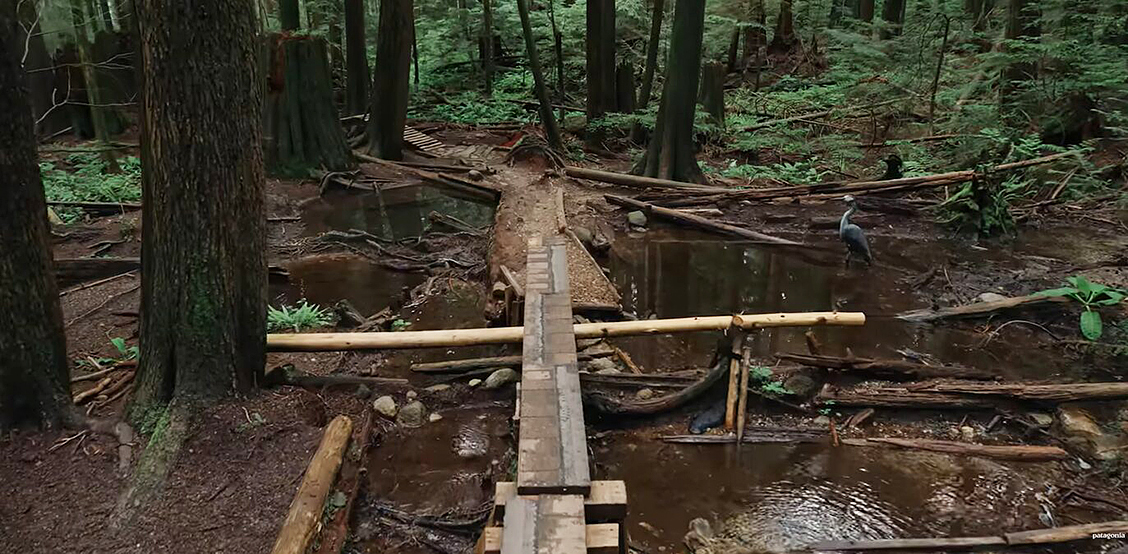
One big playground
She didn't start in mountain biking. Betty first made a splash (pun intended) pioneering women's wave sailing in the early 1980s. By her mid-forties, she was a single mother and full-time flight attendant, but she also started mountain biking. She started riding Fiander's "roller coasters for bicycles" after getting her first mountain bike in 1993.

Rather than competing, Betty found that mountain biking and being a single mother worked together. It became an activity she could do with her son, and they still bike together now that he's an adult.
Betty also isn't afraid to get injured. She's broken an arm, a wrist, a hand, and "lots" of ribs, dislocated shoulders, and torn her rotator cuff, but it didn't, and still doesn't, bother her.
According to Betty, when her ex told her she treated life like it was "one big fucking playground," she took it as a compliment.
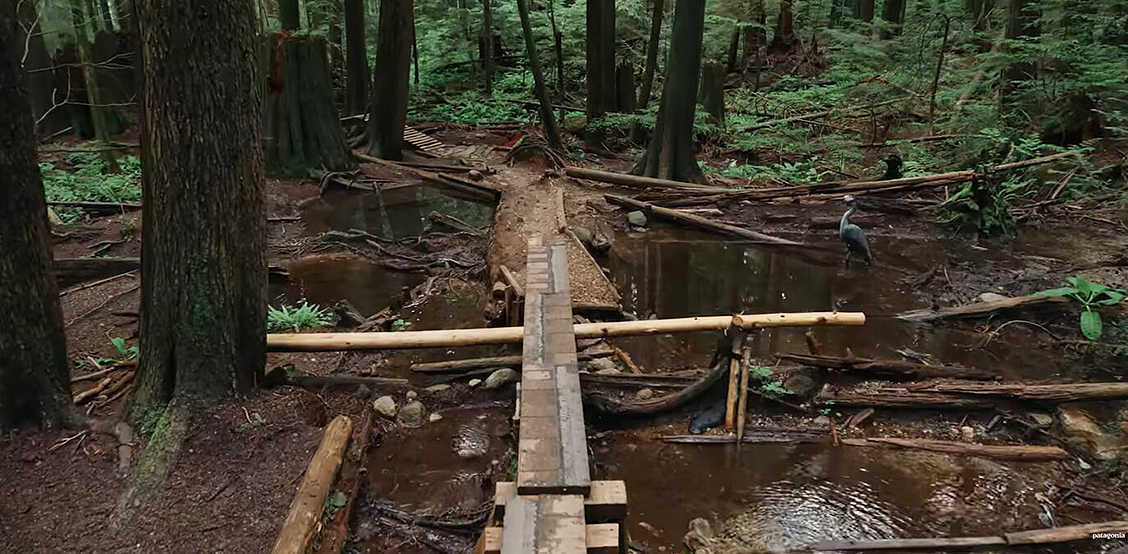
The short film interviews Lea Holt, a nurse with a family who worried, as she approached fifty, that she would have to give up mountain biking. But Betty's career changed her mind. "I have twenty more years..." Holt explained, "to get better."
"Betty is a legend on the North Shore," says fellow British Columbia mountain biker Amanda Moffat. When they ride together, she says, people will call out to Betty as they pass, like she was a celebrity.
Now 73, Betty plans to keep riding into her nineties. "Older people...need to know that you can keep going," she says. On the screen, Betty's bike leaps over rocky trails and races around bends and through the forests.
A new film, Everest Revisited: 1924–2024, invites viewers to look beyond the headlines to consider what Everest has come to mean, both in the past and the present. The film, which was publicly released earlier this week, won the Jury Special Mention Award at the 2024 Kraków Mountain Festival and was runner-up for the Audience Choice Award at the 2024 London Mountain Film Festival.
The 41-minute documentary, produced in association with the Alpine Club and the Mount Everest Foundation, weaves together archival footage with analysis and reflection from some of the UK's leading Everest enthusiasts.
Narrated compellingly by mountaineer Matt Sharman and anchored by the personal connection of Sandy Irvine’s great-niece, Julie Summers, Everest Revisited is less a dramatic retelling of Everest history and more a reflective journey through the mountain’s cultural and spiritual legacy.
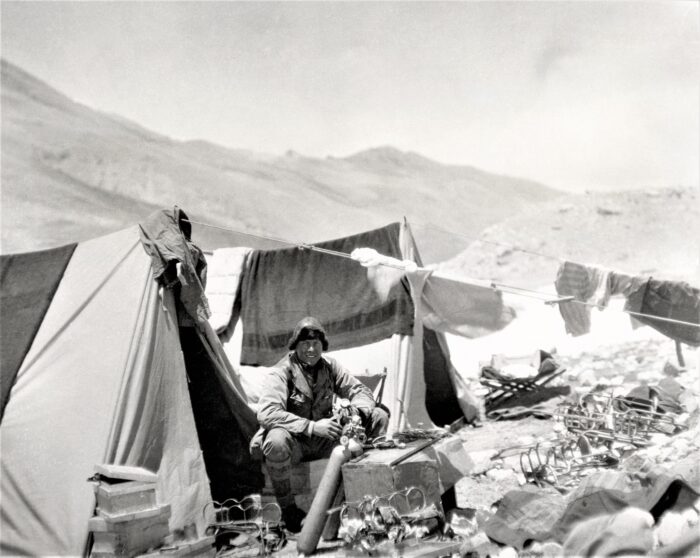
At the heart of the documentary are the expeditions of the 1920s, with particular focus on the ill-fated 1924 attempt by George Mallory and Sandy Irvine. With contributions from mountaineers and historians such as Rebecca Stephens, Leo Houlding, Stephen Venables, Chris Bonington, Krish Thapa, and Melanie Windridge, the film explores how these early attempts were shaped as much by imperial ambition and scientific curiosity as they were by the challenge of climbing itself.
A critical examination
Rather than idealise the past, the film examines it critically. It acknowledges the hierarchy embedded in British imperial attitudes, particularly toward the Sherpas and high-altitude porters who made these expeditions possible. The film highlights the essential, and often overlooked, contributions of figures like Karma Paul and Gyalzen Kazi, who bridged very different cultures. Porters like Paul and Kazi quite literally carried early Everest expeditions forward.
Everest Revisited also looks forward. Blending stories from climbers like former Gurkha Krish Thapa, who helped double-amputee Hari Budha Magar summit Everest in 2023, the film draws links between notions of historic heroism and modern questions of easy access and motivations. Despite the growing queues on Everest’s slopes and its increasingly commercial reputation, writer and climber Ed Douglas suggests that modern climbers may not be too dissimilar to those of the past.
"We tend to think that Everest is kind of somehow more complicated, more cynical, and less illustrious than it used to be. I think we need to look back at these expeditions with a more honest eye, because these are not simple, heroic people. These are people with the same motivations and the same, you know, concerns and the same complexities we have. They weren't always honourable. They weren't always perfect," Douglas reflected.
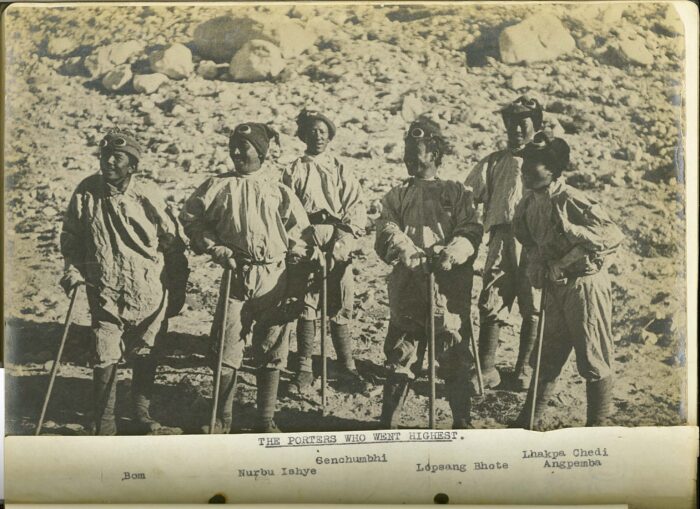
Emphasizing the unknown
Visually, the film integrates modern and archival footage of Himalayan landscapes with impactful interviews and primary artifacts, such as photos and equipment from early expeditions.
Rather than offering a final verdict on Mallory and Irvine’s fate, the film leaves room for mystery. It emphasizes the unknown. As climber Leo Houlding poignantly tells Irvine's great-niece Julie Summers, "I hope we never find your great uncle and I hope we don't find the camera. I hope that the mystery endures for another century."
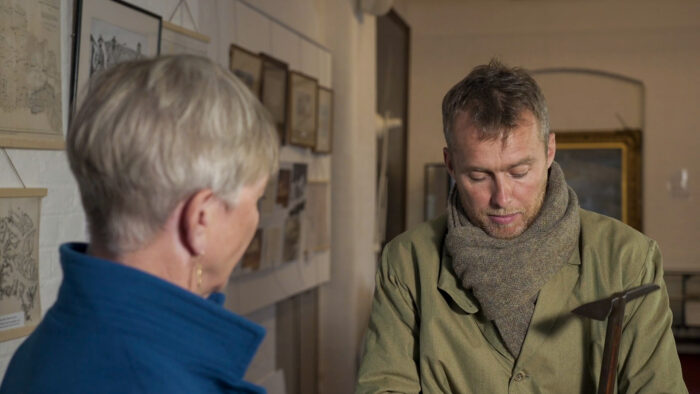
Everest Revisited is a film about more than just mountaineering. It’s about memory and the shifting values we project onto the world's highest mountain. The documentary will intrigue climbers, historians, and anyone drawn in by the enduring allure of the world's highest mountain.
In Tornado Hunting: Chase it From the South, storm chasers Chris Chittick and Ricky Forbes document their lives in the notorious Tornado Alley of the central U.S.
Just south of Sioux Falls, North Dakota, Forbes, Chittick, and their crew are waiting and watching the skies for funnels of violent cloud.
"We are in the right spot!" they crow as a tornado warning comes in only a few kilometers away. The tornado siren echoes through an empty town as dark clouds roll overhead. The unfolding scene is apocalyptic. The air turns green, they lose signal -- but the tornado doesn't appear.
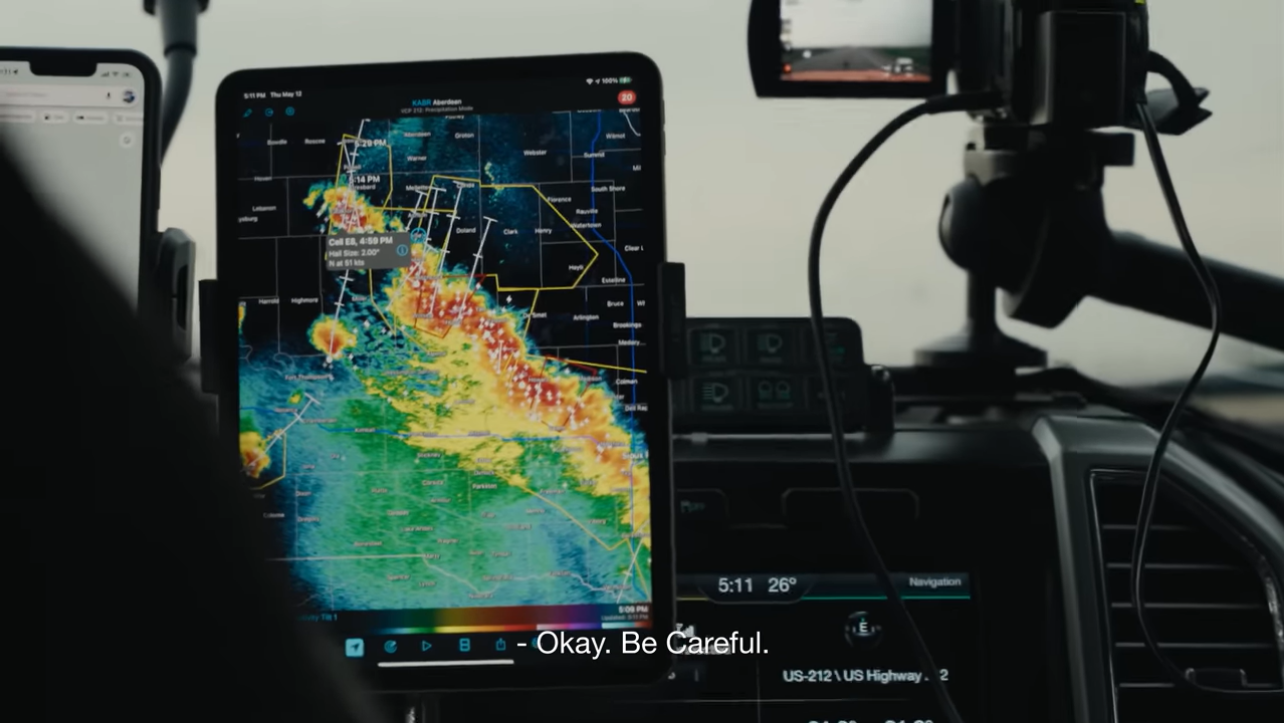
A professional storm chaser is like a sailor of old. The wind and weather are the ultimate deciders of success, no matter their skill or determination. Like the tars, they spend a lot of time away from their families.
After the disappointing storm, in a rain-soaked parking lot, Chris calls home and tells his children that he misses them. Then it's back on the road.
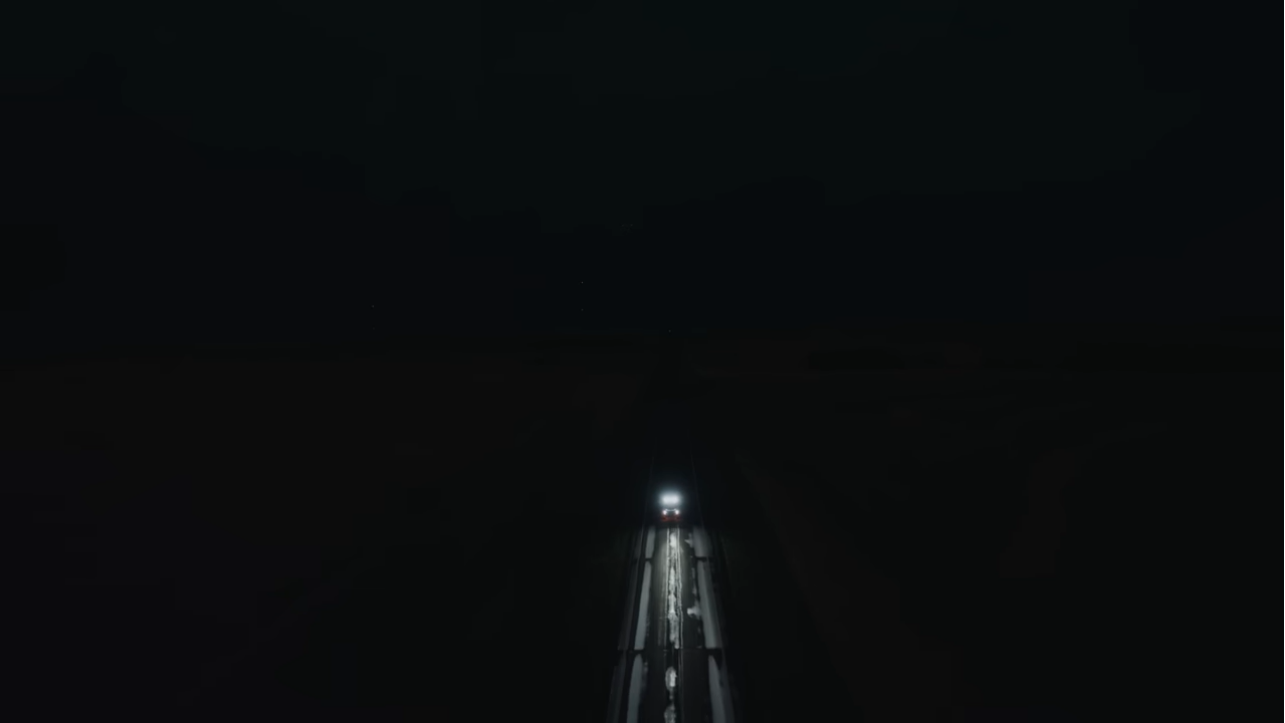
Home is Saskatchewan, Canada. Chris pushes one of his three young children on the swing, one eye on the darkening sky.
"I feel like weather always wins," admits his wife, Chelsea.
Meanwhile, Rickey and his fiancée, Tirzah Cooper, are driving to her first cancer treatment. She wonders how soon she'll lose her hair.

From the south
A storm is forming around Canby, Minnesota, and the Tornado Hunters drive to meet it. But the road conditions and local terrain complicate their attempt. Hills and tall trees prevent their view and access to the storm. The only chance of getting close is to go right in front of the storm's path, a dangerous gamble. It's safer to approach tornadoes from the south, as the storms move in a northerly direction. Driving into them head-on can, and has, been deadly.
"The more I've storm-chased, and the more that I've seen the destruction that tornadoes can do, the more terrified I become of them," admits Ricky.
They're watching construction crews haul away the wreckage of a ruined house, after the storm they failed to catch has passed.
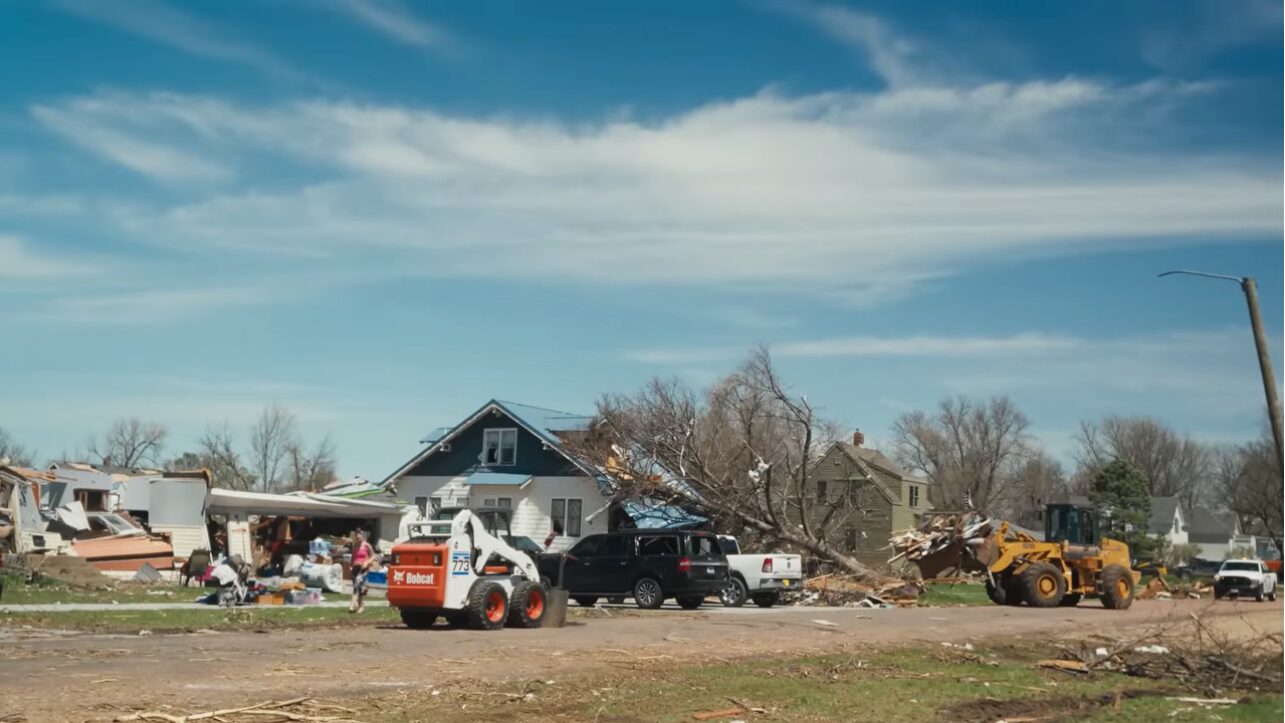
Their caution brings them back to Saskatchewan, where Ricky and Tirzah go to another appointment. He shaves her head. Not long after, a nearby tornado watch offers what he thinks will be the best chance all year. She urges him to chase after it.
After a succession of near-misses, Ricky finally approaches a dramatic tornado. He stops the car and stands in the road, staring up at the twisting mass dominating the sky. In narration, he says that the feeling he had at that moment was the same feeling of awe he experienced the first time he saw a tornado.
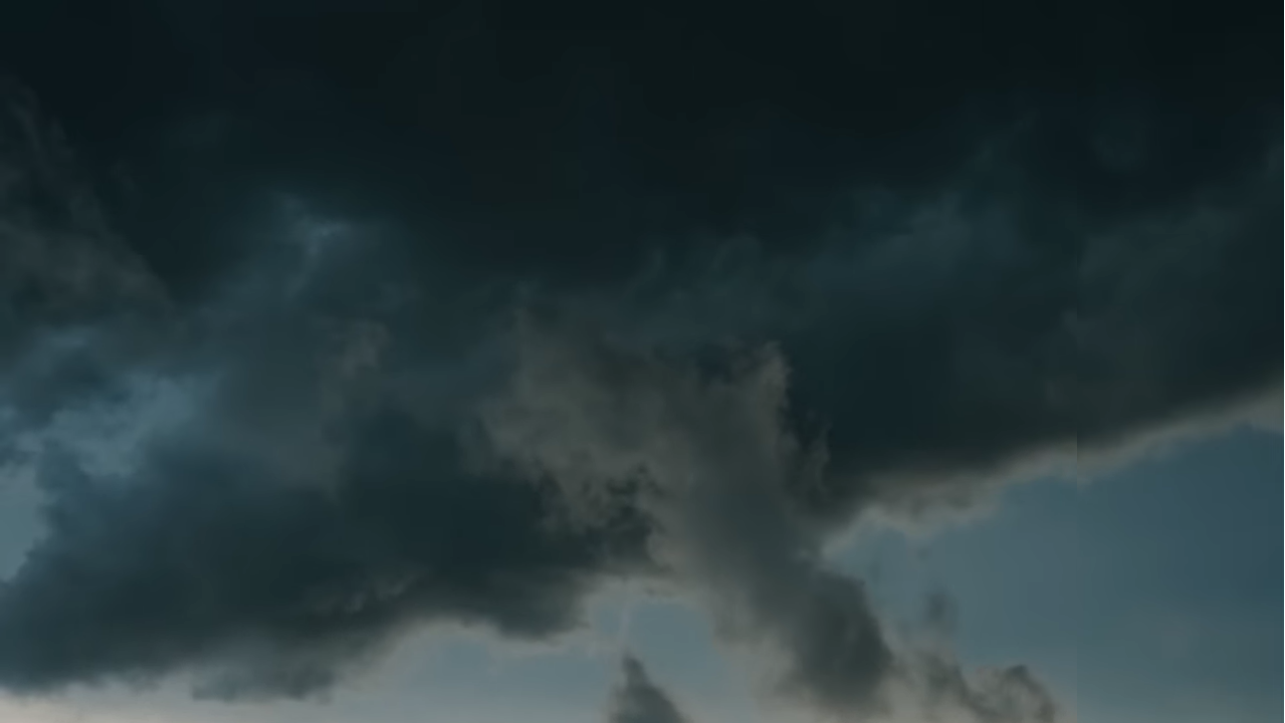
Then, he goes home. " A few years ago," he says, "I never thought anything could be more important than storm chasing. I was wrong."
The film ends with him at home, as on-screen text tells us that both Ricky and Chris continue tornado hunting, and Tirzah is now cancer-free.
BY WILL BRENDZA
When normal singletrack trails and downhill mountain bike parks don’t do it for you anymore, where do you go to get your adrenaline fix?
If you ask GoPro athlete and enduro and freeride mountain bike rider Kilian Bron, he’d tell you to head east to the Himalaya. Bron recently went there in search of some of the steepest lines and most remote mountain bike rides in the world. And he found them.
In this clip from GoPro’s series Draw Your Lines, Bron climbs a 4,600m peak. He carries his bike all the way to the top, traversing a ridgeline as he approaches his descent location. Then, he drops into a chute, fires out onto an open slope covered in scree, and rips his way downhill, with the Annapurna massif in the background. It’s a legendary line — the kind that mountain bikers dream of.
This story first appeared on GearJunkie.
This week's documentary takes us to the frozen Arctic, where a modern expedition follows the route of early 20th-century explorer Hubert Wilkins. In 1931, Wilkins set out for the North Pole in a repurposed military submarine. The subtitle of Frozen North -- "The Disastrous Attempt To Reach The North Pole In A WW1 Submarine" -- hints at how well they fared.

A promising adventurer
Wilkins was raised in Australia. The son of a sheep farmer, he was a self-taught pilot, photographer, and explorer with an abiding interest in the weather. Wilkins first made a name for himself when he flew from Alaska to Spitsbergen, completing the first trans-Arctic airplane flight. He immediately launched himself into the next adventure: reaching the North Pole by submarine.
He chose an old WW1 submarine, which he rented from the U.S. Navy for $1 a year. Interested in his plans, newspaper magnate William Randolph Hearst promised Wilkins $250,000 -- worth over $5 million today -- if he could actually reach the North Pole.
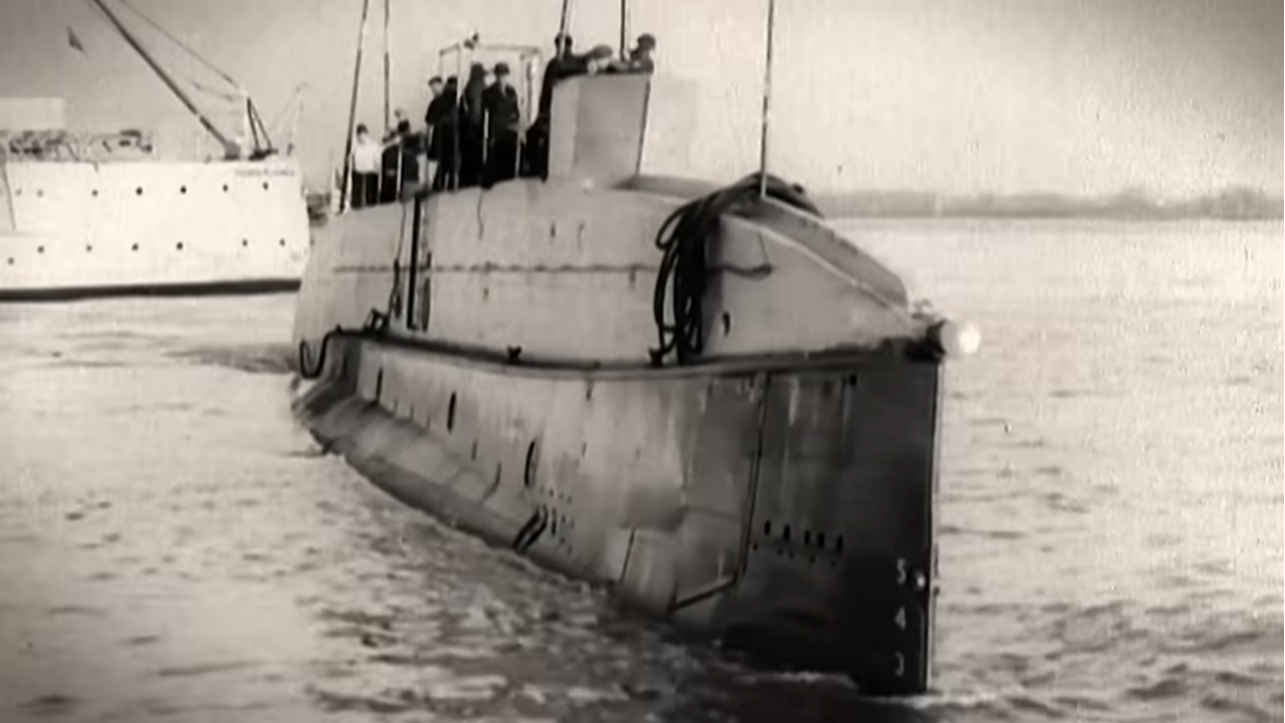
Feted in Brooklyn and well-wished by the wealthiest men of the age, the newly christened Nautilus headed North. Wilkins' goals were scientific. He believed, correctly, that polar conditions impacted weather worldwide.
In addition to his meteorological instruments, the ship was fitted with an ice-borer which didn't work, a hydraulic flap to keep it below the ice, and an airlock from the converted torpedo bay. It had no heating or insulation.
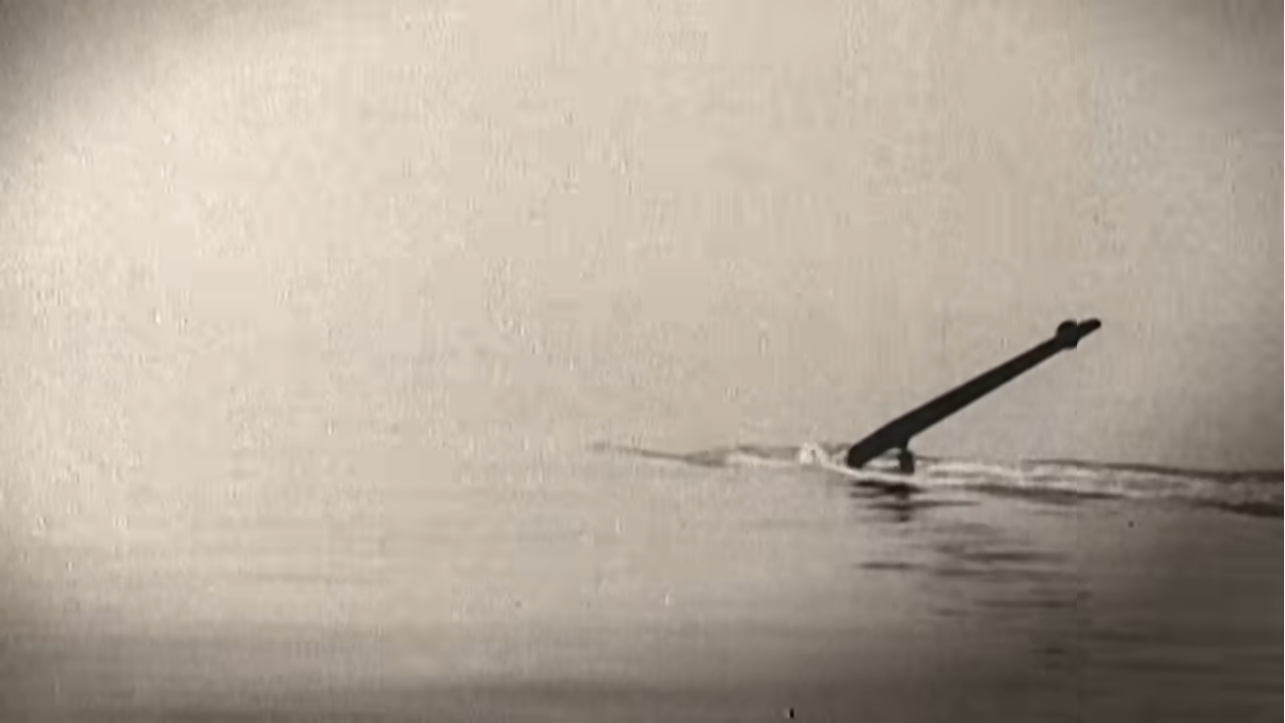
The disastrous attempt
Her sea trials went badly, but the season was getting late. It was forge ahead or wait another year, and no polar explorer has ever chosen option two. They left New York with only two months of summer left, with 10,000km to go.
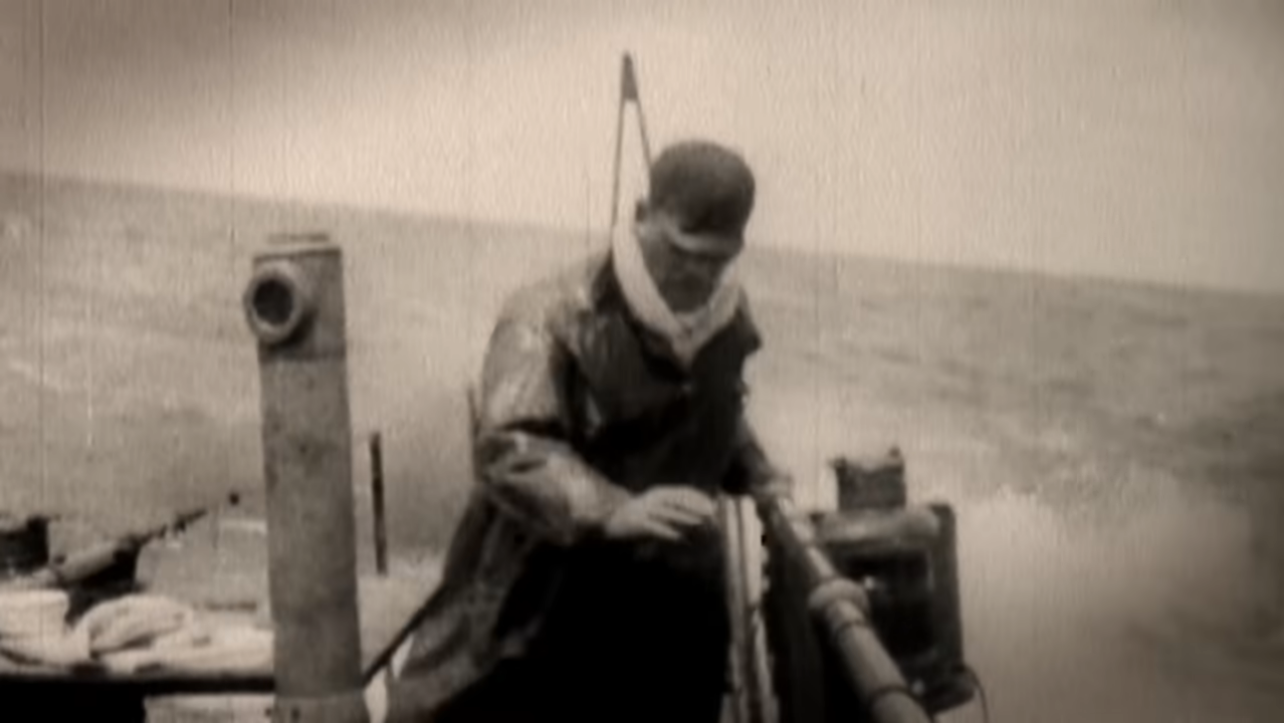
Almost immediately, a storm nearly wrecked them, and the Nautilus sent out an SOS signal. They were rescued and towed the rest of the way to England. Once there, they lost a month to repairs, only halfway to the North Pole. They kept going anyway, making it to Bergen, Norway. Norwegian experts doubted they would survive, and Randolph Hearst sent Wilkins a telegram telling him to call it off. Wilkins ignored this.
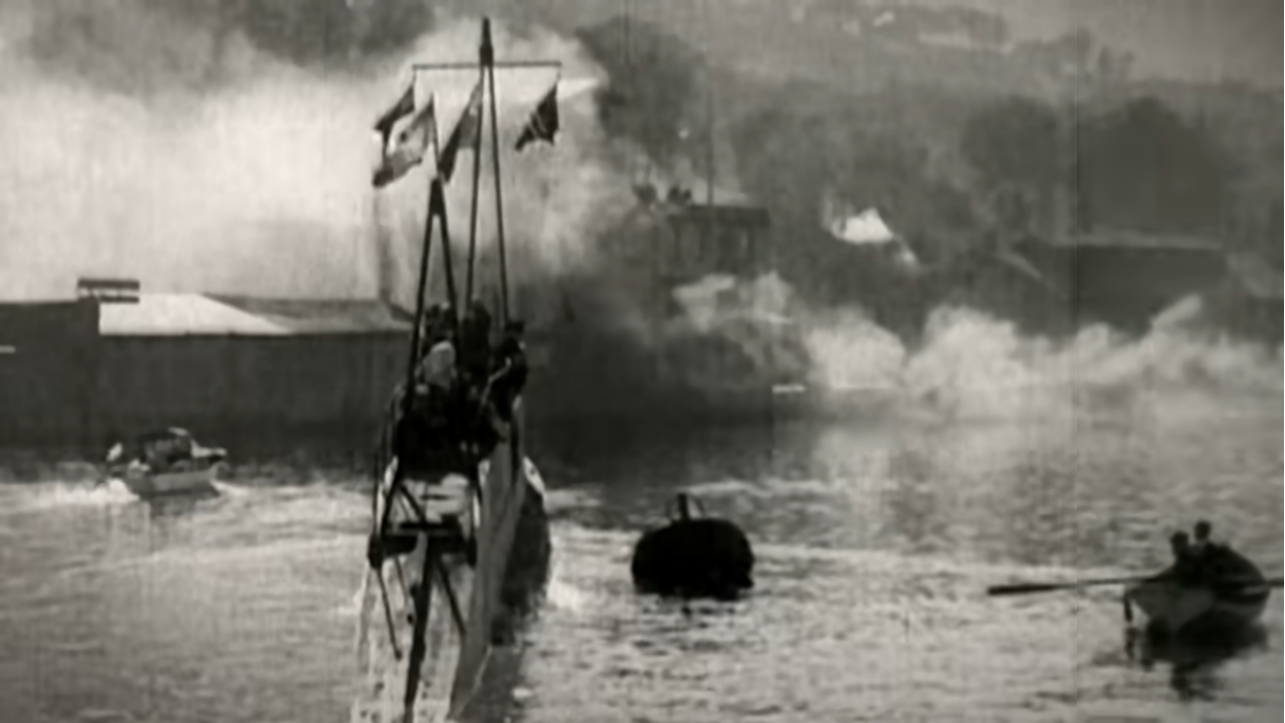
It was freezing in the hold, where Wilkins and the researchers conducted observations. They actually did important research, including showing that the Earth is flattened at the poles, instead of a perfect circle. Hopefully, this achievement consoled them through the miserably cold, wet, and cramped conditions.
After doing some science and freezing in the Arctic Ocean, the crew was ready to go home. But that wouldn't satisfy the press, so Wilkins ordered a dive. They were going under the ice.
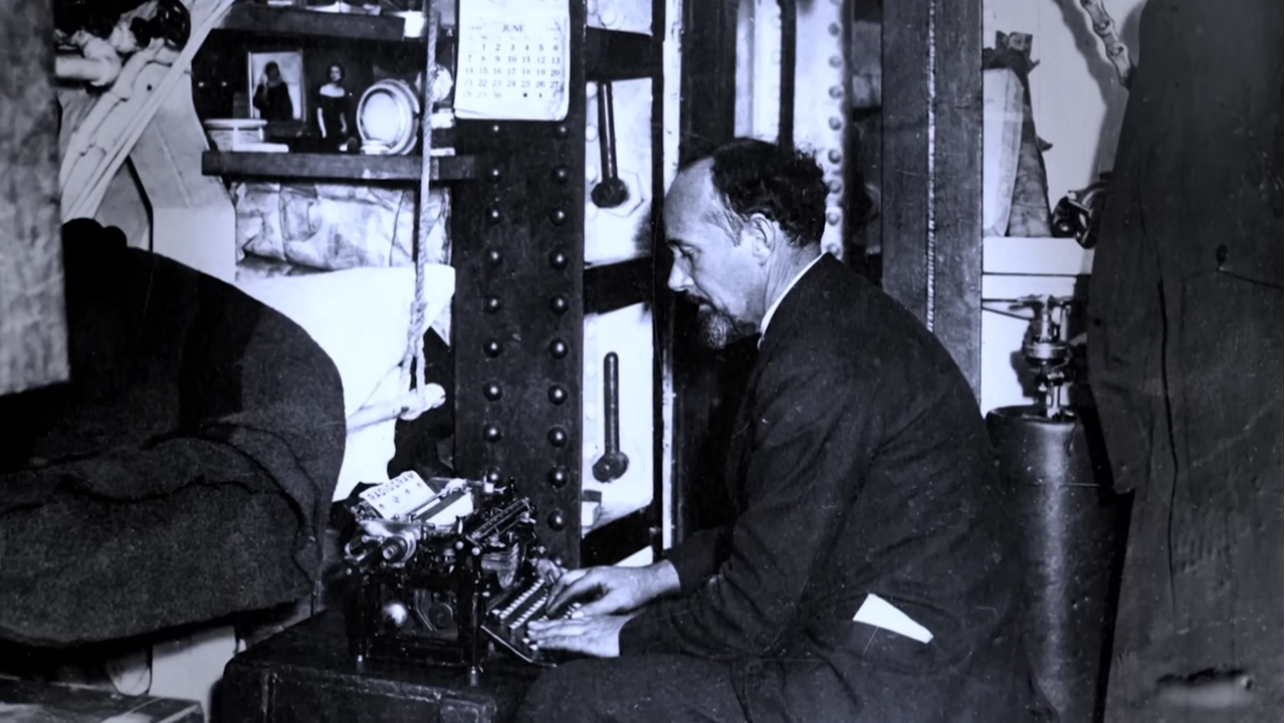
Under the ice and missing the Pole
Upon inspection, however, Wilkins found the steering mechanism damaged. Historians in cutaway interviews suggest that this was deliberate sabotage by an engineer anxious to go home. Wilkins was unmoved and ordered a dive on the next calm day.
They made it under the ice, becoming the first people to do so. But the radio was damaged, leaving them unable to call for help. At home, newspapers reported them dead.
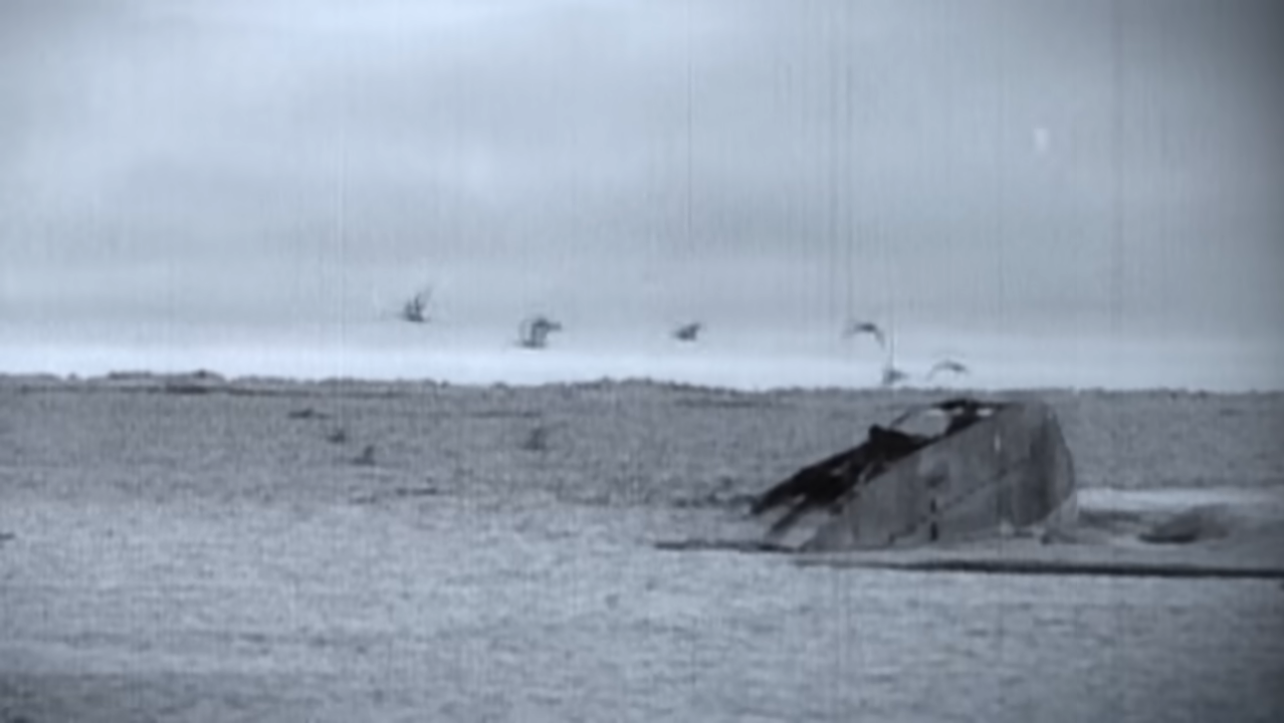
When they re-emerged, they jury-rigged a radio announcing they were alive. Hearst signaled back that he was glad they were alive and was also cutting off funding. Devastated, Wilkins stayed in the ice for three weeks, taking groundbreaking scientific measurements. It was clear they were not going to reach the Pole.
The Nautilus left the frozen north and limped back to Norway. By the time it arrived, another engine failure had left it unusable. On order of the U.S. Navy, it was scuttled off the coast of Norway.
Diving to the Nautilus
Nearly a century after his failure to reach the Pole, Wilkins' attempt is appreciated as an exploratory and scientific success. But the mystery of the broken steering mechanism lingers.
In a modern two-man submersible, researchers descend to the sunken Nautilus. The modern craft contrasts sharply with the dangerous, dirty, and miserable conditions of the older one, showing how far (with some exceptions) the technology has come.
They found the Nautilus, well preserved in the cold water, but now home to a diverse array of marine life. Researchers focused on the steering gear, looking for signs of deliberate damage. But it's buried in the sediment, preventing them from inspecting it.

Sabotage or not, it was suicidal to dive without those diving rudders, explains oceanographer Raphael Plante. Coming back alive at all was a remarkable achievement.
But Wilkins always dreamed of returning, and proving that submarines were a viable way to explore the North Pole. In March of 1958, a year after Wilkins' death, U.S. Navy submarine USS Skate reached the North Pole. They scattered Wilkins' ashes there.
Later that year, his vessel's namesake, the USS Nautilus, became the first submarine to transit under the North Pole.
Jake Davis is a professional wildlife filmmaker who has recently begun posting what he captures to YouTube. The title of his latest is descriptive: I Left $100K in Cameras on a Wolf Kill. Here's What They Captured. It's a deceptively simple premise. The footage Davis captures is the story of an entire ecosystem and a rare and intimate glimpse into the lives of wolves.

One day, Davis tells us in the introduction to the footage, he spotted a wounded bull elk. Davis realized he had stumbled into the immediate aftermath of a wolf hunt, and was now face to face with the victim. Knowing this presented a rare opportunity, Davis waited and watched. The next day, carrion birds flying overhead led him to the body of the elk.
Setting up the cameras, we get a behind-the-scenes look into the process of professional wildlife filmmaking. Davis explains his setup, placing cameras at different distances and angles to get different shots. To make sure they're on when there's activity, he sets them to be activated when a nearby device registers heat signatures-- living creatures. Then he leaves.
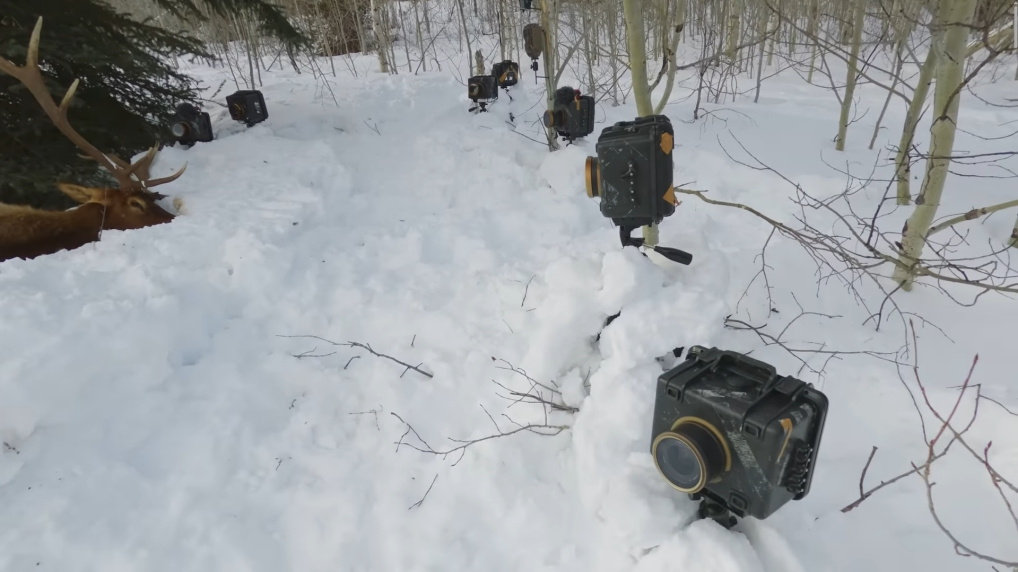
The afterlife of a bull elk
The birds are the first to arrive at the wolf kill. Various corvids hop about the corpse, and even a large golden eagle alights. Foxes join the gathering periodically. But after five days, the carcass is still largely intact -- and no wolves have visited. But they have been spotted close by.
Davis faced a dilemma. The cameras needed to be serviced to ensure none of them had a dead battery or were buried in snow. But if Davis went out to refit them, he would scare away the wolves. Or he could trust luck, hope the batteries held out, and wait. Fate decided for him, closing the road with storms and accidents.
When he finally makes it out, the cameras are covered in snow. And wolves had visited.
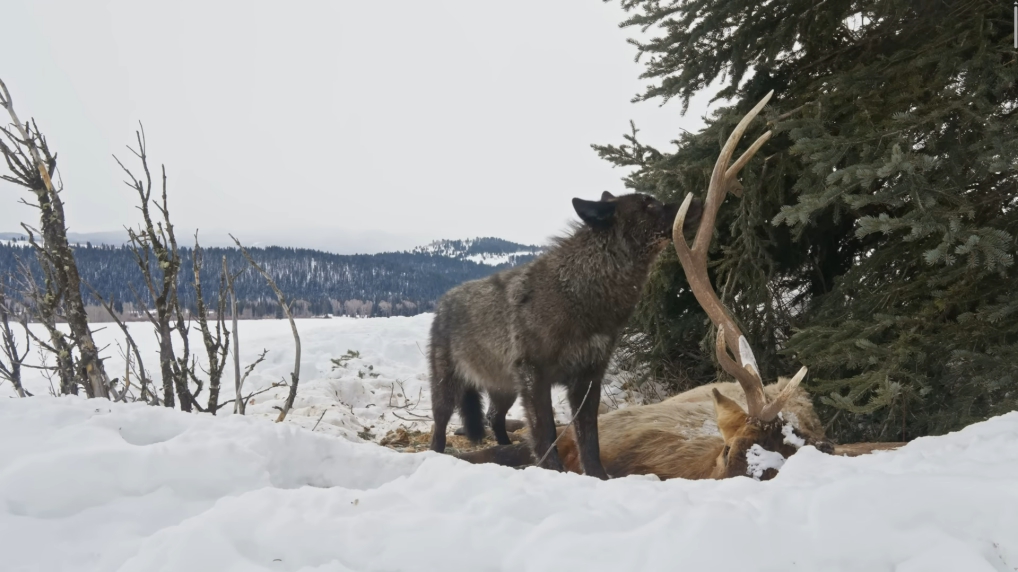
Visit of the wolves
Two young black wolves had arrived to feed, then left again. Quickly, Davis replaced the batteries and memory cards on his cameras and replaced them. Two weeks later, he returned again, to a strange scene.
The elk was nearly eaten up and had also been dragged several yards. And one of the cameras was missing. Footage showed the black pair had returned, as had an older grey wolf, and finally an entire pack. They fed on the elk all night, though one of them took a break -- to steal a camera and carry it off.
The wolves carried it away down the hill, biting at the case and the handle. When Davis is able to find it again, however, the memory card is intact, and we get a glimpse of the thief.
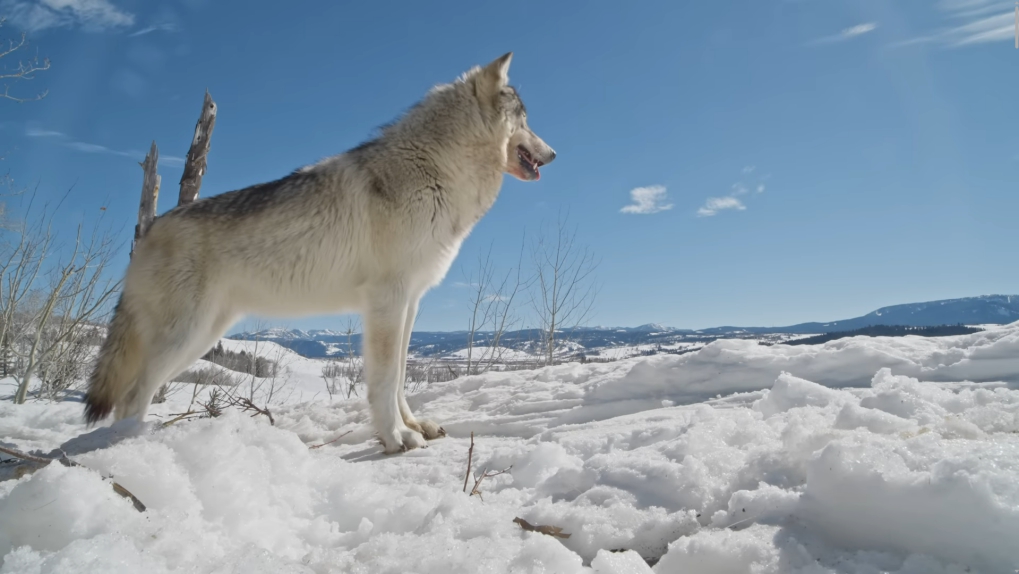
The next day at sunset, the wolves return for the final time. As we watch them gnaw at the bones, it is, as Davis says, "a window into a world that's never seen."
In 1954, the Academy gave the award for Documentary Short Subject to the first film in Walt Disney's People & Places series. Titled The Alaskan Eskimo, the film stitched together events in the daily lives of indigenous Alaskan people.
While the language and viewpoints expressed are outdated, the footage represents a remarkable historical document of daily life in an Alaskan community over 70 years ago.
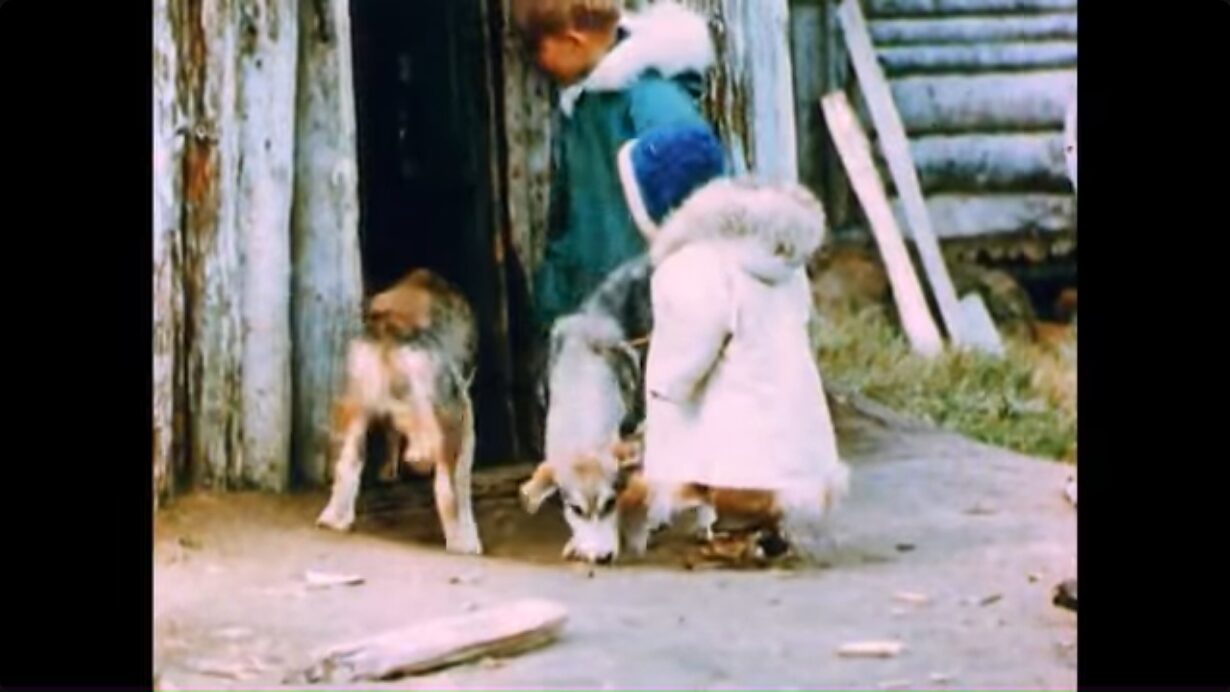
Summer business
The film crew visited in the warmest months and documented the preparations for the coming hunts and colder seasons. We see men building houses, and women stitching watertight coverings for new kayaks.
When the whalers return, the entire community comes together to haul in and flense the carcass of a beluga whale. We see children enjoying muktuk, slices of the skin and blubber of the whale. It's a very traditional food for groups all across the Arctic Circle, and an excellent source of vitamin C. "It has a taste like beech nuts, er, they say," our mid-Atlantic 1950s narrator adds with typical dryness.

Winter underground
The film crew stays on as the winter chill comes in, and the camera moves inside. The home we saw being built in summer, half buried in the earth, is now finished and in use. The people of the village are not idle in the long, cold hours, but busy themselves preparing useful items.
Men carve knives and harpoons, while women sew waterproof raincoats out of dried whale intestines and strands of grass. The people of the village also prepare seal skins for mukluk shoes. The children snatch the cut-off scraps to chew on, grinning widely at the camera.
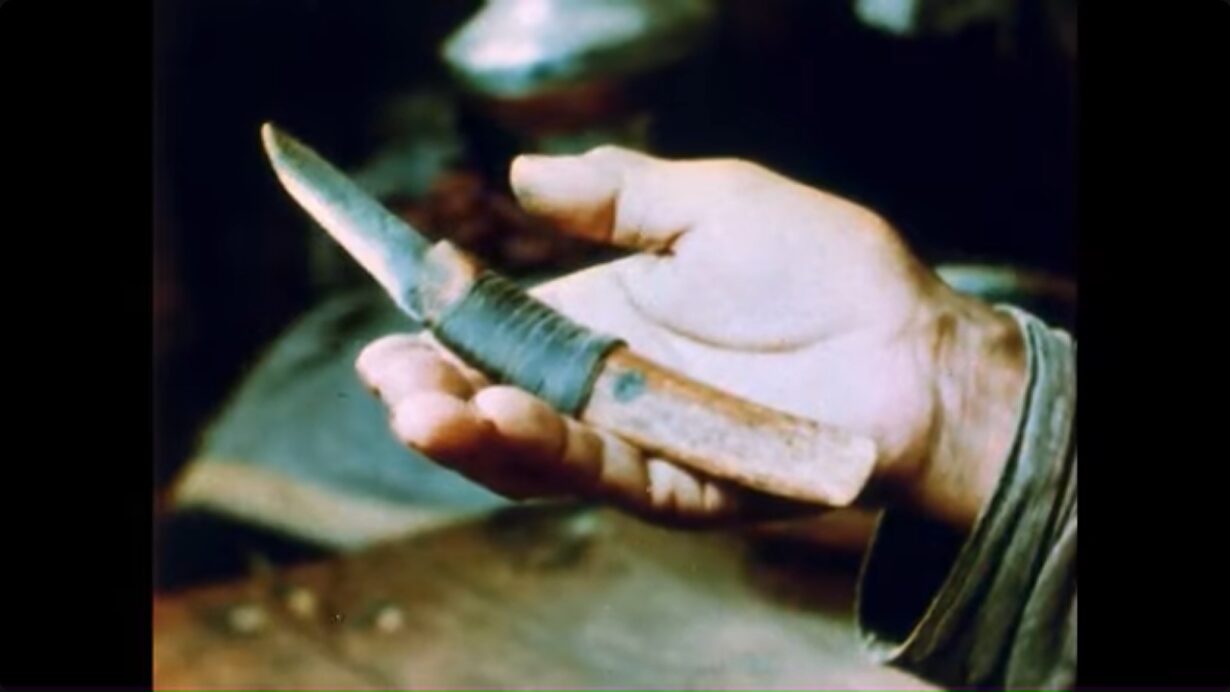
A break in the weather occasions an outburst of activity. Dog teams set out to replenish stores and gather wood before the full fury of winter returns. We watch as the men harness dogs, load driftwood onto sleds, and conduct a reindeer hunt.
Hunters and fishermen, the narrator reminds us, are in constant danger. If a blizzard sets in while they are so far away from home, they are likely to die. The weather does turn, but the hunter we are following manages to make it back to the village just in time.
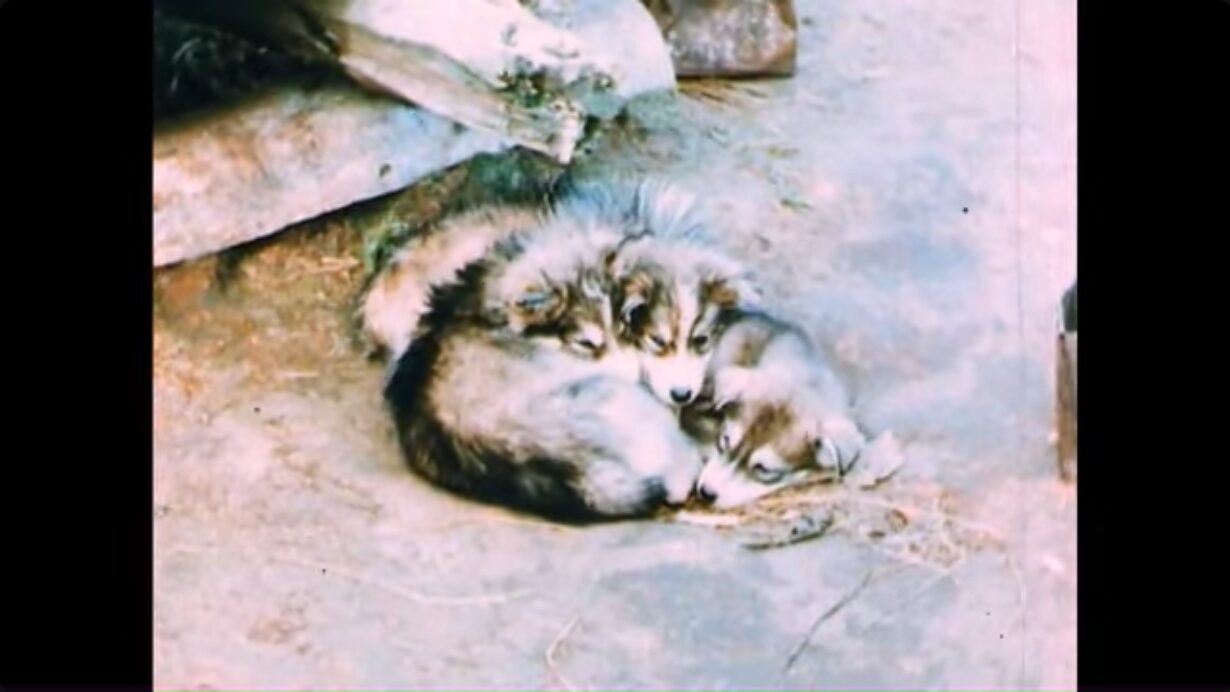
Spring is sprung
As winter draws to a close, the villagers prepare for the celebration of spring. Dressed in their best clothes, they come together in the meeting house. There, the filmmakers record a festival celebrating the end of winter. Men dance in masks representing the gods of the sky, the sea, and the land, in order to honor and thank them, accompanied by drumming and singing.

The ceremonial transitions into the farcical as the dancers switch their masks for caricature masks, intended to represent fellow villagers. The audience laughs, rocking to the quick tempo of the drums, as another winter ends.
In Five Caves, Five Days, Australian climber Ben Cossey sets off on what he alliteratively dubs "The great Australian coastal cave climbing crawl from Campbelltown to Coolum."
Cossey's been climbing in Australia for more than two decades, but he admits that he hasn't explored much. He has his few favorite areas, and until a friend suggested it, hadn't thought much of climbing north of Sydney. But after looking at a map and finding five promising crags in a line along the coast, he set out to expand his horizons.
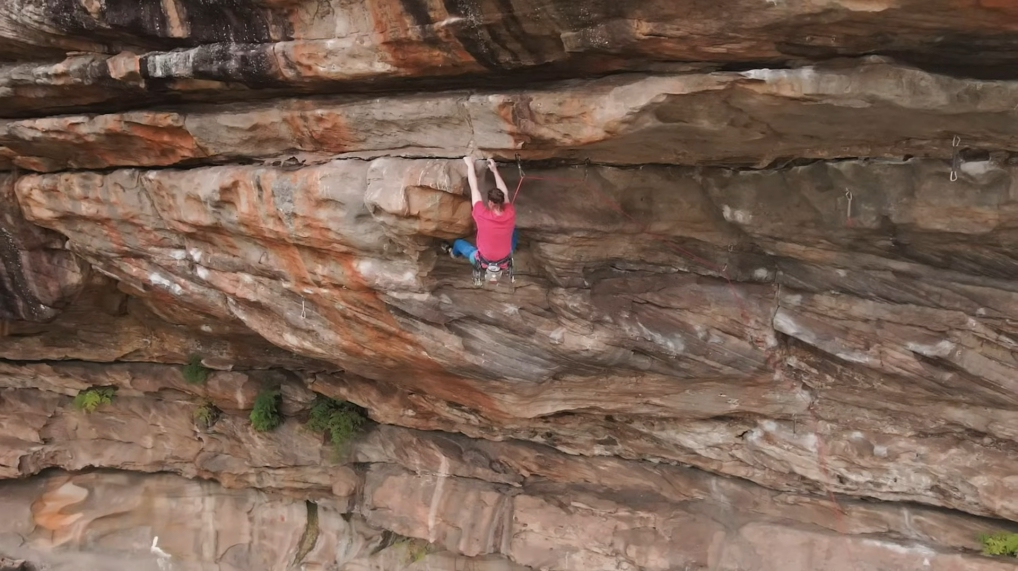
Junkyard cave
The first stop is at Junkyard Cave, outside of Campbelltown. Cossey meets up with local climbers who introduce him to a warmup line named Fifty Shades of Mt Druitt.
One of these locals, also named Ben, shows Cossey the main event. It's a line that he and his peers have been working on for a long time, but has attracted little attention from the broader Australian climbing community. Ben hopes they can get more people to try it and appreciate the "little paradise" around Junkyard Cave.
Cossey is game. He manages to send the line, quite literally kicking and screaming, emerging victorious atop a rather cinematic jut of cliff.
"A clean, beautiful rock," he admits, surprised. "Reminiscent of some of the best stuff I've climbed in Australia."
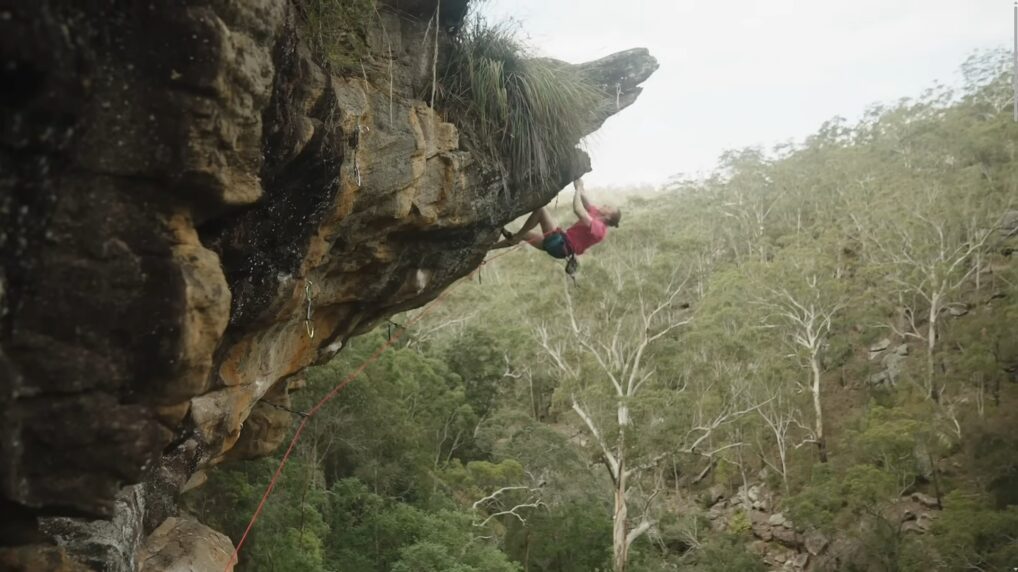
Lobster Cave
Tom is the friendly local assigned to Lobster Cave. In addition to showing Cossey the lines, including one Roast Lobster, they spend some time exploring the area. Close to the coast, the area around Lobster Cave has been inhabited for a very long time. Australian Aboriginal people have carved rock art nearby.
When it's time to start climbing, Cossey first goes for the Red Headed Dragon.
"Not a bad spot," Cossey says with satisfaction. "That's an ideal top out... another coastal cave-crawl classic."
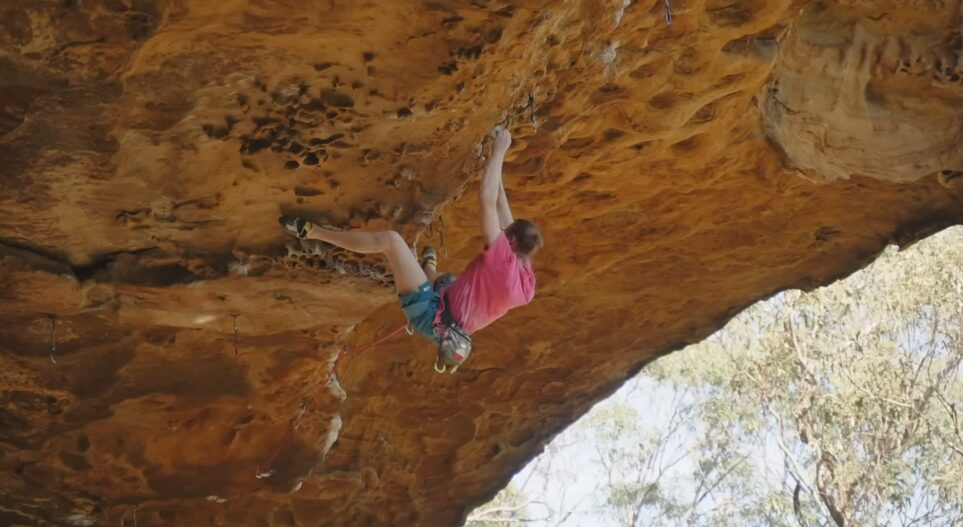
Hoppy's Cave
Another day, another cave. This one is known for being rather sharp. Cossey isn't dissuaded, but he does stop and pick up some analgesic cream in anticipation. His guide today is Jason, who sets Cossey onto Blackleg Miner. The route is long and steep, running all the way from the back of the cave.
"It's pretty radical. It's really radical," Cossey says, impressed. The rock sticks out from the surrounding valley, the only feature like it in sight. It is also, as promised, sharp.
"Man, that is an undertaking!" Crossey exclaims when, hanging upside down bat-like from the ceiling, he reaches the end of the line.
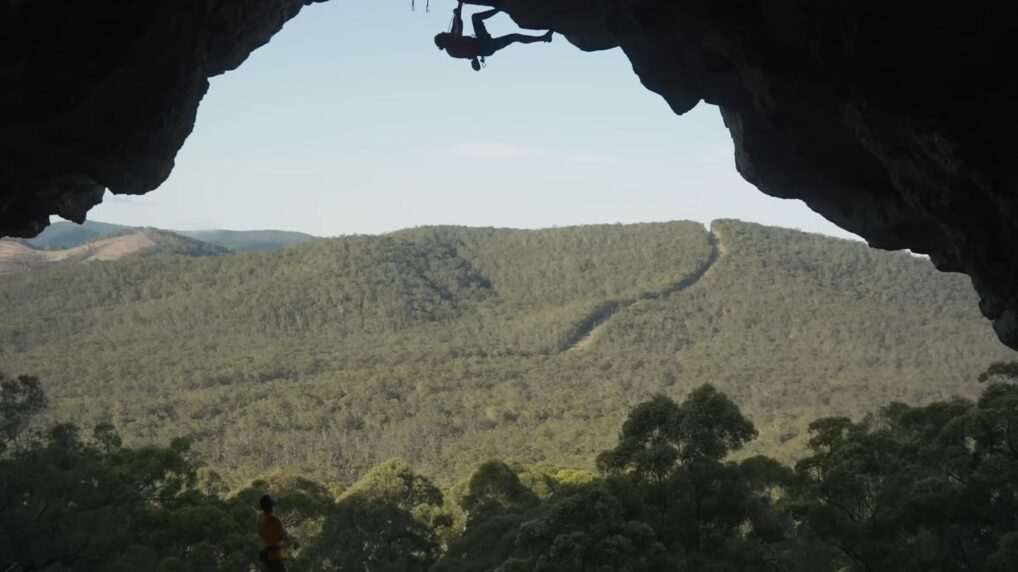
Flinder's Cave
"It's about 400 degrees in the shade," Cossey says, as day four finds him at Flinder's Cave. That's 752 degrees Fahrenheit. Lucy is his guide today, who starts him on Wet Jigsaw Puzzle as a warmup.
Cossey compares her introduction to the cave to being shown around someone's home.
"I didn't know what to expect, but it's better than what I expected," Cossey says.
After "Wet Jigsaw Puzzle" and one other, Lucy sets him onto the grand finale: A Space Odyssey. It's a hard climb, with smoother rock than the other Flinder's lines. Cossey is screaming and panting in the final stretch.
"There's unfinished business there," Cossey reflects. "A lot of routes there to go back to."
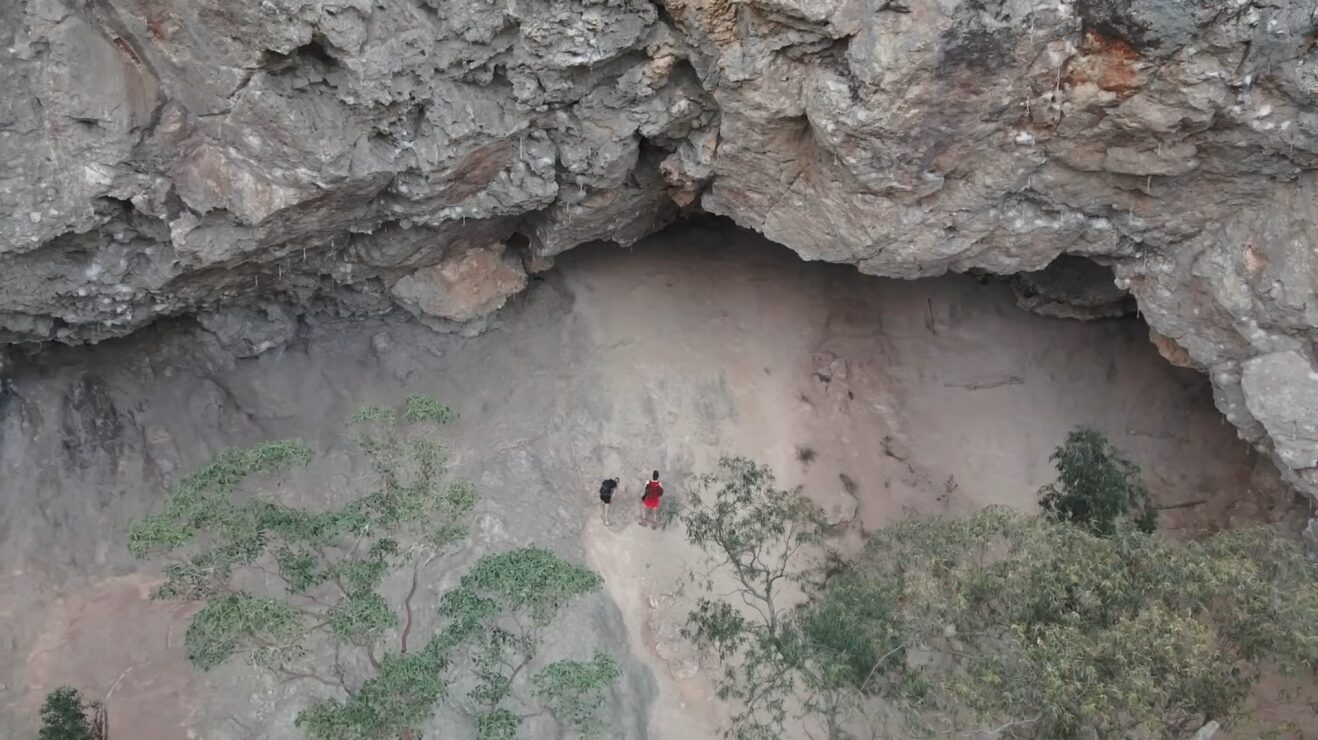
Mt. Coolum
Cossey's final day finds him sore and swollen-fingered but undaunted. Krystle meets him at Mt. Coolum, a cave with unique horn-like rock formations.
The strange new style of rock throws Cossey for a loop, to his surprise. The locals, used to the strange surfaces, scurry up the rock where Cossey was struggling, but he keeps at it.
His goal is to finish a route at every crag, and for the first time, there's doubt if he can. As the hours go by, Cossey is running out of time.
Torn to shreds by five days of climbing, his fingers force an end to the fight. This time, Mt. Coolum defeats him. The locals, smiling, are sure he'll be back.
He technically failed the challenge, but resolved his original question: Is there enough good climbing along this coastal route north of Sydney to consider it a climbing destination?
"The answer is, absolutely."
The Mirage follows Timothy Olson as he fights to claim the Pacific Crest Trail speed record. To do so, he has to run 4,270km in less than 52 days, 8 hours, and 25 minutes. This means about 14 marathons a week and about 17 Mt. Everests' worth of elevation gain.
He'll also be accompanied by his pregnant wife, Krista, their two young sons, and Krista's parents, Debbie and Bob Loomis. Trailing Tim in an RV, their family must take care of Tim as well as themselves, always racing against the clock.
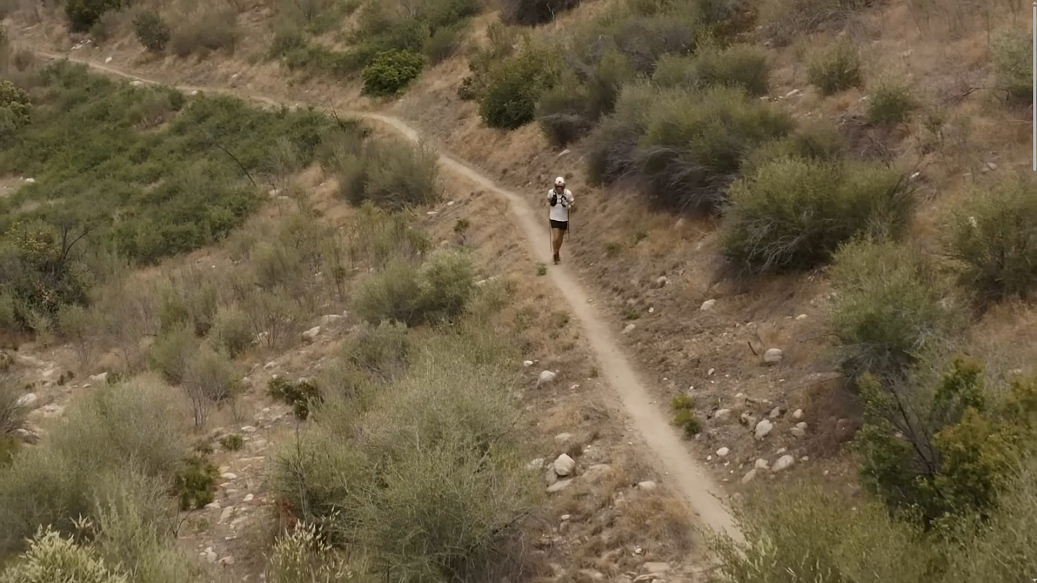
Things get off to a rocky start. By day two, husband and wife both recall hitting a wall.
"It's going to bring out the worst of me," Tim admits.
His family provides logistical support, mapping and scouting the trail ahead. Olson is entirely reliant on them to feed and supply him with water. But stretches of the trail he has to backpack alone -- not one of his strengths. But that's sort of the point.
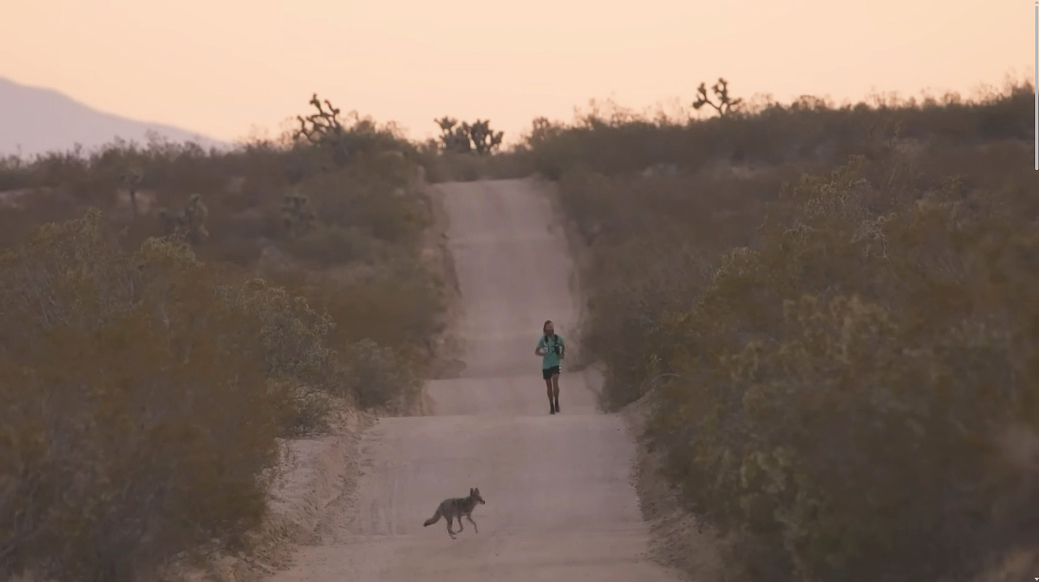
Heat, cold, bears, and snakes
You want ideal conditions, Olson explains, when you're attempting a record. Olson did not have ideal conditions. He hadn't planned for his wife to be heavily pregnant, and he certainly hadn't planned for a record-breaking heat wave.
In addition to the heat, Olson's path is strewn with venomous serpents that rattle and hiss, sometimes from the underbrush and sometimes from the path itself.

Abruptly, the battle with the desert ends, as he crosses the Mojave and enters the Sierra Nevada. Now, Olson faces a different battle. Snowy, rocky slopes cut down on his time.
As the attempt goes on, fate seems to be conspiring against them in a dozen petty ways, all caught on camera. The RV is stuck in a ditch and needs towing, Olson gets injured and lost, and equipment breaks. Because of the then-recent COVID pandemic, trail maintenance is more neglected than usual, leaving downed trees all over the trail.
Climate change affects the run in more ways than the heat. Wildfires rage around the trail, closing aid stations and filling the air with smoke.
Around the halfway mark, a shin injury begins to worsen, slowing his time and causing "excruciating pain" with every step.
"I miss the whole reason I'm out here...to heal," Tim admits. But he keeps pushing, and his team "throw the kitchen sink" at his injury, trying everything they can think of (other than rest) to keep his leg working. Slowly but surely, the pain starts lessening. His speed picks back up. It still hurts, though.
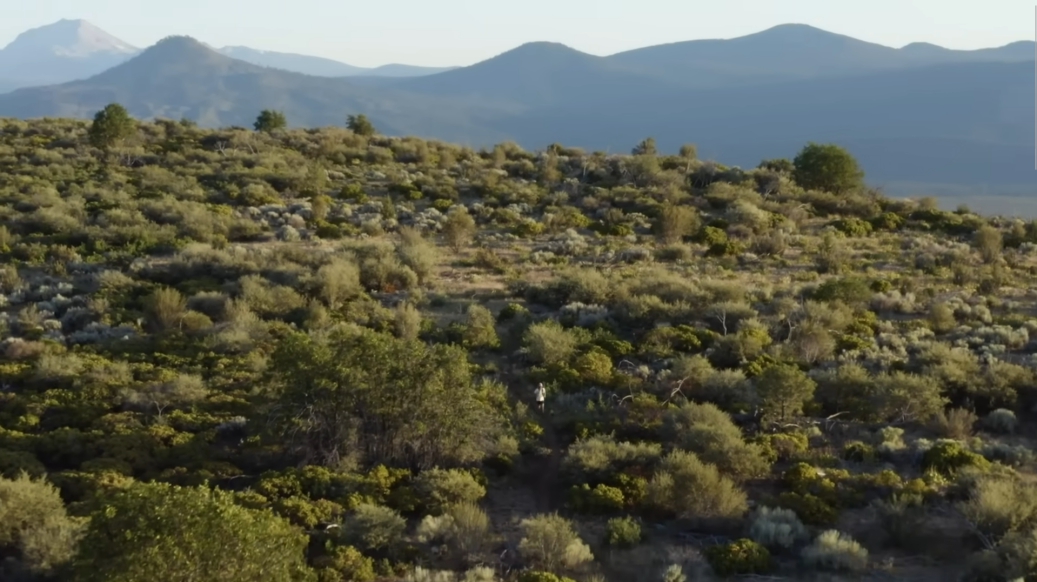
A family affair
His wife's father explains that running the PCT would, technically speaking, be far easier on Olson without having his family along. "But that wasn't the project."
Bringing his family along wasn't about logistical help. Knowing his wife and kids were waiting in the RV at the end of the day pulled him forward, "like a magnet," during his time on the trail.
Despite everything, Olson triumphs in the end. After 51 days, 16 hours, and 55 minutes, he reaches Canada and the end of the trail. The film ends with a selection of baby photos, and a phone recording Olson made during the run, addressed to his then-unborn daughter.
"Dad is out running...having a hard moment, but it's really beautiful to think of you."
Salimor Khola is a remote valley in Api Himal, nestled between a steep gorge and several unclimbed 6,000m peaks. The ridges and valleys of far western Nepal are far less popular for tourists and mountaineers, a tantalizing lacuna for the latter-day explorer.
This recent documentary, Salimor Khola: A Climbing Expedition to an Unexplored Valley in the Himalaya, follows a team of four as they attempt to explore the valley and summit some of its unclimbed peaks.
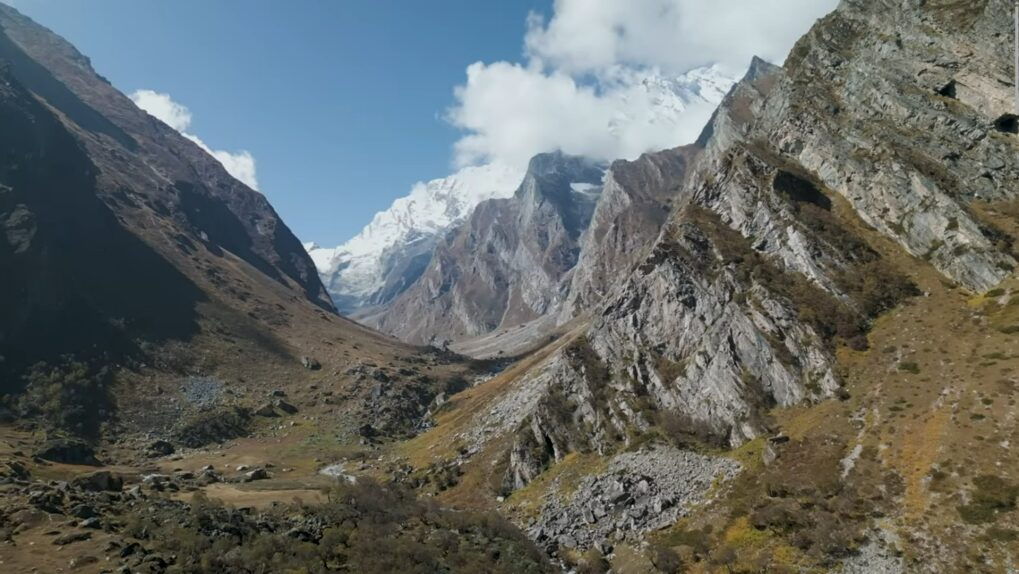
It takes over a week of travel -- first flying, then driving, finally trekking-- to reach the area. On the way, we meet the team-- Matt Glenn, Hamish Frost, Paul Ramsden, and Tim Miller -- all experienced mountaineers from the United Kingdom. The area is rural and remote; the people they do meet are surprised to encounter a Western climbing expedition.
The expedition is the brainchild of five-time Piolet d'Or winner Paul Ramsden, a sturdy Yorkshire man in his mid-50s. Ramsden had warned the younger alpinists that there might not be any climbing at all on their climbing expedition. They were going in to explore, not even knowing if they could reach accessible routes. But there was only one way to find out.
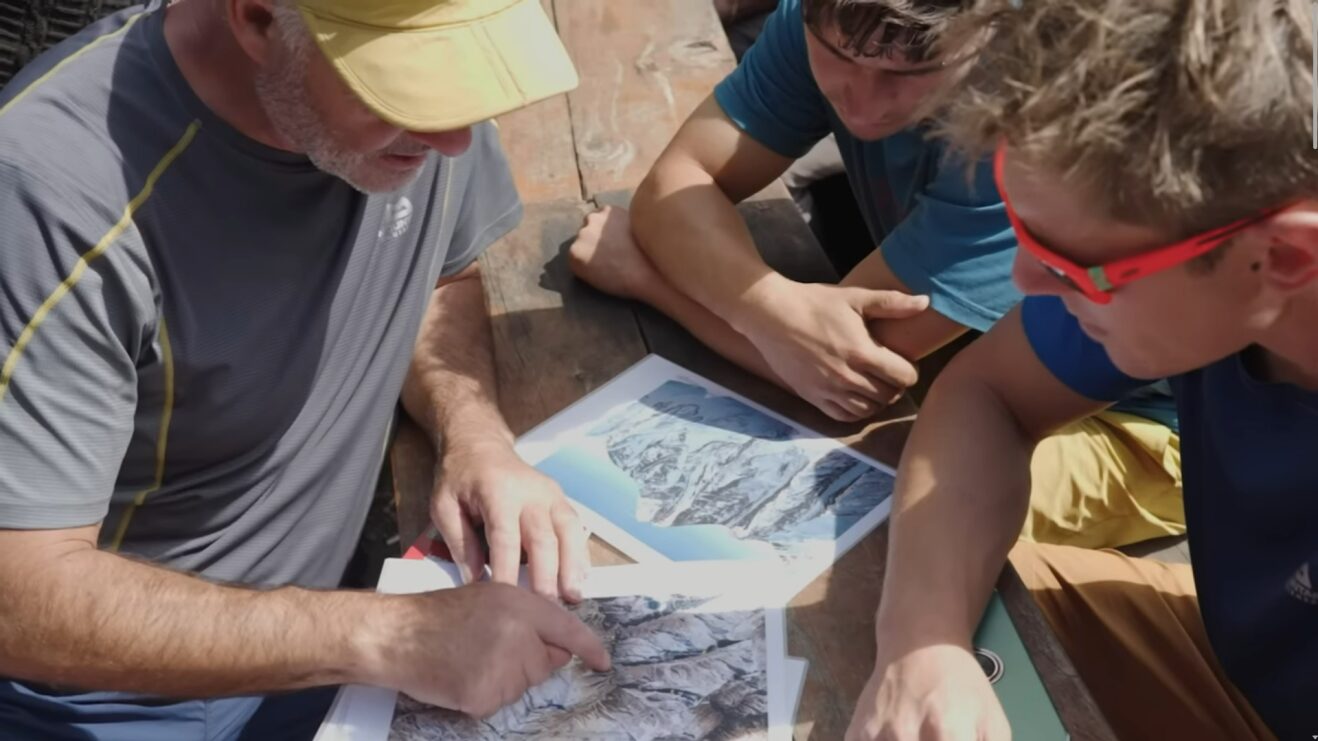
They manage to find a route into Salimor Khola, so with a week of food, the expedition splits into two teams: Paul and Tim, and Matt and Hamish. Taking the time to explore also allows them to acclimatize.
The summit that wasn't
After the reconnoitering and acclimatizing, Matt and Hamish set their sights on an unclimbed 6,000'er. After a hard day and 800 vertical meters gained, they bivouac on a ledge cut from snow.
They wake up to snow pressing on all sides, crushing and burying them. The footage goes black, but we hear them swear and pant as they struggle to free themselves and the tent. Eventually, with a half-broken tent and an exhausting night, they try to push on.
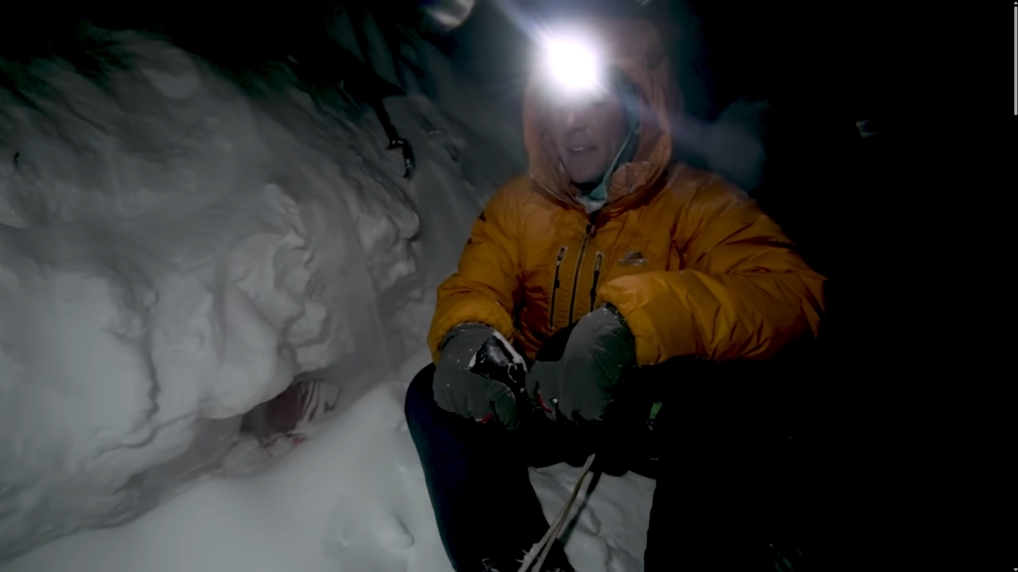
But they meet with impassable rock faces and are forced to turn back to base camp. After a day of rest, they head for a second peak -- but exhaustion and heavy snow follow them. The next day, they meet a false summit and a series of avalanche near-misses. But they push on.
Only a few hundred meters from the summit, they stop. The rest of the way is heavily corniced, and another avalanche has just missed them. It's time to turn around.
"There's just something really beautiful about doing this...and then not being able to do the thing that you wanted to do and just having to do it for the sake of it," Glenn observes.
Back at base camp, the pair reunites with Ramsden and Miller. They've made the first ascent 6,605m Surma-Sarovar, although Ramsden's finger is frostbitten.
The film stays with Glenn and Frost at the end of their expedition. They didn't get a summit, but they did do what Glenn calls a "proper expedition" -- an adventure.
"I would love to do more of that," Glenn says. "But maybe just not yet."
Crossing Dreams, subtitled "Solo bivouac paragliding adventure in Himalaya," documents the recent exploits of professional paragliding coach Francois Ragolski. His attempt to follow a long route through and over the Himalaya covered 60 days, four countries, 2,580km and 113 hours of paragliding.
Ragolski has been paragliding for 18 years and planning this expedition for six months. Like him, the movie is anxious to finally start, so it wastes no time launching into the first day of the journey.
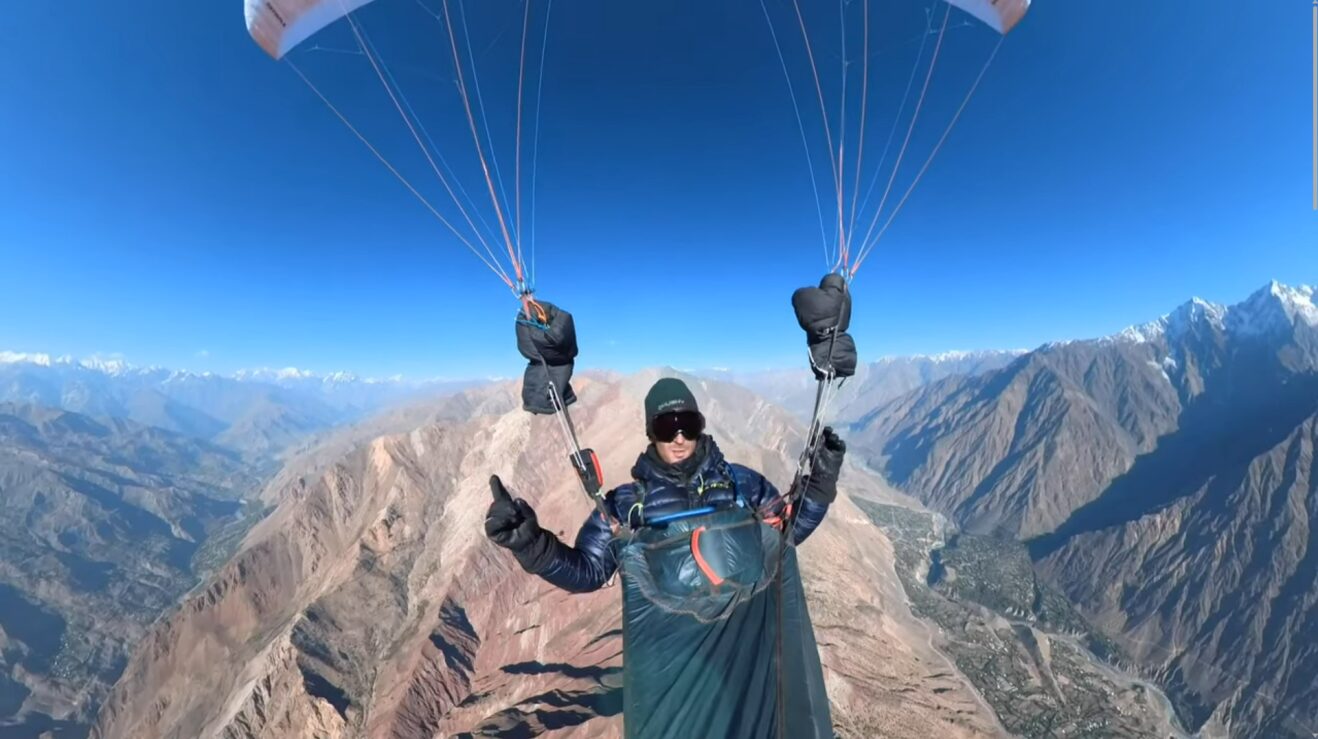
It's a solo trip, but he avoids self-isolation, stopping to speak and share meals with the people he passes.
"I thought everybody here would speak Russian," Ragolski says ruefully, when his attempts to find a common language with two hunters in Tajikistan fail. "I was wrong, nobody here speaks Russian." But even with the language barrier, his friendly enthusiasm carries him through.
"Everyone was so welcoming...they load you with so much good food," Ragolski says. Every few days, he meets locals, usually shepherds, who share their food and shelter with him. Left to his own devices, he mostly eats packaged noodles and dried fruit, so a hot meal and friendly faces are a welcome change.
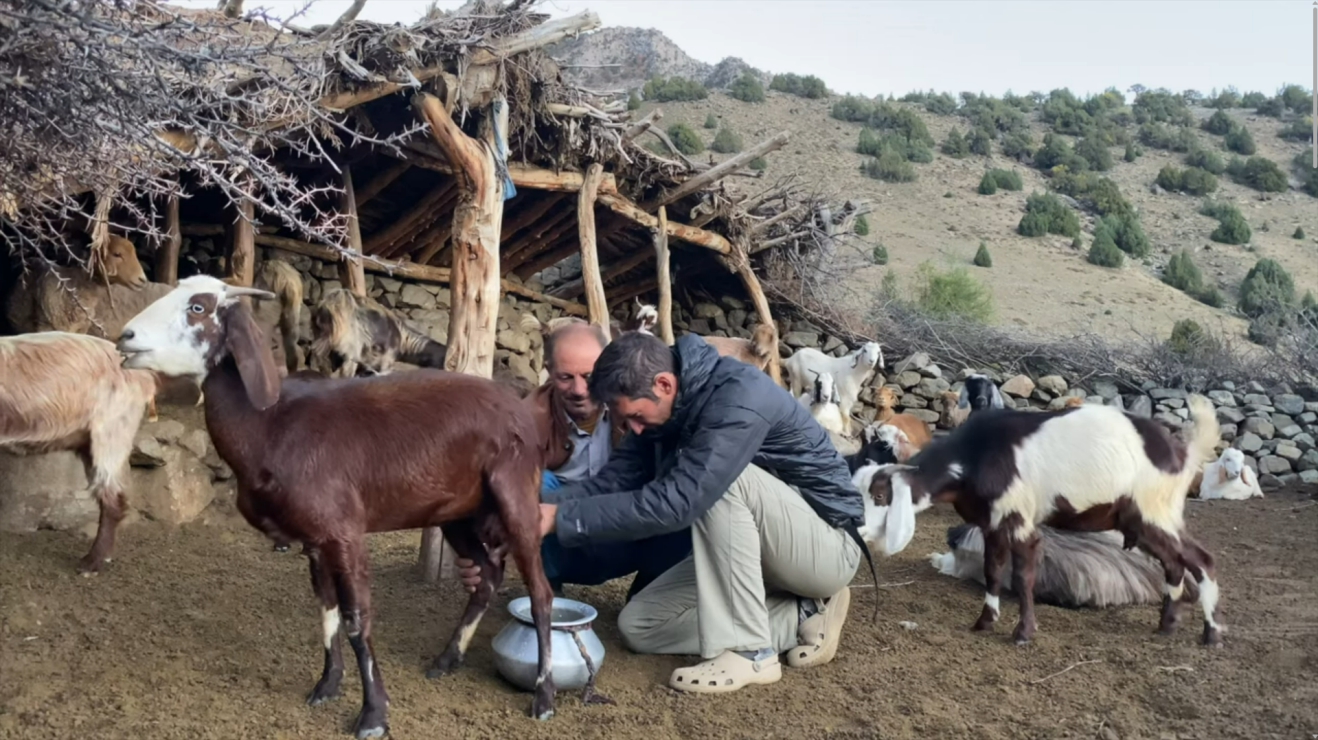
Re-routing
Ragolski spent months plotting his course on Google Maps using satellite images. But when he arrived in Dushanbe, Tajikistan to begin his route, officials stopped him. Government officials, military officers, and tour agency representatives told him the airspace he planned to fly through was simply too dangerous.
They gave him a new route. It was less likely to get him shot down, but it was also longer and more difficult from a technical perspective. The route change lands him in an area heavily populated by wolves and bears, where officials warned him not to stay the night. But the wind and weather conditions ground him, and he passes a stressful night hearing the sounds of animals outside of his tent.

At your own speed
Tired and hoping to avoid confrontations with the local wildlife, Ragolski hitches a ride into Pakistan. Some exceptions for bear and militarized airspace-related dangers aside, he aims to fly as much as possible. Doing that means landing -- and sleeping -- in places he can take off from again in the morning. This makes for some uncomfortable digs, but it's better than walking. "I am lazy," Ragolski jokes.
After the stark beauty of the mountains, the intermissions in crowded urban areas are another kind of striking. Later, a two-week-long spot of rain grounds him in India. He avoids despair through ping pong and a bit of light tourism.
"But as soon as I flew again, I was just so happy," Ragolski says when he finally gets back in the air on day 41. This is a frequent exclamation; his sheer joy at being aloft and moving forward is palpable.
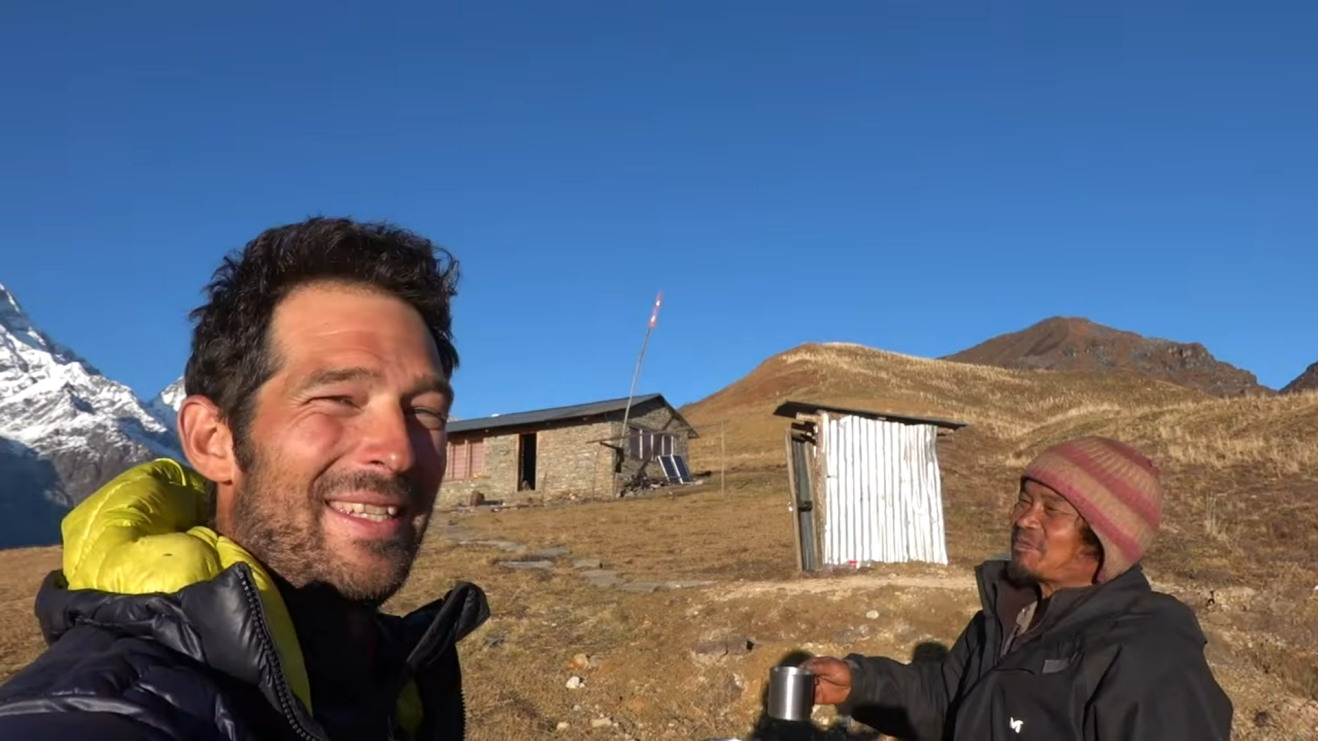
The point of going solo is that he can go at his own pace, taking his time to explore, to meet people, to avoid unnecessary dangers and complications. It's not a race or an exercise in self punishment -- it's an adventure.
In the final days of his journey, Ragolski glides past famous peaks like Annapurna and Everest, marveling aloud. "Wow! What an adventure...I'm so so happy I came."
Gaucho chronicles the days of elderly Patagonian gaucho Heraldo Rial. Gauchos are skilled horsemen and cattle ranchers who have lived independently in the Patagonian region for centuries. Known for their bravery and skill, the gaucho is a sort of folk hero in Argentina. But as modernity encroaches, that ancient way of life is under threat. Rial is one of the last true gauchos.
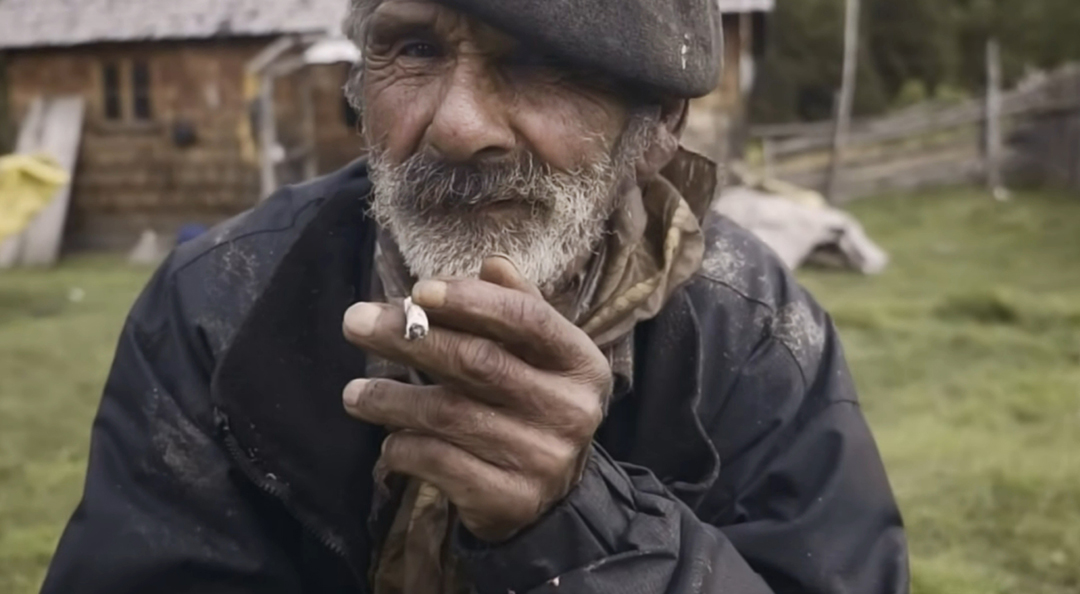
Now 80 years old, Rial can't do everything he used to. In the summer, three men make their way to the one thousand hectares of wilderness that he ranches. Papo, his nephew Diego, and his son Franco come to help Rial with his tasks. They're the only people who make the days-long journey through the mountains to see Rial.
He spends the winters alone in his little house, bringing his herd down from the mountain pastures to wait out the wind, rain, and snow. Papo compares him to a hibernating bear, tranquil and quiet. But he works every day, tending to his animals and maintaining the house and fences.
"I'm going to die here, at some point," Rial states calmly, as the camera lingers over his home. He seems to be at peace with the idea.
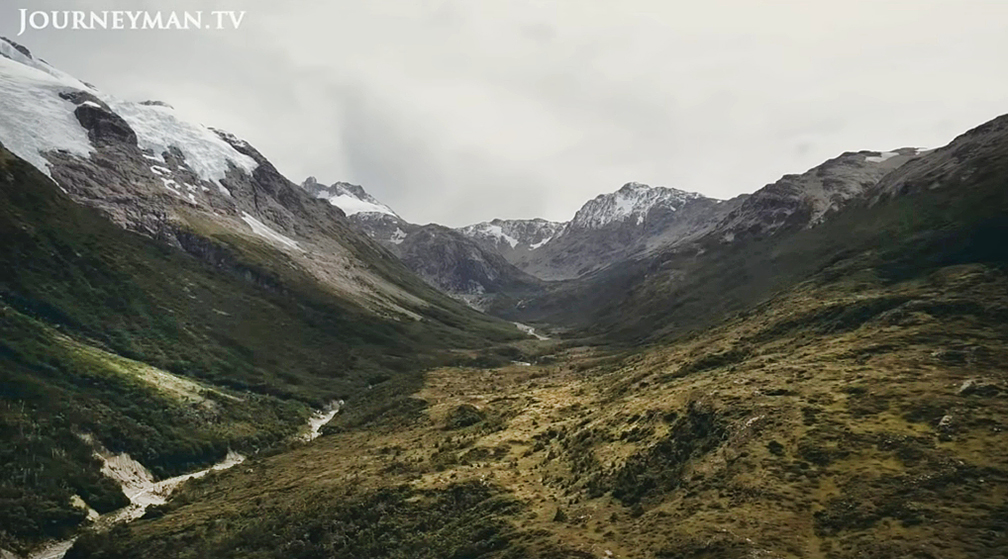
A dying breed
Most of the gauchos that Rial knew are gone now. Increased urbanization, as Papo explains, led gauchos to sell their lands and move to the cities, abandoning the mountain paths and old places.
Cattle ranching is an important part of the economy in Argentina. However, most of that money is made by a long series of middlemen. The men like Rial who work every day to raise the animals earn just enough to get by. In return, they face danger, isolation, and grueling work.
The film shows some of Rial and his helpers' daily tasks, which include finding and chasing down an escaped herd, branding and gelding young steers, and butchering animals.
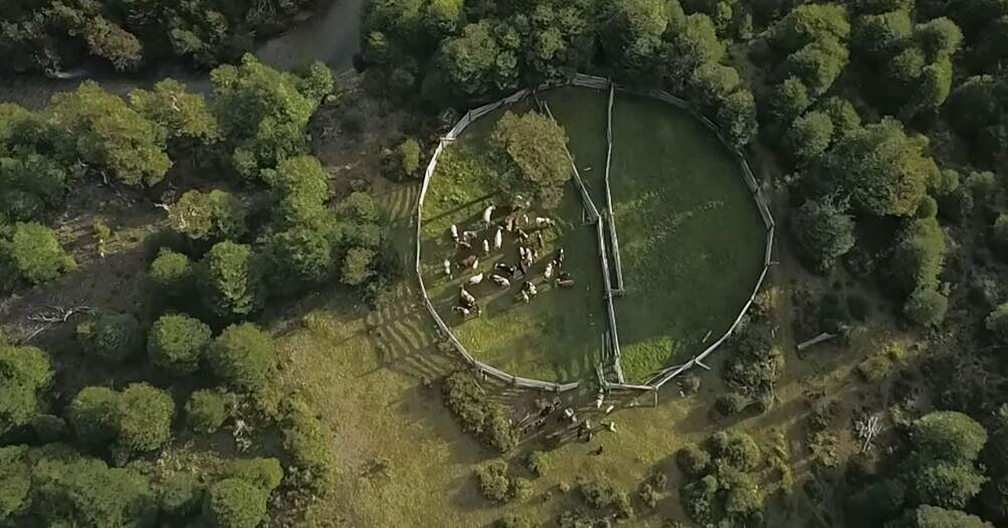
Papo guides his son Franco, who is learning these skills for the first time. Rial might have passed these skills onto his own son, a friend of Papo, but he died five years ago. "But that's life," Rial says. "And his came to an end. He had to leave."
Rial's way of life is more than specific skills and herding practices.
"One should live without thinking," Rial explains. The way of country people, as he describes it, is one of acceptance. Of death, inevitability, circumstance. It's a way of thinking and living that is alien to modern, urban existence.
"He's the only gaucho left in Patagonia," Papo reflects. "There are no more."
Years ago, Nick Kleer, together with his now-wife, then-girlfriend Kristina Perlerius-Kleer, visited the Tiger Canyon nature reserve in South Africa. They never left. Wild Connection documents their cheetah conservation efforts, as Kleer and Perlerius connect with the famously fast cats living in the reserve.

Cheetahs are critically endangered. In the last century, their population has gone from 100,000 to less than 8,000. Their once-extensive habitat has shrunk due to increased urbanization and farming, leaving them with insufficient hunting ranges.
Anyone familiar with thoroughbred horses or purebred racing greyhounds will know that beautiful, fast animals are often also nervous, fragile, and inbred. The cheetah is no exception. The cheetah population is unusually inbred due to a population bottleneck that occurred around 12,000 years ago. While the paleolithic cheetahs managed to come back from the edge of extinction, it left them with very low genetic diversity.
Hands-on help required
As a result, cheetah breeding programs require very careful management. To save them, it isn't enough to just fence off a piece of land and put a bunch of cheetahs in it, Kleer explains. It requires hands-on intervention by people who can closely monitor their physical and, yes, emotional well-being.
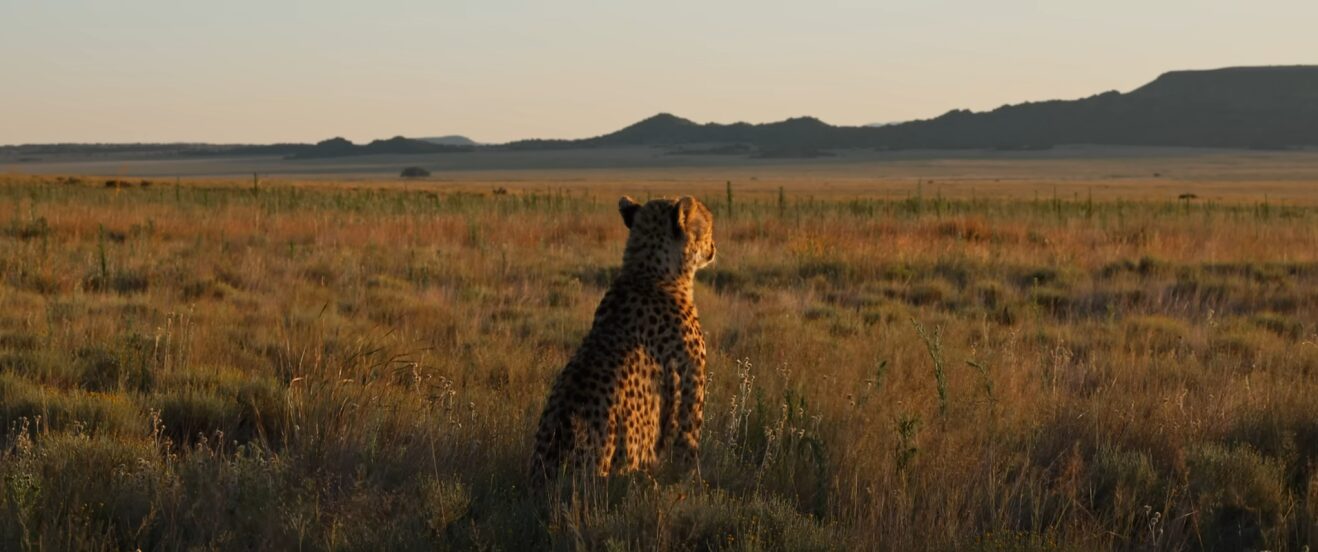
While some conservation efforts emphasize a separation from nature for its own protection, Kleer thinks differently. With industrialization, he says, we have "disregarded...the natural world, to the point that people have forgotten that we are connected."
His cheetah conservation means fostering a close, personal connection with the animals. His particular love for the species began when he first visited Tiger Canyon and met a pair of cheetah brothers. He'd only hoped to get a good view of them, but the pair approached him, purring, and invited him to pet them with friendly headbutts.
Since then, Kleer has spent much of his time in the bush with cheetahs, forming close friendships with several of them.
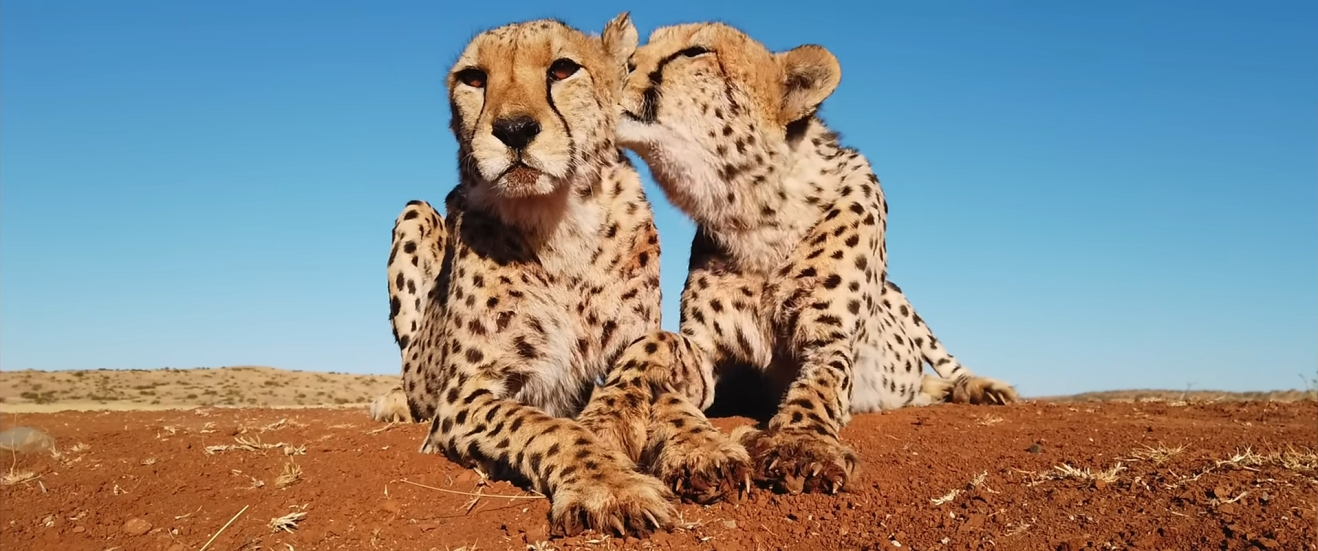
Tiger Canyon's cheetah reserve covers 970 hectares of bushland. Its inhabitants are Mara, her four cubs, her sister, and an adult male cheetah. Kleer recounts Mara's story, explaining how her anxious, shy personality transformed after she had her first cub.
"She's a very gentle soul...she truly enjoys our company," Perlerius says.
Mara will even bring out her cubs to spend time with the human visitors. The cubs' father is Mashai, who was raised in captivity and had to be taught how to hunt. Now, however, he is successfully living on his own in Tiger Canyon.
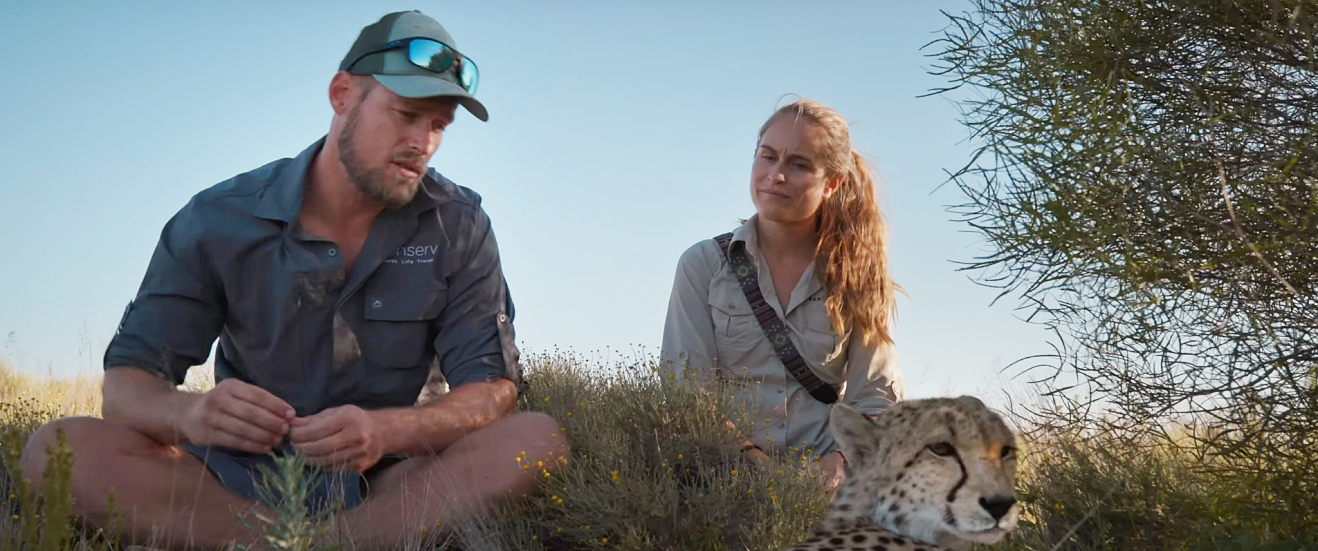
Saving the cheetah will help restore the entire ecosystem, Kleer explains, from the antelope on down to the plants. In the same way, the cheetah is connected to the ecosystem, people are connected to cheetahs.
Since the Tiger Canyon cheetah conservation program has started, they've released ten individuals into the wild, several of which have gone on to have cubs.
Kitturiaq chronicles a 620km canoe expedition across the Labrador plateau down the George River in Canada's northern Quebec. Professional adventurer Frank Wolf undertook the journey with partner Todd McGowan.
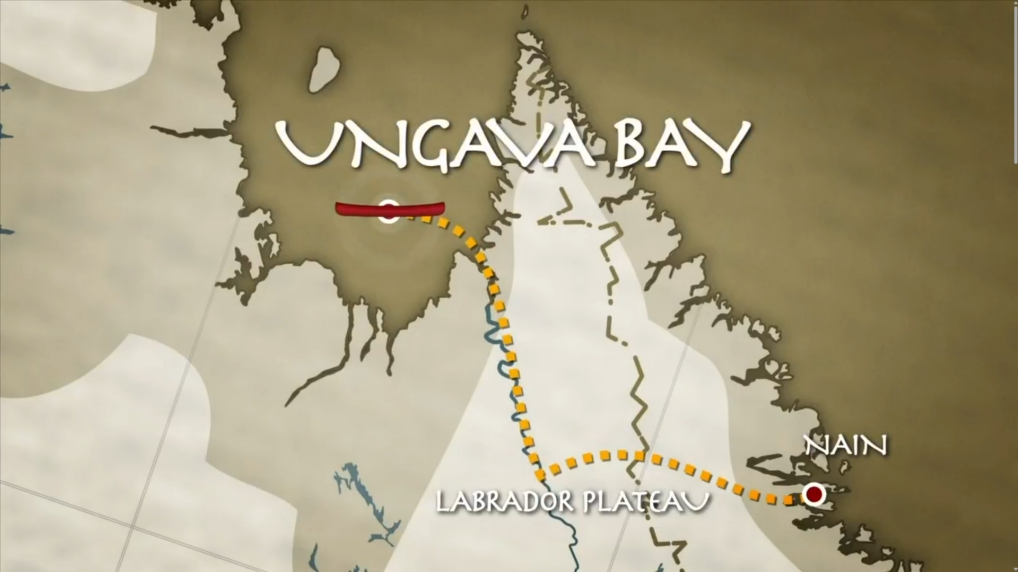
Wolf is bold in adventure planning and is perfectly willing to be bold in filmmaking, too. The film's narration is delivered by a fictional mosquito who chooses to tag along as an unofficial third party member. In fact, the Inuktitut word for mosquito gives the project its title.
Meanwhile, the Kitturiaq, named Malina, shares the story of explorer Hesketh Hesketh Prichard. (Evidently, his parents felt that one "Hesketh" wasn't enough.) Through Malina's narration, the story of the Briton's failed 1910 attempt to complete the route unfolds simultaneously to the main action.

The journey begins in Nain, now the northernmost town on the Labrador coast and the administrative capital of the Inuit region of Nunatsiavut. There, Wolf interviews local community leaders about the land his upcoming journey will take him through.
A 600m climb, with canoe
The first stage takes them a little north to the giant Fraser Canyon, which they must scramble up to the Labrador plateau. Malina's blackfly relatives are thick in the air, just as locals warned they would be.
But it's the portage they have to make that is the real killer. With no waterway to follow, they have to unload their gear, then drag it and the canoe 600m up a crack in the cliffs called Poungassé to the top of the plateau. Sweat and blood cover them both by the time they reach camp, and McGowan suffers sunstroke. The long subarctic summer day can be blisteringly hot.
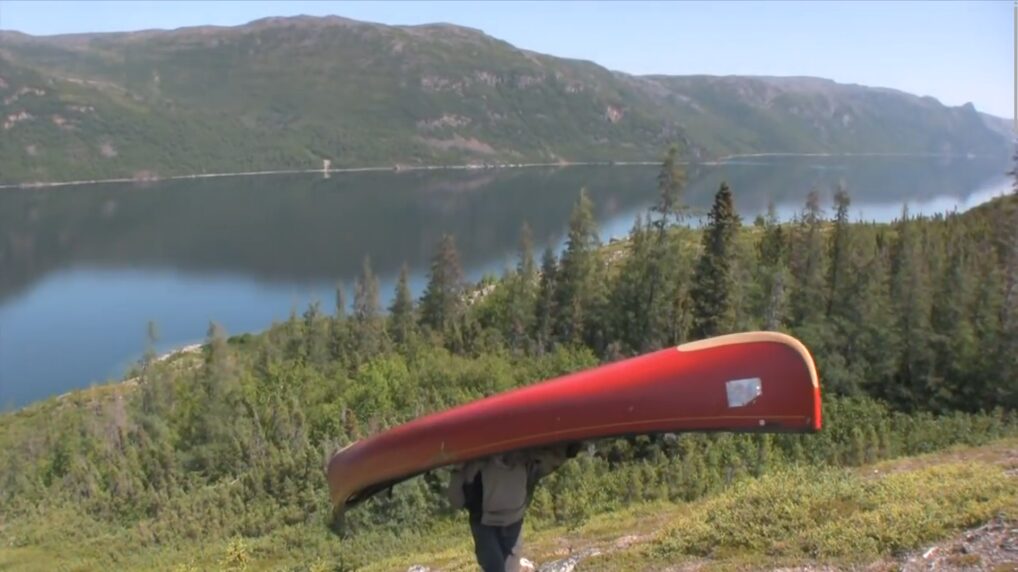
They're still doing better than Prichard, who took a steeper route and ended up abandoning one of his canoes. Atop the plateau, Prichard saw no waterways -- the plateau is mostly swamps and shallow ponds in this area -- and abandoned his last canoe, continuing on foot. Wolf and McGowan elect to drag theirs. After a brief descent into fly-induced madness, they're back on the water.
"People have been here, a long, long time before us," Wolf reflects, examining a piece of wood. No trees grow on the tundra, so an Inuit hunter must have brought the discarded log on his sled, or komatik, years before. This small moment is a quiet reflection on a core theme of the film.
The paddling and portaging continue. "They're beginning to act a little strange," Malina notes. A headnet makes a reappearance.
When they make it to Nunavik, they go fishing, while Nain politician Johannes Lampe reflects through a previous interview about how prohibitively expensive food is this far North. Caribou is much more cost-effective than groceries, and fishing is cheaper than buying fish. The land takes care of you, Lampe explains, when you take care of it.
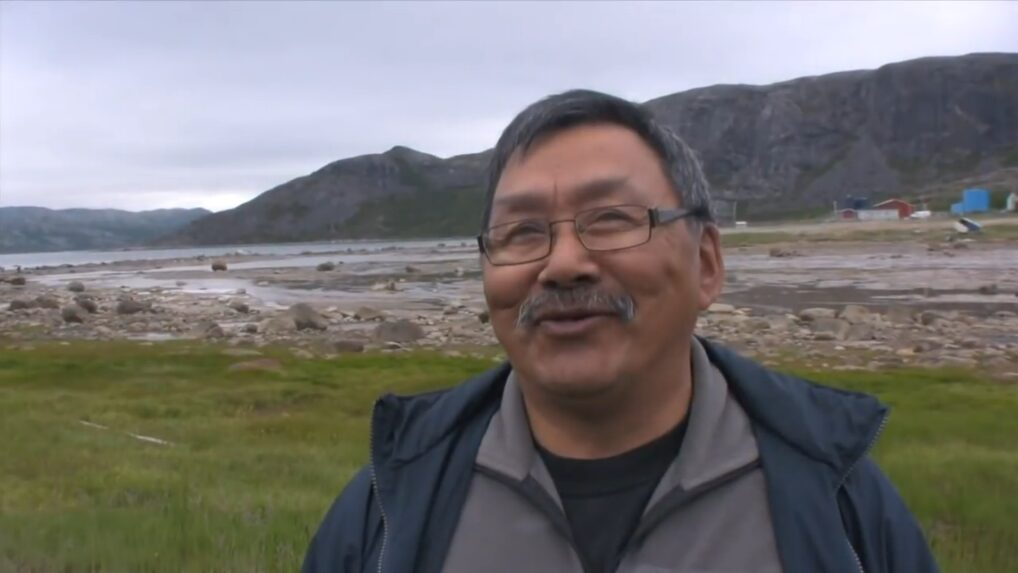
The George River
When Prichard and his team reached the George River, they hoped to meet the local Innu people. But these elusive people had already passed on to different hunting grounds. Without any canoes to handle the George River, Prichard had to turn back.
But Wolf and McGowan's portage drudgery paid off, and they still have theirs. Once they reach the George River on day 17, the kilometers begin to fly by. Speaking of flies, they remain innumerable. Soon, the canoeists reach the end of the river at Ungava Bay.
Llanberis in Northwest Wales is dense with routes that give the region arguably the best climbing in Britain. But ascending the lines of the green and grey Cymru hills is more than just technical. Adra, a new documentary, delves into the long history of Welsh climbing and its importance to local identity.
Friends Lewis Perrin-Williams and Zoe Wood grew up on the cliffs of Llanberis. Together, they take the viewer along on various iconic local climbs, like the Left Wall of Dinas Cromlech. When it was first ascended in 1956, climbers wore heavy boots and used railroad ties for protection. A fall meant a serious injury at best.
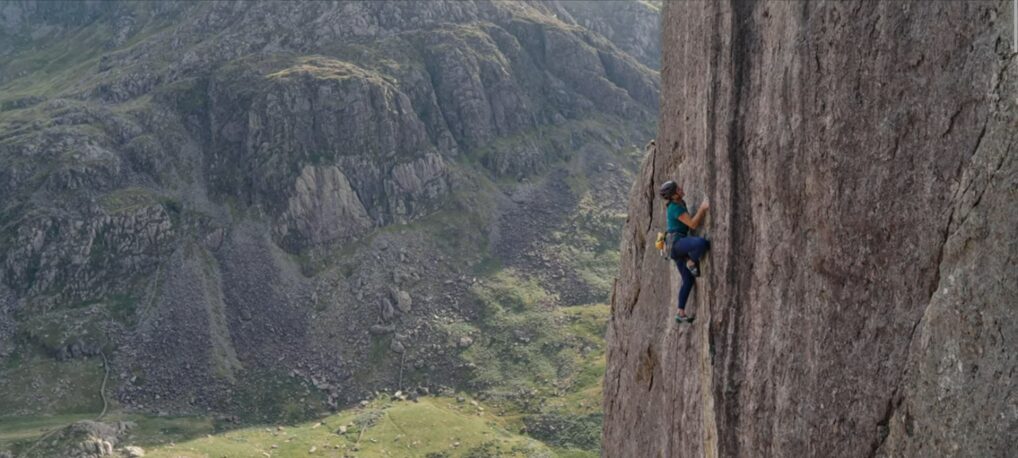
Lewis's father, mountaineer and author Jim Perrin, recounts the neglected history of native Welsh climbers. Recorded first ascents during earlier eras went to famous English climbers like Noel Odell, who used the hills of Wales as a proving ground before moving onto the Alps and Himalaya. But local Welsh copper miners were the true pioneers of many routes.
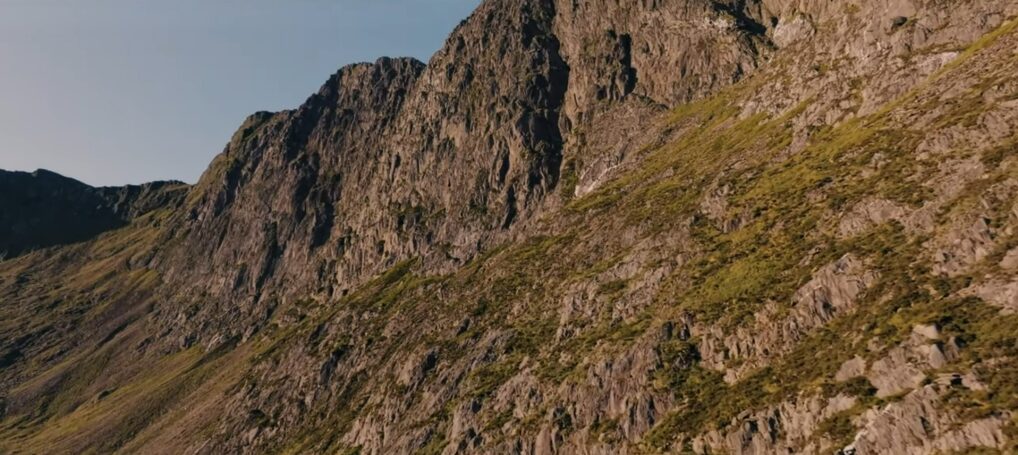
Devil-may-care attitudes
Older climbers like Jim Perrin draw a connection between the daring, "devil-may-care" attitudes of climbers in the 1980s and the rise of Margaret Thatcher. Thatcher's tenure is remembered with intense hatred in Wales. Her economic policies left millions unemployed, and the violent police response to the 1984-5 miners' strike shocked the nation.
Adra explores how climbing was counter-cultural in 1980s Wales.
"My climbing came from not being subject to social conditioning," explains John Redhead. Many of the young people in the area were out of work. They started climbing as a way to escape their daily anxieties.
Lewis explains that climbing isn't just a sport but a way of celebrating and communing with his homeland. Adra means "home" in Welsh, a language that was illegal to speak in court until 1942. Celebrating the Welsh language, heritage, and, yes, climbing history is an act of resistance to centuries of British rule.
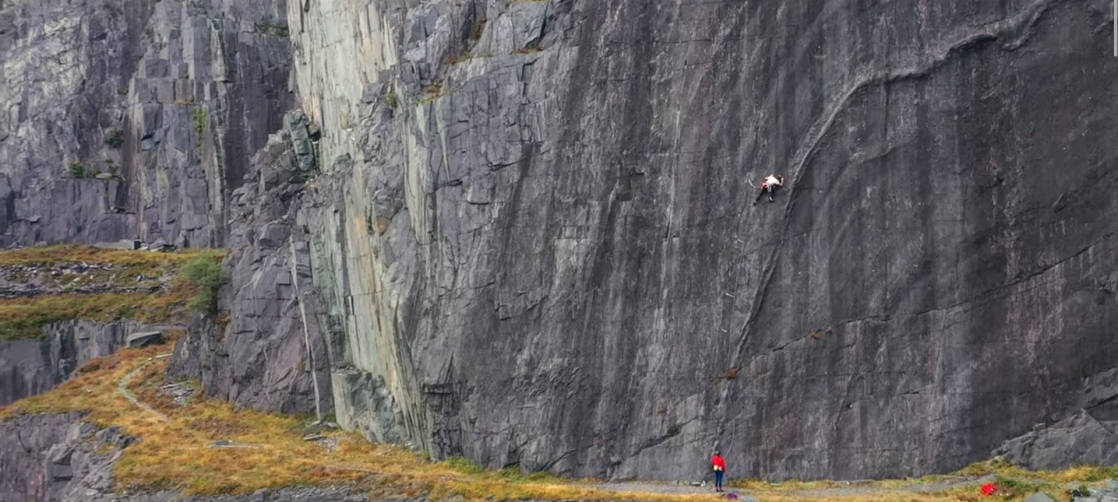
Climbing, Adra explains, is ancient and indigenous in Wales. But it also nourishes an immediate, living community.
This short film examines what it means to be a snowboarder who isn't social media famous. Now I know what you may be thinking: Why even watch a film if the subject is cloutless? Well, he does fight fires, if that sweetens the deal for you. Snowboarder Joe Lax is not a household name and doesn't want to be. Dark Horse explores exactly what that looks like.
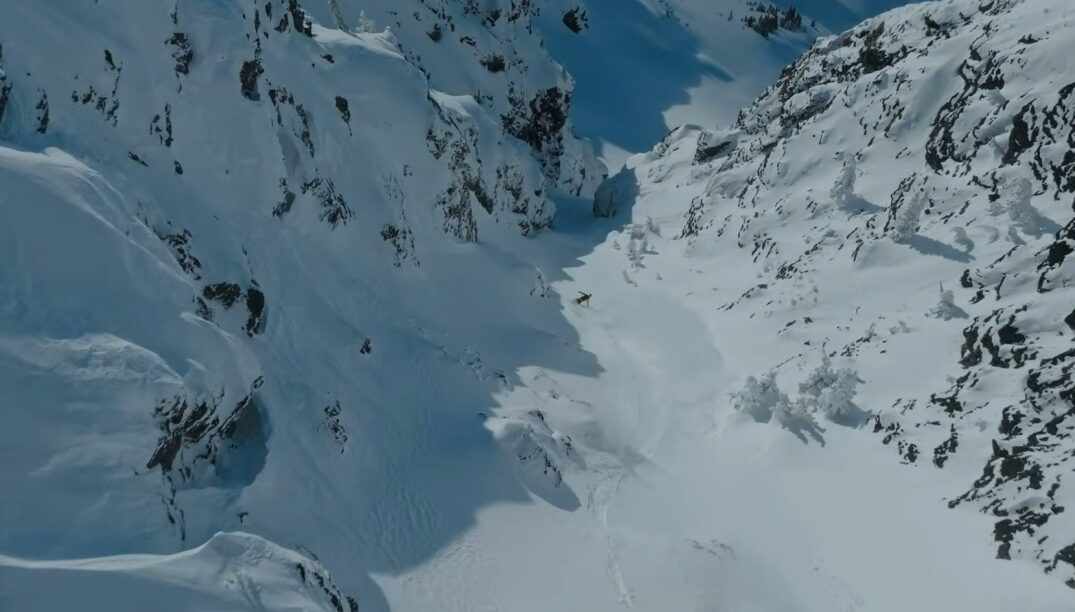
Documentary photographer Brad Slack discusses his subject's elusive, quiet nature. The film opens in Slack's studio, and we first see Lax through his lens. Then, we hear from fellow snowboarder Joel Loverin, who stumbled upon Lax's enigmatic Instagram account.
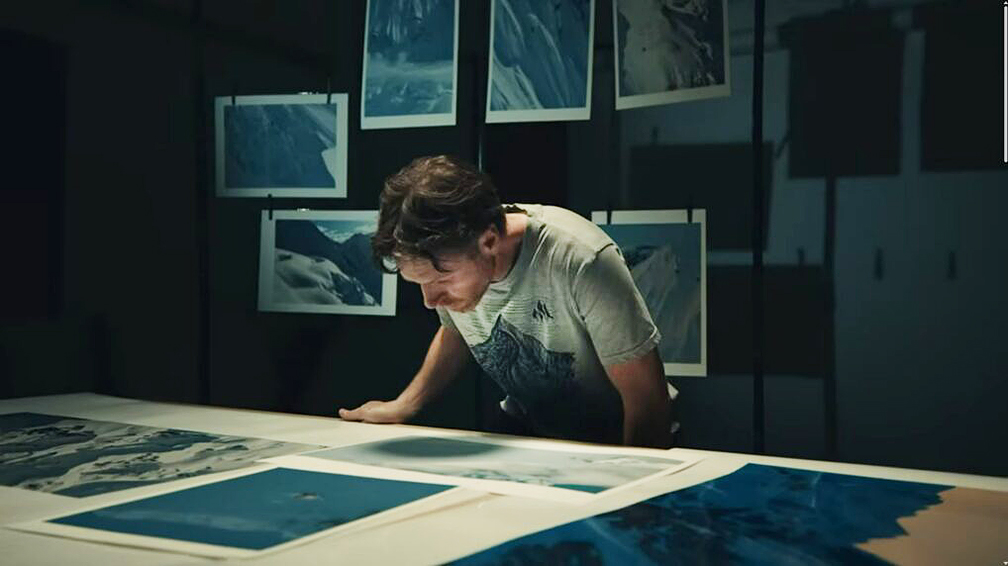
Whiskey Tahoe
Under the name Whiskey Tahoe, the account posted clip after clip snowboarding steep lines, all without any locations or personal information. Social media comments fill the screen with requests to know more -- where is he, who is he?
He's Joseph Donald Lax. Born to a Saskatchewan farming family, he left home as a teen. He went to Whistler, British Columbia, then a hub for snowboarding culture. There, film companies lurked, creating compilation tapes of the most impressive athletic feats. This is the culture Lax came up in.
But he wasn't interested in going with the crowd. Lax gets up early, what he calls "psycho early," to ensure he is the only one on the mountain. Often, he finds and rides new lines in places no one else dares to try.
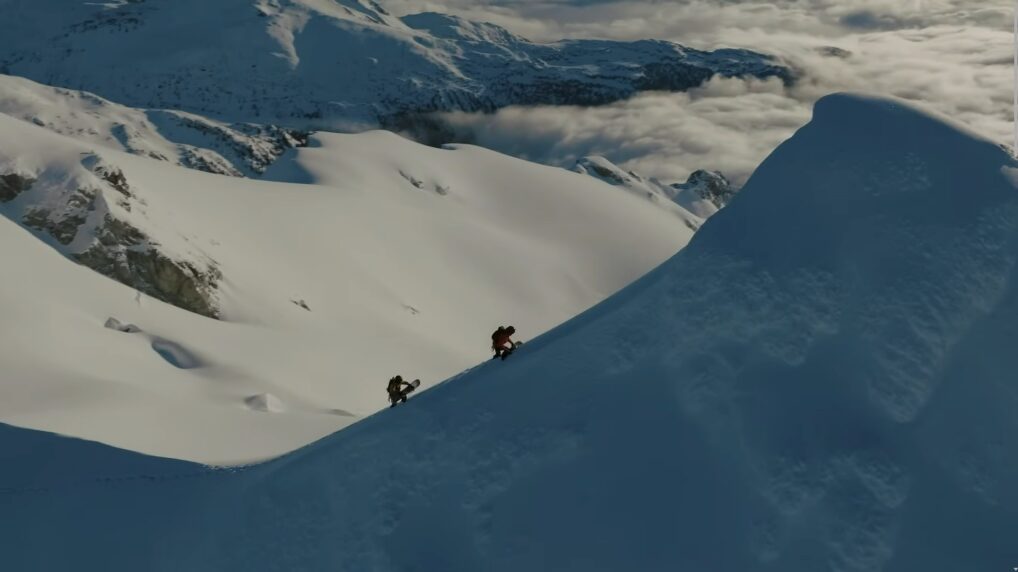
Part-timer
Being an underground legend is technically only a hobby, though. By day, he's a firefighter.
"I never saw snowboarding as a career pursuit," Lax explains. He started firefighting as a means to support his time in the mountains. Work hard in the summer, and take the winter off to snowboard. Over the years, though, he's worked his way up to an operations chief. He has seen fire season grow fiercer and fiercer, threatening the mountains at the center of his life.
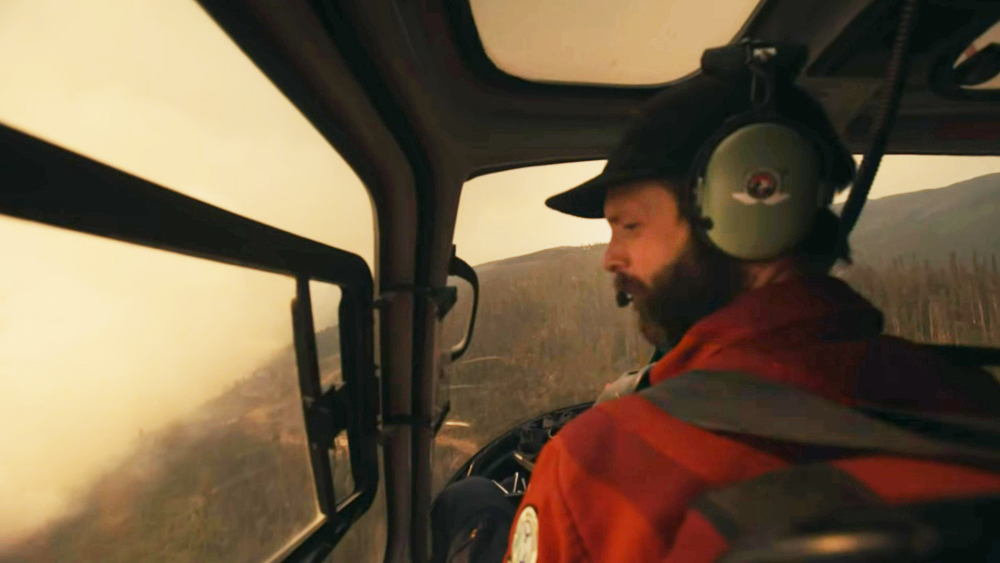
Something else came along, too, to threaten the primacy of snowboarding -- a wife, Ulla Clark, and two daughters. Instead of choosing between family and the mountains, he brought his family to the mountains. The four of them live in a cabin, and he taught his daughters to snowboard and go on backwoods adventures.
Lax snowboards purely for the love of it and has built his life around it.
"it's 'till the wheels fall off," he promises. His friend Joel thinks they'll be riding the slopes together as old men.
North to Nowhere is the funniest film about North Pole expeditions that you'll ever see. Polar explorers have always taken themselves very seriously, but luckily Montreal filmmaker Josh Freed took a bemused perspective on the crazy cast of characters vying to reach the top of the world one spring back in the late 1980s.
At that time, modern North Pole expeditions were in their heyday. In 1986, American Will Steger and his party made the first unsupported dogsled trip to the Pole. That same year, Jean-Louis Etienne of France skied the 760km alone. (Earlier, in 1978, the great Japanese adventurer Naomi Uemura had reached it alone using dogs.)
These were serious adventurers, but every year, several less prepared travelers also showed up in Resolute Bay, Canada, touting their great plans to reach the North Pole in various creative ways. Resolute's beloved outfitter, Bezal Jesudason -- featured in the film -- provided logistics and tried to advise them as best he could. Jesudason, who improbably came to the High Arctic from India, used to joke that he himself was planning an expedition to the North Pole by elephant.
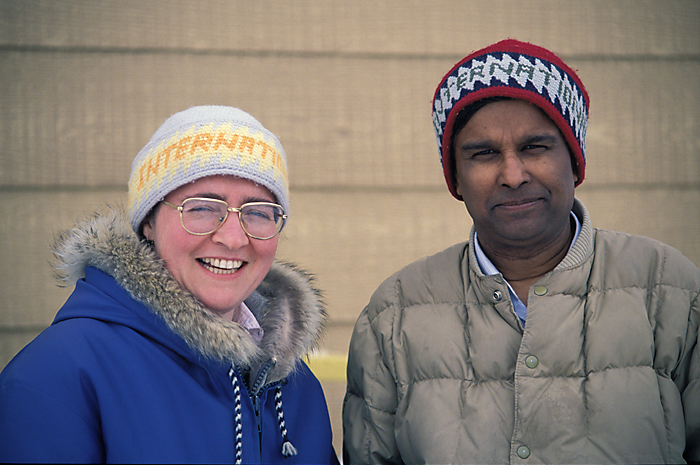
Do you need oxygen?
In this pre-internet era, information about the North Pole was not as easy to come by as it is today. Some would-be polar explorers would phone to ask if they needed to bring oxygen "that high up." One British man imagined that he could walk about 80km a day over the broken surface of the Arctic Ocean and was going to show up with just 10 days' food to reach the North Pole. "He was even so generous as to bring two days' extra for bad weather," Jesudason later told me. Luckily, the outfitter managed to dissuade the man from coming.
Scandinavians were usually competent, but one spring, two older Swedes showed up in Resolute with no idea how to use a camp stove. Unable to melt water during two brief shakedown trips near Resolute, the experience so humbled them that they went home without even beginning their expedition. Others spent thousands of dollars to charter an aircraft to the north end of Ellesmere Island to begin but quickly realized they were in over their heads. Typically, they called for a pickup a few days later, citing back injuries as a convenient excuse for quitting.

An influencer ahead of his time
The expeditions profiled in North to Nowhere belong to this zanier crowd. Two French pilots/gourmet chefs set out to fly their canary-colored ultralight plane to the North Pole. There was Shinji Kazama, a Japanese Yamaha salesman who -- heavily supported by Inuit with dogsleds -- took his motorcycle to the Pole. Then there was Dick Smith, the founder of Australian Geographic magazine, who sought to go there in his helicopter. The extroverted Smith was a visionary who anticipated the selfie/Instagram generation and walked around holding a lightweight movie camera pointed at himself and breathlessly narrating the adventure that was about to unfold.
With admirable restraint, North to Nowhere documents the goings-on during this brief Golden Age of what people in Resolute used to call the Silly Season.
Climate change, politics, and difficulties chartering aircraft have ended the hijinx for the time being. The last full-length North Pole expedition was in 2014.
This spring, Tyler Andrews hopes to summit Everest in 16 hours from Base Camp without supplementary oxygen or Sherpa support. The 34-year-old American is no newbie to Himalayan records. He is one of a growing number of climber-athletes who are bringing their mountain running skills to the Himalayan peaks, aiming for FKTs (Fastest Known Times).
Manaslu before Everest
It likely wasn't a coincidence that when Andrews announced his Everest FKT project earlier this week, his sponsor La Sportiva released 9 Hours on Manaslu, the film about his FKT on Manaslu last year. Andrews ran from Base Camp to the top of the eighth-highest mountain on Earth in 9 hours and 52 minutes, beating Pemba Gelje Sherpa's previous record. Andrews was also racing up the peak in 2023 when Pemba Gelje summited. But that year, Andrews didn't feel well on the upper sections and turned around without summiting.

Back home, Andrews had to deal with a badly damaged Achilles tendon, which required surgery. It took a lot of rehab and training before he finally returned to Nepal and broke the Manaslu speed record 12 months later.
For that reason, Andrews sees his Manaslu climb as "a story about failure and redemption," he told ExplorersWeb.
Fall and rise
The film also shows Andrews' personal transformation from a kid interested in math and music to an elite long-distance runner. He dealt with depression but bounced back when he discovered the wild world of mountains and open spaces on Ojos del Salado in Chile in 2020. He began to travel the world in search of thin air, high summit views, and fast times.

Andrews' regular climbing and running partner, Chris Fisher, did most of the Nepal footage on this film. Yet the most intense sequences are those from Andrews' headcam during the ascent: his feet on the frozen ground, his gloved hands on the fixed ropes, and his shadow reflected on the ice seracs. When the runner lifts his eyes, we also see views of Manaslu, a strikingly beautiful peak.
The film will provide a great background for those interested in following Andrews' upcoming Everest expedition and want to understand what's behind the feat and the character.
To learn more about the film, you can listen to this episode of Andrews' podcast, Talking with My Dad. In it, he discusses the challenge behind the scenes and shares details about his physical and mental training with his real-life dad, Tim Andrews.
Painting the Mountains documents the work of Matthew Tufts, a photographer and journalist, as he attempts to capture the mountaineering exploits of his companions.
In Patagonia, climbing is well-established. But the stark granite faces hold little snow, and skiing is more rare. The lines are dangerous -- and spectacular.
Matthew's goal was to follow high-level French skiers Aurel Lardy, Vivian Bruchez, and Jules Socie as they made new descents in the legendary Patagonian Andes.
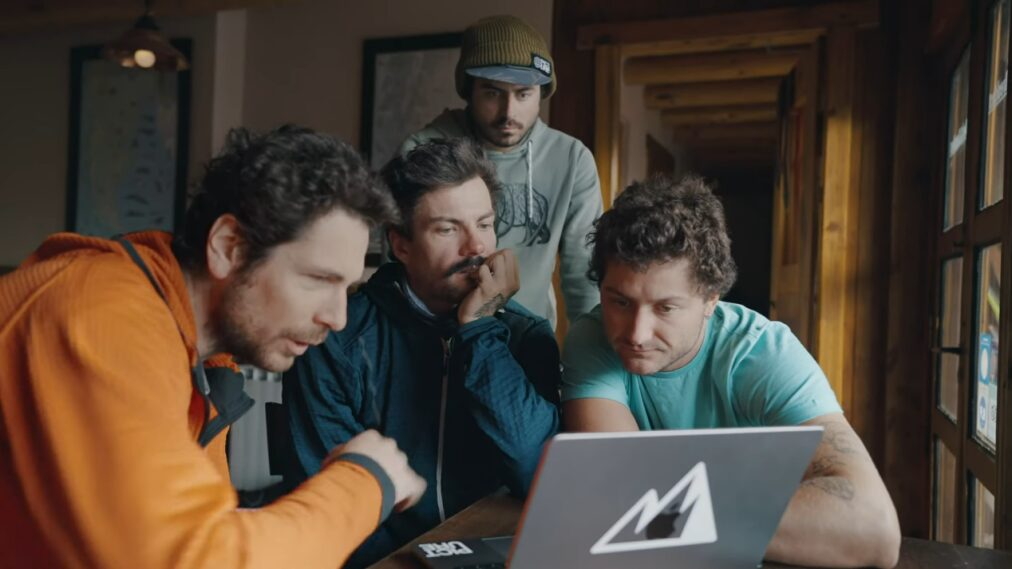
Painters and Conquistadors
Matthew explains that Renaissance painters could spend six months just mixing the colors they used for a painting and another six months preparing the canvas. His photographic work in Argentine Patagonia was similar.
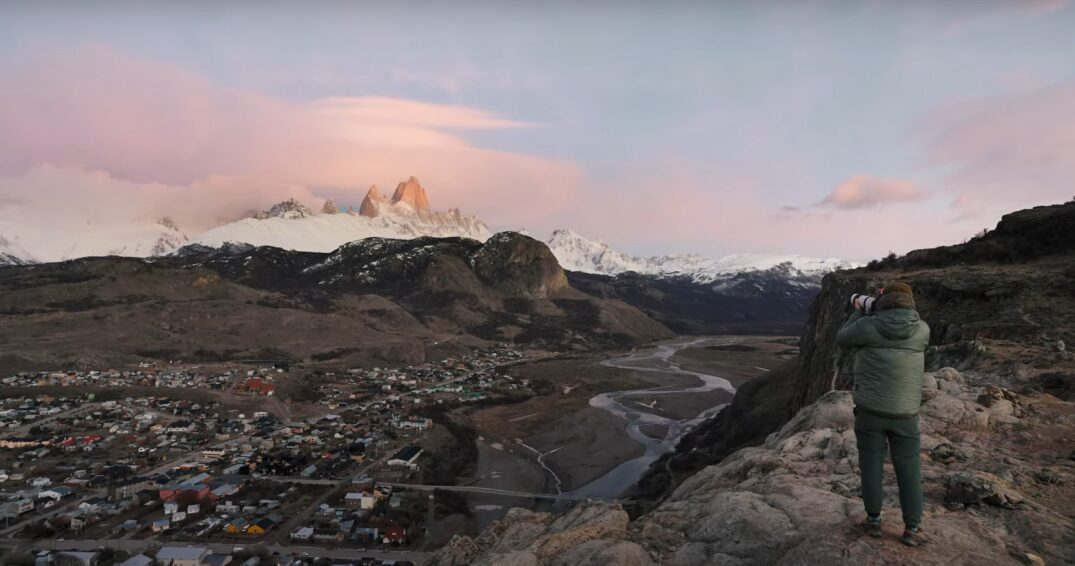
He first visited the town of El Chaltén years earlier, staying for three months to write an article. He self-funded the trip, determined to establish a connection with the place and the local people. Matthew was wary of coming in like a "modern-day conquistador," exploiting the land for his own gain.
Throughout the expedition, Matthew considers how he might give back to the community and the people who live at the foot of the famous mountains.
A new way to look at it
The skiers bring their own artistic vision to the slopes. The descents they attempt are extreme, dangerous. They see a path where others see only a cliff. Matthew describes one such line as "a thin ribbon painted across a wall of granite."
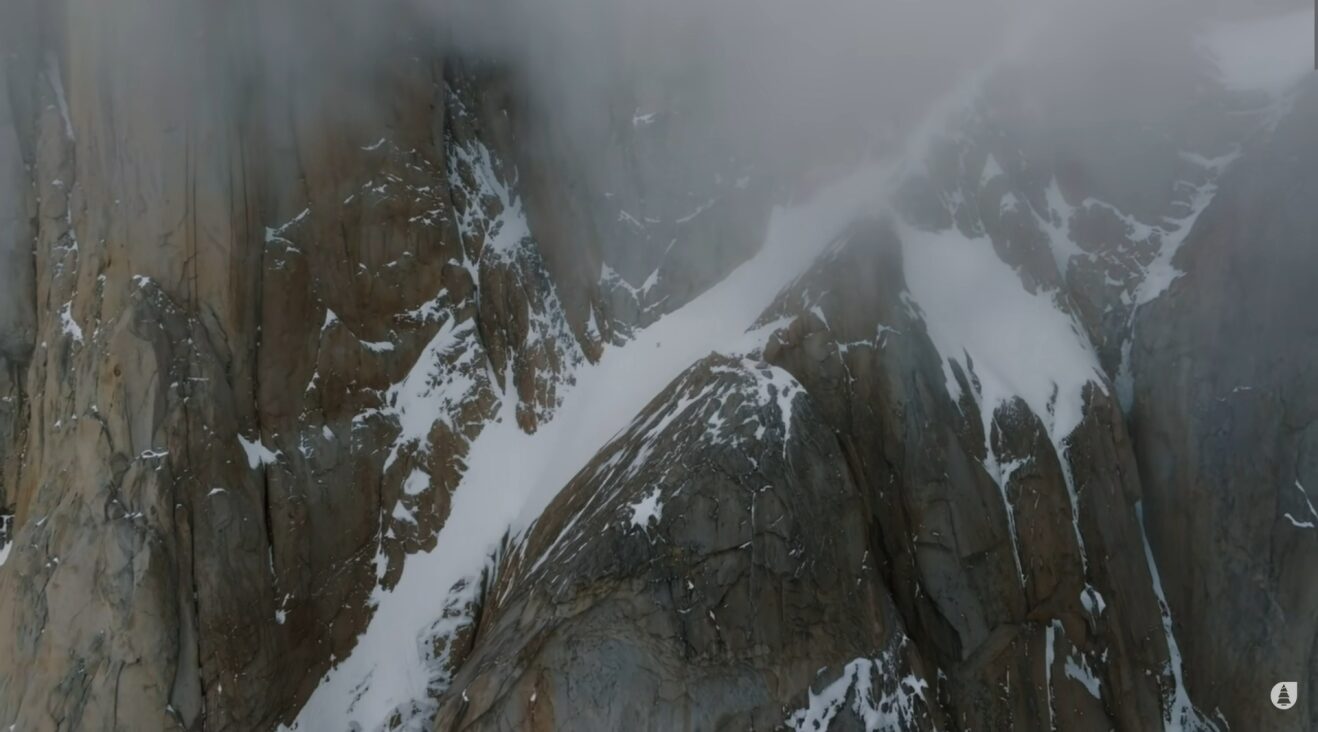
Through Matthew's camera, the skiers boldly carve their way through the mountains, across never-before-attempted slopes. Local legend Max Odell, who has been skiing El Chaltén for many years, says that the new perspective of the Frenchmen gives him his own new perspective. They see lines where he hadn't dared to imagine skiing, and it inspires him to get back out there.
Max Odell is known as the Godfather of Skiing in El Chaltén. Matthew is proud that they are inspiring him to return to his passion.
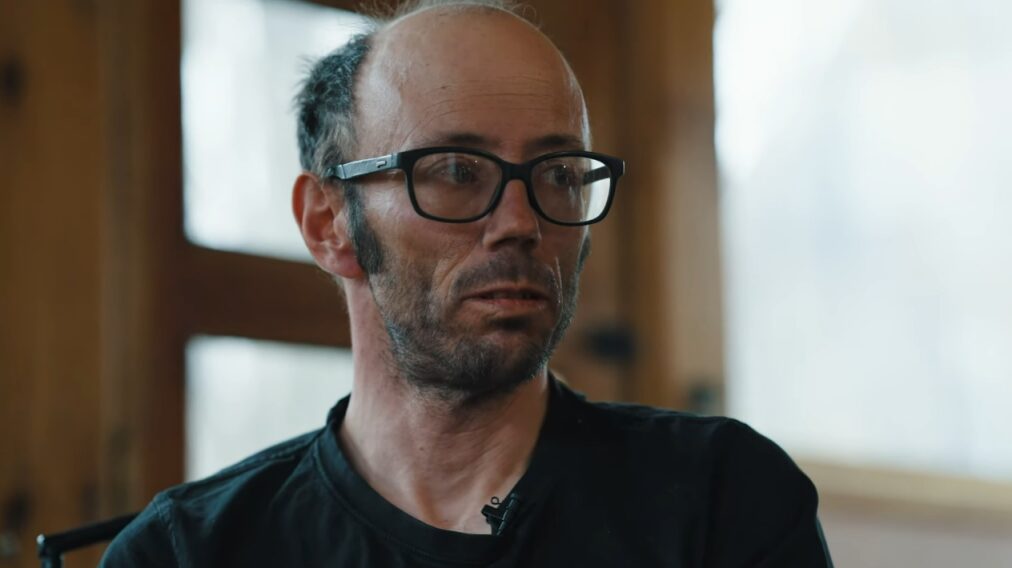
The second descent
The climax of their expedition is making the second-ever descent of the Whillans-Cochrane Ramp on Aguja Poincenot. The late extreme skier Andreas Fransson made the first descent in 2012. Descending the steep, exposed line is both dangerous and difficult.
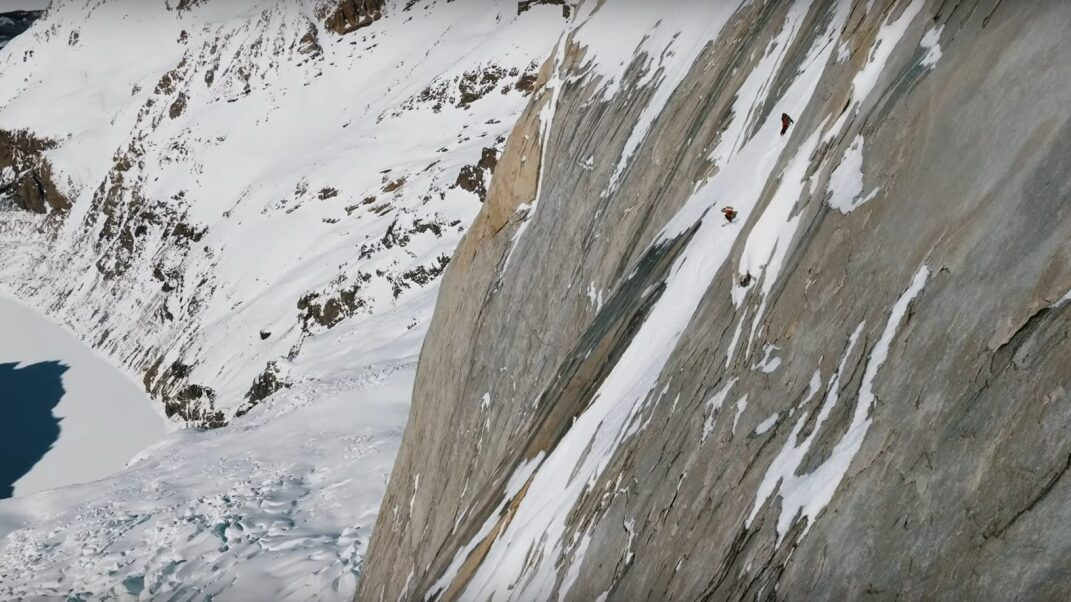
After a hard climb, however, they turn and ski down the ramp, emerging unharmed at the bottom. Matthew, looking on, sees them as artists. They are, he says, "painting the mountain."
The camera pans up a minimalist landscape of snow and stone. Jagged spires stab into the air, their dramatic profiles accentuated by the sharp drone of a male voice singing wordlessly. It might be the beginning of Meru -- until the throat singing cuts out, and the narrator says, "My bad, little something in my throat."
The Crystal Towers: a Yukon Climbing Story is one of three projects funded by the Yukon government for its 125th anniversary. This elegant short documentary is part climbing film, part lighthearted travelogue, and part advertisement for the sparse beauty of Yukon.
Radelet Peak
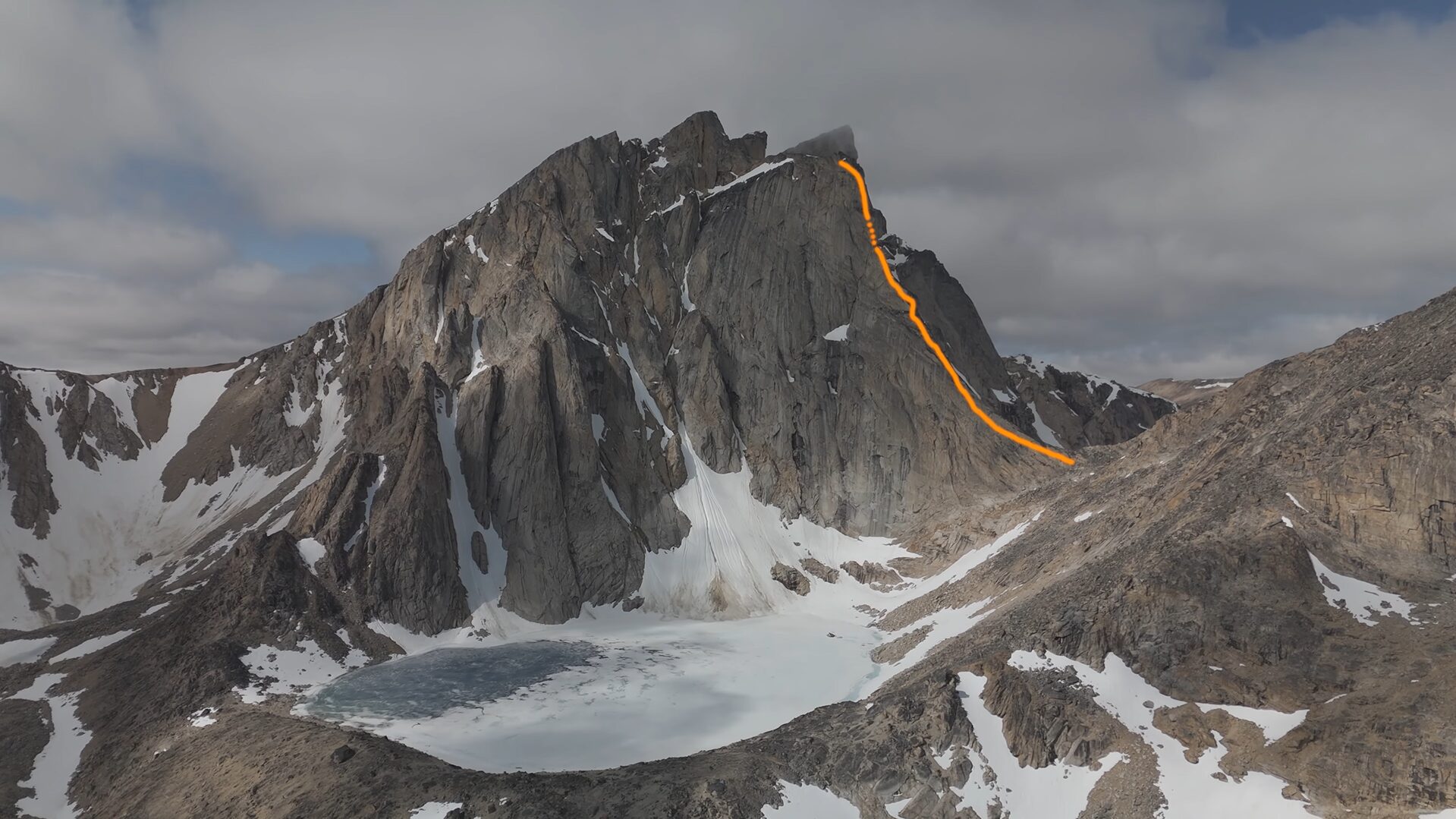
One hundred and twenty kilometers south of Whitehorse, Radelet Peak lurks above a small lake, still mostly frozen in July when the documentary was filmed. Only one of the team, self-professed flamingo fan Zach Clanton, had made the trip before. Clanton conceived of a new route up the knife-edge arete on the mountain's east side.
But bolting a new route would take hardware, and getting hardware to Radelet Peak would take a helicopter. Where might a "quintessential climbing dirtbag," in the words of his climbing partner Rob Cohen, acquire many thousands of dollars for such a flight?
The government, as it turned out. With support from the Yukon125 fund, four climbers set out with a drone, a carton of Metamucil, and (almost) enough gear to bolt a new route.
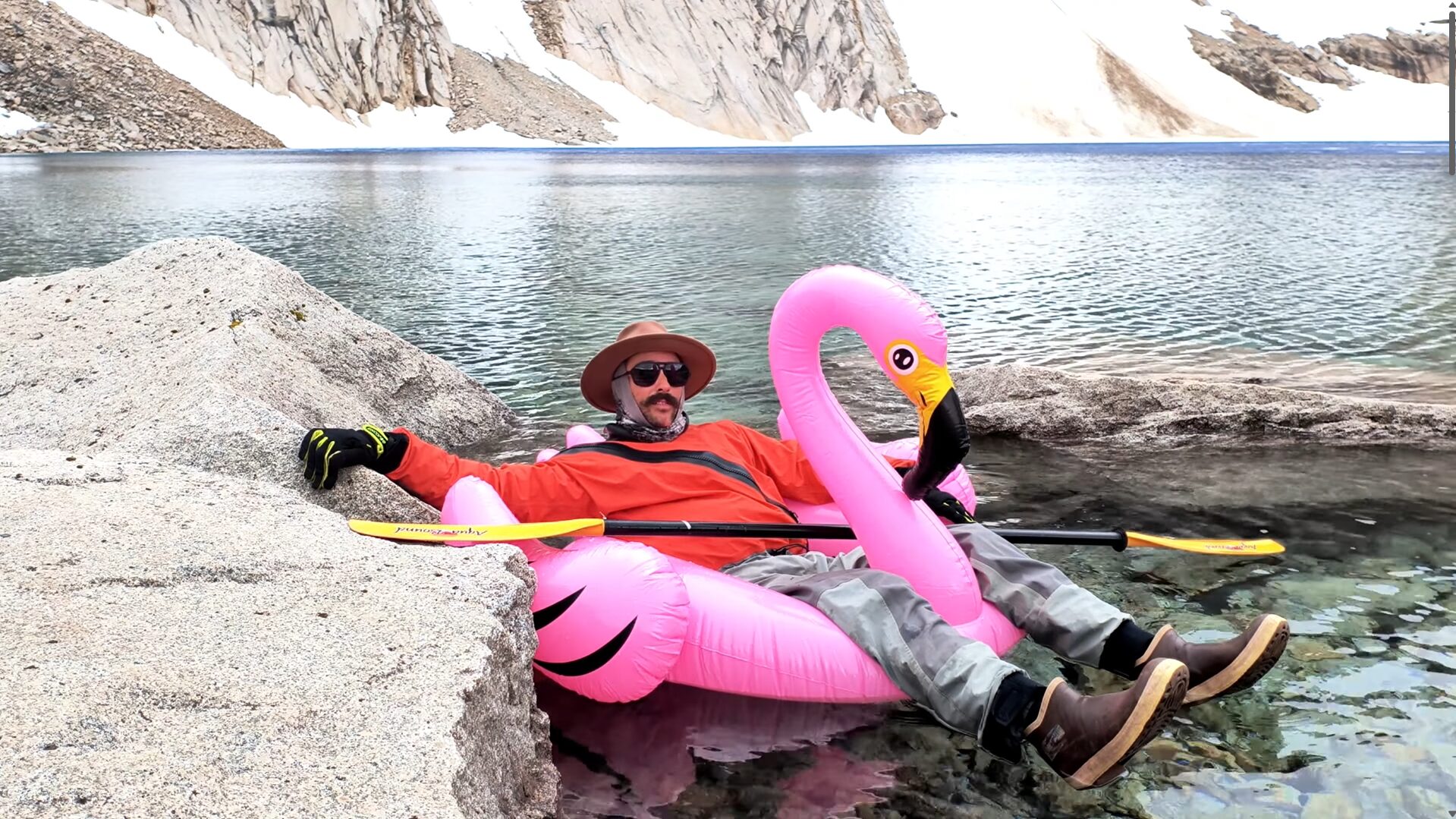
The route
The Crystal Towers starts gently as its protagonists tackle the ridge à cheval. The slope isn't steep, but we are frequently informed that it's wickedly sharp, and they would rather it weren't so sharp, thank you very much.
Then the first headwall flaunts up above them, and the documentary comes into its own. Climber and filming lead John Serjeantson effectively uses his drone for striking panoramas. One features Dave Benton nestled in a massive maw of rock just under the subsidiary peak.

Most of the route is crack climbing. Both finger cracks and hand cracks snake up seemingly impassible granite walls. Unfortunately, most of this climbing didn't make it to camera.
It's in close quarters that The Crystal Towers struggles: only a few short sections of GoPro footage supplement the wide shots, and the team largely did not record leads from below.
The lack of footage confuses the narrative. One climber taps out of summit day, referencing difficulties on the route never shown onscreen or explained to the audience.
But while it's clear that these are more climbers than documentarians, that doesn't stop them from creating a lovely film. The shots are clean, showcasing the splendor of the landscape, and the narration brings the audience along on the most exciting pitches. It's always a good sign when a video leaves you wanting more instead of less.
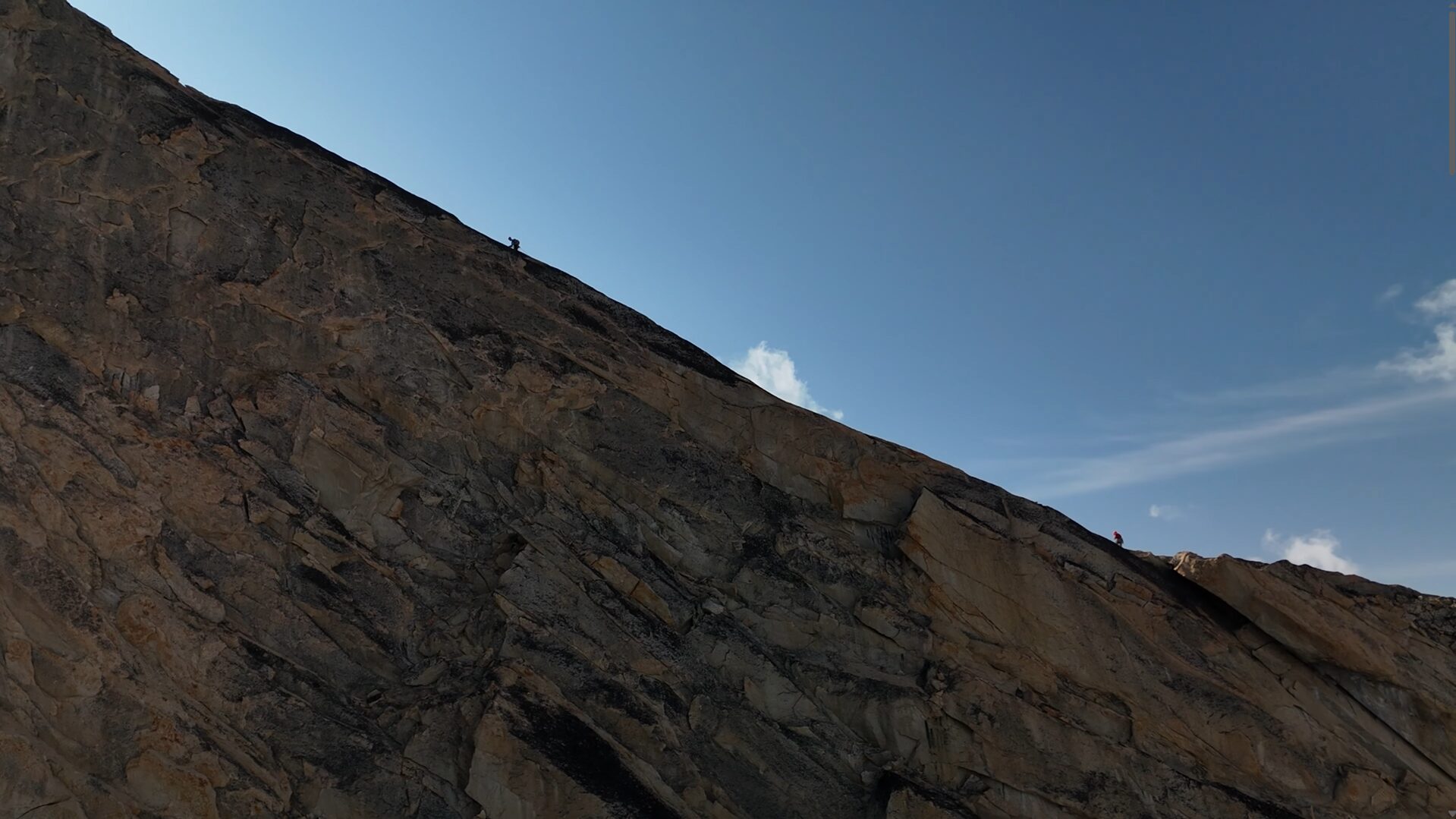
The film meets its goals
As for whether the team sends the route, you'll have to watch and see. But the bolting they carried out will allow a new generation of climbers to explore this region. Said Zach Clanton, "Our goal was to create somewhere that people can walk in with just a rack and a rope and have a super good time, and explore a part of the Yukon they never knew existed."
And as a promo for the beauty of Yukon, well, halfway through, I was already googling plane tickets.
Thirty-two-year-old professional cyclist Lachlan Morton holds the record for the fastest lap of the Australian mainland by bike. The previous record holder rode the entire 14,210km coastal route in 37 days. Last year, Morton completed the same circuit in only 30 days, riding an average of 450km each day for a month.
The Great Southern Country is a film about the process -- and struggle -- of setting that record.

While the biking effort was Morton's alone, a small group of family and friends drove a little blue RV alongside him to provide support.
His wife, Rachel Peck, embraced her husband's newest and most ambitious adventure with cautious enthusiasm. Tom Hopper served as Morton's dedicated bike mechanic, and Athalee Brown as Morton's masseuse.

Morton's elder brother Angus, with videographer Scott Donald Mitchell, filmed it all. Angus had cycled professionally himself, but in the past decade, he has turned to the camera. Finally, Graham Seers, Morton's coach since childhood, rounded out the team.
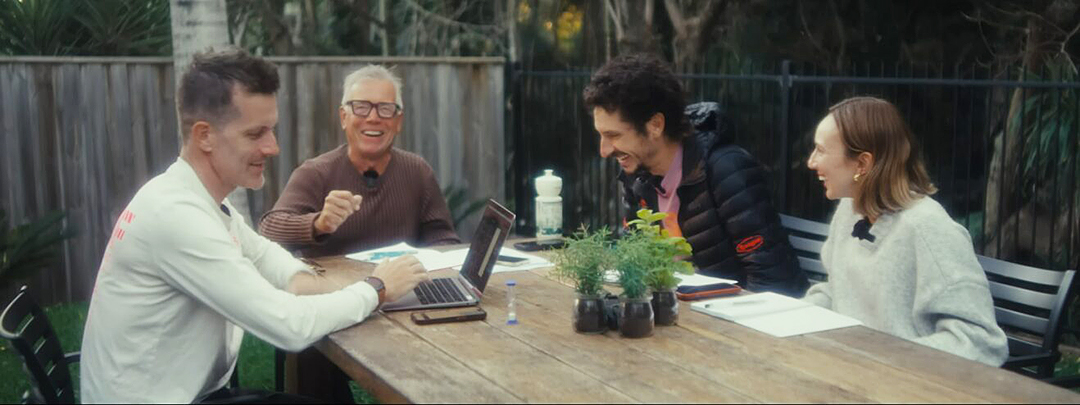
Ice baths
The timeline was incredibly ambitious, even if nothing went wrong. So, of course, things went wrong. Only days into the journey, Morton became ill with food poisoning. Undeterred, he continued cycling that day without eating, determined to maintain his daily goals.
The team gently attempted to convince him to slow down, but Morton kept to the schedule.
Luckily, Morton bounced back quickly. But as the days went by, even the best-conditioned body and the most determined mind began to falter. His legs became red and swollen, and increasingly, he spent his time off the bike in ice baths. When heat and strong headwinds made conditions untenable, the team struggled to convince Morton to stop.

"You always want to push... to see what you're capable of," says Morton. "That's the whole point of doing it."
More immediate dangers also arose. The most notable was from traffic. In one harrowing moment, a truck drove Morton off the road. After several close calls, they altered the route to avoid major highways.
While he sometimes didn't stop even to eat, Morton did once pause to help an injured bird off the road.
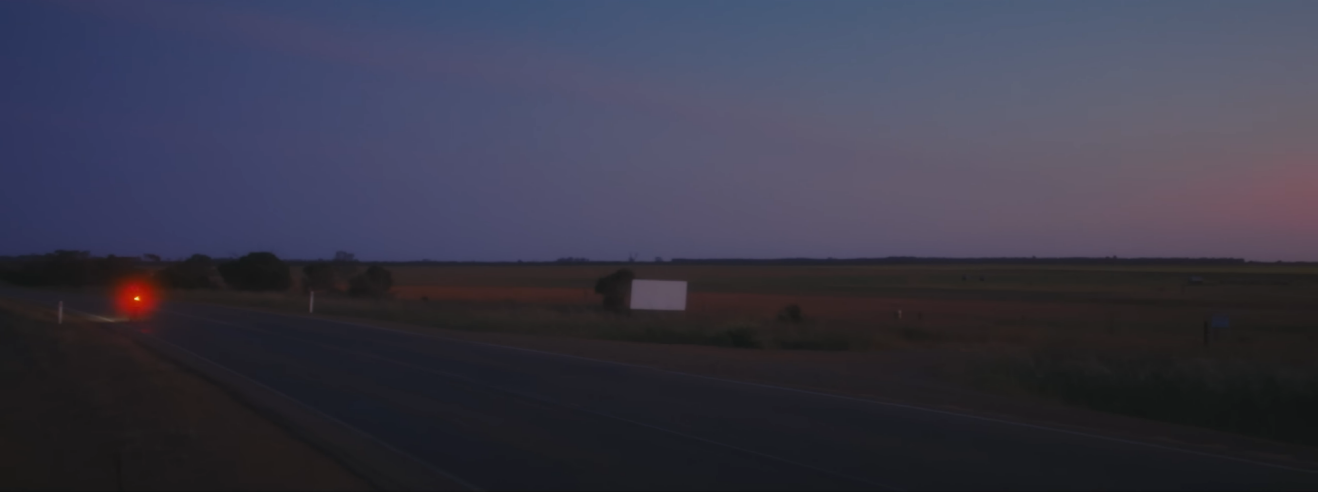
Understanding the land
The journey wasn't just a test of endurance. For Morton, born and raised in Australia, it was as much about the land he would be covering as it was the distance. The ride is about "understanding where I'm from."
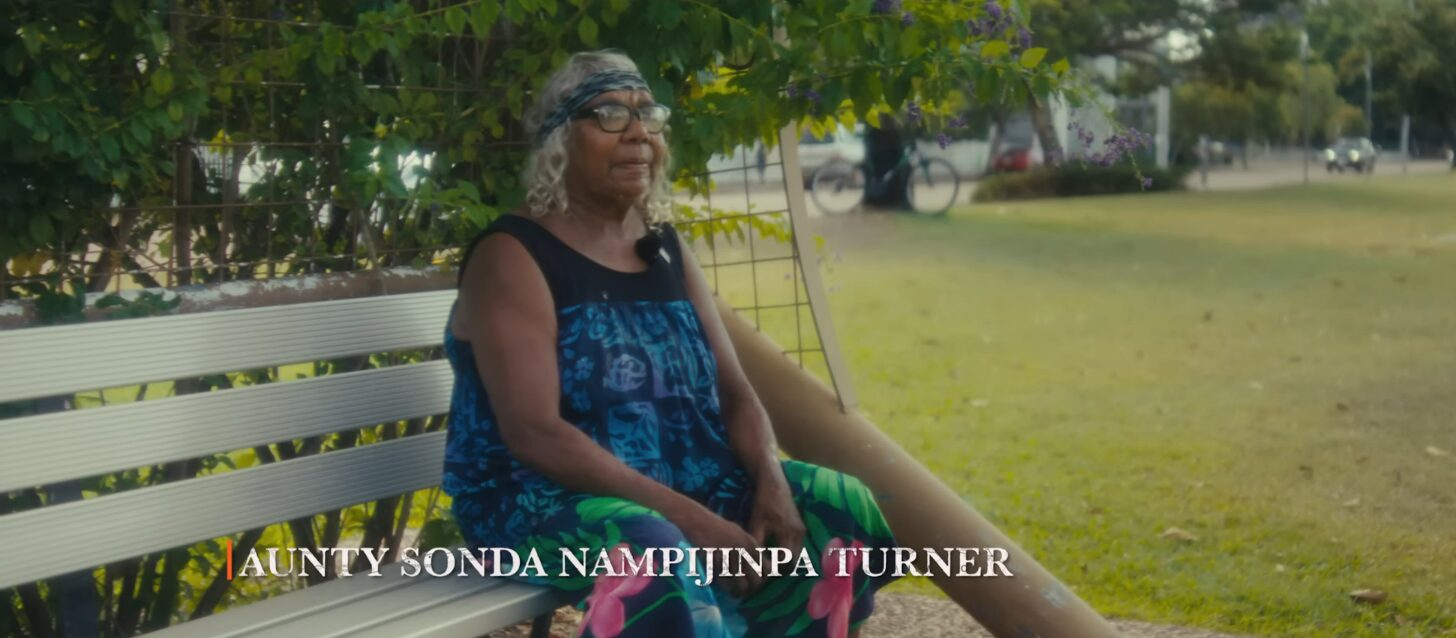
This meant engaging with the indigenous people. The film includes several sections of narration in Indigenous Australian languages and highlights the people and cultures of each region.
A New Way Up shows two mountaineers combining climbing and paragliding in a novel way on a previously unsummited Karakoram peak.
Fabi Buhl is a German climber, Will Sim is a British alpinist, and Jake Holland, a pilot and filmmaker, is the narrator. The itinerary integrates all their skill sets.
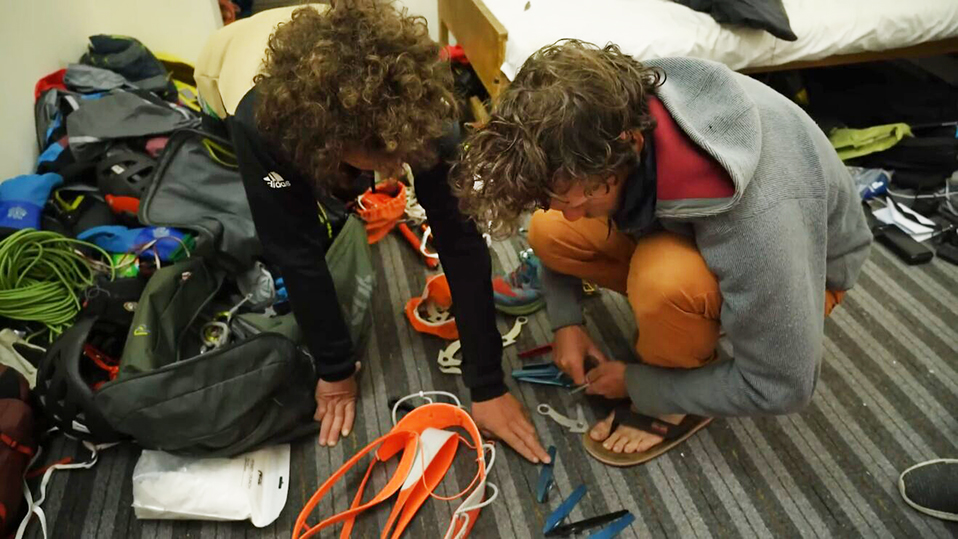
Buhl and Sim are shown going over equipment, comparing different clips, carefully weighing gear, and debating every detail. Their expertise and careful planning are on display.
Gulmit Tower rises 5,801m to form a rectangular jut of granite, powdered with snow. Previous attempts to reach the summit have been unsuccessful. Those earlier attempts all approached from the opposite side, from Gulmit village. As Holland lays out, their expedition will attempt it from the south side by paragliding onto the tower and then climbing the final stretch.
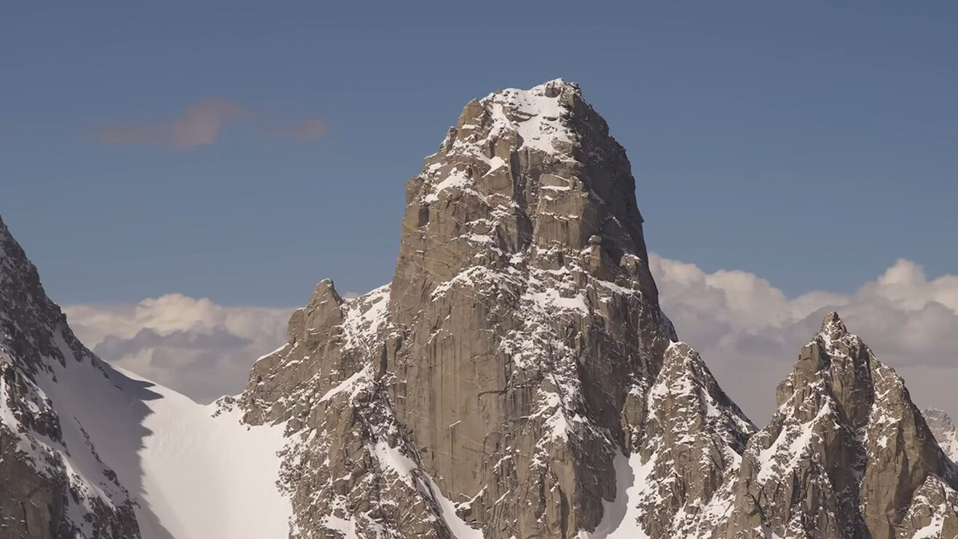
A comfortable base
The expedition based itself in the green and comfortable town of Karimabad rather than a freezing tent camp. If the paragliding is successful, it will turn a strenuous hike of many days into an hour-long flight. But once in the air, they are at the mercy of the weather.
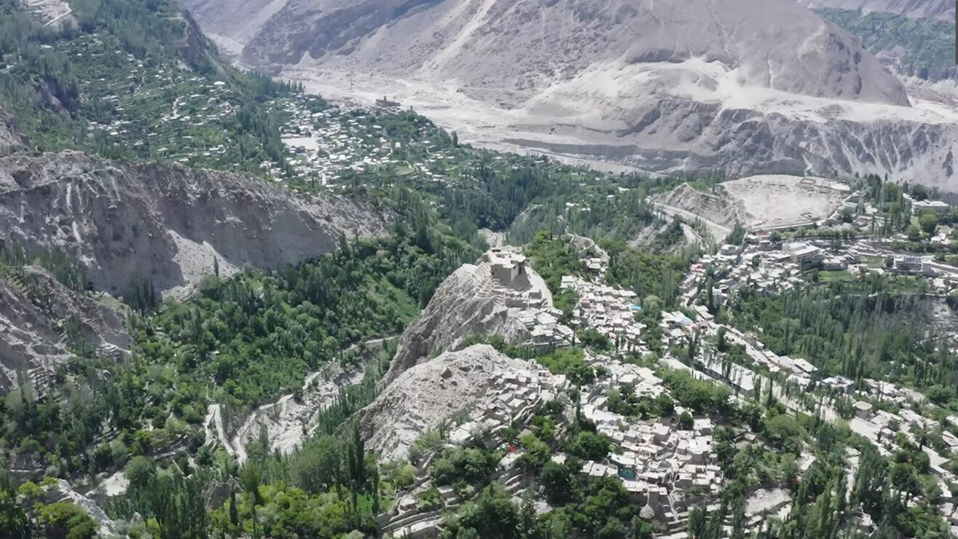
The flight is tense, as winds change in a moment and separate the three paragliders. This time, though, they were lucky and managed to reunite on the mountainside despite the fluctuating thermal. And just like that, they’ve skipped not only the drudge hike but the first two-thirds of the mountain. They make camp while dramatic drone footage emphasizes the remote location they’ve reached after only an hour of travel.
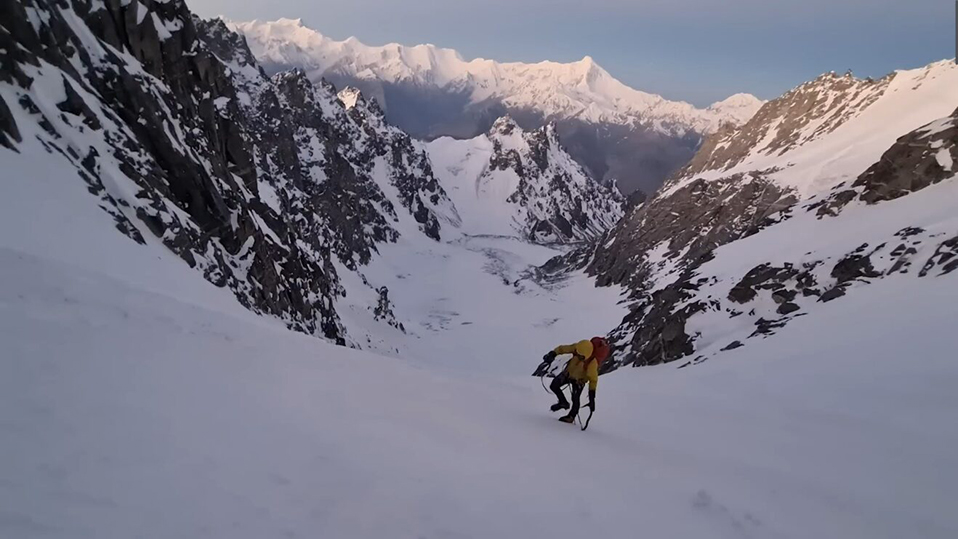
This is still a climbing expedition, and they’re up before dawn, ready to make their way to the summit. Voiceover is minimal as Will and Fabi, appearing as tiny dots on a sheer face, inch up the tower as Holland tracks their progress.
Around noon, they reach the summit. Fabi and Will seem struck by the surreality of their approach. “Twenty-four hours to climb basically a 6,000m mountain…starting at 2,500m in a hotel, without a helicopter,” Will says.
“It’s pretty crazy,” laughs Fabi.
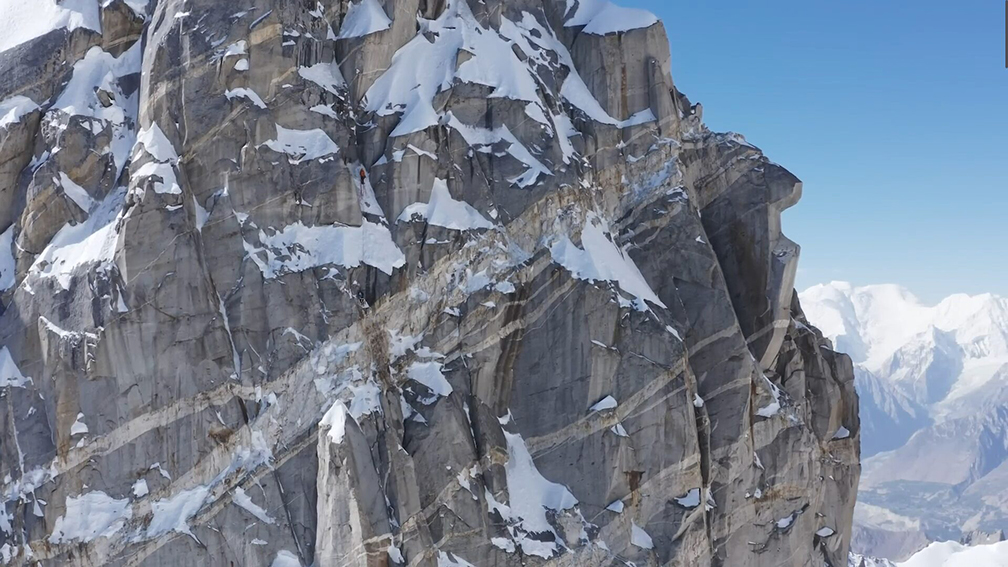
A new era?
From the summit, they return down to the tent, don their wings, and prepare to take off. The danger, however, is being unable to get off the mountain. While Jake and Will make it to the hotel, the wind changes and leaves Fabi stuck in the Gulmit basin and alone on the glacier.
After hours and many attempts to take off, Fabi manages to get airborne and successfully lands, but his perilous situation reminds us that their novel technique has its downside.
The film ends on a triumphant note, as the trio enjoy the amenities of their hotel only hours after being the first to summit Gulmit Tower. Whether their “new way up” has the potential to change exploratory high-altitude alpinism is up to the viewer.
In a small wooden cabin on Mt. Washington, one caretaker resides alone. This short film introduces us to Jack Kingsley, a young man who cheerfully signed up to live on an isolated, frozen mountainside in New Hampshire.
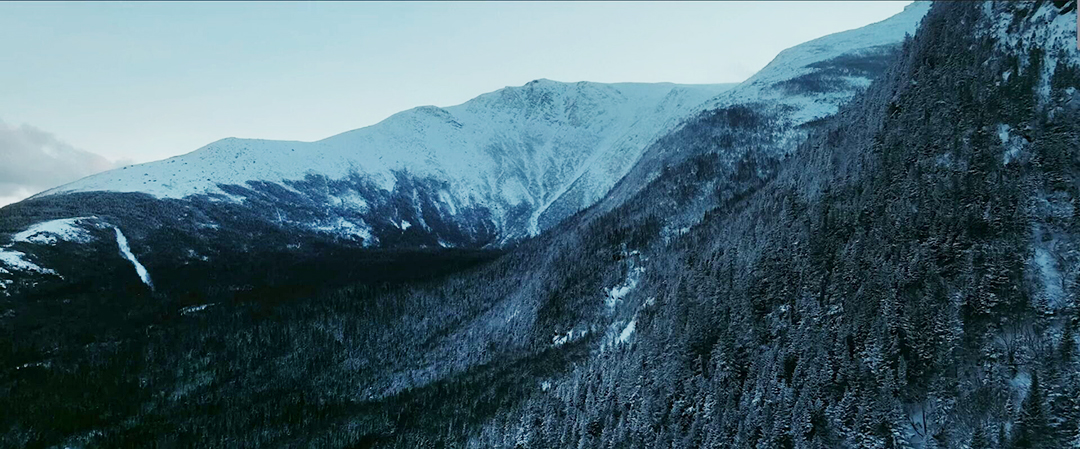
Everything you need, nothing you don’t
Kingsley savors the independence and self-reliance of the caretaker’s life. The camera follows him through his day, gathering snow to melt into water, cleaning and repairing the cabin, and cooking for himself. The life offers, he explains, “everything you need, nothing you don’t.”
This simple life, he says, allows him to appreciate the little things. The peace, as well as the power, of nature.
Kingsley spends much of his time in nature. He’s a passionate ice climber, hiker, and backcountry skier. Few other occupations would give him this much time or opportunity to indulge in his passions. But at the end of the day, his life revolves around the old cabin.
An old dirtbag of a cabin
“If the cabin was a person, it would be a dirtbag,” Kingsley says. “An old dirtbag.”
The old dirtbag was built in 1963 by Harvard undergraduate students. They were members of a mountaineering club without any background in construction, but park rangers agreed to let them build a cabin. Things were different in the 1960s.
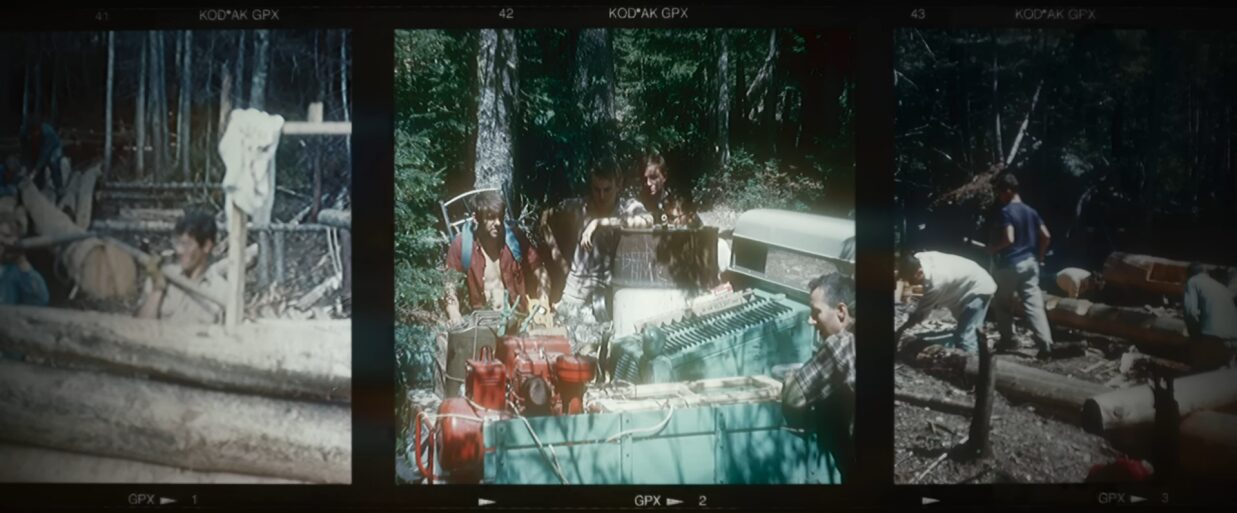
For decades, the cabin and a lone caretaker have acted as a waystation for hikers and climbers on the mountain. It is the nexus of the mountaineering community on Mt. Washington. This means that cold, lost, and hungry strangers might at any moment break the isolation in which Kingsley lives.
“Anyone can walk through that door, and that’s part of the beauty of it,” Kingsley says happily. Rather than isolating, the cabin seems to present an opportunity to connect. With the strangers who pass through, with the history of Mt. Washington mountaineering, and with his own father.
Aged photographs are projected over Kingsley’s voice, showing his father taking a younger Kingsley onto the mountain, where they regularly visited the cabin. His father was a mountaineer and traveler, and the cabin was a special place for him to share with his son. Now, Kingsley explains proudly, he can share the cabin with his father, when he comes to visit.
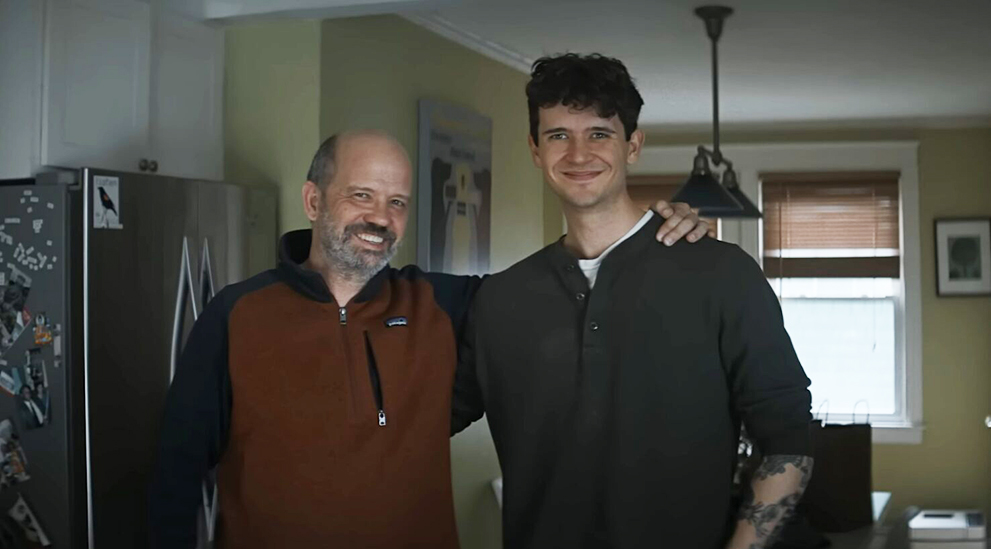
The job
While he believes that passersby have a right to take risks on the mountain, Kingsley sees his job as making sure they are informed of that risk. And the risk is substantial, he explains. Mt. Washington is only 1,917m but sees hurricane-force winds every three days, with windchill regularly reaching -34˚C. Mountaineers use it to train for attempts on places like Everest and Denali.
It’s essential that weather conditions on the mountain are measured and broadcast. Kingsley helps with that, too. Part of his caretaker duties involves measuring temperature and snowfall for the Parks Service.
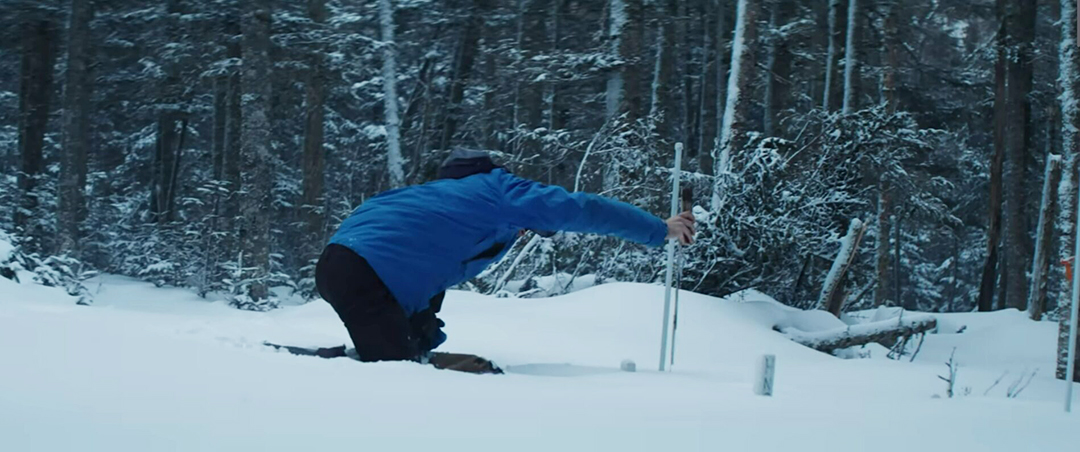
It certainly is not a life most would choose. But this casual, intimate portrait of a caretaker challenges the assumptions one might have about people who choose to live in perceived deprivation. Kingsley is not your typical mountain hermit.
The Big Wait begins with an unending field of blue sky, then tilts down to show the dry, scrubby Australian landscape. As the shot lingers, a train, so far over the horizon that it's barely visible, slowly creeps into the frame. It's a perfect beginning to the short documentary, given its subject — two people and a dog, managing a tiny emergency runway and six cottages that almost nobody ever visits.
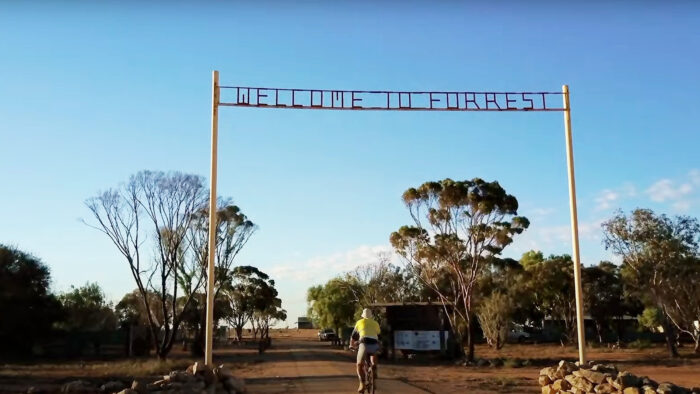
"Forrest is a township with one street, one intersection, and six cottages. And they're only here because we have an airport. And we have people to look after it. That's the managers, currently Greg and Kate," Greg and Kate Barrington say jointly in an interview.
In the snippet, they refer to themselves in the third person and finish each other's sentences — precisely as you'd expect people in their situation to do.

Population: two
"And Holly," they say, referring to their dog. "Population of Forrest is...two."
As Greg explains it, the cottages he and his wife caretake are hardly ever occupied because the "airport" he previously referred to is actually an emergency landing strip.
"Most of the time, it feels like an abandoned movie set because there aren't people," he says.
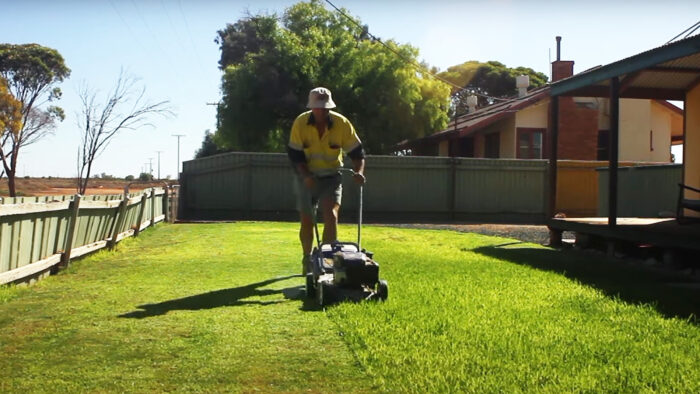
Nevertheless, Greg and Kate keep the cottages in pristine condition. They water and mow the lawns, wipe dust off the shelves, change the linens, place freshly rolled towels on the beds, and generally keep things ready for visitors. They even put fresh flowers in each of the rooms on a regular basis.
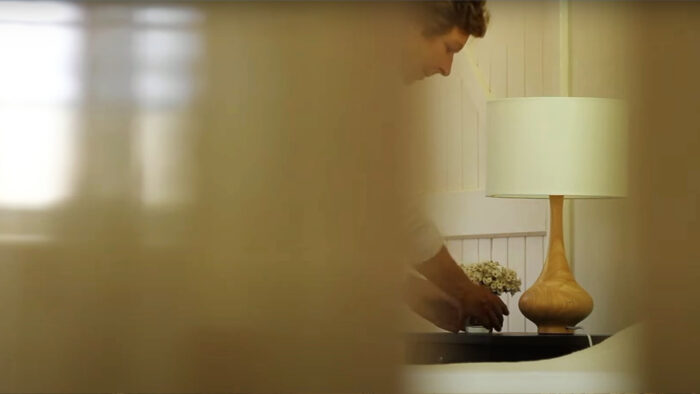
"You lose total track of time," Kate says over footage of the pair riding their bikes for exercise on the empty emergency runway. "I don't know what day of the week it is today. Or the date. It just...vanishes in a flash. The day is gone in a flash. Sunset, and next day, and you just keep rolling. And every day is different, that's the best part. So you rarely get bored," she continues.
That might seem hard to believe. But that's what makes The Big Wait such a fascinating piece of filmmaking. The viewer can't believe that Greg and Kate aren't bored, and yet they clearly aren't. They smile, they laugh, they fill their off hours with tennis games and haircuts. They drive their car at top speed down the runway, they ride their bikes, they have bonfires. They watch the sunrise and sunset.
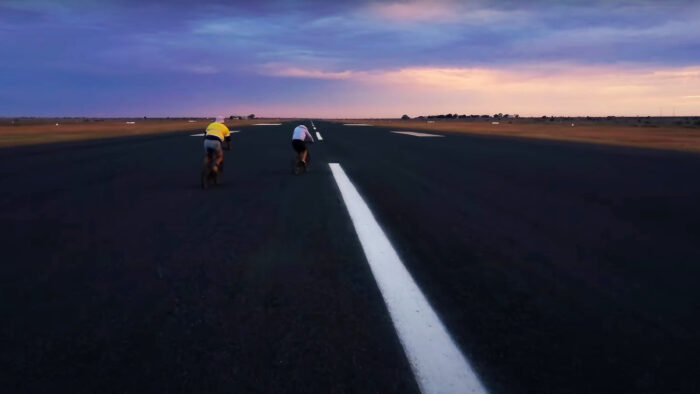
So much space
"There's so much space, I find it gives me a chance to think more clearly," Greg says. "because the troubles really go away. There's nothing out there pressing in on you, and it's really what comes from inside. I suppose you throw away all the non-essentials. There's electricity, there's water. If the train comes through, there's food. With any luck a beer at the end of the day. And you don't have to worry about 'Am I going to get promoted,' because there are only the two of us out here to start with."
The filmmakers capture the experience with sensitivity. There's no question that Greg and Kate are a bit odd, and slightly awkward. But The Big Wait's tone is gentle, not mocking. And the film's cinematographer excels at juxtaposing the weirdness of that row of cottages with the beauty of the Australian landscape, particularly at dawn and dusk.
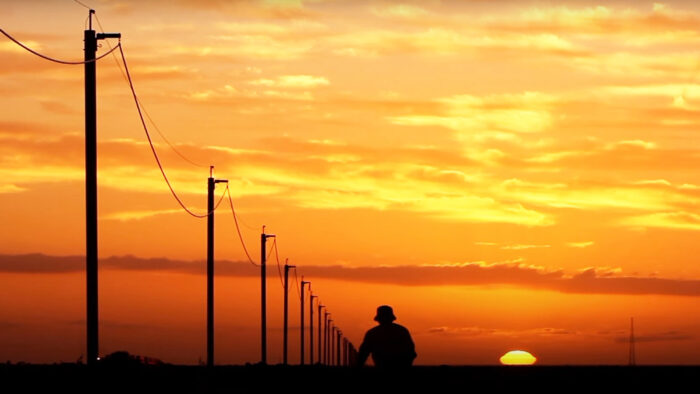
The Big Wait is the best kind of short documentary. It's sweet, inquisitive, and is over before it wears out its welcome. At only 14 minutes, you can fit it in on your lunch break while you consider your own promotion (or lack thereof). And you just might find yourself wondering if Greg and Kate are on to something.
Hugh Wilson has spent the last 30 years regenerating native forest on New Zealand's Banks Peninsula. The story of how he did it is the subject of a lovely little 30-minute documentary called Fools and Dreamers: Regenerating a Native Forest. It's the perfect watch for anyone who needs their faith in humanity (and humanity's ability to fix its mistakes) restored.
With his unfailingly cheerful nature, white beard, bald head, glasses, and propensity for mixing long-sleeved flannel shirts with shorts, Wilson looks like a well-loved grandfather. But he's so much more than that.
Interested in plants from an early age, Wilson channeled his dual love of art and science into a thriving life as a botanist. He spent the first half of his career conducting detailed studies of the plant life on the Banks Peninsula — a region that used to be heavily forested but, by the late 1990s, was mostly farmland colonized by invasive plant life.
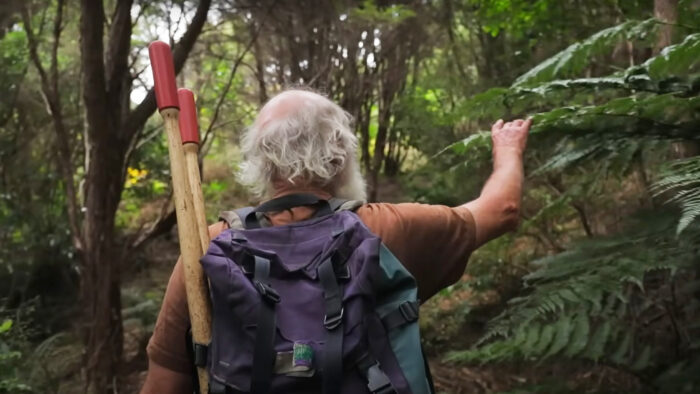
Starting from nothing
"Both Mauri and European settlements had a huge impact on the forest, so by 1900, less than one percent of the old-growth forest [on the Banks Peninsula] was left," he notes.
Then, an acquaintance asked if he'd be interested in running a private nature preserve. The goal? Bring tapped-out pasture back to the way it looked 800 years ago. And do it fast, because New Zealand had already permanently lost some of its native species of plants and animals.
"Some people say, well, why are you restoring the forest? It's kind of like asking why you should love your mother," Wilson says in the film. "We're totally, totally dependent on the vegetation and wildlife that supports our own lives."
So he hopped at the chance to manage the Hinewai Nature Reserve, a piece of land that would eventually cover 1,500 hectares. But there was some pushback.
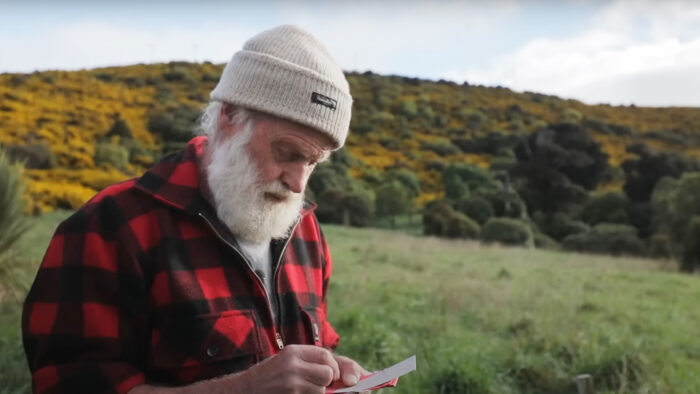
Naive greenies?
"I am all for saving patches of bush, but the thought of starting from scratch on land that is clear enough to be used productively frankly appalls me. As for shutting up a whole valley, heaven help us from fools and dreamers!" one newspaper letter, written by a local farmer at the time, said.
"I think they basically thought we were naive greenies from the city. I'm sure they thought we'd come here with all these ideas, and within a year or two, we'd find out it was all just too hard, and it wasn't happening, and we'd [leave] again. Now here we are 31 years later. I looked at it as a great compliment because we need a few more fools and dreamers in the world," he notes.
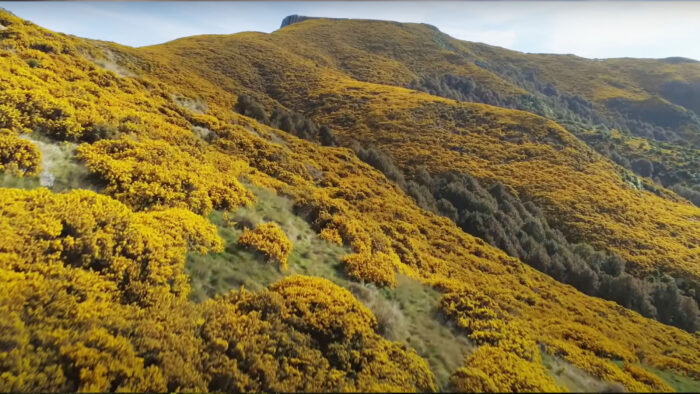
The solution? Gorse, of course
The key to Wilson's plan was counterintuitive. The landscape he wanted to turn back into native forest had been used as pasture for generations and was also infested by gorse, an invasive flowering plant that grows quickly and renders pastures unusable. Many people thought he was nuts for not beginning his reforesting by trying to get rid of the gorse.
"Gorse is a terrible weed for pastoral farming. And no one, let alone me, would deny that. But nothing is black and white, is it? If you've got it, and it's kind of infested the landscape, then it's worth looking at its good points and saying, 'Well, maybe we don't have to fight it,'" he remembers. "We don't want pasture, we want the native forest to regenerate, and gorse is a wonderful nurse canopy for native forest regeneration."
This is why botanists are handy to have around. Wilson knew that gorse is a nitrogen fixer, meaning it fertilizes the soil it inhabits. It grows quickly and creates sheltered spots for shade-tolerant hardwood saplings to grow. But it has to have full sunlight to stay alive. So once native trees in the preserve sprout up beyond the gorse canopy, the invasive weed dies. It's a brilliant, elegant solution, and Wilson's spent the last three decades making it happen.
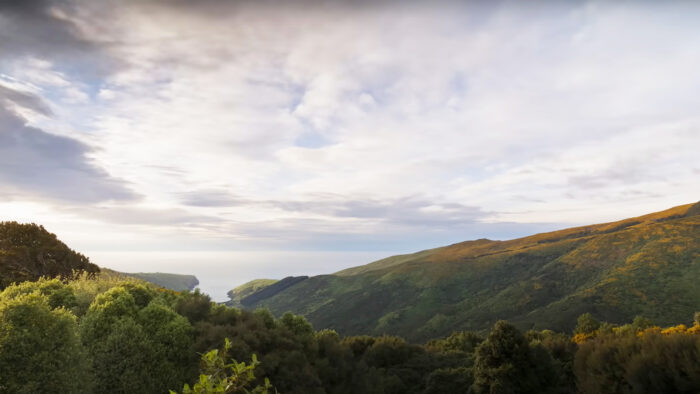
Wilson's routine
There are no motorized vehicles in the nature reserve, so Wilson begins each day with a walk to his current work site — a journey that sometimes takes him as much as two hours. He works all day and then treks back home. After dinner and a pipe, he turns to his management tasks, handling piles of the Hinewai Nature Reserve's paperwork late into the evening. Then he goes to bed, gets up, and does it all over again.
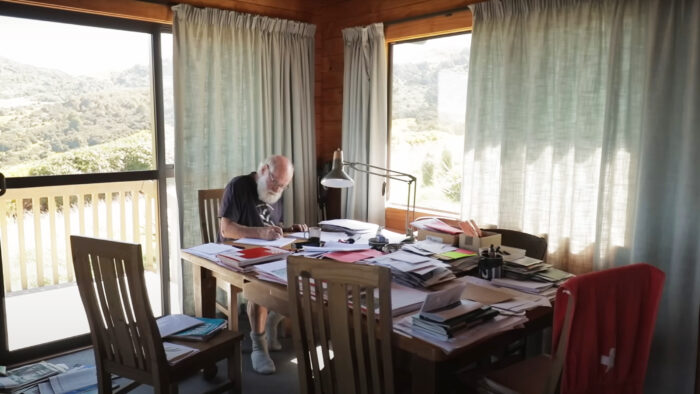
The result is spectacular. The once dry, grassy land in the reserve has largely returned to the lush forest it once was. Streams flow, even in the dry season, and there are 47 waterfalls on the property (that Wilson has found so far). And from the very beginning, the reserve has been open to the public.
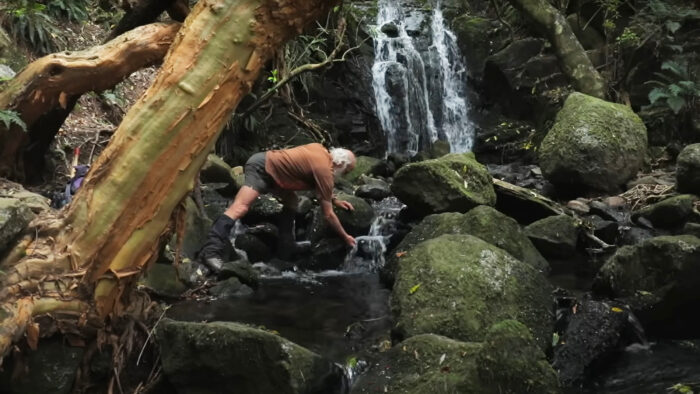
"I think the community is now by and large in support of Hinewai," a local farmer says toward the end of the film. "We realized that the way farming was done over the years had to be changed. And I think what [Wilson] has done is helped people realize that it can be done. In a good way."
Mila Del La Rue comes by her free-riding chops honestly. Described as a skiing prodigy, the 18-year-old's father (Xavier) and uncle (Victor) are also big names in the free-ride snowboarding world.
Of a Lifetime is a 45-minute North Face film that chronicles the three as they venture to Antarctica in the company of a boat crew and mountain guide. The mission? Free-ride that continent's steep shorelines.
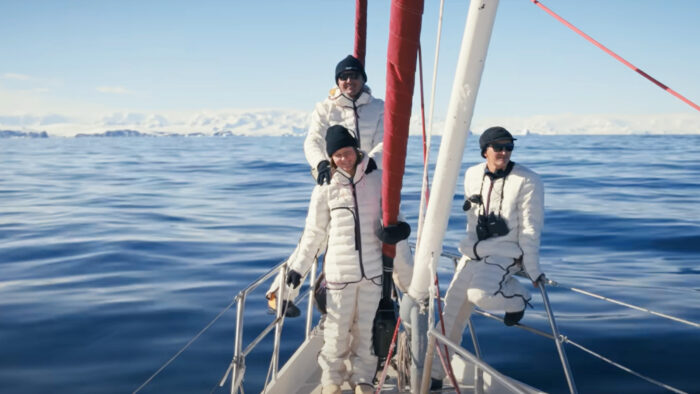
But first, they'll have to get there, a journey that requires five weeks on a small boat, with a notable journey through the Drake Passage. The famously treacherous stretch of water connects the Atlantic and Pacific oceans between the southern tip of Chile and the South Shetland Islands. The Antarctic Circumpolar Current blasts through the passage unchecked, and seas can top 12m. The resulting seasickness is not a great way to prepare for a ski excursion.

Mila spends most of the passage in a bunk, trying to hold down the last thing she drank, much to the amusement of her father. But in a theme that runs through the film, Mila is determined not to disappoint her accomplished family.
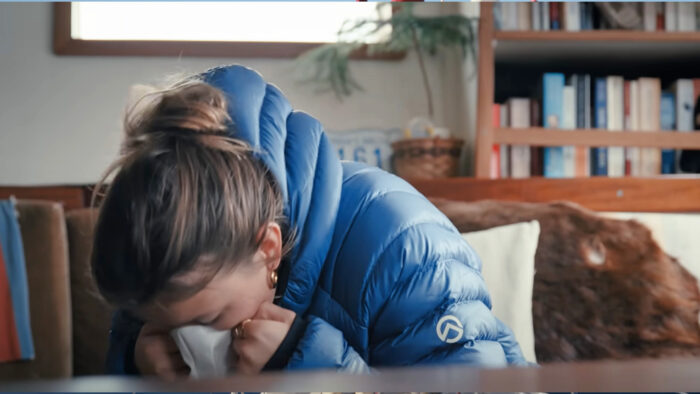
Bonding in Antarctica
"I'd like to go as far as them because I love skiing," she narrates.
For his part, Xavier sees the trip as a moment to grow closer to his family.
"Because of the age gap, Victor and I were always so far apart. Like living parallel lives. It's been forever since our last trip together, so now is the moment to finally reunite," he says.
In the first few days of the expedition, Xavier and Victor head off to tackle uber-steep lines with overhanging cornices while Mila gets the hang of ice axes and crampons under guide David's tutelage. But they don't call her a prodigy for nothing. Soon enough, Mila is ascending capably. But it's when she straps on skis and points herself downhill that the magic happens. She handles herself just like you'd expect — at first.
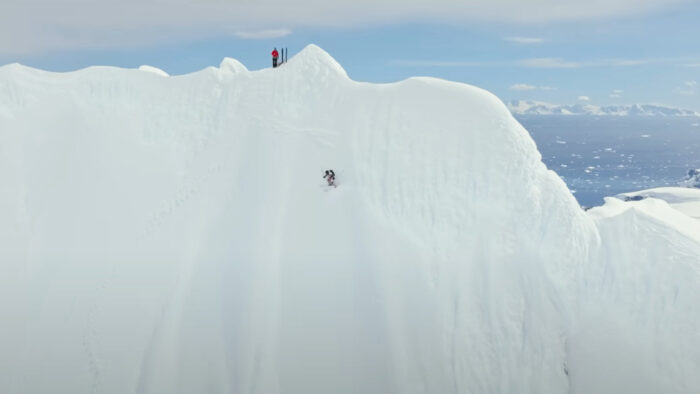
As the expedition continues, the lines get more intense for the Del La Rue family. Here Mila's youth comes into play again. Without the life experience of the older athletes, she freezes halfway down a steep run and breaks down into tears.
Blocked by fear
"I feel blocked by fear between crevasses, seracs, the rocks, and the ocean below. I keep imagining falling at any moment. I want to go back on the boat and feel secure. I doubt myself and my capabilities," she admits over tense action-cam footage of her shaky descent.
"I keep asking myself these questions," she continues. "Am I gonna feel this fear constantly? And I do have the [skill] level?"
For Xavier, the moment is a test of fatherhood. He's never seen his daughter freeze up like that. She's always been a fearless tagalong on his adventures.
"I wish I knew how to help her," he says as Mila grows increasingly short-tempered and withdrawn.
A little father-daughter heart-to-heart conducted Del La Rue style — which is to say at the top of a couloir after an exhausting ascent — does the trick. Xavier admonishes Mila for her fear-driven lack of communication, while Mila accuses her father of being too risky. Both agree to change their ways moving forward. The pair descend, whooping with joy.
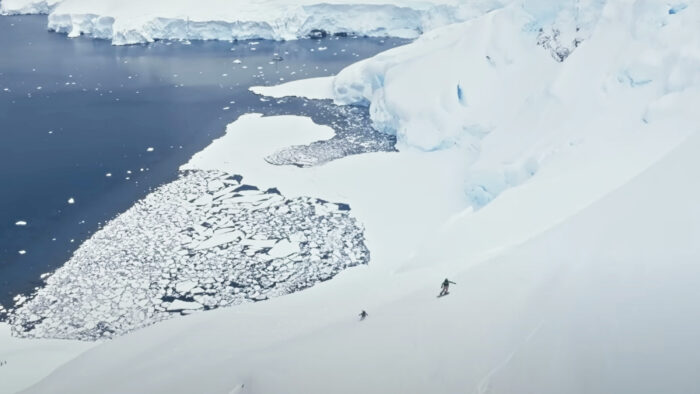
Of a Lifetime is a classic ski film in many ways. Scenes of prep, scouting, and good times are punctuated by long, adrenaline-fueled skiing and riding sequences. The filmmaking team captures it all beautifully, making the best of the Antarctic backdrop and the Del La Rue family's easy charm.

A different family film
But at its heart, Of a Lifetime is a film about family, with all the connection, disagreement, and reconnection that concept contains.
"I've had plenty of time to think," Mila narrates in the film's closing moments. "And now I know what I really want. I want to learn to do things my own way. And I want to be strong. Because I didn't have this mindset before. So I want to say thank you, Dad. For bringing me on the trip of a lifetime. It sounds cliche, but I'll never forget it."
Justin Barbour's name might be familiar to regular ExplorersWeb readers. The school teacher-turned-content-creator and adventurer's 3,800km trek from Northern Quebec to the southern tip of Newfoundland made our list of top expeditions of 2024.
On that journey, Barbour used a mix of traditional and modern travel methods and gear, witnessing all four seasons along the way.
The subject of his recent film Maze of the North in Remote Newfoundland Wilderness is a dramatically shorter though no-less-intense expedition.
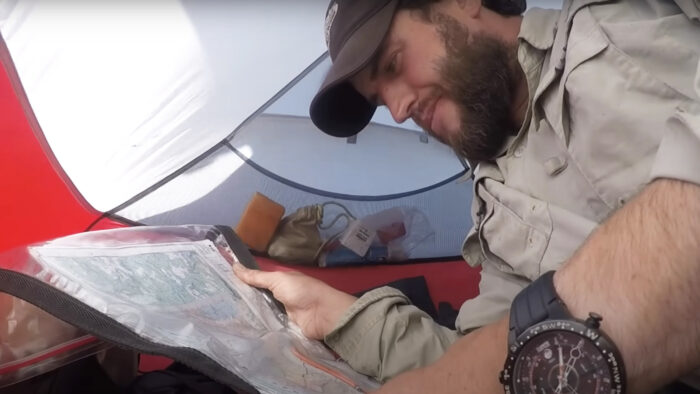
In the company of his dog Saku, Barbour embarked on a 230km journey along the length of Newfoundland's Great Northern Peninsula. The peninsula is 17,483 square kilometers of mountains, fiords, lakes, marshes, and rivers, sparsely populated by just under 15,000 people.
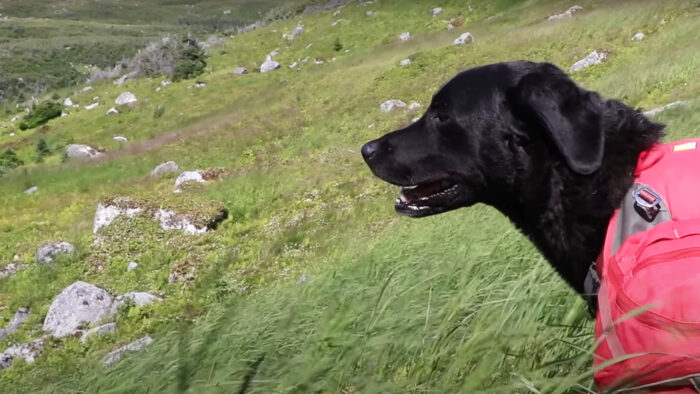
Bushcraft and extra kilos
A fan of bushcraft and traditional survival techniques, Barbour purposefully brought meager rations for his expedition, intending to supplement his calories with fish and foraged plants. And in a classic move, he intentionally headed into the bush with a little extra weight on his body, expecting to lose about nine kilos along the way.
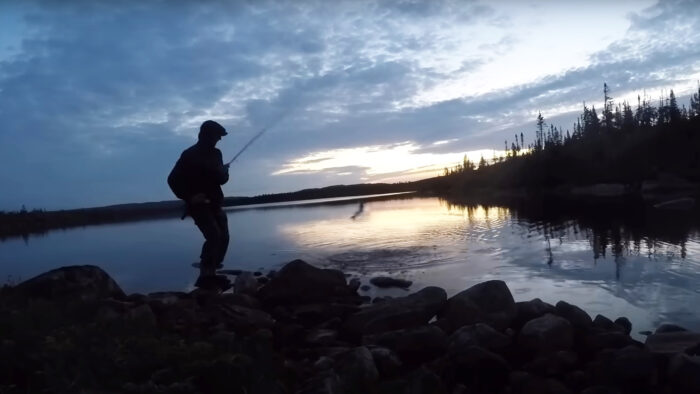
"The question will be whether we can find a way through or not," Barbour narrates early in the video. And it's a valid question. Not one community exists along his route — as he puts it, the peninsula is "one of the wildest places left on Earth." Stands of a common subarctic shrub that Newfoundlanders call tuckamore are so dense that it is impossible to get through them.
"I have a rough line drawn out," he says. "The rest I'll figure along the way. It's okay to go to sleep with a few question marks rolling around in the belly. That's what makes it an adventure."
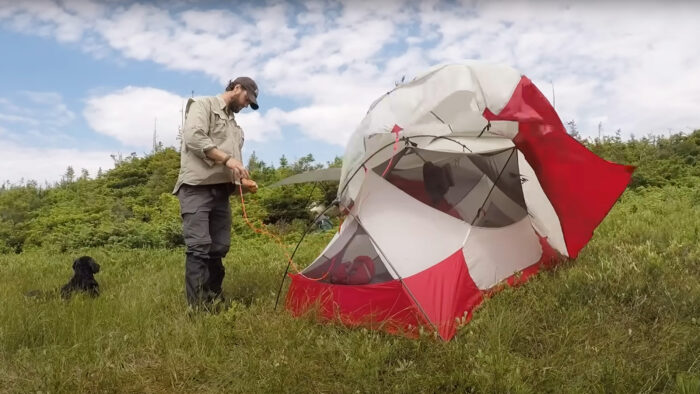
As you'd expect with that kind of mindset, Barbour and his dog spend a lot of time route-finding across difficult terrain, sticking to moose and caribou trails whenever possible, and just punching through dense stands of short conifers when not. There's a lot of backtracking. Detours abound. Any high rocky ridge that allows for easy footing is a cause for celebration. It's all an inevitable part of this type of backcountry travel.
Squishy marshes
When the vegetation vanishes, squishy marshes appear, where Barbour and Saku "gotta work for every step." The pair ford rivers, haul themselves up and over mountains, and walk face-first into powerful winds. With terrain that nasty, it's no surprise they only average about nine kilometers a day.

But of course, speed isn't the goal here. It's total immersion, an idea Barbour reinforces with his reliance on fishing and foraging along the way. There's also plenty of scenery to admire.
"You just come across these fine little areas. Little tuck aways. Places you'd like to call home, put a cabin here, live for a bit. It's just that gorgeous," Barbour says.
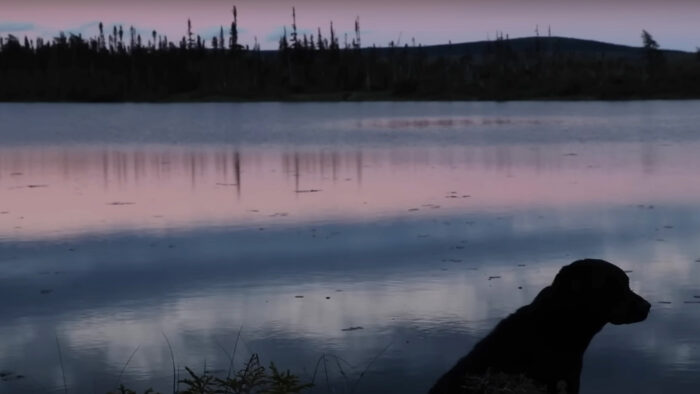
By the time Barbour and Saku wrap up their journey with a final 30km along an overgrown logging road, they haven't seen another human being in 25 days.
"Just a wicked time," Barbour says of the trip as the video closes, before noting that even though he walked 230km, he only traveled 72 as the crow flies. "It just goes to show how tangly and jungle-like the terrain was," he continues. "Tough to figure out, but walking away, what great experiences. Absolutely amazing. You gotta love it."
As for his final weight loss?

Just 5.5kg. Barbour knows what he's doing out there.
Three-quarters of the way through her attempt on the Wasatch Ultimate Ridge Linkup (WURL), having just summited the final peak on the route, amateur athlete Mali Noyes leans over and vomits. The gusting wind blows her stomach acid nearly straight sideways.
Afterward, she feels better and continues jogging slowly downhill. The most difficult portion of the journey, a 45-degree gully choked with scree and talus, lies ahead.
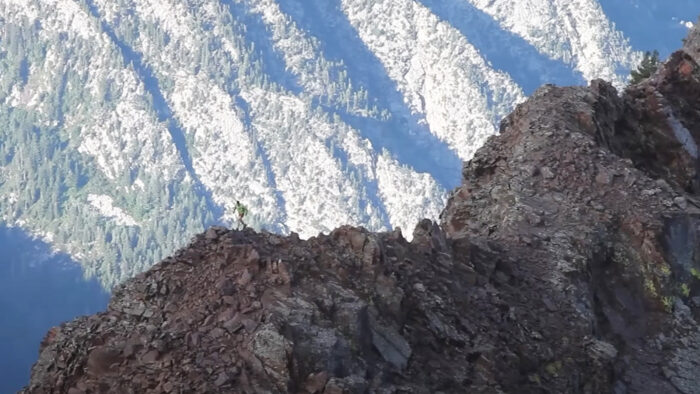
It's all just another moment on the WURL, a deceptively difficult 58km ridge linkup route that circles Little Cottonwood Canyon just outside of Salt Lake City. The WURL fiendishly combines a middle-distance trail ultramarathon with a perpetual string of Class IV scrambles over 6,000m of elevation gain.
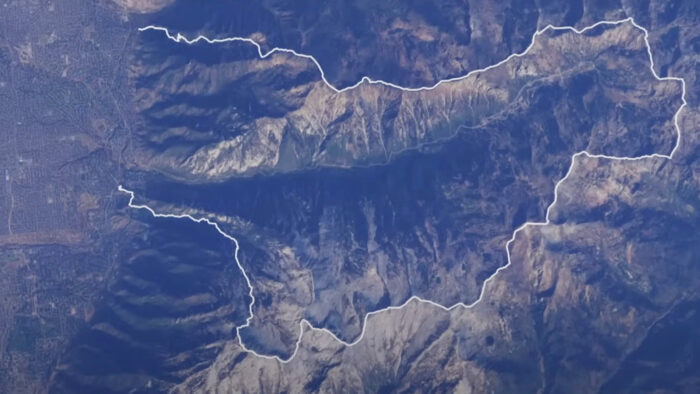
Not quite a trail run
The brainchild of Salt Lake City runner Jared Campbell, the route exists in a liminal space between climbing and trail running that challenges devotees of either discipline.
Campbell was hiking in Little Cottonwood one day in the early 2000s when the thought occurred to him that a linkup of the surrounding ridgelines could be possible. And so the WURL was born.
Rite of Passage is a film that follows Noyes as she attempts to complete the route. But the documentary also serves as an oral history of the route and includes a murderer's row of accomplished athletes (some quite famous) reflecting on the challenging run.
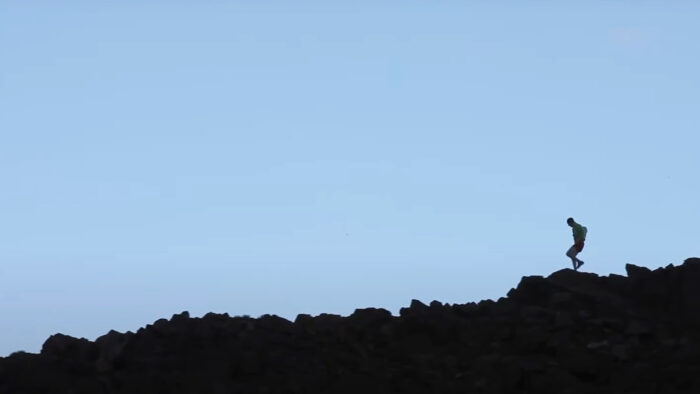
The WURL sometimes attracts people who aren't quite up to the challenge. Partly, that's because the route is so close to Salt Lake City — a hub of fit, enthusiastic outdoor athletes. And partly, it's because a 58km ultra with 6,000m of vert doesn't seem intimidating to athletes who can go out and run 160km.
"People look at the numbers, at the elevation gain, and maybe underestimate what's involved," Campbell says.
But Campbell, along with every other athlete interviewed in the film, urges caution. The exposure is constant, the stakes mortal. There's an ever-present danger of slipping off one of the route's countless knife-edge ridgelines, especially as the distance increases and fatigue sets in.
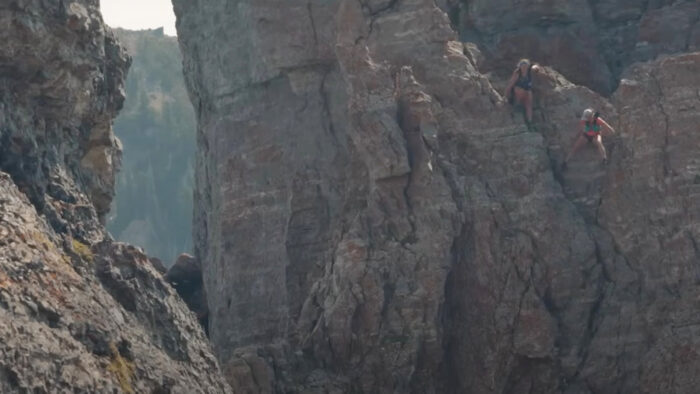
'It can be so intimidating'
But Noyes is a local trail runner with climbing chops, and she has what it takes. As the film progresses and she gets deeper and deeper into the run, she struggles, slips, and slides but never seems out of control. And like many ultra-distance efforts, the real battle is in the mind.
"Wherever you are [on the route], you can look at where you came from and where you have left to go, and it can be so intimidating," she notes at one point.
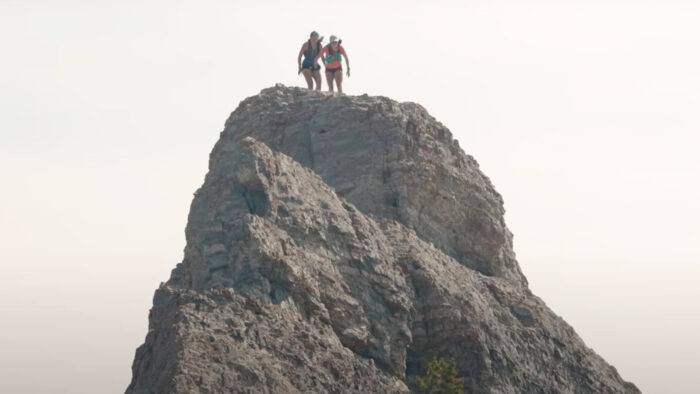
Rite of Passage is a short and punchy watch, clocking in at just under 20 minutes. Seeing the enthusiasm the runners have for the route, you might just be tempted to try it. But know thyself. The WURL isn't something to be tackled lightly.
However, if you have the skills and the fitness, it looks absolutely amazing.
"I've had a lot of people say, 'That was something I'll never forget; that was one of my best experiences in life.' " Campbell reflects. "Those [comments] mean a lot to me."
This weekend's film examines the sublime and simple beauty of Tibetan culture.

At 5,070m, Thoe Village is one of the highest permanent settlements in the world. The ethnic Tibetan population comprises 37 households and 150 people. Many of them make their living tending sheep.
Three seasons out of the year, the villagers herd their sheep back and forth across the windblown foothills. The drought-stricken mountainsides around Thoe provide sparse fodder for the animals. But in a land where no trees grow, and no crops sprout, it's the only way to make a living.
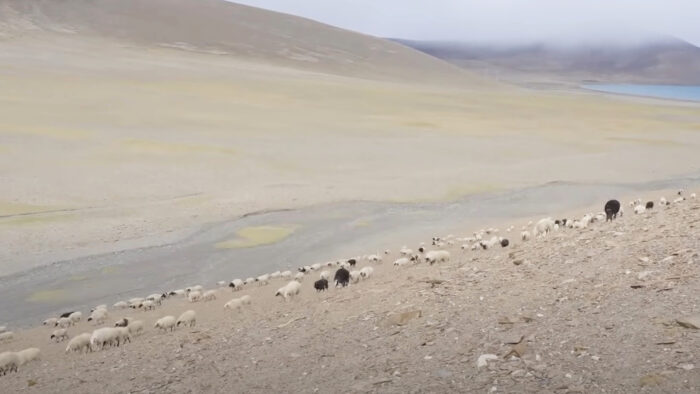
To manage their herds, shepherds like Dainzin use traditional Nepalese herding techniques — flinging stones from slings and whistling commands. At 54, Dainzin is the oldest shepherd in a village where the average life expectancy is 45.
Much of the first half of Icy Journey follows Dainzin over the course of several months. Viewers watch him part from his wife Sonam for weeks, living on nothing but steamed bread, sleeping at night in a stone hut, and walking among his sheep. For Danzig, this daily existence gives him satisfaction — he'd like to continue it for as long as his body holds out — but it is also a necessity, the only way to feed his family.
And then winter arrives.
With it, plunging temperatures and fierce winds that eradicate any chance of feeding the herd.
Blue Jewel
But in one way, Thoe Village is lucky — or blessed, if you take the villager's perspective. It's nestled on a large lake called Puma Yumco, or Blue Jewel. Five kilometers into the lake, a tiny island nestles. The villagers call it the Island of God, as a Buddhist monastery was once located there.
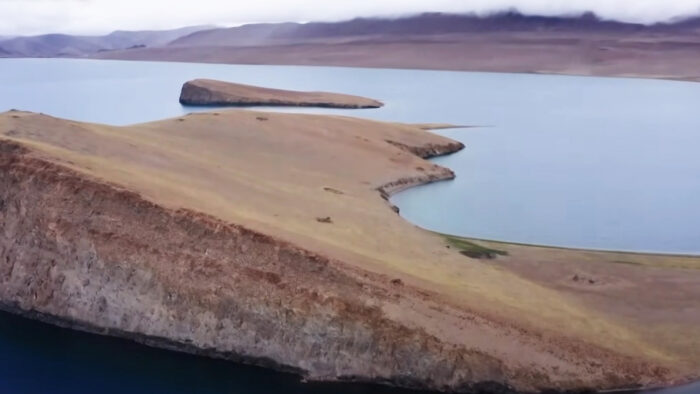
And thanks to an accident of geography and local weather, the sheltered little spot grows enough grass to feed the village's 2,000 head of sheep throughout the winter.
But how to get the sheep to the island? Dainzin and his fellow shepherds have to band together, combine their herds, and drive the sheep across slippery, wind-blown ice once the lake freezes over.
It's this yearly adventure that takes up Icy Journey's second half. Impatient viewers might be tempted to skip ahead to this section of the film, but that would be a loss. Because without the scene properly set — without a knowledge of what's at stake if the shepherds fail to accomplish this task — the gripping scenes that follow lose their impact.
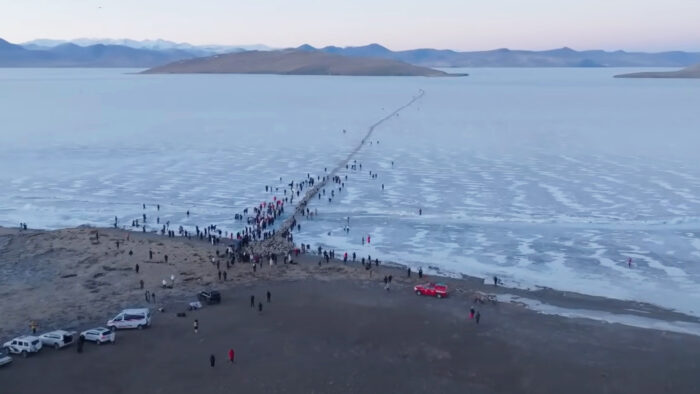
A dangerous journey
The journey is fraught with danger. The shepherds scout the route ahead of time, looking for the thickest patches of ice. Sheep have fallen through it before, endangering the entire herd. But safety isn't guaranteed, even with preparation. Sheep skitter and slide on hooves not designed for traction on ice and threaten to scatter. To help, the shepherds scatter bag after bag of ash to provide a hoof-hold.
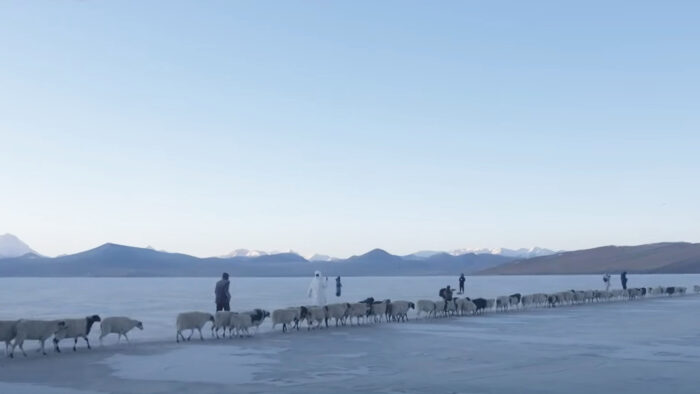
The wind blows incessantly. Sometimes, the animals just stop, unwilling to budge. It takes a lifetime's worth of knowledge and a lot of teamwork to get them moving again. When some animals inevitably get injured, the shepherds pick them up and carry them on their backs toward the safety and food of dry land.
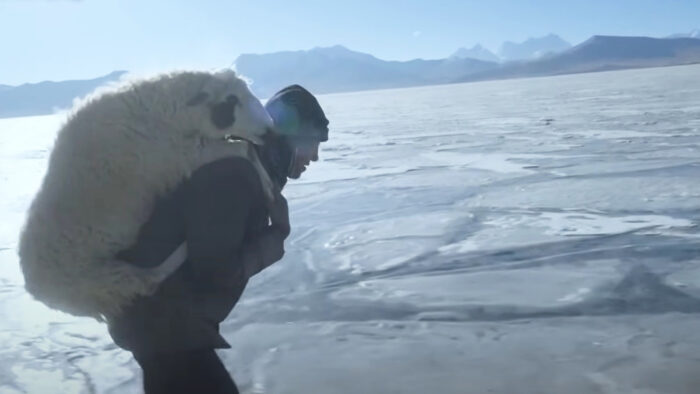
Eventually, shepherds and sheep all make it across. For a little while, the men can rest in a job well done, and the sheep can munch to their bovine hearts' content. And then, next year, they'll do it all again.
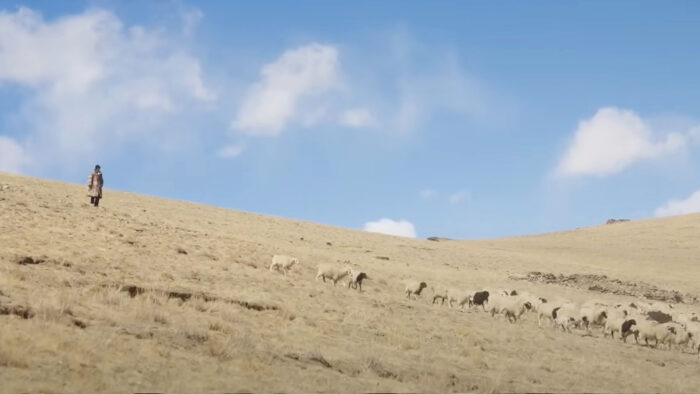
An Icy Journey from Tibet's Sky Village is a measured window into the lives of people whose existence is very different from ours. For that reason alone, it's worth a contemplative look.
We aren't able to embed it, but you can watch it here.
Two years after Alex Honnold famously free-soloed El Cap, he sat down for the Nobel Prize's version of a Ted Talk with psychologist Armita Golkar. The conversation focused on fear — where it comes from, how to handle it, and when to ignore it. The resulting 30-minute video, posted in late 2019, is a window into the inner workings of a man who knows a little something about mastering his mind.
And it's a useful watch for any outdoor explorer.
Exposure leads to devaluing
At one point, as Honnold is talking, he becomes distracted by a photo being projected on the screen behind him. It's a shot from his El Cap free solo — the crux of the route. Honnold uses the photo to segue into a conversation about risk and uncertainty.
"Four meters of [that route] is incredibly hard and dangerous," Honnold says. "But it's a spectrum, and I think that in normal life, everything we do has a spectrum of risk like that as well. Every time you get in a car, there's danger involved. There's risk, there's uncertainty. Every time you step out your front door, there's uncertainty."
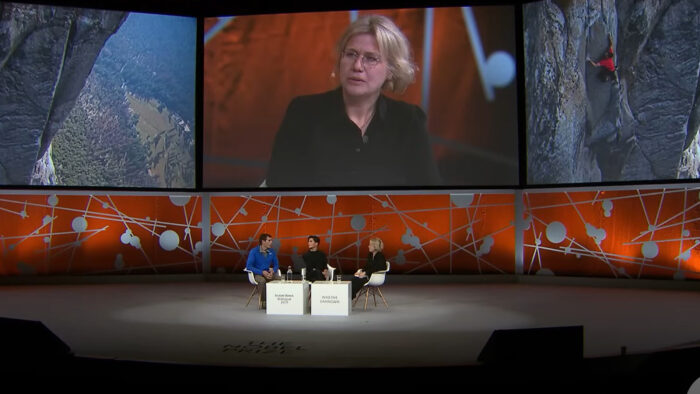
Golkar agrees with him, noting that his point touches on an important aspect of fear — how regular exposure to something can decrease its emotional impact.
"The fact that we make all these decisions on an everyday basis that are typically full of not just risk but uncertainty [is important]. Traffic, trusting other people, you don't have any control while sitting in a car what anyone else is going to do in that situation," she says.
"It would be a 100% deadly outcome if you fall," she notes, speaking to Honnold. "Traffic accidents could be potentially deadly. We are used to them because they are so frequent. So, we don't really pay attention to the risks and uncertainties in everyday life because they are so frequent...Which makes us kind of devalue the risks and uncertainty associated with traveling in a car."

Golkar goes on to extend the metaphor to the decision to have a child, which is also a very common choice full of long-term risks and uncertainties.
Preparation and experience
Honnold then points out that something like free soloing is an activity he's chosen, prepared for, and mitigated risk for as much as possible. His theory is that the most dangerous risks in life are the ones you take without fully thinking about.

"There's rational fear that makes sense because it's your body responding to danger, and then there's felt fear. The challenge in rock climbing is to be able to differentiate between the two and know which to heed and which to ignore," Honnold says.
Curiosity and uncertainty
The conversation springboards into a related topic: How experience can mitigate uncertainty and the specific difference between risk and uncertainty. The distinction is that risk involves calculation, whereas uncertainty involves being trapped in a cycle of worrying about uncalculated factors. But uncertainty isn't all bad — Golknar associates it with curiosity. After all, we like not knowing what we're getting for Christmas (or at least most of us do).
According to Golknar, the human desire to mitigate fear is what led to us developing curiosity in the first place.
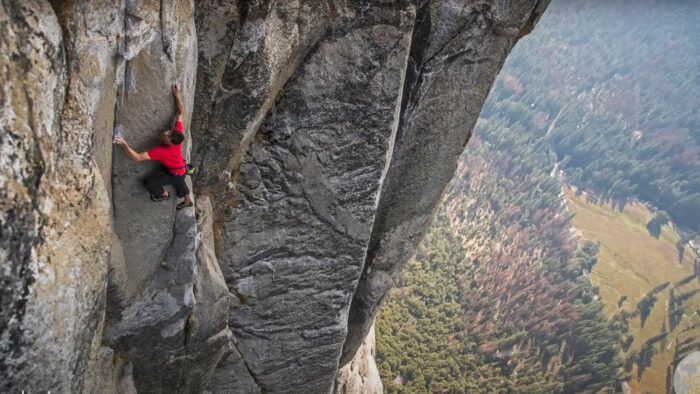
Honnold goes on to say that, in his opinion, the best way to deal with uncertainty — in this case, unexpected situations on the wall — is to build a broad base of experiences on which to fall back. Again, it comes back to preparation. Honnold is famous for it, especially in advance of his free solos.
We'll stop there because the conversation is best experienced as a video. But it's a worthwhile watch from start to finish — particularly if your hobbies involve dangerous situations.
Erik Boomer and Ben Stooksberry are two of the best expedition kayakers in the world. But even they may have met their match when they travel to Chihuahua, in northern Mexico. The plan? First descents on the rivers that rampage through the region's famously beautiful (and dangerous) canyons.

¡Ay Chihuahua! is the 17-minute film the pair created about the expedition. The story unwinds as a good old-fashioned travel tale. After laying out the broad strokes of the expedition, we meet members of the Group of Speleology and Exploration Cuauhtémoc, a collective of Mexican canyon explorers. They chuckle ruefully when the kayakers ask them if the rivers they've targeted are runnable.

Dangerous and hard
"I think it's dangerous and hard," Ricardo Rios, one of the group's members, says.
But before the duo can get on the water, they have to wait out agonizing days of nonstop rain, which swells their initial objective — Rio Candameña — well past runnable levels. You can see Boomer and Stooksberry's frustration as they huddle under eaves and watch the water pour. Doubt starts to creep in.
"We are teeter-tottering between total stoke to drop into these rivers, and then when the rivers flash flood, we're scared and kind of wondering what the hell we're doing here," Boomer says.

But these are seasoned expedition kayakers, and they know that waiting — and the hesitation that accompanies it — is part of the job.
"In my experience, any worthy or difficult or challenging objective is just this mind game," Stookesberry says.
The kayaking starts in earnest about six minutes into the film. The kayakers change tacks while they wait for the Candameña's waters to recede, deciding to tackle a first descent of the nearby Río Concheño.

Boxed-out canyons
Kayaking awesomeness ensues. The boys scout when they can, but it's a long trip, and they have another river on their mind. Time is of the essence.
"Gnarly, boxed out barranca canyons that were just enough to make everything scary," Boomer notes of the river. "So you think to yourself you're going to go here, and here, and then go left. And then when you get into the canyon..." he finishes before trailing off ominously.

After several exciting kayaking sequences that will appeal to experts and neophytes alike, Boomer and Stookesberry finish their run in the small town of Moris. There, they party with locals before traveling back to the Candameña, whose waters are now at perfect levels.
Well. Perfect for the Candameña. There's a reason nobody else has notched a first descent on it. The pair probably spend more time portaging than they do kayaking. But when they do get to drop into whitewater, it's all adrenaline. The drops are steep, and the moves are must-makes.

"It's a marathon of Class V, a marathon of portaging, a marathon of intensity. And there just isn't one moment that you can pick out, except maybe the moment when things go bad." Stooksberry says.
The moment he's referencing occurs when Boomer puts a sizable dent in the bow of his kayak, then pokes a hole through it while attempting to repair it over an open fire.

In the end, the pair achieve their first descent and are all the better for it. "We didn't get held hostage. The people didn't threaten us. Nobody almost died. We don't hate each other. Maybe it's kind of a boring story," Stookesberry says.

Reader, trust me on this. It's anything but.
It seems like most adventures these days have charity fundraising goals, obscure records to break, or fastest-known-times to set. Joffrey Maluski, a photographer and filmmaker based in France, rejected all those notions when he began planning his snowy, windy bike trip across Iceland.

"I'm not here to set speed or distance records. I've come to seek adventure, the unexpected. The discovery with its ups and downs," he voices in the film he made about his experience, Bikepacking Iceland: A Winter Journey Through the Heart of the Highlands. "Its moments of hardship, and its moments of intense happiness. So, I accept this pace imposed by the elements. And I keep moving forward until nightfall."
Maluski was referring to a punishing day of travel in which he pushed his bike through snowdrifts far more than he rode it, occasionally making only one kilometer an hour. But as the saying goes among bikepackers of a certain mindset, "If you're pushing your bike, you're in the right place."

Winter bikepacking: not for the faint of heart
The filmmaker got the first germ of his trip — which took him from Iceland's easternmost point to its westernmost point in 28 days — after a summer bike tour of Iceland with friends in 2021. He returned again in the winter of 2023 with no agenda other than a solid route and an idea of recording his experiences via photography and film.
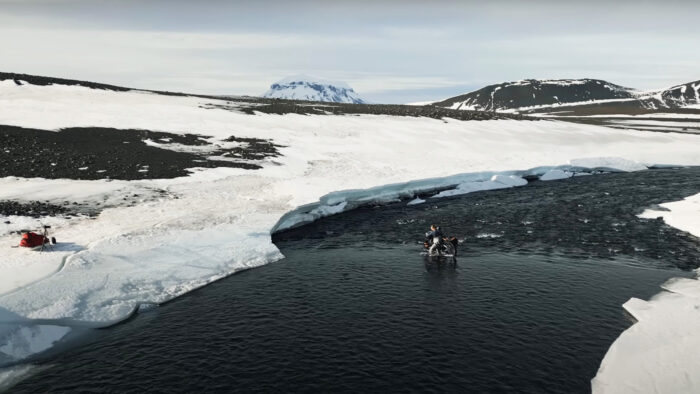
The resulting film showcases grueling winter bikepacking. At first, Maluski is able to move quickly across windblown ice, towing a pulk behind him. But as he enters day five of his adventure, the terrain becomes mixed ice and snow. Soon enough, he's strapping his sled onto his bike and manhandling the whole rig through waist-high drifts.
"I pedal a few meters, I push, I get back on the bike, and repeat," he narrates.
At times, he changes modes of travel completely, loading up his fatbike onto the pulk and manhauling one step at a time. Through it all, he remains unfailingly cheerful and in awe of the scenery around him.
Iceland through an expert's eye
And what scenery it is. Even a mediocre photographer could make the winter Icelandic landscape seem vast and imposing, but Maluski has an eye. His lens expertly captures the beauty of the terrain. Through his perspective, the landscape is stark, yes. But also surprisingly vibrant. A careful blend of traditional videography, action-cam shots, and drone footage showcases the textures and nuanced shades of the winter scenery to good effect. Although generic, upbeat production music choices occasionally hinder the film, the cinematography saves the day.
As Bikepacking Iceland progresses, it falls into a rhythm — pedaling, pushing, fording shallow rivers, then camping or holing up in the huts that dot the landscape. Glimpses of these huts, which are often positioned near hot springs, give viewers a strong impetus to plan an Icelandic bikepacking trip of their own. However, one exceptionally windy night might give them second thoughts.
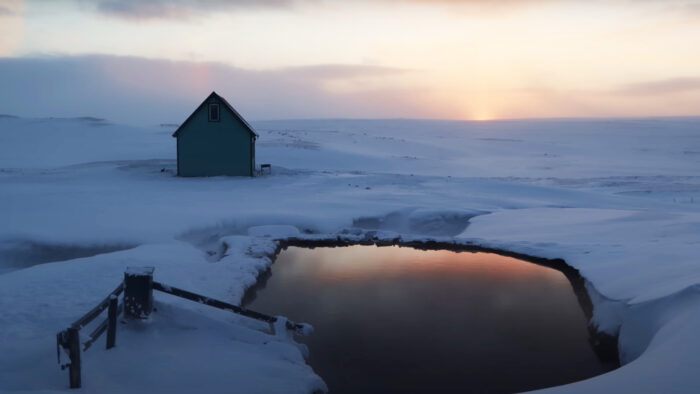
Wind and snow
"My tent swells, flaps, and distorts under the relentless pressure of the wind. I consider every possible scenario, but I keep calm. I focus on what I can control, leaving the rest aside," Maluski says with typical stoicism.
He waits out the storm for 24 hours, then, restless, decides to keep pushing forward.
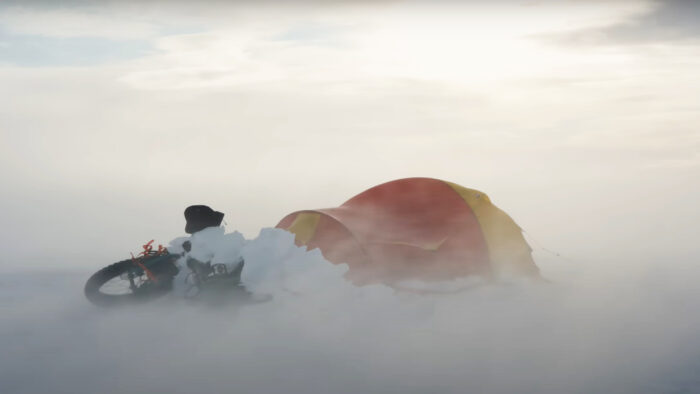
As he travels westward, the biking gets easier, and Maluski makes better time. As he nears the end of his 1,000km journey, he reflects on the mixed feelings of elation and sadness that accompany every long human-powered adventure. But mostly, for him, it's elation.
"Everything is moving faster now, the landscapes are passing by. I'm crossing numerous mountain passes, it's climbing, it's descending, headwind, tailwind, it's sunny, it's snowing, it's warm, it's cold, the fiords are always a mental battle. I'm tired but happy. Happy to live this adventure, to discover remote and magnificent places, to feel free and alive," he says, to the accompaniment of typically stunning landscape videography.
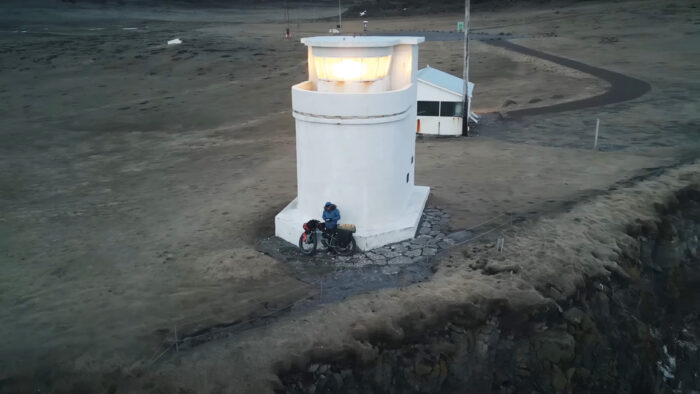
Bikepacking Iceland: A Winter Journey Through the Heart of the Highlands is a cozy winter watch that runs just over 18 minutes.
Some mountains are aesthetically pleasing. Some mountains are fiendishly difficult to climb. Some mountains are both. Jirishanca, a 6,000m peak in the Peruvian Andes, falls into this third category. That's why climbers like Josh Wharton and Vince Anderson keep trying to climb it. And that's why, until the pair's latest attempt, no one had been to the top in 20 years.
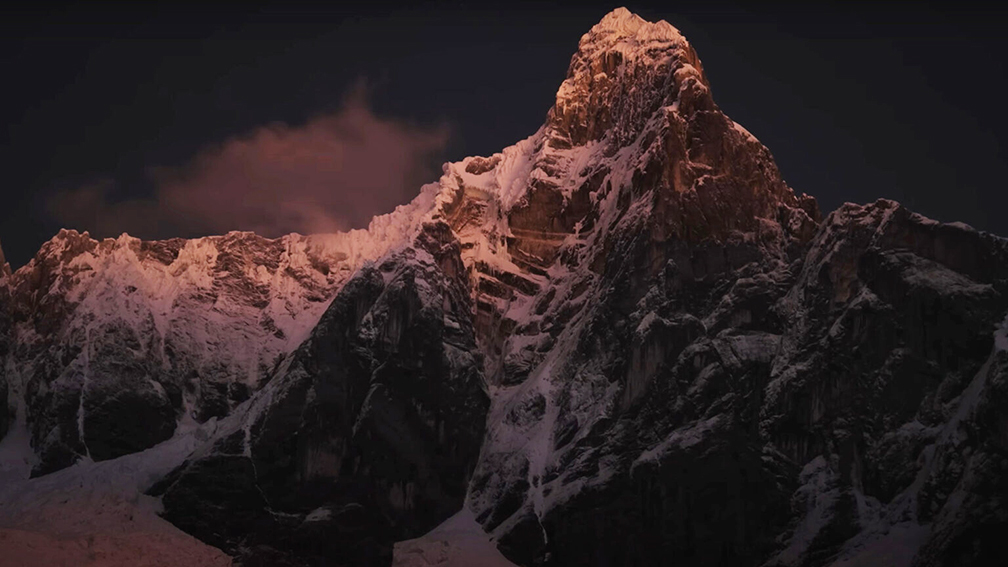
"Steep and intimidating. It's the epitome of a climber's mountain," Wharton says in the opening minutes of Jirishanca, Patagonia's new film about the duo's 2023 alpine-style attack on the mountain.
In Wharton's words, Jirishanca is a "legendary" objective that wasn't summited until the late 1950s and not all that often since. In 2019, Wharton and Anderson themselves turned back four pitches from the top.
The total package
Jirishanca is the total package, featuring 5.13 face climbing, chossy mixed climbing, ice roofs, a big limestone wall, and, as Anderson puts it, "funky snow-wallowing toward the summit."
The Peruvian peak has been a long-time goal of Wharton's, in particular. It's a rare case of man matching mountain. In one of the film's interviews, climber Tommy Caldwell describes Wharton as "one of the best all-around climbers in the world."
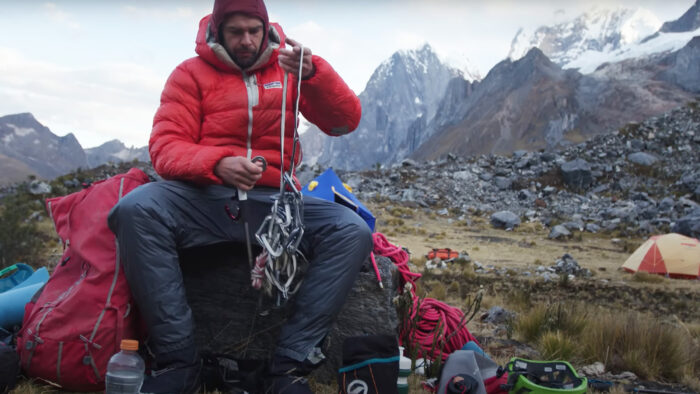
Other climbers call Wharton "the best climber you've never heard of." He's a unique personality in the modern climbing world. Quiet, stoic, a Luddite with a flip phone, social-media averse, avoidant of media, and chronically allergic to what he calls the "hyperbole in climbing and climbing films and climbing media."
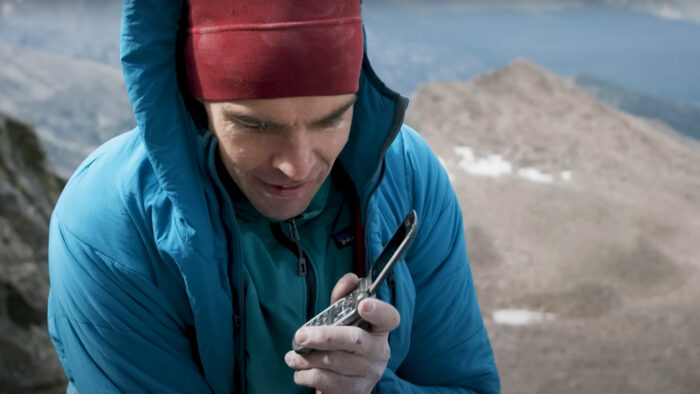
Perhaps in deference to Wharton, the filmmakers behind Jirishanca keep the tone reserved, choosing long, dramatic drone shots over quick cuts and dramatic edits. They never sensationalize. The reality of climbing Jirishanca is sensational enough. The mountain's soaring limestone walls, overhanging ice roofs, and crumbling faces provide all the drama. No cinematic tricks necessary.
Risks and rewards
Between the climbing scenes, the filmmakers take the time to delve into Wharton and Anderson's personal lives. Both are family men, both had their share of close calls in their early climbing days, and both have backed off a bit from the precipice of disaster. This shared caution, combined with well-honed skills, makes them ideal climbing partners. It shines through in all their scenes together.
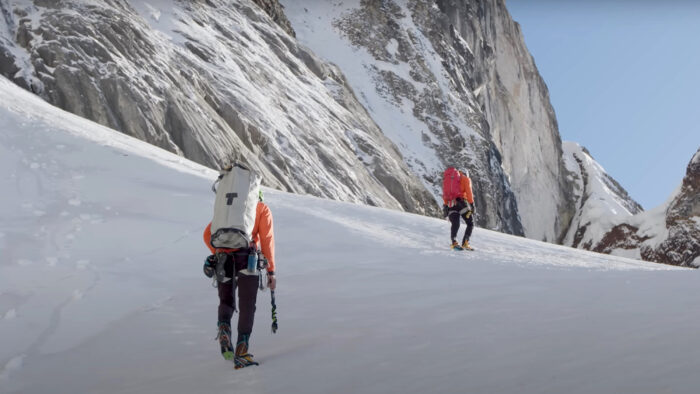
Not that Wharton is risk-averse. He just has a more nuanced take on the subject since becoming a father.
"Risk is a valuable thing in life because it leads us to growing as a person, and having all sorts of adventures and cool and interesting experiences. So I wouldn't want my daughter to live in a bubble. I wouldn't want her to try and avoid risk in her life. And so it's not something I want to totally let go of either," he says.
To the top
The climbing segments unfold over three days. A huge limestone face provides the first challenge, followed by ice climbing and a hair-raising choss. Jirishanca has always been a tough climb, but it's gotten harder in the last 20 years as climate change melts off the snow and ice. Wharton has noticed a change just in the few years since he's been tackling the mountain. Now, on pitches that used to be cemented together with frozen water, cow-sized chunks of rock peel off and go tumbling into the valley below.
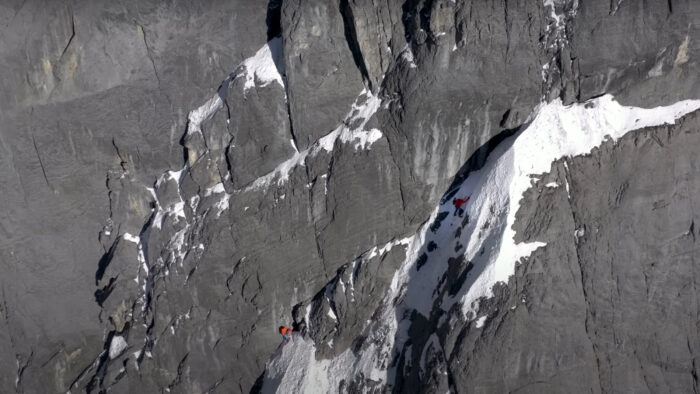
In one particularly memorable scene, the two climbers bivouac under an ice roof, witness a gorgeous sunrise refracted by the frozen water, then begin their morning by ice-axing out from under the overhang and working their way upward. The camera slowly pulls back and back and back, until you can see they are only a few dozen meters from the top.
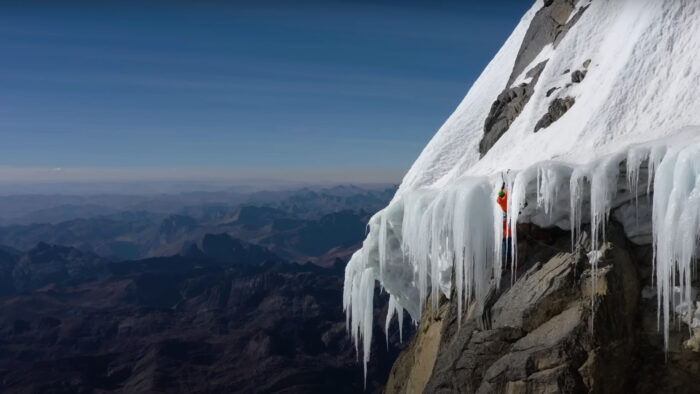
In true stoic fashion, Wharton's reaction upon reaching the summit is a relatively subdued "woo-hoo."
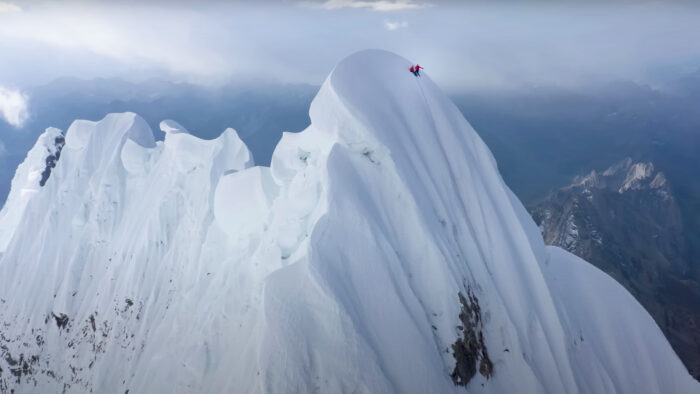
Gorgeously shot and edited with restraint, Jirishanca delivers a great ride without succumbing to the hyperbole that Wharton finds so distasteful.
The cost of human life is a thread that runs throughout the entirety of the award-winning film 109° Below. Fresh from a Best Adventure win at the 2024 Banff Mountain Film Festival, the 14-minute documentary takes viewers back in time to 1982, when an elite group of rescue climbers struggled to save two young men who became lost on New Hampshire's Mount Washington.
Washington's claim to fame is "the worst weather in the world" — earned thanks to record wind speeds, icy temperatures, and violent winter storms. In fact, the film is called 109° Below because that's the temperature (in Fahrenheit) that the wind-chill factor reached while the crew was filming on Mount Washington.
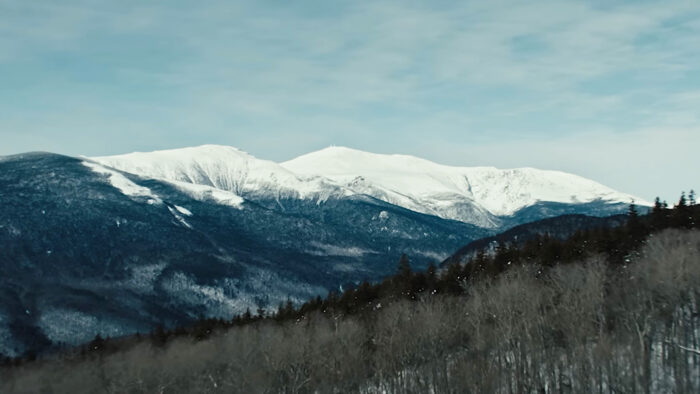
A serious problem
"When the weather is bad, all you have to do is lose your mitten, and you've got a serious problem," Paul Cormier, a member of New Hampshire's Mountain Rescue Service, says in one of the film's interviews.
But in 1982, 17-year-old Hugh Herr and his partner Jeff Batzer did much more than lose their mittens. Although experienced for their age, the two young men made a fateful decision — to press toward Washington's summit in the face of an oncoming storm.
Reaching a ridgeline, the pair decided to walk three more minutes closer to their goal before descending. Those three minutes proved disastrous, as visibility dropped precipitously. Herr screamed at Batzer, "Let's get the hell out of here," and began their descent.
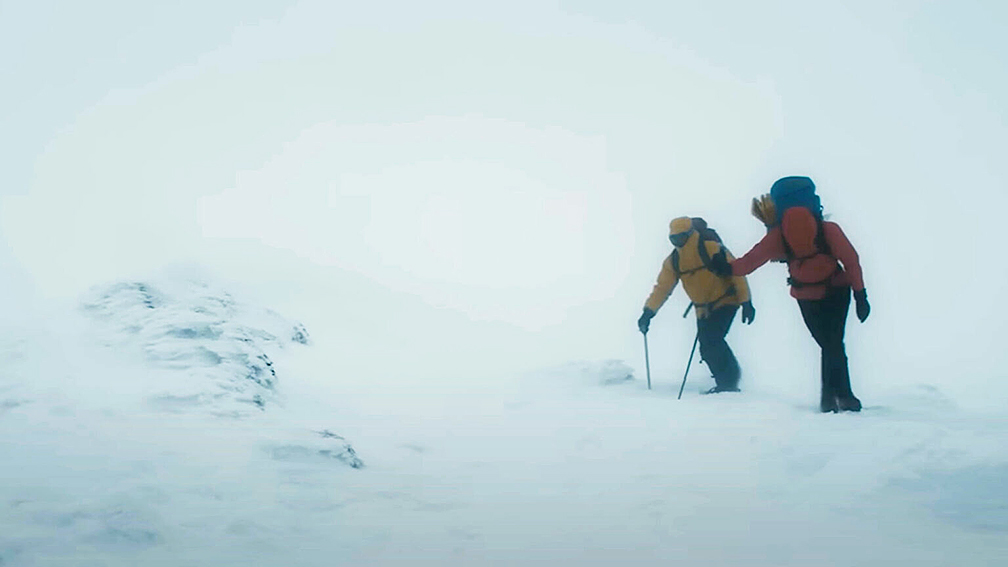
Frostbitten and hypothermic
By the time they realized they'd taken the wrong line down a steep slope, they had neither the energy nor the time to retrace their steps. They kept descending and were quickly lost. They continued bushwhacking until two or three in the morning, then finally halted, frostbitten and hypothermic.
Meanwhile, the climbers had been reported missing, and a 10-person crew of volunteer Mountain Rescue Service members set out to find them. And then tragedy struck. While conducting the search, two of the rescuers were caught in an avalanche. One survived, but Albert Dow broke his neck in the crush of snow and debris. It was a stunning blow to the close-knit rescue community, which still had a duty to the missing climbers.
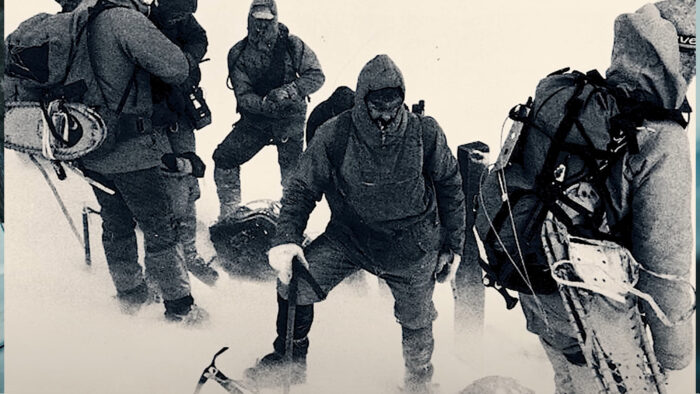
"I hated the people we were searching for. But I realized I hated this young man because my friend was dead," Joe Letini, a member of that 1982 rescue team, says in the film. "But Hugh was 17. Sometimes, you just push that little too far. And you don't know what's too far. You're learning. Hopefully, you learn from it."
To learn from the experience, the two climbers had to survive it. And they almost didn't. As the fourth day of their ordeal dawned, they began to lose hope.
"Most people believed that we were dead...we gave up all attempts to survive," Herr says.
Accidental salvation
But in a moment of serendipity, a group of snowshoers found their tracks in the fresh snow and followed the trail to a cave where Herr and Batzer were fading fast.
Transported to a hospital, both of Herr's legs were amputated below the knee. Batzer's lower left leg, all the toes on his right foot, and the thumb and fingers on his right hand were amputated.
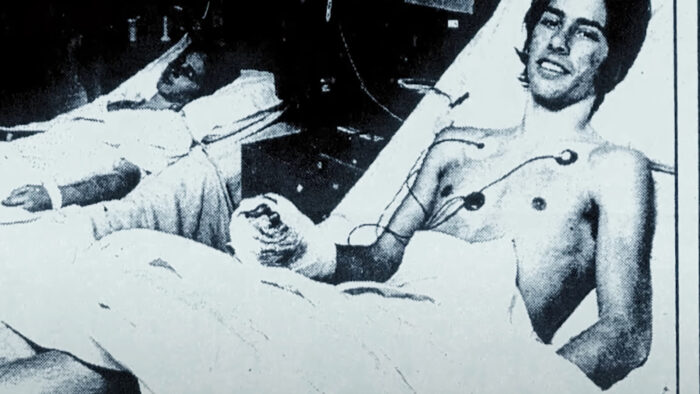
But the worst part for Herr? Learning the true human cost of his rescue.
"To me, that was the lowest point of my entire life. Hearing that a fellow climber had died while searching for Jeff and I," he says.
109° Below is fast-paced, dramatic, and well-shot. It uses expertly constructed reenactment footage, gorgeous landscape videography, and interviews in a combination familiar to fans of Touching the Void. But where the film truly shines is in its final moments, when it examines the aftermath of the rescue attempt and finds some redemption for its primary subject.
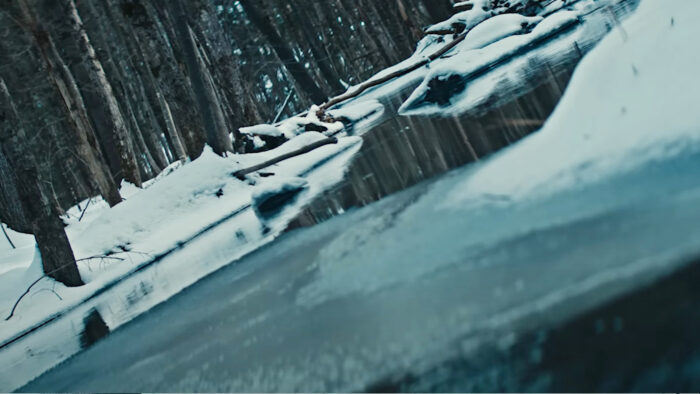
A hard lesson learned
"Albert Dow's death was very profound for me. It transitioned from shock into rage at myself for making bad decisions in the mountains and really putting others at risk. That rage drove me ironically to climbing again, with artificial limbs. I was going to use every cell in my body to do something positive with my life," Herr shares.
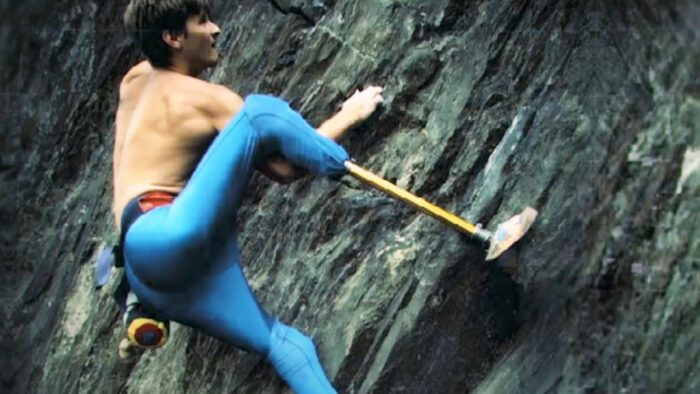
Herr didn't just climb with prosthetics; he designed them himself. He's now a professor at MIT and a world-recognized leader in the prosthetics field.
"If I pitied myself and didn't apply my mind and body to something good for society, I thought that would be an absolute disgrace to Albert's sacrifice," he concludes.
If you want to get to know a wild place — really know it — you have to travel it by foot. There's just something about moving slowly that allows the brain to absorb and process the subtleties of beautiful settings.
Unfortunately, the measured pace of long-distance backpacking trips doesn't often make for interesting feature-length films. I'm a long-distance backpacker and outdoor journalist, so trust me when I say that. I've seen a lot of them. Backpacking tales seem better suited to books, where authors can better break up straightforward point-A-to-point-B narratives with inner dialogue, humorous asides, and other nuances.
But Out There: The Great Divide Trail is a bit of an exception.
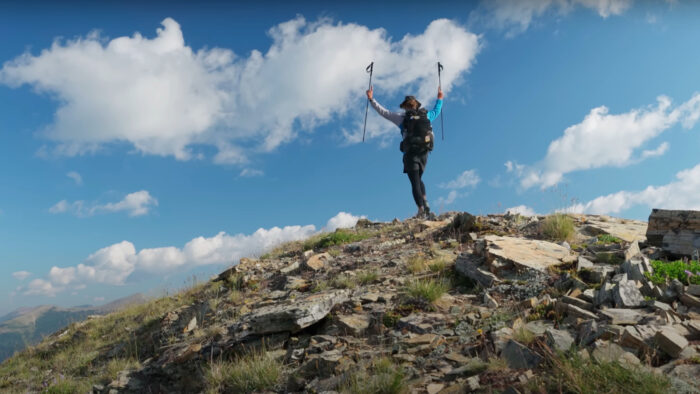
The 80-minute film was shot, directed, and edited by its two main characters: Ryan "Kodak" Brown and Ilsa "Cinnamon" Praet. It follows the two as they journey along Canada's Great Divide Trail (GDT), which stretches from Waterton Lakes National Park on the U.S.-Canadian border to Kakwa Provincial Park, some 1,130km north.
Familiar grooves
To some extent, Out There settles into the same familiar grooves of many long-distance backpacking movies. Kodak and Cinnamon gather their gear, travel to the trail's start, take the requisite photo, and start hiking. Along the way, they meet interesting people, power their way over passes, scrape the morning frost from their water bottles, and otherwise attend to life on a long-distance trail. Eventually, they reach the end and go home.
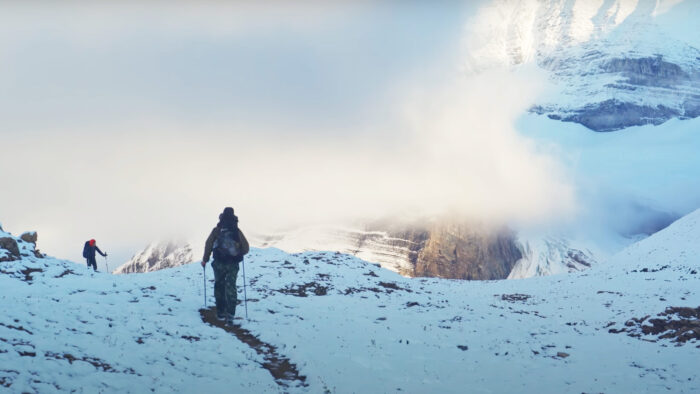
But where the film stands apart is in the wise decision to center the GDT itself. The pair have an eye for sweeping landscapes and the technical skill to showcase those landscapes to full effect. When paired with an unobtrusive acoustic soundtrack, the result is a film that makes the best use of the GDT's famously remote setting to quiet, meditative effect.
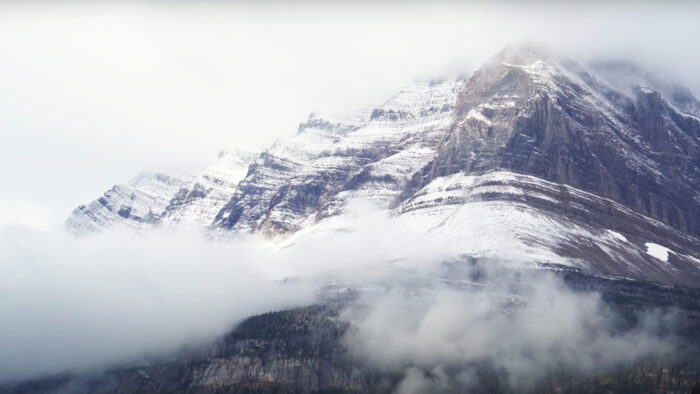
How it differs from other trails
It helps that the GDT is so beautiful. Dan Durston, a Canadian backpacker who runs a successful (and innovative) ultralight backpacking gear company, is interviewed throughout the film. He says it best:
"You can hike trails that are awesome. Pacific Crest Trail. Te Araroa. Those are fantastic trails. But what they don't have is this big, authentic, intact wilderness that we have here in the Canadian Rockies. We are going hundreds of kilometers without crossing a road. Fully intact ecosystems. And it gives the trail this sense of authenticity that you're actually hiking through something really special. The cliffs, the icefields, the spires. It's some of the most aesthetic mountains in the world."
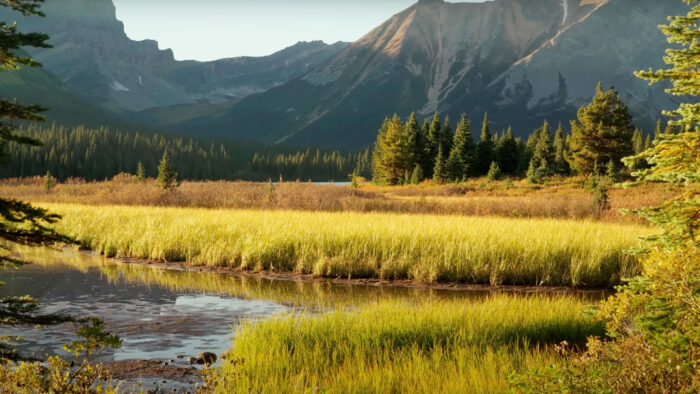
Durston knows what he's talking about. He was the first person on record to yoyo the GDT, which is to say finish it in one direction, then immediately turn around start walking back the other way.
Kodak and Cinnamon are also experienced hikers. They met on a thru-hike of the Pacific Crest Trail, and "haven't really left each other's side since," Kodak says in the film's voiceover. But the GDT has challenges that test even the most capable backpacker. The trail's remote nature is certainly a factor. Wildlife is another.
Bears, wildfires, insects
"People have to consider that the Canadian Rockies has most of its megafauna still on the ground. In the wild. Including black bears and grizzly bears. There's everything from ticks in the early season to biting, flying insects. There are wildfires. There's also some risk with the traffic where the trail is forced to follow along highways from time to time."

It's also tough logistically. Unlike most of the long trails in the United States, there isn't one permit that will get you through all the protected areas that the GDT traverses. It necessitates careful planning and sticking to that plan.
Finally, there are sections of trail that aren't trail — high alpine areas that require route finding, scrambling, and navigating sketchy scree fields.
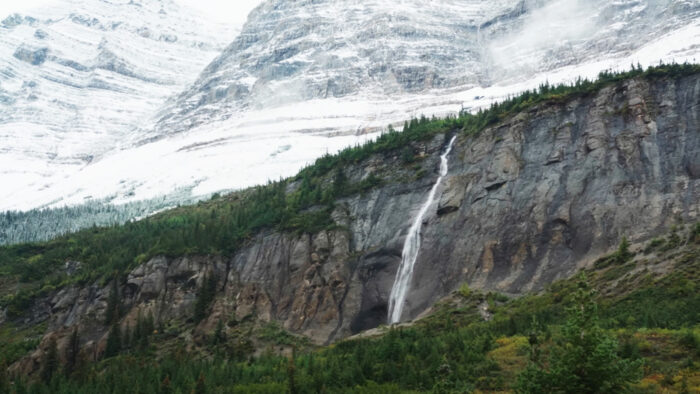
"Damn GDT. You don't need to go so hard right out of the gate," Cinnamon says during a steep climb early in the journey. Kodak later wryly refers to the GDT as "the Great Difficult Trail."
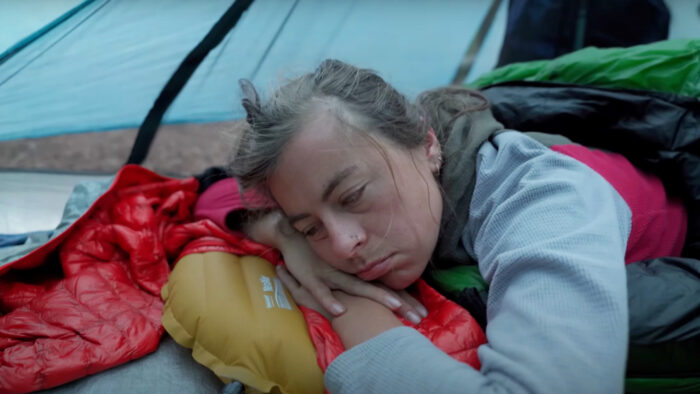
Just do it
But her partner also offers some words of comfort to viewers with itchy feet.
"So for those intrepid souls who want to hike the whole thing, I'd say start planning early, get as much information as you can, and don't get discouraged. You can do it. If you have the resolve, you can make it work," Kodak narrates over some characteristically beautiful cinematography.
The pair finishes their trek in a cozy cabin on the shores of a lake. It's a fitting end to a journey more spiritual than pulse-pounding.
"Saying goodbye is bittersweet. The further north we went, the more we fell in love with the natural beauty surrounding us," they write in the cabin's logbook.
The Banff Mountain Film Festival is the crème de la crème of outdoor and film showcases, and this year was no exception. This year's festival took place this past week, and the winners cover a range of topics from ski-racing Afghan youths to Mongolian conservation and everything in between. Let's look at a few of the winners. And while you're at it, check out the always spectacular trailer, just below.
Grand Prize and Audience Choice: Champions of the Golden Valley
This tale of passion and politics set in rural Afghanistan wowed judges and the Banff audience alike. It follows a group of young Afghan skiers in a friendly rivalry as they pit their skills against each other, sometimes using makeshift wooden ski equipment. Village girls even begin to take part in the burgeoning pastime.
But following the U.S. withdrawal in 2021, the Taliban returned to the region, forcing all involved to radically change their lives once again.
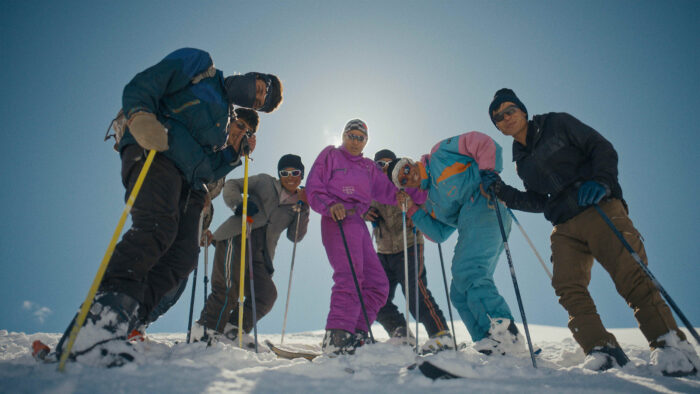
ExplorersWeb editor-in-chief Jerry Kobalenko said of Champions of the Golden Valley, "This labor of love was years in the making, and the unexpected return of the Taliban added a dark edge to what began as a feel-good story about the discovery of outdoor sports in Central Asia."
Best Adventure: 109 Below
The icy 109 Below chronicles a fateful rescue attempt on New Hampshire's ferocious Mount Washington — a mountain famously known to have "the worst weather in the world." The rescue in question takes place in 1983, but the events of 109 Below continue to resonate today.
"Directed with empathy and gravitas, the narrative spans decades of moral reconciliation in a mere 14 minutes while opening up a debate it can’t hope to resolve," jury member Brian Johnson noted.
Best Environment: The Giants
The Giants weaves two narratives as closely together as tree roots: the intertwined stories of politician and conservation activist Bob Brown and the giant trees he fights so hard to protect.
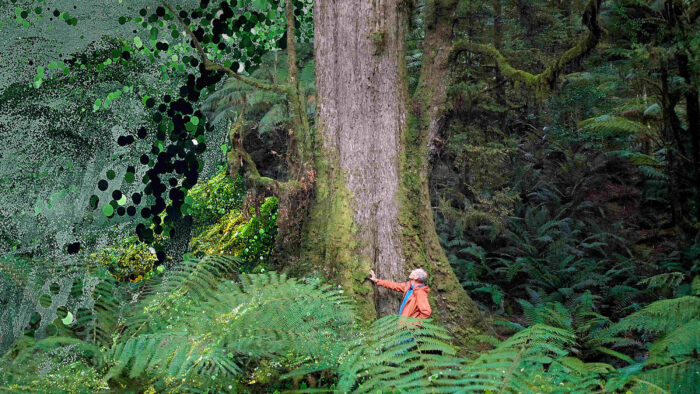
Using lush live-action cinematography paired with gorgeously rendered animation, the film examines the dueling powers at war for the soul of the Australian landscape: human passion for wild places and the human desire for resources.
Best Mountain Sports: Big Water Theory
If you haven't heard of Nouria Newman, French extreme kayaking phenom, you're in for a treat. Big Water Theory is as good a place as any to start learning about the skilled and ambitious Newman. The film follows her on a quest to make the first female descent of the Indus River's Rondu Gorge.
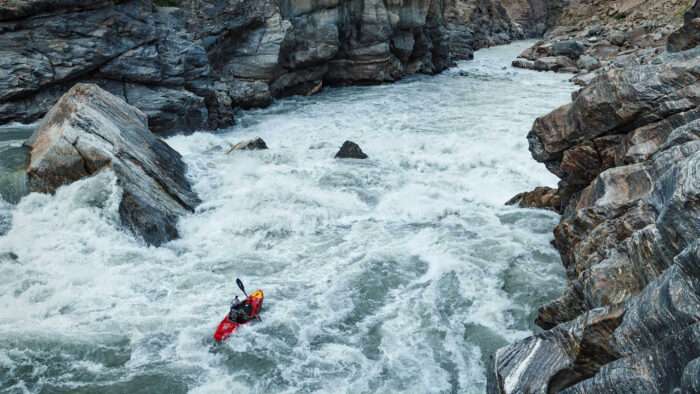
"Ultimately, this is a story of small humans bravely facing vast nature — tiny figurines in plastic kayaks amid the foaming, powerful waters of the Indus, seemingly on the brink of disaster yet miraculously making it down the rapids unscathed, jury member Masha Gordon shared. "Is it luck or skill? Mostly the former, with just a touch of the latter."
While you're waiting for Big Water Theory to hit streaming services, go check out some of Newman's other adventures.
Best Mountain Culture: Mongolia, Valley of the Bears
Jury member Brian Johnson described Mongolia, Valley of the Bears as a "movie of many genres. A cinematic spectacle that distills poetry from landscape. An eco-documentary too complex to be doctrinaire. A character drama with a trickster protagonist. A western about an enforcer who fights an outlaw band of poachers by recruiting warriors from their ranks."
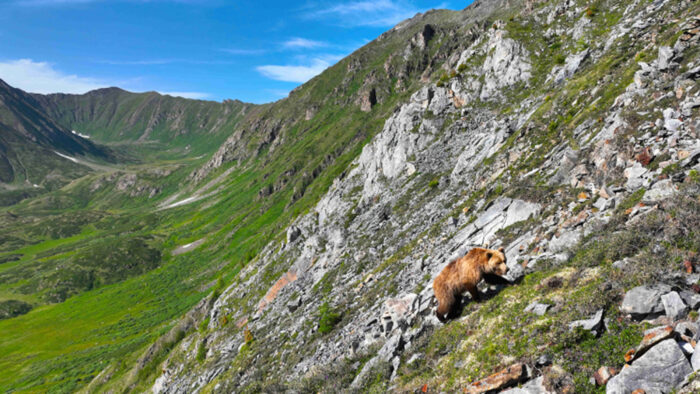
At its heart, the film is about former hunter turned ranger Jal Tumursukh as conservation efforts and traditional cultural practices clash across the vast Mongolian landscape.
Other winners
Here are the remaining winners across the Banff Mountain Film Festival's other categories. According to the festival, all of the winning films will be available online in the U.S. and Canada from November 6-13.
Best Climbing: Adra
Best Snowsports: Wild Days
Best Feature: Ashima
Best Short Film: The Bird in my Backyard
Creative Excellence Award: The Smoke that Thunders
Special Jury Mention: The Last Observers, Sadpara
It's been almost 30 years since the 1996 storm on Mount Everest claimed the lives of eight people: guides Andrew Harris, Rob Hall, and Scott Fischer; clients Doug Hanson and Yasuko Namba; and Indo-Tibetian Border Police officials Subedar Tsewang Smanla, Lance Naik Dorje Morup, and Head Constable Tsewang Paljor.
Over the years, the survivors have penned conflicting accounts, documentarians have created films, and major Hollywood studios have even attempted dramatic retellings of the story.
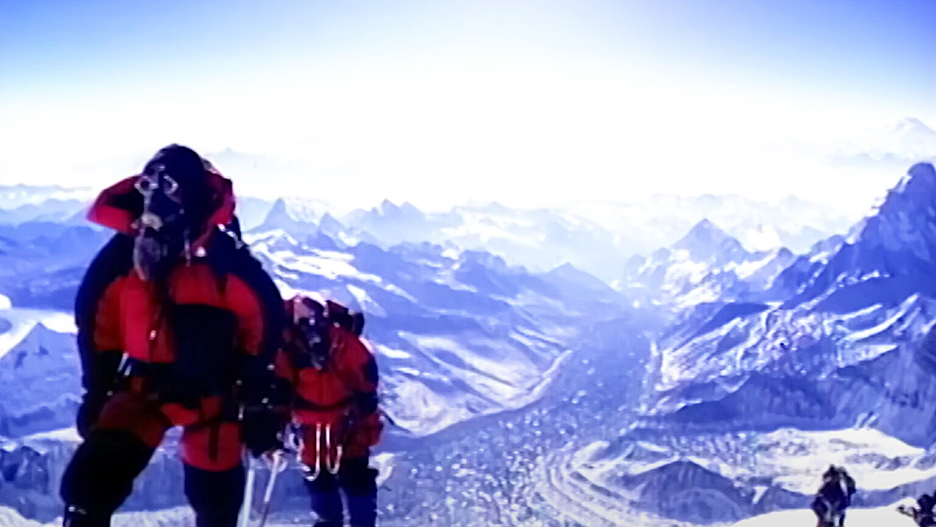
So you may think you've learned all there is to learn about the disaster. But for a glimpse at the immediate physiological and physical impact the event had on some of the climbers stranded on the mountain during that fateful season, look no further than this 60 Minutes Australia special.
Recorded in 1996 in the abrupt aftermath of the disaster, it draws heavily on interviews from Adventure Consultants guide Michael Groom and clients John Taske and Beck Weathers.
A tangled timeline
You could spend days unraveling the timeline's tangled threads (and people have). But if you're just tuning in, the broad strokes go something like this: guides and clients from multiple outfitters became stranded at high camps while descending from summit attempts when a major, multiple-day storm blew in unannounced. Confusion, hardship, and death followed. In the aftermath, serious conversations ensued about ethical climbing and who, exactly, belongs in one of the world's most extreme environments.
The short is only 16 minutes long, so after outlining the scenario, it quickly homes in on the stories of Groom and Weathers.
At the time of the expedition, Groom had successfully summited more Himalayan peaks than any other Australian. And though he recounts the story as placidly as perhaps only an Ozzie can, you can see that the shock is still very much present within him.
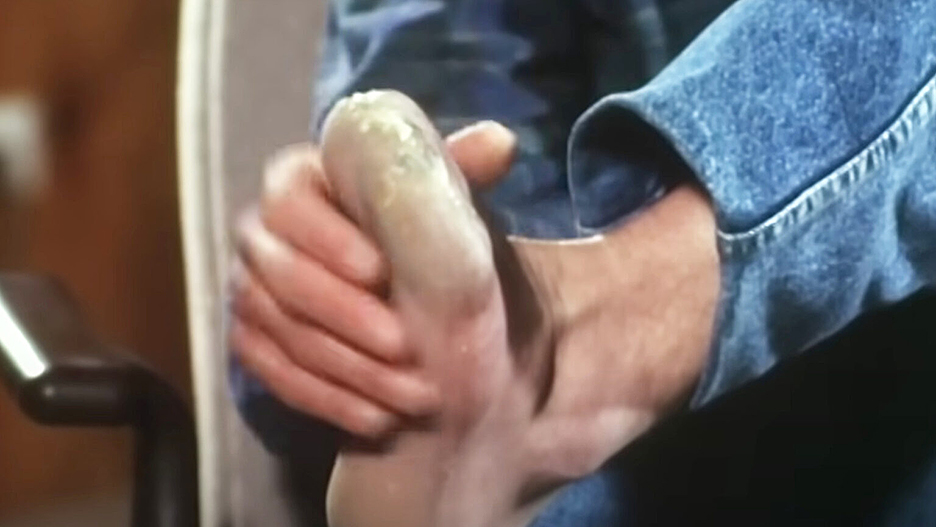
In a confusing series of events, Groom was forced to abandon two of his clients, Weathers and Japanese climber Yasuko Namba, 500m above Camp 4, as he stumbled on for help. After reaching the camp, the exhausted and hypothermic Groom dispatched two other climbers to search for Weathers and Namba. The stricken climbers were found, but the fatigued rescuers judged them too close to death for a successful rescue and returned to Camp 4 alone.
Left for dead
Namba died there in the snow above Camp 4, but unbeknownst to anyone, Weathers later regained enough strength to claw his way to his feet. He was totally unaware there had been a rescue attempt and determined to press on.
"I thought to myself, I'm going to face into the wind, I'm going to walk forward, and I'm either going to walk off this mountain or walk into a tent, one of the two," Weathers says in his interview.
The Texan, snowblind and severely frostbitten, somehow made it to Camp 4 the next afternoon, where he shuffled into a tent and passed out with a sleeping bag over his face.
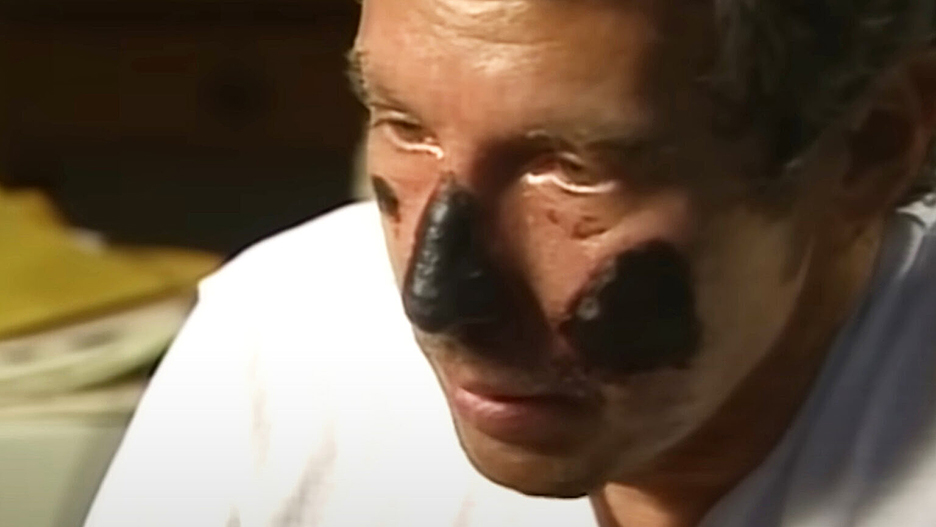
The following morning, Groom shepherded the rest of his clients further down the mountain, eventually reaching Camp 2 and medical assistance. But not before exhaustion and bad luck led him to make a controversial decision. Making his rounds at Camp 4 before departing, Groom happened upon the tent where Beck had blindly sought shelter.
"I looked into a tent that was open; I saw a body lying on the floor of the tent with a sleeping bag over the face of the body. For a moment, I hesitated as to whether I should look at the body to see who it was, but I decided not to. I had assumed he was one of the American party who had passed away during the night."
Beck was eventually rescued by French climbers from Camp 3.
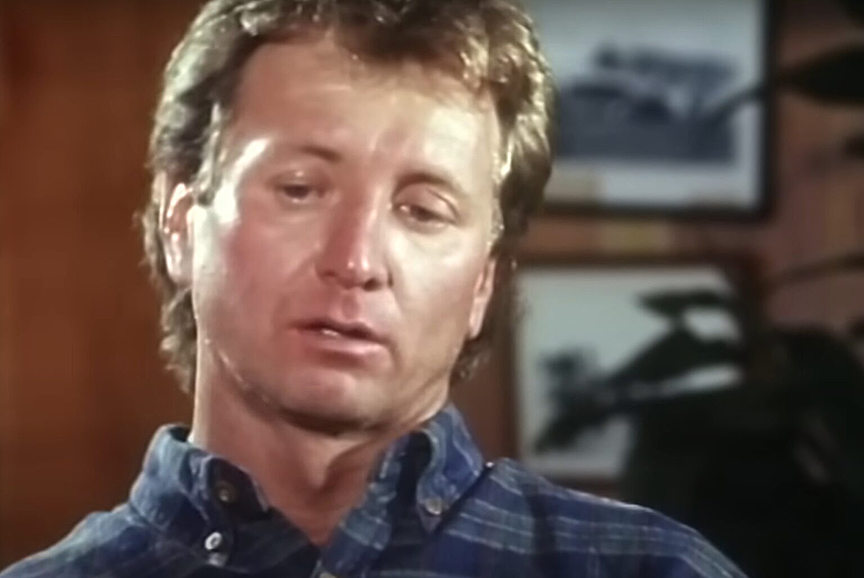
Conscience clear
One of the most fascinating moments in the short occurs when the interviewer questions Groom about this moment. Groom insists that his conscience is clear and that he did everything humanly possible to care for his clients. The 60 Minutes interviewer presses again.
60 Minutes: "Even though you left him for dead? Twice?"
Groom: "No. I didn't leave him for dead twice. The first time, it was a group decision that I should head off to find Camp 4 because I was the strongest both mentally and physically. The second time, I didn't leave Beck for dead because I didn't even know he was there."
Here, Groom pauses, and you can see the emotion roiling beneath his stoic features.
Groom: "In some ways, I wish I'd have removed the sleeping bag and identified him, and then I could have taken care of him, but that's something I didn't do. And I have to live with that decision."
Weathers: a correct decision
For his part, Weathers agrees.
"I think it was a correct decision for him to go try to help everybody. And I'm not surprised when he saw me the second time that he thought I was already gone," he says.
This moment is particularly impactful because Weathers, at the time of the interview, had yet to undergo the dramatic surgeries that would leave him with an amputated and reconstructed nose, an amputated right arm, and missing all the digits on his left hand.
Instead, in the 60 Minutes footage, his arms are swaddled in bandages, his face blackened and gruesome. Toward the end of the short, he chats with Groom and professes hope that his amputations will be limited. It's heartbreaking and immediate in a way that reading and watching later accounts don't quite reach.
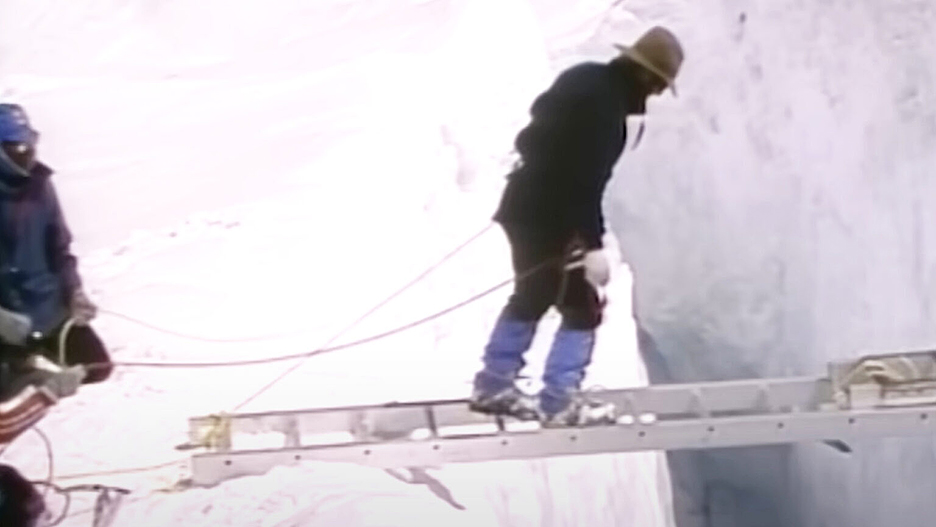
The special wraps with the thought that has plagued Himilayan mountaineering ever since.
"The deaths of such experienced climbers as Rob Hall have raised serious questions as to whether adventurers who pay for the experience put not only themselves in danger but also those who guide them," the host says.
That we still have this debate today indicates that despite all the media coverage of the 1996 Everest Disaster in the 18 years since it occurred, perhaps the most important question about it remains unsettled.
In 2022, Ernest Shackleton’s ship, the Endurance, was discovered at the bottom of the Weddell Sea in Antarctica. Now 3D scans show the legendary shipwreck in extraordinary detail.
The Endurance was crushed in the ice and sank during Shackleton’s 1914 Imperial Trans-Antarctic Expedition. It has lain 3,000m down at the bottom of the ocean for 107 years. In 2022, the Falklands Maritime Heritage Trust spearheaded a search for the sunken ship. Sixty marine archaeologists, engineers, and scientists collaborated to find the mysterious shipwreck.
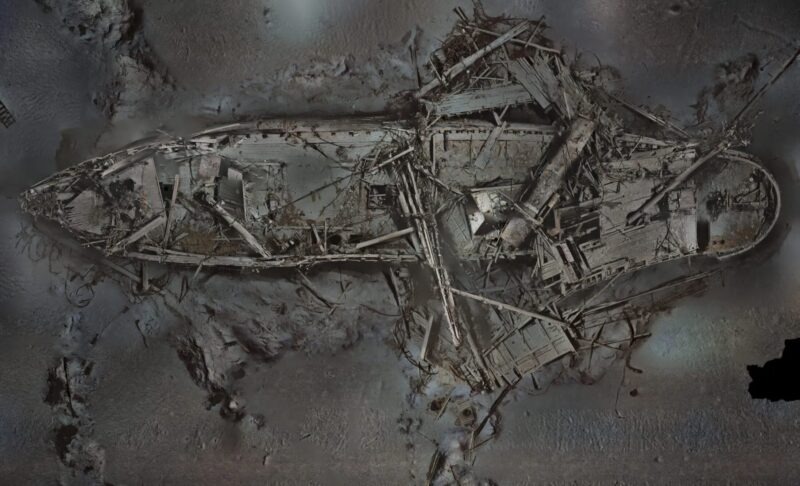
The team spent weeks filming the wreck and its debris field, even releasing incredible footage of the largely intact ship. Now, a 3D scan made up of 25,000 high-resolution images shows the Endurance in more detail than anyone thought possible.
A new National Geographic documentary, airing in the U.S. on November 1, explores Shackleton's expedition and the search for the Endurance. The new footage doesn't just capture the sunken hulk of the ship. It shows the dinner plates used by the crew scattered across the floor, a boot lying amid the collapsed rigging, and even the star pattern of the ship's flooring.
Almost pristine condition
The shipwreck is classed as a monument under the International Antarctic Treaty, meaning that nothing can be retrieved from it or disturbed. Though some sections of the ship have decayed, the ice-cold waters of the Antarctic preserved most of it in near-perfect condition.
The story of how Shackleton and his crew survived the 1914 sinking without a single loss of life is one of the great tales of polar exploration. He and his crew wanted to complete the first crossing of Antarctica. Their attempt ended before it even began and quickly turned into a mission to survive.

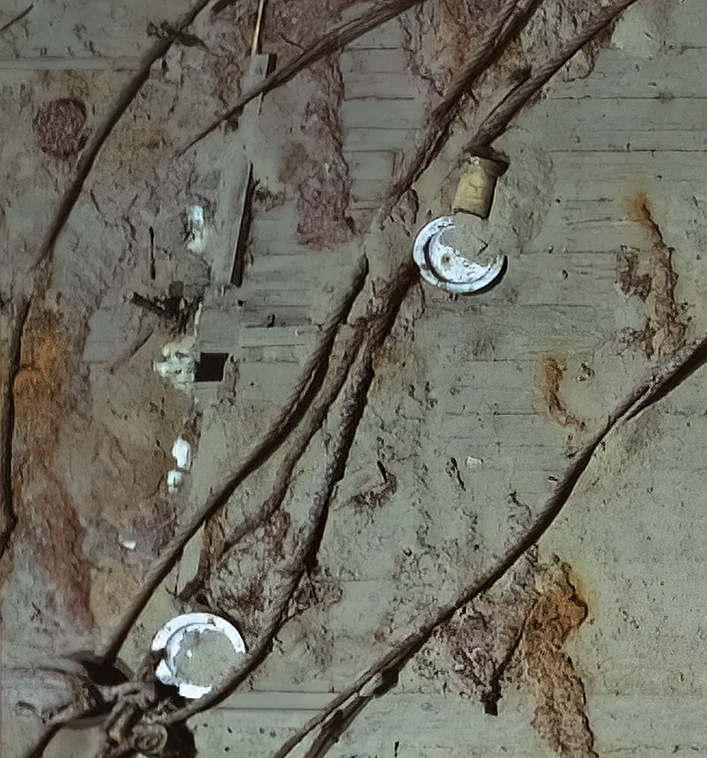
Trapped in the ice, the Endurance lived up to its name and endured the relentless forces of the pack ice for 10 months before it sank. The crew had to rely on their few lifeboats and limited supplies.
In April 1916, they reached uninhabited Elephant Island. There was no chance of anyone rescuing them there, so Shackleton and five crew members set out in one lifeboat across the stormiest seas on Earth. After 1,200km in the open craft, they reached South Georgia Island. Their ordeal was still not over. A whaling station lay on the other side, but to reach it, they had to make a hair-raising crossing of the mountainous, glaciated island. It took another four months to arrange a mission to rescue the remaining men on Elephant Island.
Miraculously, every single crew member was still alive. All 28 men had survived the expedition.
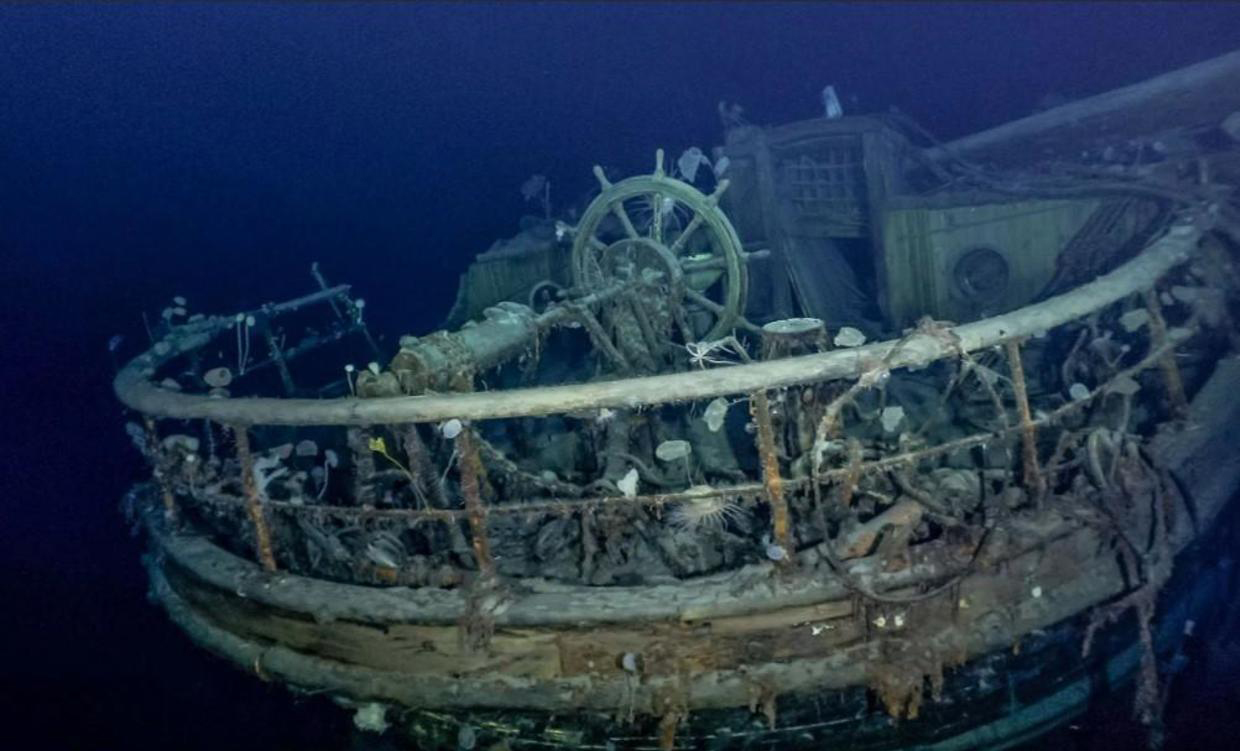
If big water, three accomplished kayakers, and one of South America's standout scenic locations is your cup of tea, look no further: This short film is for you. Kayaking Patagonia's 3 Toughest Rivers For the First Time EVER is 14 minutes of pulse-pounding Chilean goodness.
It follows French expedition kayaker Nouria Newman over two months in 2019 as she attempts the so-called Patagonian Triple Crown — descents of three wild Patagonian rivers: the Baker, Bravo, and Pasqua. Along for the ride are American boaters Ben Stookesberry and Erik Boomer.
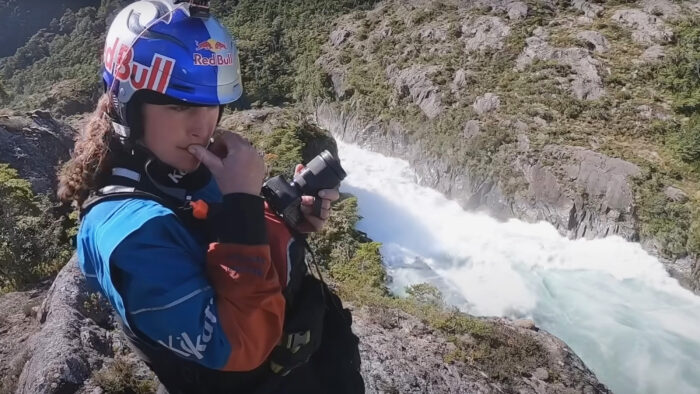
"Why am I doing this?" Newman rhetorically asks in one interview. "I've heard about these rivers for so many years. And I've always been attracted to Patagonia, maybe because it's so far from everything else."
That sentiment tracks when you learn Newman's background. The kayaker, 27 at the time of the expedition, got her start on the water at age five when she joined a local paddling club in her home country. But even that humble beginning took tenacity. She didn't know how to swim when the sport caught her young eyes, and her parents insisted she learn before she got in a boat.
Once she mastered her swim strokes, Newman quickly became a kayak master. She competed internationally in extreme kayaking from 2007 to 2013, wracking up medals and podium spots in 2013 and 2014.

Adventure, not competition
However, Newman is a pure soul, and eventually becomes more interested in adventure than competition.
"I think I had reached my limit of it,” Newman told Red Bull. “I got injured, and I never really came back from injury, so I didn’t have the results. It was the same races over and over. I was getting burned out.”
So Newman lit out for the Himalaya in 2018. Over the next two years, she battled frosty mountain whitewater on top of altitude and logistical challenges.
Then her next trick: The Patagonian Triple Crown.
A good team is important when you're tackling some of the world's roughest water, and each member of Newman's trio added something special.
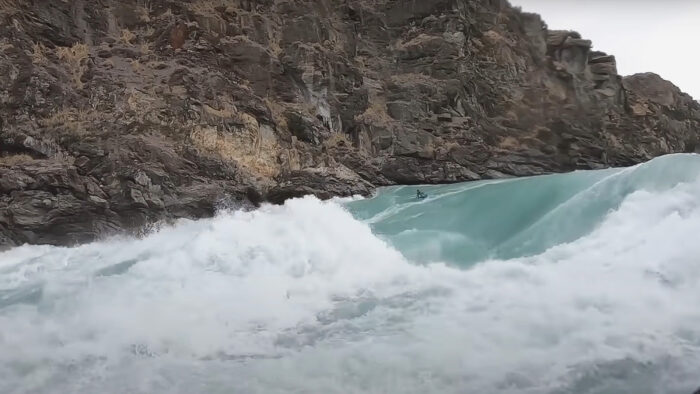
American Erik Boomer brought exceptional whitewater reading skills to the table.
"When no one else can see the line, [Erik] Boomer can see it," Newman says.
As for Ben Stookesberry? Well, there's something to be said for hard-won wisdom.
"He's probably the most experienced expedition kayaker you can find," Newman notes.
Meanwhile, Newman brought her signature fearless brand of aggressive paddling, pushing the team to run a few rapids that gave even the seasoned Stookesberry the creepy crawlies.
Big water
On the Baker, the team tackled big water — the kinds of waves, hydraulics, and pour-overs you just don't find in Europe, Newman observes. The footage is stunning as the trio splashes and flips through the huge sapphire-blue features. On water that big, coming out of your boat is an ugly scenario, so the team fights hard to stay upright as often as possible.
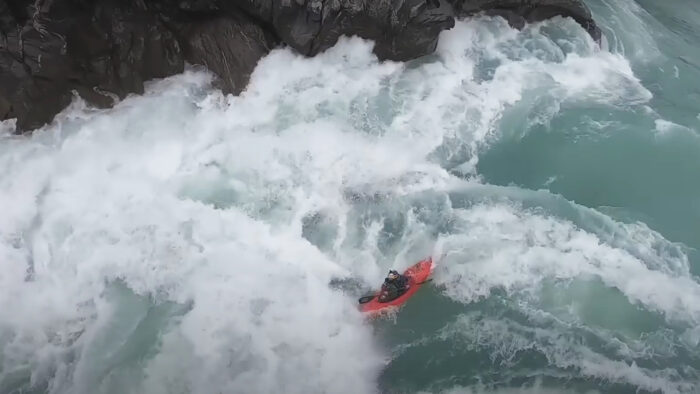
With the Baker successfully sent, the team started eyeballing their next objective: the Pasque. But with six weeks to kill in Patagonia, they tackled an additional six rivers between their big three, notching four first descents along the way.
"We figured most likely, we would get skunked on one or two of the rivers. So, we just decided to take our time,” Newman explained.
She makes it sound easy, but even the time the trio spent out of the water was grueling. The expedition required 160km of portaging with boats that, with gear, weighed more than 45kg.
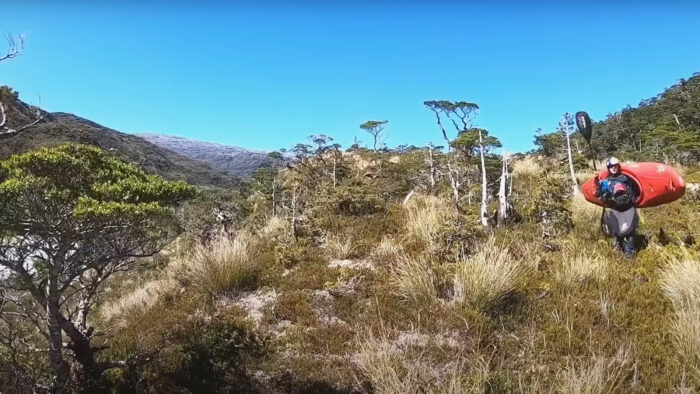
Paddling the Pasque offered the most challenges to the team — this river had only been successfully run once before Newman's team tackled it.
Check out the entire adventure below.
What do you do when a good friend and climbing partner calls you out of the blue and asks you to tackle a demanding route on Denali, the highest peak in North America?
If you're Fay Manners, you say yes, of course!
That innocuous phone call between UK climber Manners and U.S. climber Michelle Dvorak was the start of a grand adventure for the two women, one which they documented in a short film called Cassin Ridge.
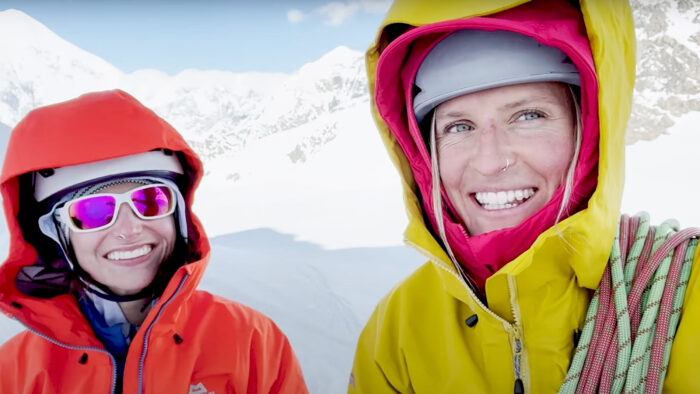
We recently covered the pair's dramatic rescue on Chaukhamba III in the Garhwal Himalaya. This film documented an earlier adventure. It is named after the route the two ascended on their Denali expedition, and as the film shows, it's no joke.
"It's a very committing route, and it's the sort of route you don't want to get lost on," says Manners, who serves as the film's narrator.
First big alpine route
Manners and Dvorak had previously climbed together in Germany and the Dolomites, but the Cassin Ridge would be their first big alpine route as a team. To warm up, the pair tackled a lesser route called Bacon and Eggs on the nearby Mini-Mini-Moonflower peak. The practice was necessary, as, at the time, Manners hadn't spent much time in the sort of demanding environments that surround Denali.
"In Chamonix, it's very much do it in a day, always in one push. So being on a glacier for that long was quite a new experience. But we didn't actually spend that long in base camp because when we arrived, it was the perfect weather window," Manner said.
That pristine weather wouldn't last, but there were other challenges to overcome before the inevitable storm clouds arrived.
The Japanese Couloir, a section of the route early in the ascent, was the first problem. The ice was so hard that they couldn't get a good purchase with their crampons, making for dicey climbing.
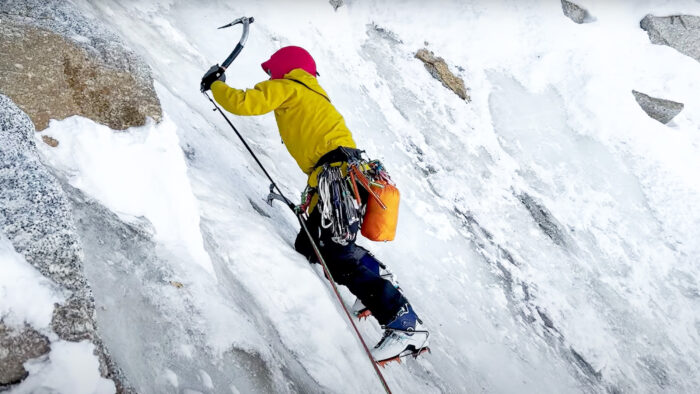
Lost tent pole
They had the opposite problem on the next section, the Cowboy Arete, where warm temperatures led to rotten snow. The poor conditions forced the pair to camp on a rocky ledge. There, attempting to set up their tent in the confined space, they dropped a tent pole off the edge.
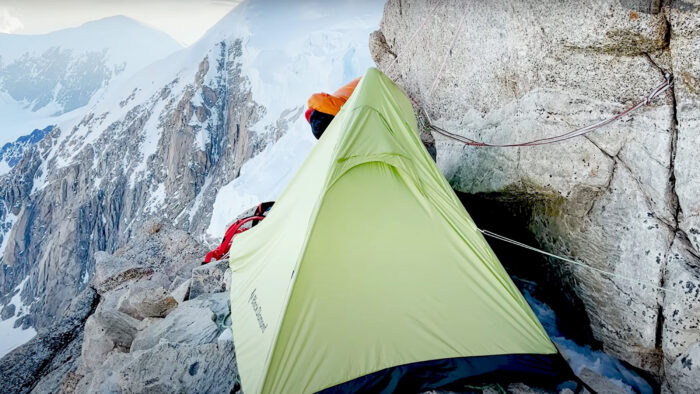
The two decided to press on the next morning, hoping things didn't get too windy.
While climbing the rock bands on the next section of the route, an unforeseen storm rolled in and battered the climbers with 24 straight hours of snow.
"We felt quite alone at this point," Manners narrates. "We had to continue on with our tent with no tent pole. It was going to be taking us longer [than we had planned]."
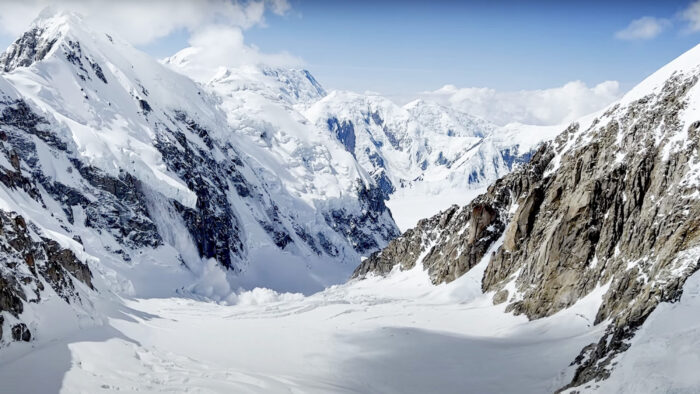
But their perseverance was rewarded. The climbing became easier, the sky cleared, and on summit day, the pair paused to reflect on their coming accomplishment (while gasping for breath.)
"For a moment, we had time to enjoy where we were. Not be scared, and just be happy that we had made it through all the difficulties. Although the rest of the route was easier terrain and less technical, it was at high altitude. Everything was so slow, and breathing was so hard that everything took ten times as long."
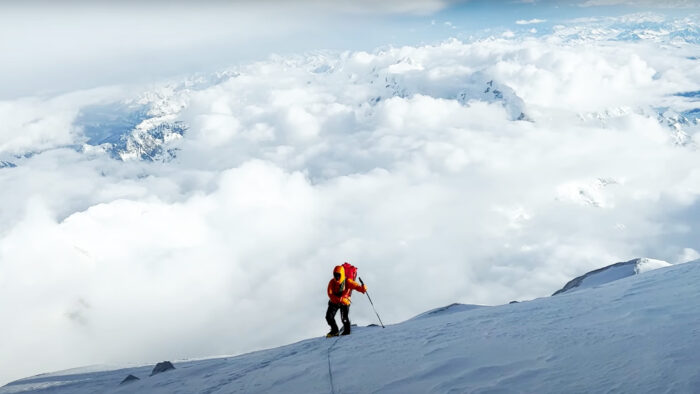
As it happens, many of the difficulties Manners and Dvorak experienced on Denali (a freak accident, challenging weather) would later plague them in the Himalaya. Only this time, the partners would come close to losing their lives.
Cassin Ridge is a short and enjoyable film. At just 11 minutes long, you can squeeze it in on your lunch break.
Here’s the deal: If you want visual stimulation and alpine drama, look elsewhere in a climbing documentary. But if you want a dense mountain report from an ambivalent veteran, immune to travails that could force lesser souls to the brink, keep watching.
Colin Haley’s 2023 solo bid on the Supercanaleta, a Fitz Roy masterpiece that loosens the bowels of even the staunchest climbers, is as simple as that. Haley doesn’t feel sorry for himself, wears the anachronistic facial sun shades, and executes a laborious and impressive ascent.
While filming himself.
Here’s a tidbit from one of the alpine world’s most stoic customers in the high alpine:
"I’m kinda just physically and mentally fried a bit. I kind of think this super-intense, stressful stuff is not for me anymore. [But] even just bailing from here is definitely going to be a very long journey. It’s something like 4,000 feet of rappelling from here to the ‘schrund."
Stick around for an incisive self-inventory in the meadow below. Spoiler alert: don’t bet against my guy.
Amity Warme is tough. It’s no surprise she’s willing to take a big, complicated, 25-pitch bite out of El Capitan the old-fashioned way.
Watch Warme and Brent Barghahn do just that in Ground Up. Arc’teryx chronicles the two penitents on an old-fashioned "ground up" attempt on El Capitan’s El Niño (Pineapple Express variation, 5.13b/c).

It’s a characteristic outing for Warme who, Alex Honnold assesses, "brings a little bit of that old-school mountaineering vibe to modern performance rock climbing."
Power screams and physical-limit climbing
The ascent comes off as a modern foray into the canon of rock climbing — ground-up style, or climbing without rappelling or scouting pitches, is the oldest way to climb El Capitan. It used to be the only accepted way and didn’t become possible in free climbing until several generations of climbers had tangoed with the wall.
If you like a try-hard, you’ll appreciate this pair’s effort. Hang on tight for power screams, physical-limit climbing through clouds and rain showers, and plenty of roof-wrangling.
Murphy’s Law doesn’t quite descend over the climbers like the Yosemite Valley storms do. But this eight-day siege is an adventure by definition, and the team grapples with unexpected and uncontrollable events.
It’s a mixed bag. One thing you won’t find in it, though? Ask Warme.
"You know what they say — excuses are like buttholes," she quips. "Everyone’s got one and no one wants to hear yours."
Message received.
"Kids kept asking us, why not just fly to Singapore?"
That's the opening line of Curious Pedals, a cycling film by self-described "novice photographer" Alvari Poikola and his friend Valtteri Heinila. The two men set out from Finland and rode to Singapore, shooting candid tent-bound selfies, dynamic cycling footage, and sweeping aerial imagery the entire way. The route took them through 21 countries and covered 15,000km, taking 245 days.
"My friends. You don't get it," Poikola often responded to the above question. "The journey is the destination. It's a bit of a cliche, but the best things are, aren't they?"
That kind of introspective mindset saturates Curious Pedals, a subtle and beautifully shot film that is — if a touch linear and by the numbers — still likely to scratch the specific itch that desk-bound travel lovers often experience in the fall.
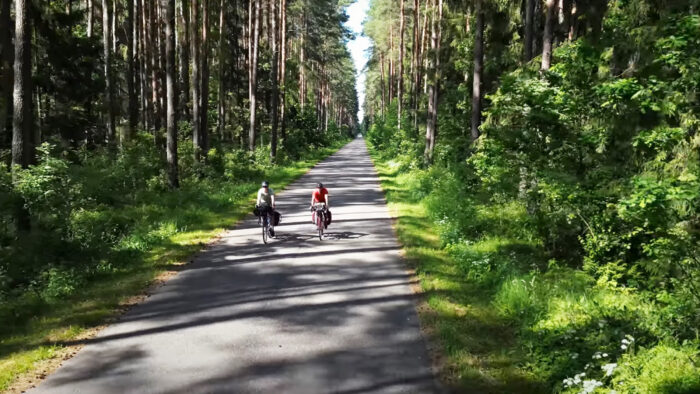
From one adventure to another
"Travelling across Eurasia was a fascinating journey of cultures and landscapes gradually changing from the familiar to the unfamiliar," the two cyclists wrote over at bikepacking.com. But the adventure didn't stop there. As novice filmmakers, Poikola and Heinila found the process of refining their hours of raw footage into a documentary just as exciting as the ride.
"Making this documentary was itself a wild ride," Poikola continued. "It’s my first time creating anything like this and I’m incredibly excited to share it with people."
After an intro visually documenting a scattering of scenes from the length of the film, the story begins in Finland as the two men pedal out of their home city.
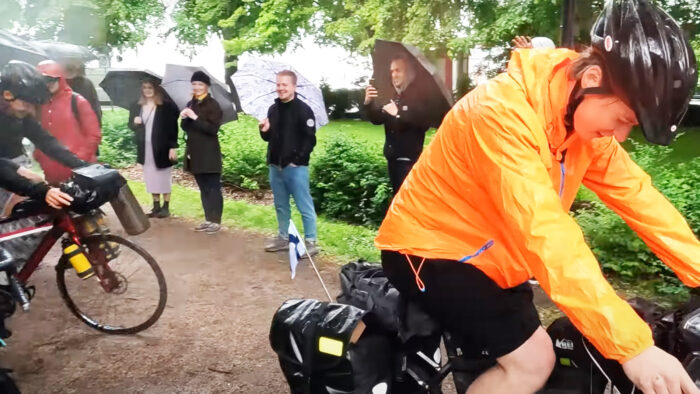
As anyone who loves cycling knows, there's often a shakedown period when setting out for a long trip. Poikola and Heinila's journey was no exception — they experienced their first flat tire a mere 10km into the trip.
But long-distance cyclists are prepared for such eventualities, and that certainly wouldn't be the last mechanical issue. Still, the early days of the trip, as the men navigated the rolling hills and gentle farmlands of Eastern Europe, were idyllic.
The real adventuring started in the mountains, where our heroes learn a fundamental truth of long-distance human-powered travel: "Everything we go up, we get to go back down."
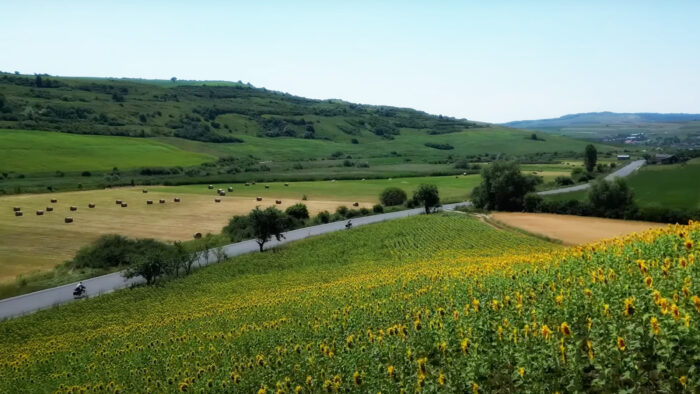
Elevation, angry dogs, friendly farmers, and sunflower fields dominated as Poikola and Heinila transitioned from Europe to Asia. More rugged terrain was on the horizon, but so too were some beautiful moments. A twilight balloon festival in Cappadocia stands out as a visual highlight from this section of the film.
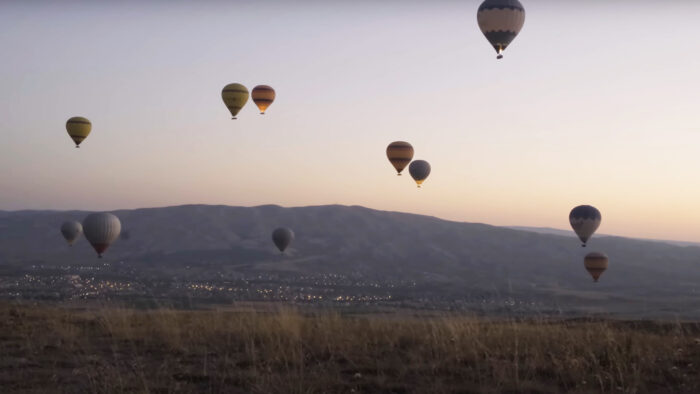
Cycling through the 'Stans
The high deserts and extreme elevation changes of Tajikistan, Kyrgyzstan, and Kazakhstan presented a physical challenge, while an armed conflict between Tajikistan and Kyrgyzstan threatened to derail the entire trip when the two men were turned around at the border between the countries.
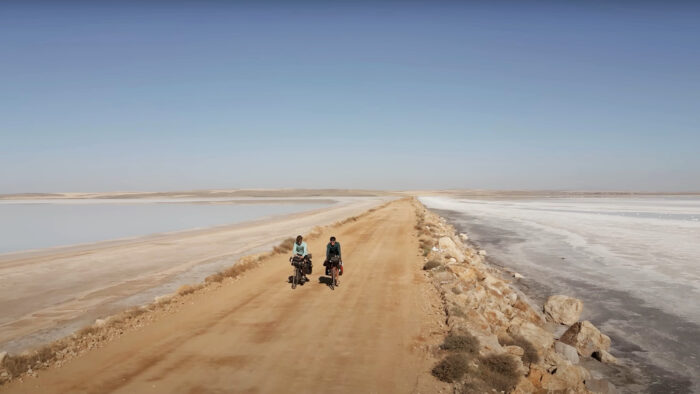
But as so often happens on trips of this kind, providence intervened. A kind stranger donated some money to the cause, and as Poikola and Heinila began a laborious return trip to Tajikistan's capital, they got lucky.
They caught a ride in a truck containing a high-ranking military official, and after making their case known through some tortured linguistic gymnastics, the official gave them clearance to cross the border. There was a hair-raising moment while Kyrgyzstan border guards leafed through their passports, and then the cyclists were on their way east again.
The border closed indefinitely the following day.
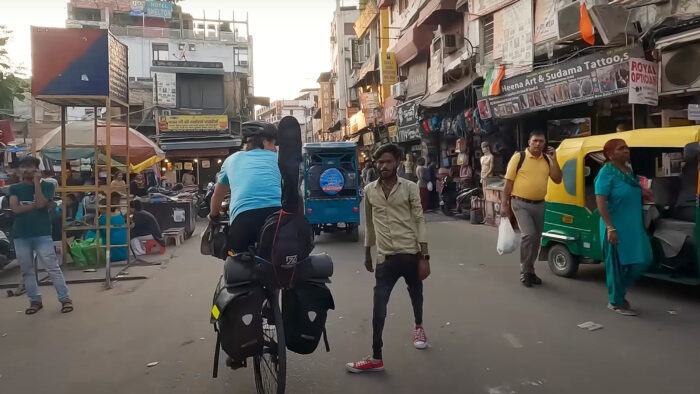
Mindfulness in Asia
In India, Poikola and Heinila traded lonely desert highways for crowded city streets.
"I understand why so many Eastern religions have a focus on mindfulness and meditation. Without it, you'd go mad living in a place like this," Poikola observes while winding his bike through the human chaos of an Indian city.
In Nepal, the riders place their bikes on trucks and hitch a ride through two national parks. Along the way, Poikola manages to catch Dengue fever.
After a few days recovering in the shadow of the Buddha's birthplace, Poikola visited a Vipassana retreat and meditated in silence for ten days, while Heinila got a taste of the Himalayas with a ten-day ride on the Annapurna circuit.
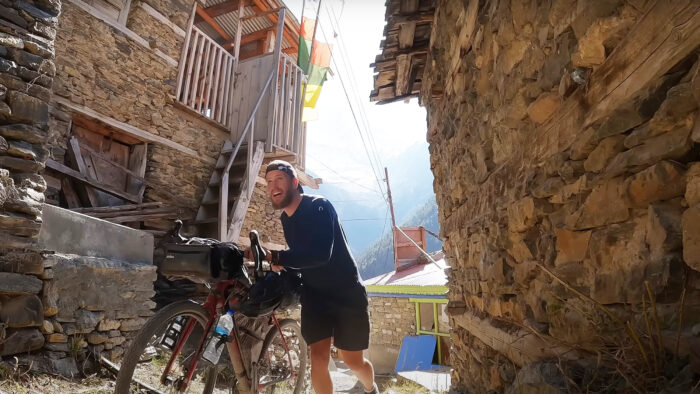
Reunited, the boys traded the rarified Himalayan air for the dense humidity of Southeast Asia's jungles and waterways. More repairs, illness, and adventures with local cuisine followed.
Watch the film for yourself to see Poikola and Heinila's triumphant arrival in Singapore. At over an hour, Curious Pedals isn't a quick watch, but it's a worthwhile one. Don't miss it.
At the top of his reach, Mark Hudon can only just touch Jordan Cannon’s head.
It’s an odd first impression about Free as Can Be, the Arc’teryx chronicle of the unlikely climbing duo, but it definitely hits. Does it owe to their matching outfits which, intentional or not, immediately paint Hudon as Cannon’s mini-me?
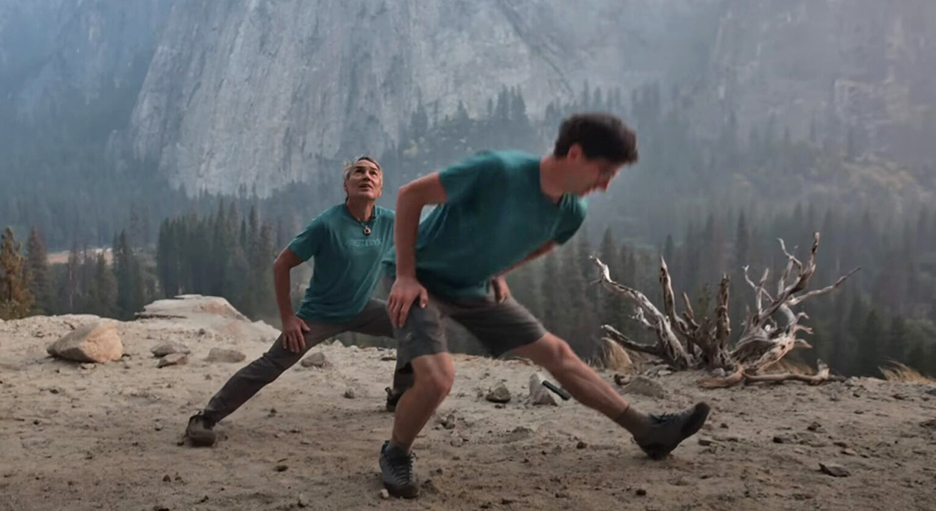
Is it Cannon’s skinny, sneaky height or Hudon’s yawning wingspan?
If the quirky Hudon is some kind of odd doppleganger for the polite Cannon, neither one seems to mind the arrangement.
“Jordan [targeted] Mark. It’s very sad, actually,” climber and filmmaker Cedar Wright jokes. “He’s preying on a senior citizen so that he can go and send his projects.”
Wright’s take is characteristically needling and clever.
Free as Can Be weaves several storylines together around one core thread, which is the year Cannon spent supporting Hudon on his goal to free climb El Capitan.

63-year-old vs 20-something
The novelty is clear but limited in a story about a friendship between a 63-year-old and a 20-something. Which makes it a good thing the film’s directorial choices are sometimes circuitous.
Hudon’s own story as a talented but uncelebrated 1970s Yosemite pioneer is vibrant and informative.

So are the interviews, especially one with Brad Gobright — which lands eerily in the 2021 film after his 2019 death.
And while the dynamics between Hudon and Cannon aren’t necessarily fresh, they do offer interesting qualities. How would Cannon, a young technician, support this transient, enigmatic elder in his challenge quest? By surprising him with a travel-oriented training program packed with modern techniques and aspirational objectives.
It builds to become a slow-burning endearment. If the odd couple setup didn’t stimulate me, the camera’s ability to capture the evident adoration between the two did.
Cannon can be serious to the point of insufferable. And while Hudon’s default mode is impish, he doesn’t always play the funny man between the two.
“Today, we’re teaching an old dog new tricks,” Cannon says in voiceover, shooting a cell phone video of Hudon racking up.
“Me being the old dog,” Hudon retorts skeptically.
“You only look old,” Cannon fires back.
Hudon’s face — half “good one, wise guy,” half “wanna fight?” — is priceless.

Overall, Free as Can Be’s colors pop. It would be easy for the film to posture at wisdom while limiting itself by sentimentality. Instead, skillful storytelling allows it to mimic the skill of its protagonists: it catches lightning in a bottle.
Daniel Curry grew up poor in a single-parent household and was home alone a lot.
"Although not alone. Home with animals," Curry says, pointing to these hard days as the genesis of his bond with the natural world.
That bond continued through Curry's early adulthood as he worked with wolves in captivity. Those formative early years interacting with one of North America's most amazing — and controversial — predators laid the foundations for Curry's current profession.
He's a range rider for Washington State, tasked with roaming the valleys and mountains that comprise much of the state. His mission? Protect cattle from wolves.
And protect wolves from people.
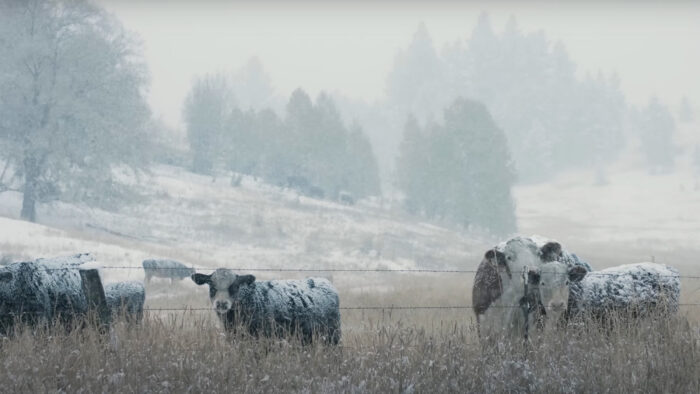
Seeking a middle ground
This unique position is the focus of a recent short work from Patagonia Films. Range Rider follows three seasons in Curry's life as he, his horses, and his trusty dogs attempt to find a middle ground between wolf conservationists and the multi-generational ranching operations that also call the region home.
The film strikes at the heart of one of the most densely woven conservation issues plaguing American public lands. Ranchers have long held the right to graze cattle on public lands, and many small and mid-sized operations have been doing so for generations. So when land management agencies begin rethinking land use — i.e., preserving more of the land for wild species by limiting grazing — those same ranchers take umbrage.
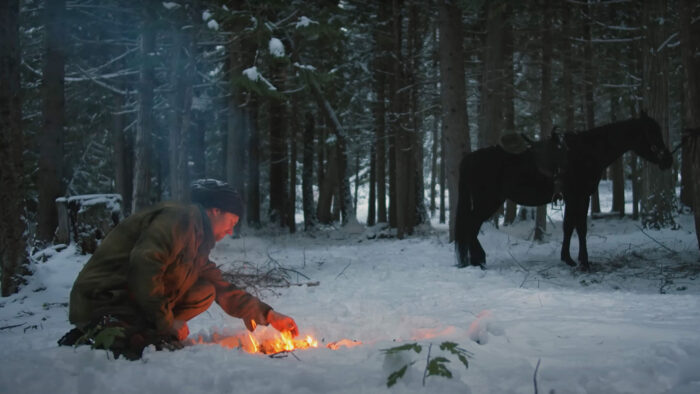
"People like to give them fancy titles, but a wolf is a wolf, and they are killing machines," says Len McIrvin, one of the Washington ranchers interviewed for the film. "And if we were able to take a shot at them whenever we see them, cattlemen would be able to take care of their own problems."
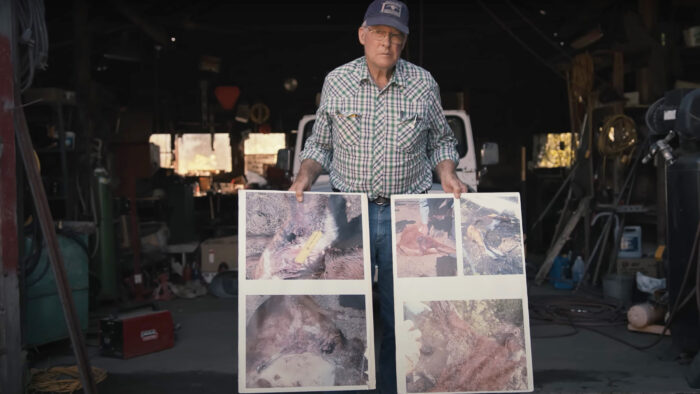
Into this mindset wades Curry, a skilled horseman and tracker attempting to synthesize old-school Western sensibilities with a modern conservation mindset. He was the first range rider on Washington State's payroll, and he takes his responsibility seriously.
'A box of bullets is what I know'
"A lot of the ranchers out here are having a hard time accepting wolves on the landscape. 'I can't have them out there eating my cows, so a box of bullets is what I know. That's what my grandpa knew, and that's what I'm gonna do,' " Curry says, tapping into a mindset held by many of the ranchers he works closely with. "And a lot of that generationally ingrained mentality still exists today because no one has taken the time to offer a better solution."
Ranchers in the area often put pressure on the Washington Department of Natural Resources to mitigate the wolves preying on cattle grazing public land. The DNR responds by tracking and shooting wolves, often from helicopters. As the Washington DNR is also tasked with protecting and fostering the Washington wolf population, this policy often outrages conservationists and local hunters alike.
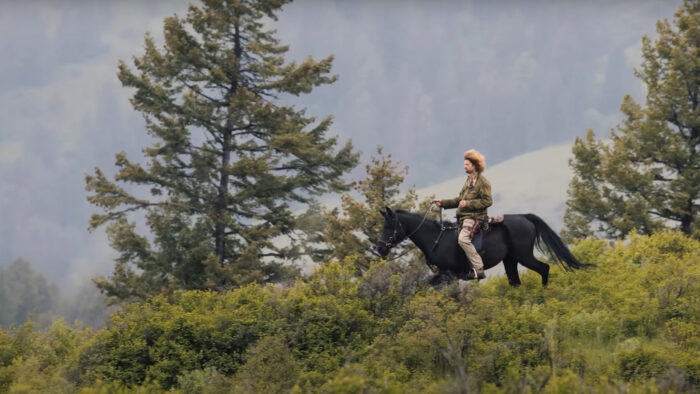
Curry, as he says, is offering a better solution. According to proponents of the range rider program, his mere presence on the public lands used by cattle grazers dissuades the wolves — making it uncomfortable for them to hunt cattle grazing areas. He scouts and makes notes, sets up game cameras, and roves endlessly on horseback. And while shepherds throughout history have traditionally killed predators, his dissuasion methods are non-lethal.
A difficult mission
As the film progresses, it becomes evident just how difficult Curry's lifestyle is. Funding is sporadic, and he has to live cheaply and scramble for non-profit grants to keep his work going. He's also regularly accosted at gas stations and in supermarkets by members of the community who don't approve of his mission. Sometimes, irate ranchers even show up at his home in the middle of the night. It takes a toll.
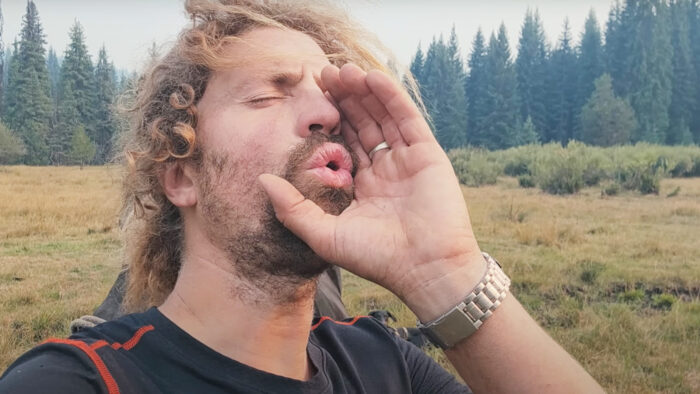
"I'm at the point now where I'm really gauging personally, 'is this something that [I] still really want to do and believe in,'" he says, with pain and weariness evident on his face.
Gorgeously shot with a painterly eye, Range Rider makes full use of drone technology to provide exquisite, well-composed aerial footage of Washington landscapes and ranching operations alike. It's a film that wouldn't have been possible just 15 years ago, and an important one — both for the quiet beauty it displays and for the message of hope and compromise (quixotic though it might be) it ends with.
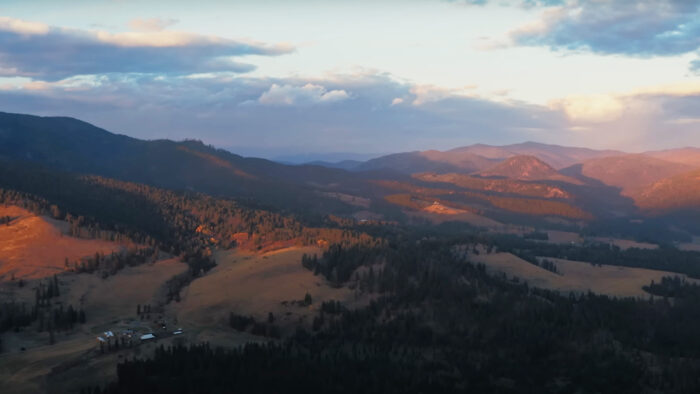
Both sides now
"So I used to think the best solution from my ignorant perspective was just not to have ranching on public lands. And now I have a connection with the ranching community out here. I had never shook hands with a rancher, I had never watched how hard they work, I had never known a family like I do now. It's a connection that we are lacking in so many ways," Curry notes towards the end of the film as he huddles around a campfire, trying to ward off the autumn chill.
"You can see it all over the world. The wars we fight, the way we lump each other into categories. We can maybe stop looking at each other as Democrats and Republicans, find common ground that we tend not to look at. Sometimes I think we're afraid that if we admit there's another way, or that you don't have to look at life the way that you have been, it's a failure.
"And that's not for me, at least."
British adventurer Alex Staniforth isn't an elite athlete, nor is he the luckiest. Most times, when I log onto social media and see Staniforth is planning an adventure, I half expect it to end with an untimely injury or illness. Altitude sickness on Mera Peak and Cho Oyu, exhaustion on Baruntse, and near death on Everest.
But what Staniforth has faced in misfortune and false steps, he has met with equal force to adapt and overcome. He is what he self-proclaims an adversity adventurer. Aged 14 and beset by bullying, epilepsy, and a stammer, Staniforth set his sights on climbing Everest after a few formative experiences hiking in the mountains.
Just four years later, at 18, Staniforth had raised the funds to tackle Everest, but only made it as far as Base Camp before a huge avalanche killed 16 Sherpas and canceled the climb. He returned the next year, in 2015, and was climbing through the Khumbu Icefall just as a huge earthquake struck Nepal and took the lives of three teammates.
Beyond Everest
Moving away from the big mountains in the ensuing years, the ever-upbeat Staniforth channeled his energies into long-distance endurance events while fighting off the demons of mental ill health and eating issues.
But perhaps the most important part of Staniforth's post-Everest years was the founding of Mind Over Mountains, a charity that provides professional counseling and support while walking out in nature across the UK.
Head Above Water picks up the story with Staniforth trying to overcome the effects of Long Covid and tackle a 65km swim-and-run ultramarathon in the Lake District.
Since this film was screened, Staniforth collapsed with an epileptic seizure during a 300km run across the width of the UK. I'll bet that this plucky adventurer will just keep plowing on to the next challenge.
Creation Theory is not just a movie about adventure sports, it’s a meditation on how we create meaning from the world around us. Director Ben Sturgulewski connects grand ideas with the experience of wilderness travel and adventure.
The film is set in the Westfjords of Iceland, where towering mountains meet the rough sea. Here, in this dramatic landscape, Creation Theory draws parallels between adventure, music, human creativity, and the natural world.
Whether it’s a surfer catching a wave, a snowboarder carving a line down a peak, or a musician on a stage, the film explores how these acts of creation reflect the natural forces at work around us.
It somewhat grandiosely asks, "Where does creativity come from?" and attempts to answer this through a blend of big, expansive visuals and commentary from a mix of surfers and snowboarders.
Abstract notions
The featured athletes try to articulate their own links between their craft, nature, and creativity. "You can feel the rhythm in your life, you can feel the rhythm in elements, you can feel the waves that come and go in your personal human experience," snowboarder Robin Van Gyn reflects.
That all sounds rather abstract, but anyone who enjoys playing in the outdoors has experienced that feeling of creation -- whether plotting a kayaking route on a map, weaving a route on a jumbled rock face, or picking a line down a mountain bike run.
Just to make it even more theoretical, the film is built around the themes of interstellar creation, space, and time, drawing on concepts from Einstein's general theory of relativity. Like me, you may not be able to connect all the dots, but Creation Theory will leave you thinking.
In a world full of digital noise, Sylvain Tesson's film Alone: 180 Days on Lake Baikal offers a refreshing escape. This documentary follows French adventurer and writer Tesson's six-month retreat from civilization in a remote cabin on the shores of Lake Baikal, the world’s oldest and deepest freshwater lake.
Our journey with Tesson starts in February in the dead of Siberian winter, when Baikal is frozen solid and at its most alluring. As winter turns to summer, the film slowly and thoughtfully charts the changing landscape as the ice melts and the surrounding mountains and flora flourish.
Alongside his visual storytelling, Tesson’s honest and thoughtful narration draws you in, and his daily routines, such as fetching water and chopping wood, are oddly satisfying to watch.
To stave off cabin fever, the French writer split his days into two parts. In the morning, Tesson immersed himself in what he calls spiritual acts, such as reading, learning poetry, smoking, and of course, a great deal of staring thoughtfully out of the window. The afternoon is reserved for puritanical physical tasks such as cutting firewood or fetching water.

It must be morning. Photo: Sylvain Tesson
Vodka and cigars
It wasn't entirely spartan, though. Tesson brought along a few luxuries, such as vodka and cigars, as treats. He seemed to enjoy the contrast between simple backcountry living and indulgence. After spending the day trekking through snow and fishing in -30°C temperatures, he later remarked, "It is wonderful to read Chinese poetry while smoking a Havana."
Meeting the Locals
Tesson is alone most of the time but does meet some of the few locals along the shore. He takes long hikes on the ice and in the mountains to visit his neighbors. These brief encounters gently highlight the simple and resilient way of life many in Siberia still live.
One of Tesson’s encounters is with a couple who has manned a lone weather station for the past 20 years. Coincidentally, eight years after Tesson, a friend and I also ran into this same couple when trekking across the lake in winter. They were still at it. I suspect if Tesson returned to Baikal today, he might still find the couple there, unable to escape the allure of unspoiled isolation.
And that is where this film succeeds best, subtly conveying the solace and inspiration of remote wilderness living. As Tesson points out at one point, “Solitude is the only lover who will never leave you.”
Jason Baldes, a member of the Eastern Shoshone tribe, grew up hunting with his father. But as the two men explored the natural landscape of Wyoming's Wind River Indian Reservation, the younger Baldes grew frustrated that those hunting trips couldn't include buffalo.
"Prior to colonization, the buffalo was our life's commissary for many of our tribes. It was our food, our clothing or shelter, but also central to our cultural and spiritual belief systems," Baldes says in the PBS film Homecoming.
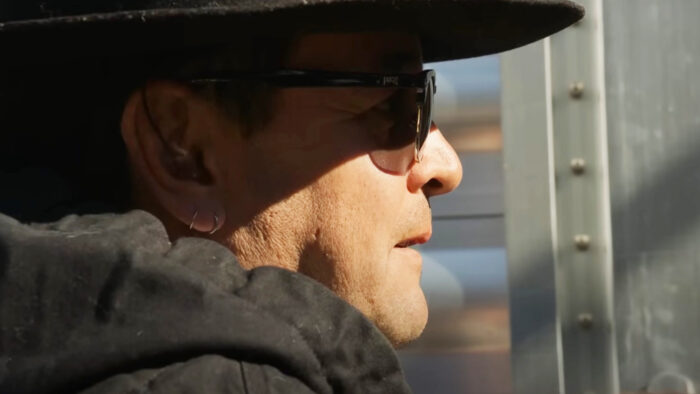
"It's been missing for a long period of time," he continues. "So, to restore that animal to our communities means that we can begin to heal. From atrocities of the past, from loss of land, loss of culture, loss of language. It's foundational to who we are."
Baldes' father was a biologist, and Baldes himself pursued science from an early age. He already knew from those first family hunts that his footsteps would follow the path of the buffalo.

Bringing back the buffalo
The quiet, meditative film follows Baldes as he attempts to return buffalo to his tribal land. Through organizations like the InterTribal Buffalo Council (ITCB), Baldes and others like him purchase and accept donations of animals from other herds and transport them across the country.
The Council hopes the buffalo will begin to bring ecological healing to a long-abused landscape. To date, the ITBC has restored over 25,000 buffalo to 60 herds in 20 states.

Currently, many tribes have to help the bison stay alive by giving them food. But the long-term goal is to "restore them to larger landscapes where they can exist on their own, without intervention from man, or genetically manipulating them, or ranching them," says Baldes.

'In our DNA'
The desire to see buffalo return is more than just ecological. Baldes feels a powerful cultural connection to the animal, and hopes to one day go on buffalo hunts with his children and grandchildren.
As he rightly points out, the hundred years that the buffalo have been absent from Wyoming is a drop in the bucket compared to the millennia Indigenous Americans had a powerfully intimate relationship with them. Such a relationship, Baldes says, is "in our DNA."
He's not wrong. One of the InterTribal Buffalo Council's goals is to return buffalo meat to Native people's diets through reservation lunch programs.
The council cites the modern Western diet as a major cause of the high rates of diabetes and other health issues that plague Native populations in North America.
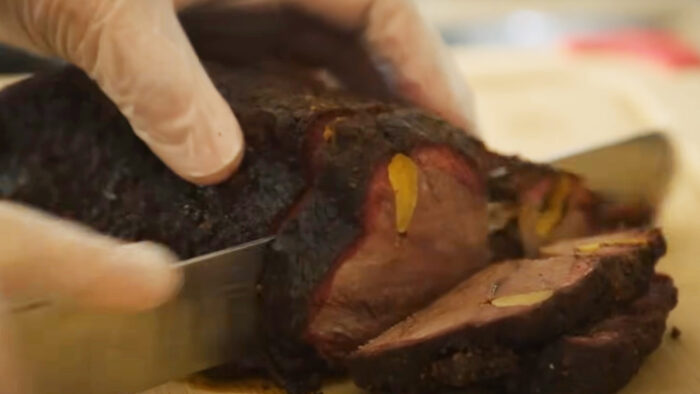
Baldes also sees in the buffalo a metaphor for the plight of his own people, similarly shunted to pitiful remnants of their once vast territory. In restoring the animals, Baldes hopes to restore the emotional and spiritual connections his people once felt to buffalo. Every time he watches one of the majestic creatures gallop out of a holding pen and out onto the plains, his spirits lift a little.
"When that hoof hits the ground, and you see that first footprint, you finally realize they are home," he says, emotion audible in his voice. "And they won't ever leave again."
In a crowded field of climbing films that are increasingly hard to tell apart, Mike Call’s The Artist kept me guessing. My notes are tangled and scrawled, and (perhaps largely due to personal reasons) would be stained with saline if I’d been leaning over the paper instead of backward.
Can you expect the son of this woman to portray a mundane hero?
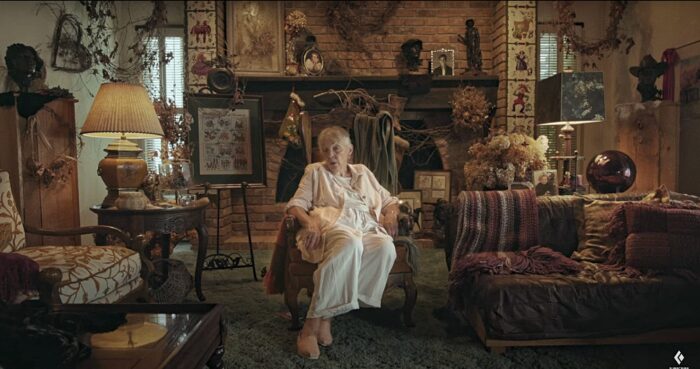
Let me explain what I mean by “kept me guessing.”
Here’s a linear story arc The Artist could follow:
Boone Speed anchored sport climbing in the 1990s, burning a trail through American Fork Canyon that fried everyone not named Chris Sharma. Then he played an instrumental role in inventing modern bouldering gear and creating the market for it. Then he became a world-class photographer.
All along, his unforgiving personality burned just as hot as his ambition. He ostracized some of his closest friends. Everything he did “put a dent in the world,” in Call’s words, but he appeared to pay the price for it. It looked like he couldn’t break through whatever membrane was keeping him restless in his own skin.
Then later in life, he cooled off — realizing, as he says in the film, that his oldest relationships are the most important thing. He sums up the epiphany with a familiar sentiment: “How much better does it get?”
All of that’s true. But, like all art, there’s what The Artist appears to do, and then there’s what it actually does.
Here’s what it actually does:
Describes Speed’s early dynamism from behind the lens
Call was Speed’s earliest videographer. Three decades later, their relationship is the same. But instead of depicting a one-dimensional Speed by handing him the narrative reins, Call tells it his way — which adds depth to his subject right away.
Emphasizes real-world outcomes
Introducing key mentors like Maria Cranor, Black Diamond’s marketing director while Speed was embroiled in generating the modern bouldering market, provides accountability. Cranor and other key influences create rules and boundaries for young Speed, shaping his decisions.
Pusher, a company that Speed helped found, wasn't just a collective of heathens. It was the first climbing company that paid no attention to anything except bouldering. Pusher sold an aesthetic involving T-shirts, ads, and some seminal videos. It also made climbing holds.
Allows its aesthetics to penetrate
The Artist exalts the aesthetic principle of reduction: Do more with less. You can see it in Speed’s interior decoration, with demure houseplants and a small reproduction of one of his father’s sculptures. It’s also the principle he applies to guide his photography.

And if you’ve ever climbed, you know how to apply it.
The film stays out of the way, allowing emotive expression from images, colors, and interview subjects alike.
Pumps the gas — but doesn’t over-rev
Speaking of Speed’s father, don’t miss the son describing how he felt after his father died. But don’t expect lingering close-ups of misty eyes or quivering lips. Call knows the viewer can feel every bit of the moment’s pathos without having their head dunked in a bucket of it.
(For the record, yes, this is the part that got me choked me up.)
Elsewhere, skip to 14:10 for peak tough-guy Boone.
Focuses on the art, not the artist
So The Artist doesn’t focus on the artist?
Correct, it does not. Instead, it watches what the artist is watching: his subjects. In a way, Speed is the hero of the film. But not really. Because it’s actually about everyone except him.

In the fat part of the bell curve of climbing films, production crews can labor in dramatics, saturated visuals, or tired storylines.
Another segment in the big part of the curve is the predictable. We watch a climber trace a typical heroic cycle of accepting challenge, faltering, transforming, and eventually meeting the challenge to achieve redemption.
The Artist pretends to be both; instead, it’s neither.
There's more to explore that way.
In Costa Rica, unique trees grow in a special, mist-shrouded woodland. The cloud forest is called Monteverde. The trees are strangler figs — unusual giants that erupt above the surrounding canopy like lighthouses on a rocky coast. And into these hulking trees clambers a small but dedicated community of tree climbers interested in experiencing a different, perhaps softer, side of the vertical life.
This community — and, to a certain extent, the trees they climb — is the subject of the documentary Climbing Giants. The brainchild of climber and adventure storyteller Noah Kane, the film delves into the motivations and passions of this multi-generational community.
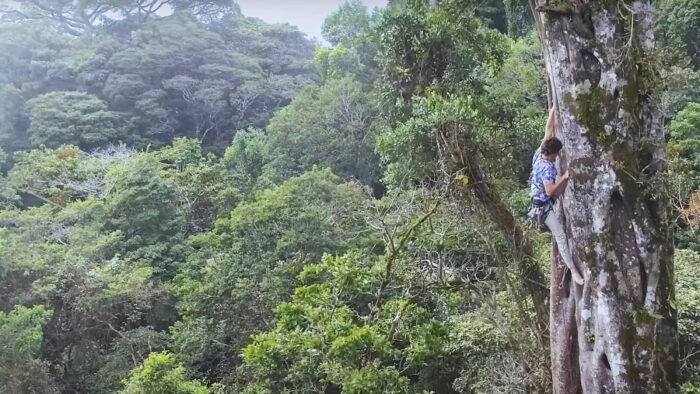
"Trees link the earth and sky. They are these mundane connectors between where we walk every day and the sky, which has this sense of the celestial, of something that's bigger than ourselves," Nalini Nadkarni, a scientist who specializes in studying tree canopy ecosystems in Monteverde, observes early in the film.
Nadkarni was the first person to take up tree climbing seriously in Monteverde. At first, it was a means to an end, a way to study the plants that reach into the cloud forest canopies.
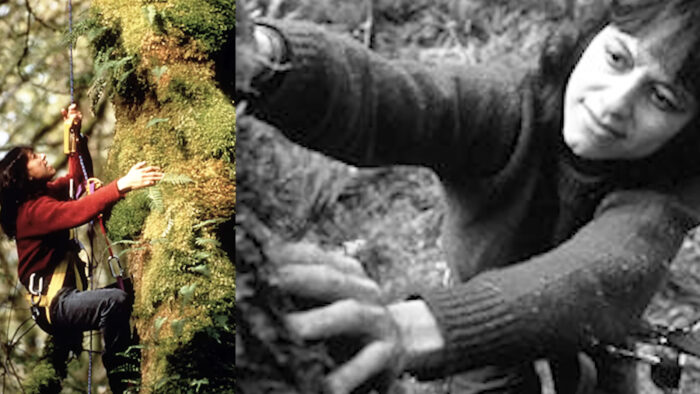
'Tarzan and Jane stuff'
"Scientists, when I first started tree climbing, felt that it was just a stupid thing to do. I remember my graduate committee saying, 'Oh, that's just Tarzan and Jane stuff, Nalini. That's just a gimmick. Why don't you just stick to what everybody else is doing on the forest floor and forget the canopy?'"
But Nadkarni stuck to her guns, and eventually, the activity became a passion and a hobby. Helping her along on these arboreal missions was a peculiar tree that gives Monteverde its unique character.
"Tropical cloud forests really have some of the most diverse and abundant plants that grow up in the treetops," Nadkarni observes. "And one of the most important and interesting is the strangler fig."
Strangler fig strategy
When a bird or monkey eats a strangler fig fruit and then defecates the seeds, sometimes those seeds stick to the branch of another tree. This is actually what the strangler fig wants. The seed sprouts roots that grow downward, spiraling around the host tree until they hit the ground.
Now with a regular source of water, the strangler fig begins to grow quickly, until its "roots" become a tangled, dense, almost sculptural mass that surrounds the trunk of the host tree. And that special shape is attractive to a certain type of adventure seeker.
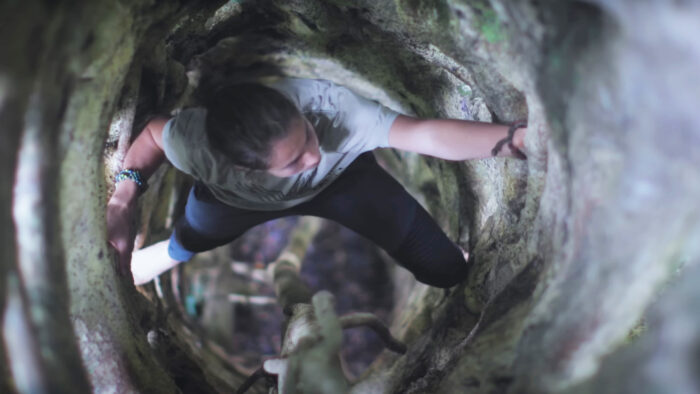
"The special thing about the strangler fig trees is that as they grow they form this ladder of tangled up shapes that we can use to [climb]," says Izzy More, a young Costa Rican following in Nadkarni's footsteps — if for more aesthetic reasons.
"Our goal is to...do a clean ascent of the tree. Hopefully, without falling," he continues.
Like so many other climbers, More views the pastime as a way to prove something to himself and experience life outside the boundaries of terrestrial existence. The same goes for the rest of the young men and women scaling Monteverde's tangled giants.
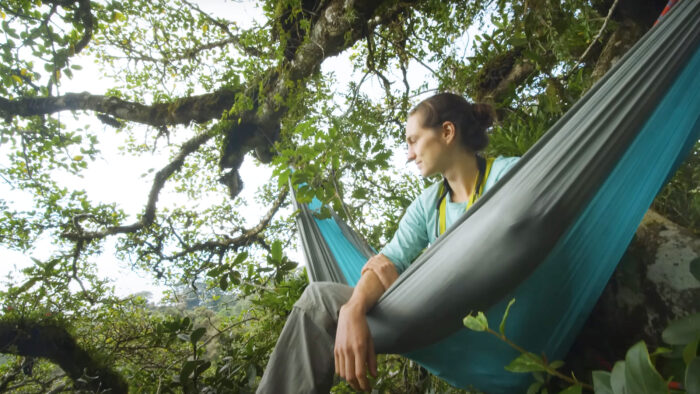
Barefoot climbing
But if the documentary makes one thing clear through its smooth, assured visuals and attentive use of sound design, it's that climbing trees is different from climbing rock or ice on a fundamental level.
Almost none of the climbers wear shoes, and the gentle sound of wind and mist filtering through the canopy leaves is ever-present. Monkeys howl, birds sing, and endless insects hum and whine.
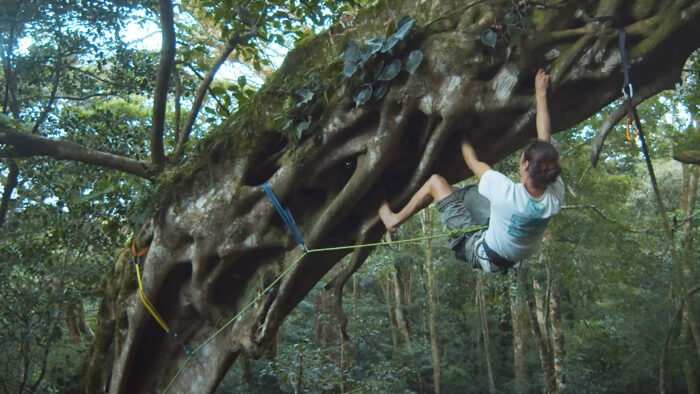
To ascend a strangler fig, Climbing Giants makes clear, is to make an intimate vertical connection. At just under 49 minutes, the film is an excellent way to start your weekend.
Will Renwick is the first to tell you that he probably chose the wrong time of year to attempt a continuous trail run of every 600m+ peak in Wales.
"[September] is very cold. The nights are very long, and the days are very cold. So not a good time to be trying to run up every single mountain in Wales," the outdoor writer/editor and athlete shares in the film's opening moments about his adventure, Taith Galed (A Hard Journey).
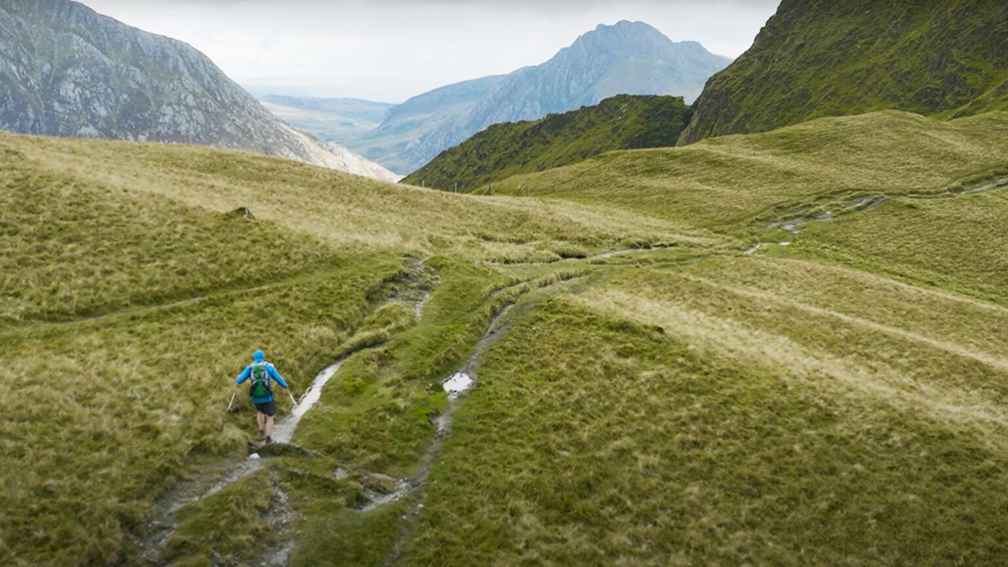
But after being delayed for a year by COVID-19 lockdowns, Renwick wasn't prepared to wait any longer. On Sept. 11, 2021, he set off on the attempt. In the coming weeks, he'd battle the aforementioned cold and short days in conjunction with heinous
blisters, endless rain, waterlogged trails, and, in one memorable case, forgetting to climb an entire mountain.
It's a hell of a journey, and luckily for us, it's all on film.
A Welsh obsession
Renwick's obsession with Welsh mountains comes naturally — he's a native of the country who got bit by the hillwalking bug early and hard. By the time he'd graduated college, Renwick had hiked virtually every trail that Wales had to offer.
Then he stumbled across the challenge of bagging all 189 of Wales' 600m peaks. The route begins at the Swansea Observatory in the country's southern end and zigzags all the way to the northern coast at Conway Castle. But without the time in his schedule to hike the entire 800km route, Renwick knew he'd have to run it. No easy task.
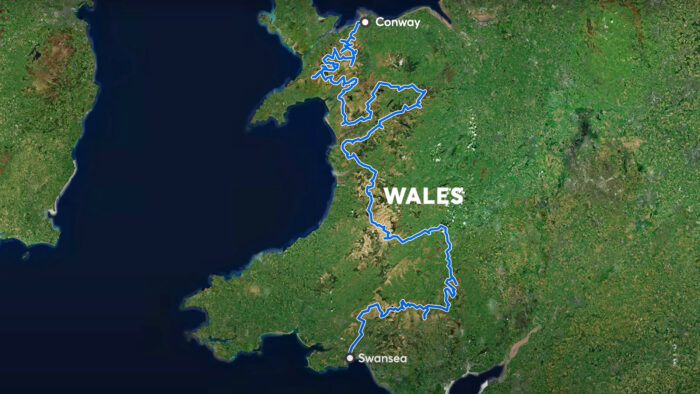
"Truth be told, I was not confident that Will was going to make it," says Mike Brindley, one of the videographers for the film.
An accomplished outdoor athlete, Renwick nevertheless gave himself a year to train and plan for the adventure. Then he had to wait another year when COVID-19 restrictions delayed his start date. Finally, one drizzly Welsh morning in September, he was off.
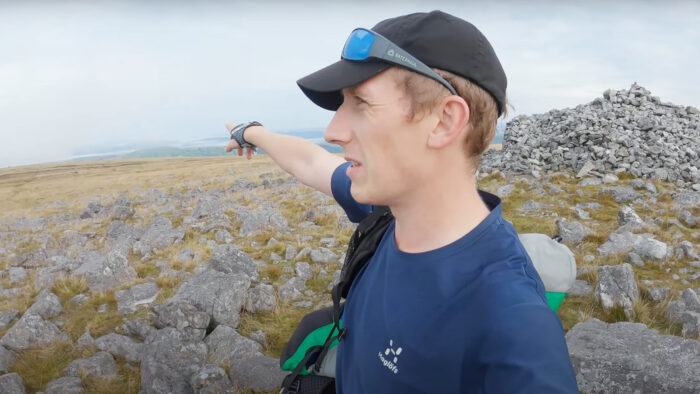
"So the route started off going through the urban sprawl of Swansea. And then, eventually, the city petered out, and I was in the south Wales valleys...and I was just all of a sudden in the wilds of [the] Brecon Beacons [range]. And within a day, I was actually on the first of my 189 mountains of the challenge," Renwick recalls.
Challenges abound
As the film explains, Renwick fell victim to a classic runner's conundrum, whether the route is a 5k or a multi-week challenge — going out too fast, too early. He made excellent time in the first three days, but then an ankle injury, increasingly worse blisters, fatigue, and psychological challenges began to set in.
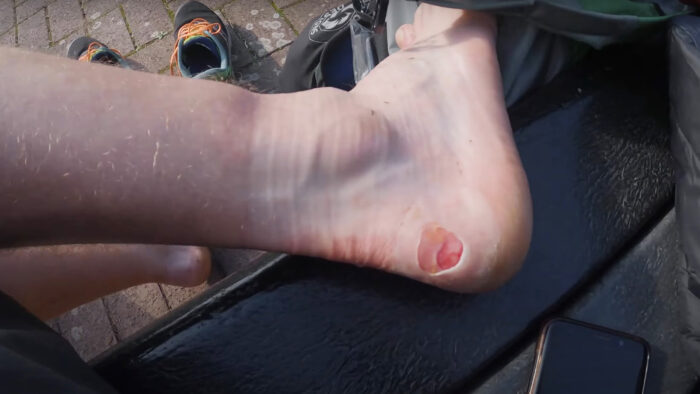
"I remember Will calling me early on when he was thinking of quitting. And I think it hit him all at once how far he had to run. How high he had to run. How many mountains he had to run. And the insurmountable total finally just became too much," notes Hannah White, Renwick's partner.
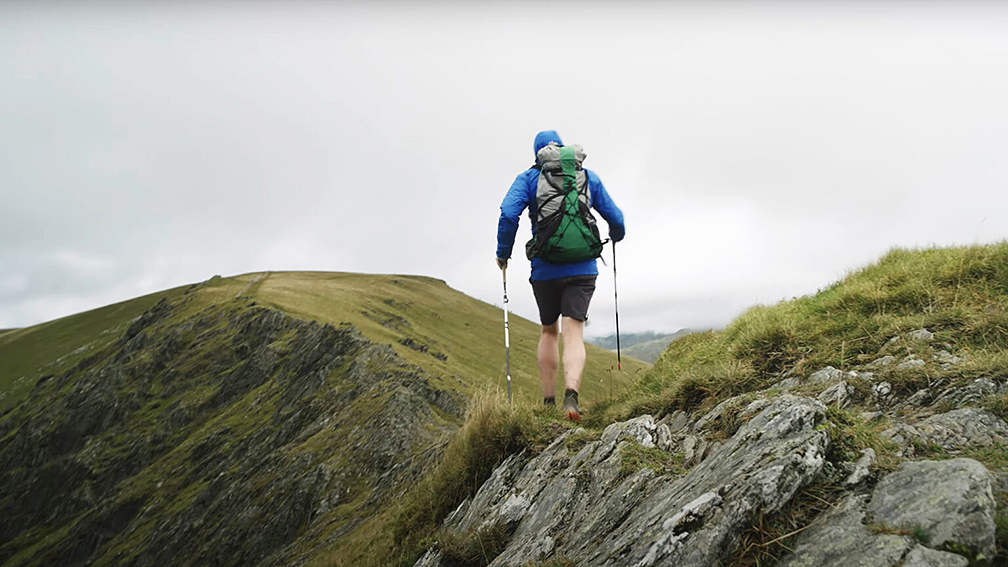
"And 189 is such a vast number. I can't even picture it myself, and I think that's what gave him his wobble. But I knew that if he just thought about it [as] one foot in front of the other, I knew that he could do it," she continued.
Also in the runner's way? Nearly constant rain. Many of the trails he had to scramble up along the route were more streambeds than footpaths.
"My feet were just constantly wet the whole time. Actually, every part of me was wet the whole time. There were times when I'd be running where a path should be, but actually it was a river."

Still, after 16 days of running, Renwick was standing on top of Snowdon — the highest mountain in Wales and the tallest peak in the UK south of the Scottish Highlands. And it's this moment, Renwick says in the film, where he first began to believe he might legitimately complete the task.
Unfortunately, in the excitement and struggle of submitting the peak, Renwick missed one of the 189 hills he meant to climb. He had to backtrack over 50km to notch it, which bummed him out and seriously affected his schedule.
The extraneous fades away
You'll have to watch the 20-minute film to determine if Renwick completes his self-imposed trial. And you won't regret the watch. Virtually every second of the film showcases stunning POV and drone shots of the ruggedly beautiful Welsh countryside.
Watching Renwick's tiny figure moving solidly across the green mountains just never gets old, and you can understand why the runner put himself through so much physical and mental effort to attempt the journey.

"[It's] the simplicity that you find there, especially on multi-day adventures...All of a sudden, life becomes very clear. All you need to do in a day is put one foot in front of the other and worry about where you're going to eat and where you're going to sleep," Renwick says toward the film's climax.
"You don't have to worry about all these extraneous things. And I think it's that simplicity that keeps drawing me back and drawing me back to the trails of Wales."
"A game of life and death.”
“Something that will live in my soul forever.”
“I try to live my dreams.”
K2 and the Invisible Footmen wastes no time leaping into mountain-sport platitudes. But there’s a dark underbelly to this, and the film bares it almost right away.
A laden Pakistani porter on his way to base camp at Pakistan’s most famous peak cuts in.
“The people who don’t care,” he says, “make us carry 30-35 kilograms” (translated). He shakes his head slightly and glances aside. “The ones who do care make us carry up to 22-24kg.”
It’s important to remember that all realities exist at once. In one of them, men work themselves to the bone so others can stand on top of mountains.

Inequities between people who go on paid expeditions and people who make them possible run as deep as the industry. It’s a microcosm of a human arrangement that collars the planet and inflicts wounds that have nothing to do with mountaineering.
However, that’s not true if your economic world is contained within mountaineering. That’s the case for many Pakistani K2 porters, who generally earn a pittance compared to international guides but show up for work nonetheless.
Paltry wages
Earnings for a low-altitude porter (one who stays below the highest of the peak’s five camps) can be paltry: $55 has been reported as a three-week rate. To make things worse, there’s no reliable rate for porters — only pack weight and altitude limits. Nepali Sherpas and western guides also crowd the K2 market, and are reportedly well-compensated.
Without seismic change, there's no indication the Pakistanis' situation will improve. Developing new skills is a venture for either the bold or the reckless. Equipment is prohibitively expensive and training is inaccessible.
“We come here every year,” one aging Pakistani man says in the film. “We don’t have any other choice. Our helplessness brings us here.”
They filter in for the season from all over Pakistan, but some call the Karakoram home — like Muhammad Hassan of the Shigar District.

Last year on K2
Hassan became the icon of a movement to improve the lives of K2 porters, but not until he lost his own. Hassan died near the K2 summit on July 27, 2023 in an incident that quickly became a bone of contention. Climbers and guide staff variously reported Hassan sustained an injury that immobilized him, then died while summit-bound teams jumped over him on their way up.
Invisible Footmen constructs a world where such callous behavior seems feasible. Money rules everything in front of the lens, and men seem as desperate to capture it as they are jaded toward it.
The film is not void of joy, but don’t expect a romp. This is a world with caustic and deeply entrenched problems, and Invisible Footmen concerns itself with depicting it.
Hassan’s story shocked a faction of the mountaineering community awake. It prompted a government investigation, led to a two-year ban on the company Hassan worked for, and stimulated funding for his surviving family via crowdsourcing.
A year later, lasting change still seems diffuse. The K2 season is primed for takeoff — time will tell if wages for Pakistani porters continue to gutter.
Parenthood can be a bit of a dilemma. You want to provide your kids with a rich life, full of the things that make you, you. On the other hand, raising children often requires you to set those things aside, while you attend to all the little details that increase the grey in your hair and the wrinkles around your eyes.
Now imagine all that, but you're a world-class skiing couple to boot.
That's the conflict at the heart of The Hagens, a film by Arc'teryx. It follows Chamonix-based skiers Stian Hagen and Andrea Hagen as they navigate hanging on to their identity as adventure sports athletes while also raising two happy, healthy, well-balanced children. Stian and Andrea make it look easy, but as many know, it's anything but.
A balanced life
"We're not aiming for high achievers here. You just want your kids to be able to handle these emotions. Learn the feeling of disappointment from competitions and the extreme happiness if they do really, really well," Andrea shares in the first few minutes of the film.
It's no surprise to learn that the Hagen kids love gnarly pastimes. Aksel Hagen surfs, skis, and does perfect backflips on his trampoline, while younger sister Camilla's "two favorite sports are definitely skiing and skating. And climbing."

"It's something that I never even thought about," Stian explains, in reference to having children. "But when it was happening, I just kind of went with it and thought it was super exciting."
That's an admirable approach, as we, unfortunately, all know people who harbor a bit of — let's charitably call it annoyance — when they find their lives changed in the face of parenthood. Doubtless, that tendency is even harder to combat when the life you put on hold favors the young, the limber, and the adrenaline-fueled. But the Hagens handle it with aplomb, learning that the secret is leaning into, rather than away from, the duties and responsibilities of child-rearing.
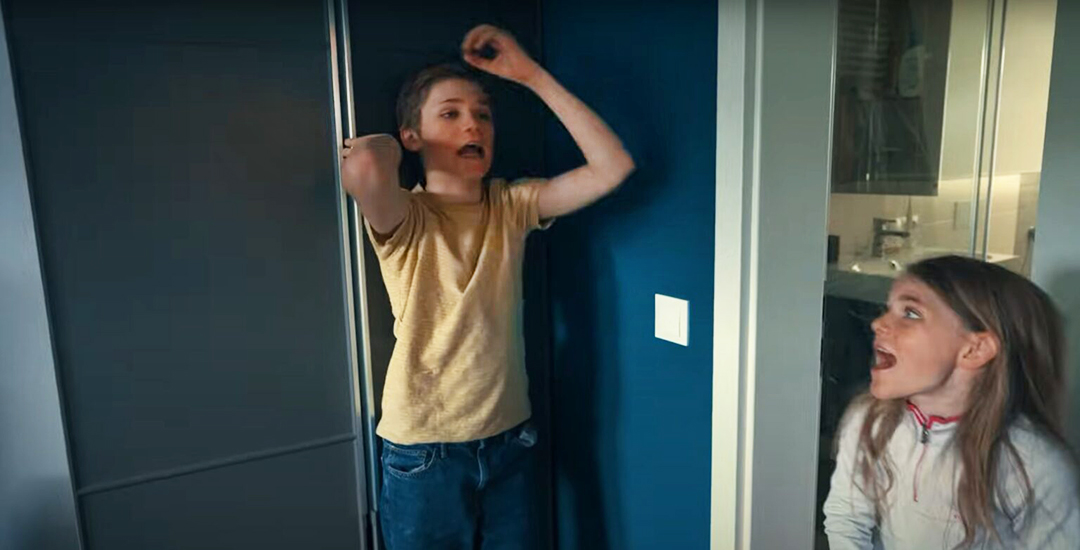
The film's visuals swap back and forth between cozy domestic scenes and the stunningly rugged mountains that ring Chamonix. And having powered through the rough days of early childhood (Camilla is nine and Aksel 12), the Hagens can now adventure together as a family unit. That means backcountry touring, powder days at downhill resorts, and group training sessions in the home gym.
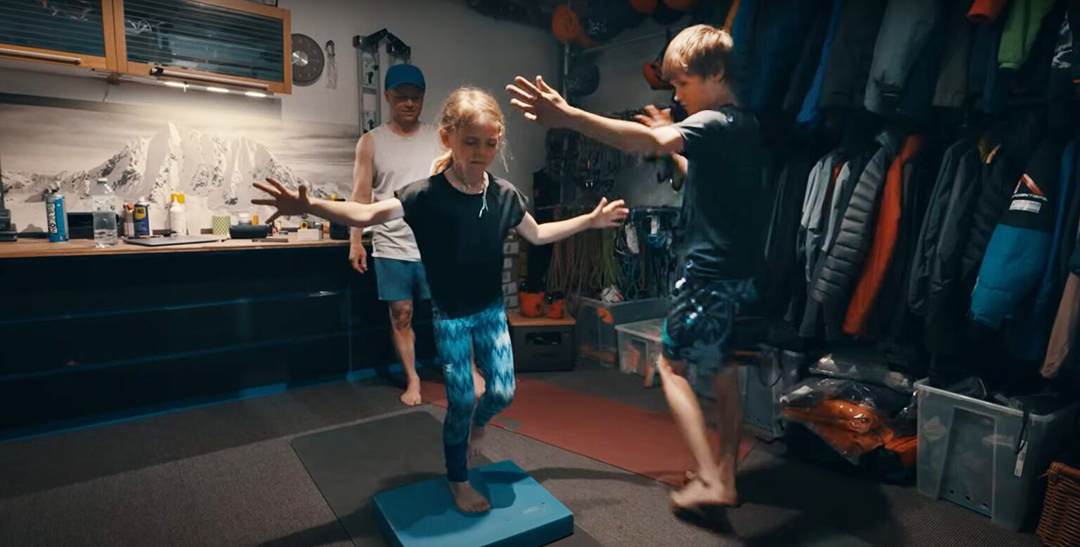
Struggles and compromises
But there's emotional honesty, too, equally refreshing to those of us who observe our fellow parents expressing nothing but unadulterated joy about their changed lives. This is a nuanced thing and something the film doesn't shy away from.
"I struggled, particularly at the start. I guess just the realization of my life changing and not skiing at that same capacity," Andrea notes. "It took me some time to learn and realize and accept that my life was going to change. But once I did that, it was good. But that took some time."
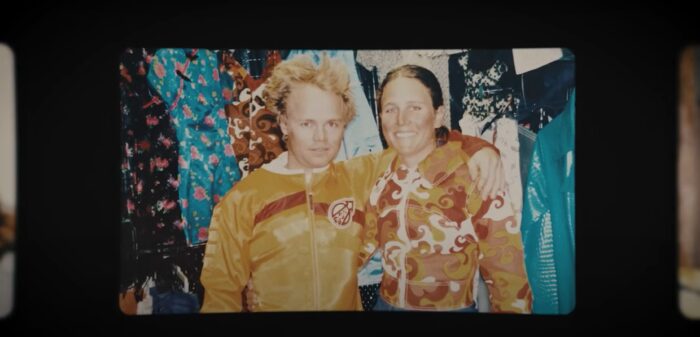
There's also the idea of risk assessment and management, which takes on an extra layer when you have babies at home.
"I understood that during my career, [I had] a lot of close calls," Andrea says over footage of her being swept up in a massive avalanche. "As much as I worked on getting over something like that, you've still got it in the back of your mind."
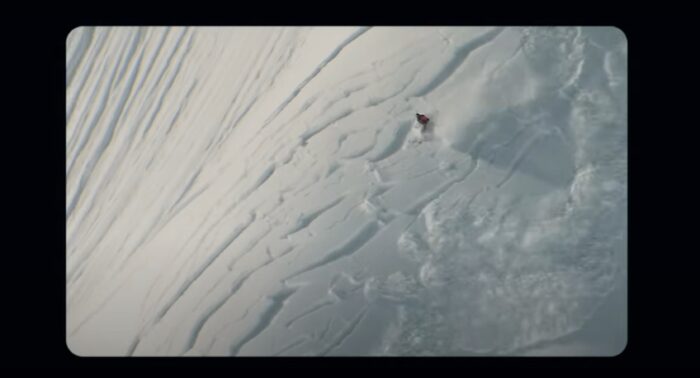
"There's a lesson to be learned. Maybe we were pushing it too much," she finishes.
You'll have to watch the film to discover how the Hagens ultimately came to grips with all these opposing concepts. And you won't regret it. At only 20 minutes, the short packs in sweeping vistas, sweet family interactions, Andrea and Stian's undeniably cute children, and a nuanced discussion of what it means to be both a parent and a high-performing athlete.
James Pavelick, creator of the popular Rise & Alpine YouTube channel, is on a mission. Lately, the British Columbia-based athlete has been obsessed with skiing everything except snow. Grass, dirt, rocks — you name it. If you're not supposed to touch it with skis, Pavelick probably wants to.
"It feels foreign, it feels strange, it feels good!" Pavelick exclaims in his latest video, an 18-minute roller coaster ride in which he attempts to ski the slopes at Whistler from top to bottom on as much non-snow as possible.
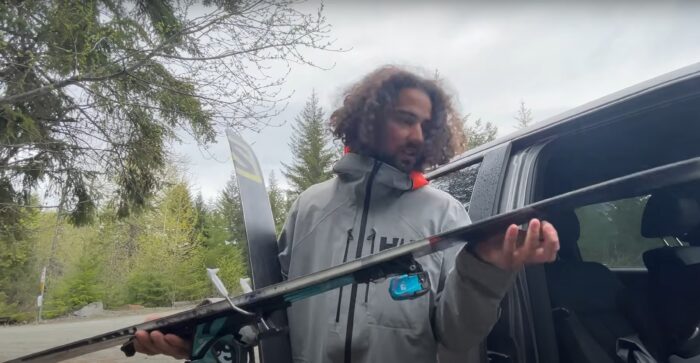
While Pavelick titles his video, Skier Attempts A Whistler Top to Bottom with Zero Snow, that isn't precisely accurate. The dirt fiend encounters plenty of early summer ice near the top of the mountain and makes liberal use of it.
But those scanty patches run out pretty quickly, and before long, Pavelick's POV camera has nothing but good old terra firma in the frame.
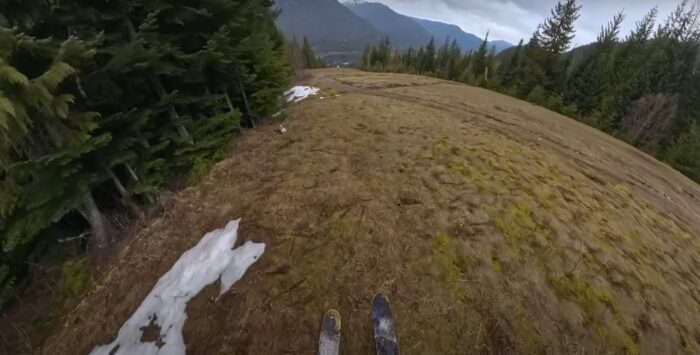
Turning isn't on the agenda
At times, the run is high-octane and almost unbelievable. As Pavelick noted at the start of the video, "turning isn't on the agenda," which proves accurate on more than one occasion.
"I'm out of control, I'm fully out of control. Oh my god," he nearly whimpers as he barrels toward the base on brown, dry grass.
At other times, Pavelick stops to scope his lines and keep up his signature running commentary. Sometimes, the sheer friction grinds him to a halt, and he has to shuffle forward to get going again.
"You almost have to go into tour mode, but on a downhill," he notes.
And then, as you might expect, there's the bushwhacking — the result of Pavelick's stubborn but admirable dedication to not clipping out of his skis.

And it isn't just gravity, friction, and trees causing issues. Pavelick cracks a GoPro lens and dodges plenty of bear poop, rightly observing that running into a bear while skiing grass might be the silliest bear encounter on record.
It's no spoiler to tell you that Pavelick makes it, then rides the lift back up to the top to do it all over again. It's the journey, not the destination, that counts with this one!
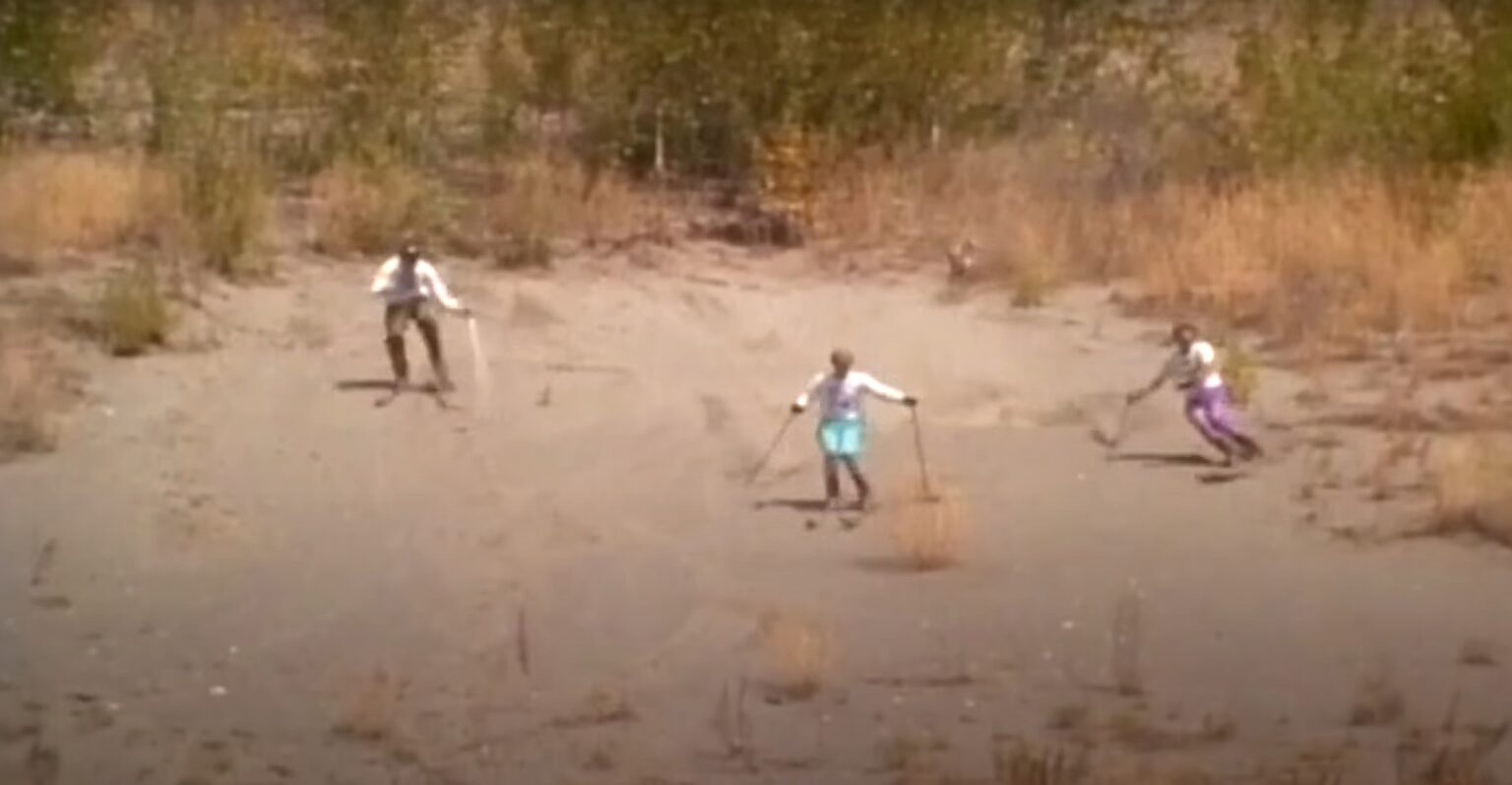
As Pavelick points out, dirt skiing isn't new. Ski film legend Warren Miller was chronicling the nutty pastime way back in the day, and in certain circles, it's never gone away.
Pavelick is one of the madmen keeping it alive. Don't miss it!
Does the smell of human blood really whip sharks into a feeding frenzy? And if so, how much blood does it take?
These are the questions that plagued Mark Rober. You may know Rober from his viral squirrel obstacle course videos. But don't let the YouTuber's affable nature and click-friendly content fool you.

The formally trained mechanical engineer spent the better part of a decade at NASA's Jet Propulsion Laboratory working on the Curiosity Rover, then jumped ship to Apple for a few years as a mechanical engineer on a product design team.
So the man knows his business. And with the help of the Discovery Channel, he set about designing and implementing a scientifically rigorous experiment to test what the movies would have us believe.

The experiment (part one)
First, Rober designed and built four surfboard-mounted pumps and filled them with four liquids: cow's blood, urine, fish oil, and seawater (as a control). The pumps squirted two liters of each liquid into shark-infested waters over the course of an hour while cameras rolled and the crew looked on.

Forty-five minutes in, it seemed the sharks were more interested in the fish oil than anything else, and that only slightly. But with 15 minutes left in the experiment, the sharks started following the diffused blood to the surfboard.
By the end of the hour, 41 sharks had visited the blood board, with only two visiting the fish oil board and zero visiting the sea water and urine boards.

The results are interesting because it took a lot of blood in the water to attract the sharks (after all, losing two liters of blood will kill you, no matter what the sharks do). And the lack of interest in the urine board appears to put the common surfer lore of "don't pee in your wetsuit because it will attract sharks" to rest.

But Rober wasn't satisfied with one aspect of his experiment: the cow's blood. What he really wanted to test was how the sharks would respond to human blood.
The experiment (part two)
Availing himself freely of the Discovery Channel's massive budget, Rober made some calls and had a phlebotomist transferred out to the team's boat, where members of the ship's crew gamely offered up their vital bodily fluids.
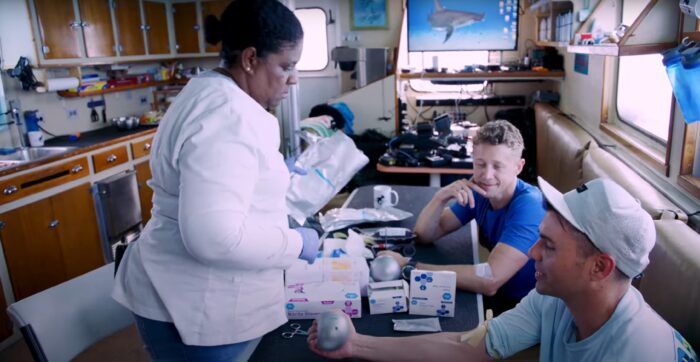
Then Rober ran the experiment again, changing the parameters to include three boards — a seawater control board, a board pumping blood slowly (one drop a minute), and a board pumping blood quickly (one drop every four seconds).
What happened next? You'll have to watch the short video (15 minutes) to find out, but you might be surprised by the results. Rober certainly was!
Two hundred and thirty million people live in Pakistan, in the shadow of some of the world's tallest, most celebrated peaks. But only around 3,000 Pakistanis participate in winter sports.
This astonishing fact opens A Journey About Sharing, a film by European-based non-profit Zom Connection. The organization is committed to equipping the inhabitants of northern Pakistan with the skills and gear they need to get out and enjoy winter.
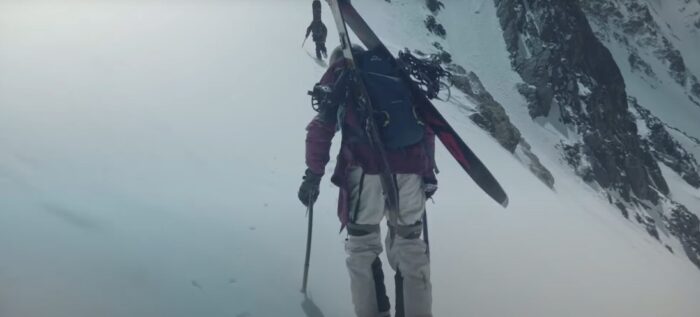
"When I go snowboarding, I feel independent. It's like giving yourself a chance to test yourself. How good are you? And everywhere you go, you get respect from it. And while riding a snowboard, you feel free," says one young man early in the film, over shots of Pakistani children riding and skiing on crude boards and homemade bindings.
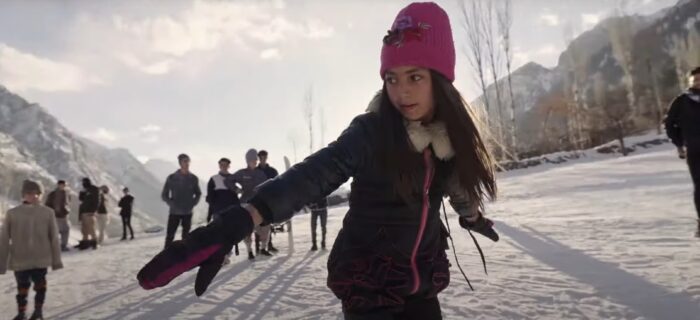
The film is a whirlwind tour, delivering vignettes from all over the country as it seeks to describe Pakistan's burgeoning winter sports culture. In one isolated valley, school lets out for two months every winter, and snowsports are an excellent way to keep children occupied in positive ways.
In another, a man named Hasham created The Hindukush Winter Sports Club. Hasham is the descendent of the area's former rulers, from before the region became a part of Pakistan in the 1970s. With deep ties to his native soil, Hasham is committed to tapping into Pakistan's incredible natural resources to bring economic wealth to the area.
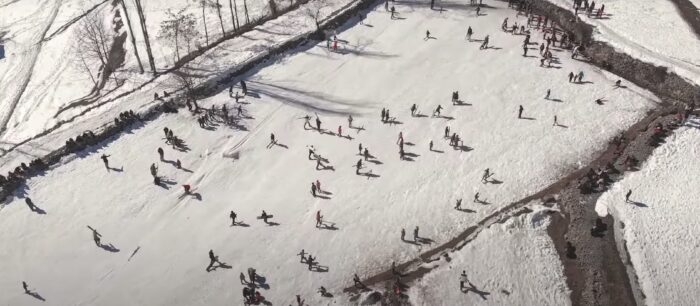
Skinning up is hard without skins
"So when we talk about the potential of skiing and winter sports in the Hindu Kush, we're only talking about beautiful mountains to ski on," Hasham says in an interview midway through the film. "There's no lifts. In the next 10 years, if we can develop winter tourism and winter sports activities, then I'd say our goal should be to develop all this without disturbing and destroying nature. We will need lifts. But all of this needs to happen at a gradual and natural pace, without destroying the environment. It's going to take a very long time."
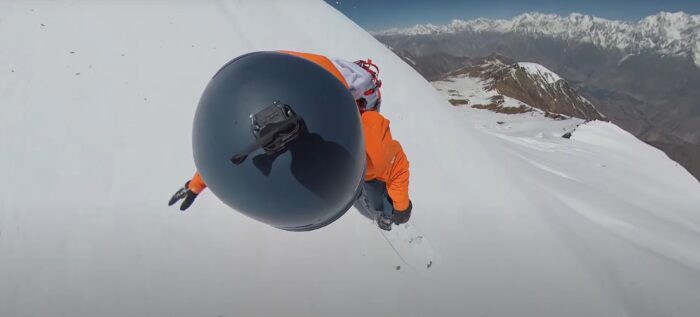
In the meantime, if you want to take some turns, you've got to do it the hard way: by skinning up first. But skinning is pretty hard without, you know, skins.
When British military officers first brought downhill winter sports to the region in the 1920s, the equipment of the day was long slabs of heavy wood. While the downhill tech has changed considerably since then, many rural Pakistanis are still using skis that would be recognizable to those long-ago officers.
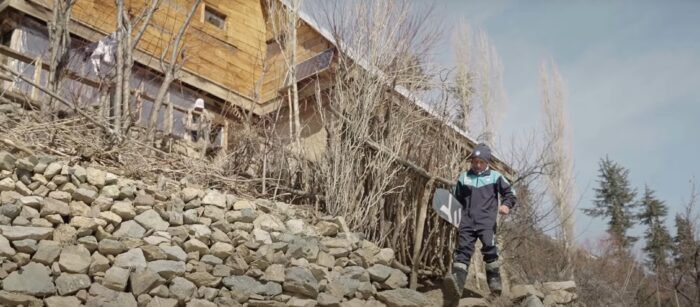
A meandering journey
That's why Hasham started looking for a way to modernize some of the equipment used by his fellow downhill enthusiasts. He reached out to a group of winter athletes in France's Chamonix Valley, and Zom Connection was born.
There's no doubt that "A Journey About Sharing" functions first and foremost as a 50-minute commercial for Zom Connection. Lacking a through-line or characters to follow for more than a few minutes, it's best viewed as a meandering journey through a country many Europeans and North Americans know precious little about, especially when it comes to its winter sports.
But that doesn't mean it's short on adrenaline. Between interview scenes and shots of French athletes hand-delivering recycled outdoor equipment, there's plenty of stunning footage of adventurous Pakistanis ripping up and down some of the most beautiful scenery on the planet.
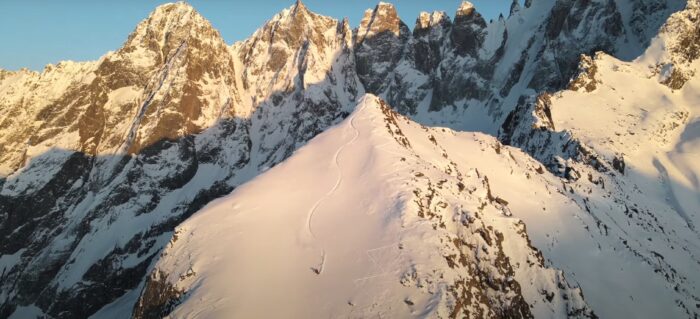
That alone makes it worth a watch. But beyond the scenery and heart-warming vignettes, the powerful theme remains: the destinations that wealthy or sponsored athletes flock to in search of epic skiing, riding, and climbing are more than just destinations. They are the homes of real people, complex cultures, and storied societies.
Click here to watch the full film on YouTube
When an author, Ph.D, and man called one of the "greatest living explorers" by Canadian Geographic drops an hour-plus canoe video on YouTube, it's time to brew a pot of coffee, wrap up in your favorite comfy blanket, and tag along for the ride.
Adam Shoalts is the man, and the video is called 2 Month Solo Canoe Journey in the Canadian Wilderness. It chronicles Shoalts' journey across the Hudson Bay Lowlands, the third-largest wetland area in the world. Other than a 20-second shot of Shoalts waving to his bank-bound brother as he departs, the adventurer filmed the entire thing himself.
For Shoalts, solo means solo.

"This immense wetland is a true labyrinth," Shoalts narrates in the video's opening moments. "Satellite images reveal a complicated maze of swampy passageways, snakey rivers, and countless log-jammed creeks. I set off into the heart of this landscape in an attempt to cross the lowlands from south to north, and to explore as much of its priceless wild while it still exists in a natural state."
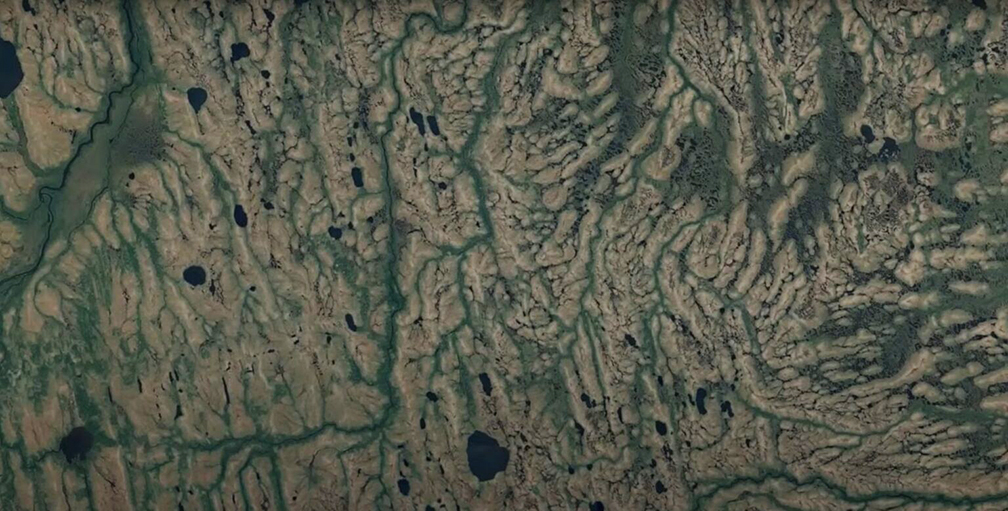
North America is a big place, but looking at a map of the Hudson Bay Lowlands in relation to the rest of the continent really brings home their scale. By the end of his two-month journey, Shoalts traveled 1,300km. And to say it wasn't easy is putting it mildly.
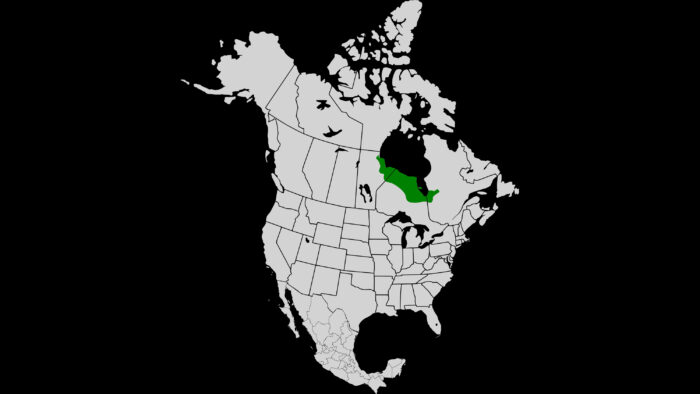
One early scene showcases Shoalts' canoe skills as he navigates rapids choked with strainers, logs, and other obstacles. Shoalts is cool as a cucumber through it all, even as he hits a wave at the wrong angle and tips his canoe (briefly) into the drink. His recovery is swift and seamless.
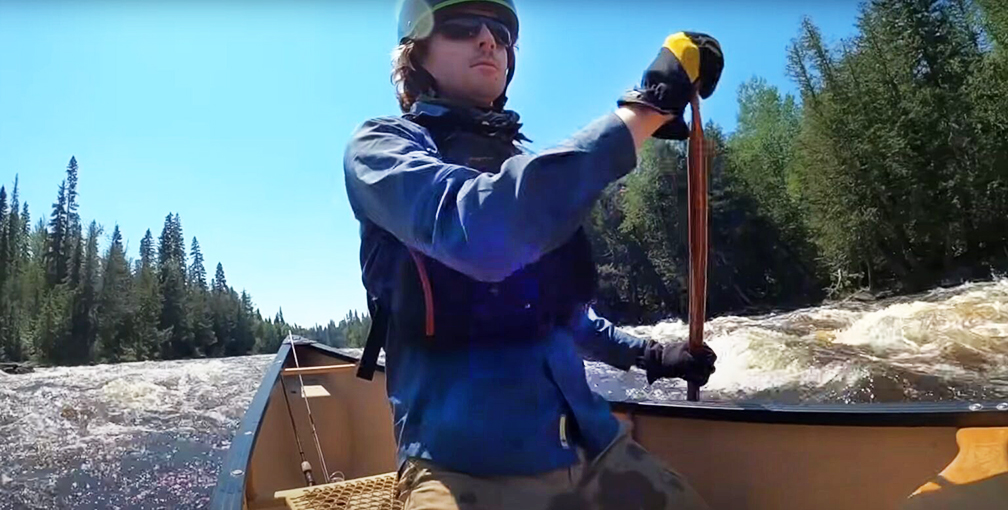
Portage hell, horsefly heaven
And when he isn't navigating whitewater, Shoalts is engaging in a series of endless portages over the kind of terrain very few human beings would like to drag a canoe over. And dragging is the operative word here. Often, the strips of land Shoalts has to cross are too choked with low-hanging branches and thick underbrush for an over-the-head carry.
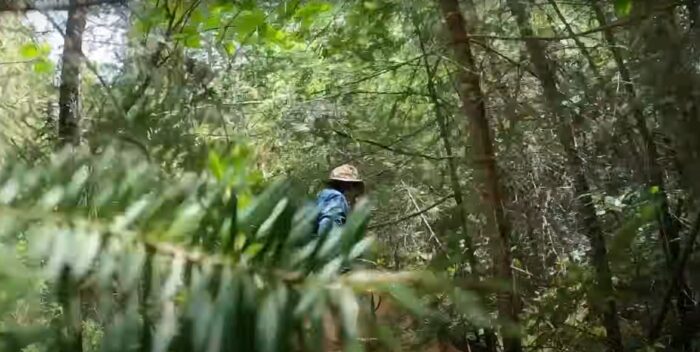
Where there are huge amounts of water combined with untrammeled wilderness, there are the kind of insects that just sit around daydreaming for something soft and pink and delicious to float by. The Hudson Bay Lowlands are no exception. Almost every single shot in the 80-minute video has a fly or mosquito buzzing through the frame, and close-ups of horseflies congregating at Shoalts' tent entrance like Greeks at the gates of Troy are enough to make the skin crawl.
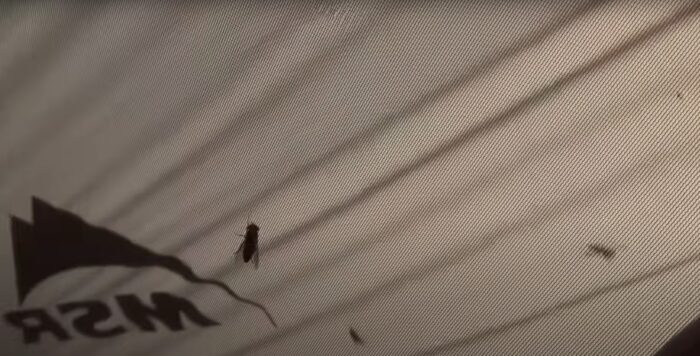
"When they bite you, it feels more like a bee sting because they're pretty big suckers. And all day long I had several dozen of these guys just swarming around my head, following me downriver," Shoalts notes as he zooms in with masochistic glee for a close-up of one of his tormenters.
"Then, when I come inside my tent, they just swarm the tent."
Eventually, Shoalts stops counting his bug bites, bruises, scrapes, rashes, cuts, and abrasions.
But it isn't all hardship. The Hudson Bay Lowlands continuously offer up the kind of sunsets only a wetland can provide, all soft purples and reflected pinks. Sometimes, Shoalts will catch a peaceful stretch of water and coast along in silent reflection. There's fishing and wildlife observation. The blowing wind and the soft slap of the paddle in still water. And, of course, berry collection.
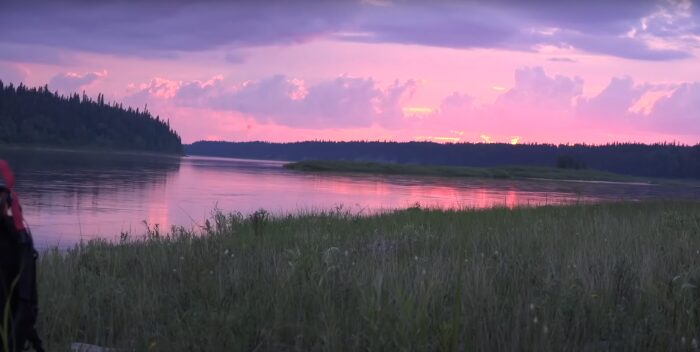
Balsam balm
Shoalts is a science communicator at his core, which means he often takes time to stop and give lessons. One standout is when he uses sap from a balsam fir to seal and heal an open wound on his wrist. Not long after, the cut is barely even visible. No bandage required.

With no music, very little narration, and long sequences of Shoalts simply going about his life in the wilderness, this isn't a video for delivering a shot of adrenaline. But for lovers of wilderness travel, canoe enthusiasts, or armchair long-distance adventurers, it's like catnip. Don't sleep on this one.
And if you can believe it, the hour and seventeen-minute video is only part one. Stay tuned for part two.
"Steep skiing is a very, very unique discipline. Basically, it's skiing faces you would normally climb. It's places where you aren't supposed to be there with skis."
If that sentence doesn't give you the heebie-jeebies, you aren't human. Luckily, the man saying those words in the opening seconds of this week's film barely qualifies as such.
"Superhuman" is a word tossed around a lot with respect to Killian Jornet — a mountain-running legend with so many FKTs and ultra-race wins to his name that it almost defies belief. This journalist will never forget the sense of hopelessness he felt when he was thinking about attempting an FKT on the Tahoe Rim Trail only to give up immediately after discovering Jornet held the title at the time.
In any case, in this video, the multi-disciplined Jornet lets gravity take the wheel by hurling himself down slopes probably best descended with ropes. And heart-pounding doesn't even begin to describe it.

For Jornet, extreme skiing came later
In between stunning POV shots of Jornet descending steepies that — again, this can't be emphasized enough — a mountain goat might prudently decide against, viewers discover a little more about this unrecognized side of the champ. Jornet grew up skiing both alpine and cross-country, two pursuits he eventually merged into competitive ski-mountaineering.

Already well into a successful mountain-running career, Jornet picked up his new adrenaline-inducing pastime of steep skiing after moving to the Alps in 2012.
"For the last ten years, it's been one of my biggest passions," the legend shares with the casual tones of a middle-aged man describing a sedate hobby like woodworking.
"One of the fun things about steep skiing is that you are really in the zone. Nothing else exists outside your bubble, because you need to be concentrated," he continues. "Because you need to be thinking about what's going on in the next second. You are not thinking about what's going on in the next minute, or what's been happening in the last ten minutes. You are just thinking about the next second."
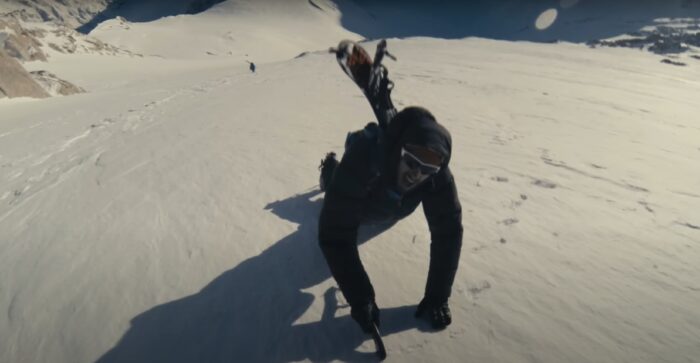
Careful preparation
Jornet is known for his fluid, graceful style as he bounds over rocks and obstacles in his mountain races. He's no different on skis as gravity propels him through chutes and down exposed faces. But like any good mountain traveler, Jornet puts in the work on the front end, meticulously planning each ascent and descent to minimize risk (in as much as that's possible!).
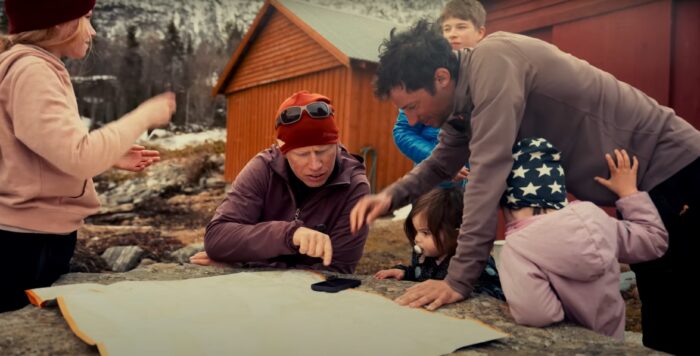
Surviving such endeavors requires a synthesis of conditions, both external and internal. This is where Jornet's long experience as a fast-and-light mountain traveler comes in handy.
"Some days, the mountain was in good condition, but maybe that day we weren't feeling ready," he shares. "Other days, we were feeling super-excited and good for going, but then there was something in the mountains that was not good. When you do a project like this...you have to analyze what can be all the possible outcomes."

"What makes you feel alive? For me, to do these projects in the mountains, that's what makes me feel alive. Even if I'm taking some risks. Sometimes, I can feel stupid to be there. I'm on the edge of my comfort zone, and I know that a mistake here could mean I would die. But I believe we need to get out, we need to do these things, we need to expose ourselves [to danger] to feel alive. And that's how I believe life is," Jornet concludes.
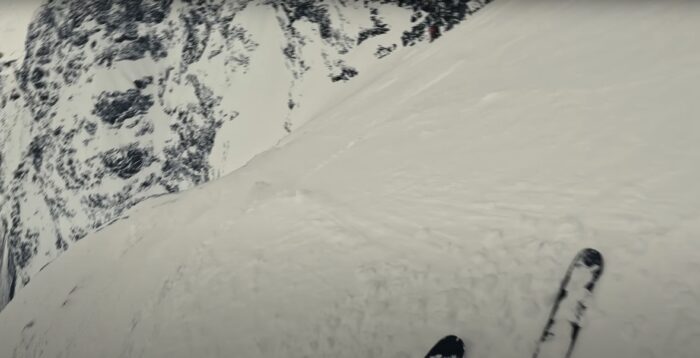
Wise words. Just remember — there's only one Killian Jornet.
The trouble on Sura Peak, at first, was that Marek Holecek couldn’t find a partner.
In Mammut’s Simply Beautiful, the energetic first ascensionist and two-time Piolet d’Or winner reflects.
“Not that friends would be missing, but they had their own plans. Or they told me, ‘Mara, I can’t go right now.’ Which might have meant, ‘I won’t go anywhere with you anymore,’” he jokes.
Holecek pauses to grin playfully toward the camera crew — but not for long. The Czech alpinist talks fast, climbs fast, and means business, even though he’s side-splittingly funny.
That all suited young gun Matej Bernat just fine, who finally picked up repeated calls from an unknown number that turned out to be Holecek, prospecting for a Himalaya partner.
“I had no information,” Bernat, a bespectacled dentist, admits in Simply Beautiful. “But I didn’t need it.”
Subsequent events:
- The two climbers count out their savings in hundred-dollar bills on a cheap desk ahead of the trip to Kathmandu. “Oh, we’re bleeding. Oh, it hurts. The kids are hungry, and here just two dried pigeons [to eat].”
- They proceed to the bars.
- They agree “to bind ourselves to one rope, to be friends for life and death.” (Holecek’s words)
- They complete an exacting first ascent on a little-known 6,764m Himalayan peak.
View this post on Instagram
Does climbing ever have to be more complicated than this? Should it have to be? Absorb Holecek’s cryptic mountain wisdom, enjoy Bernat’s vivid sarcasm, and hang on for the ride. If you’ve ever had one of those days, or weeks, or entire expeditions where you had to laugh just to keep from crying — this one’s for you.
Major Taylor broke more than 30 world records and became a successful entrepreneur — while dealing with racism during the Jim Crow era.
Jesse Owens. Jackie Robinson. Muhammad Ali. They all followed behind the first path-breaker for African Americans in sports: Major Taylor.
On Monday, PBS in the United States will premiere a new documentary about the extraordinary life of Marshall Walter “Major” Taylor, hailed as the world’s first Black sports superstar. “Major Taylor: Champion of the Race” delves into the legacy of an athlete who succeeded despite the incredible challenges of Jim Crow America.
Taylor, who earned nicknames like “The Cyclone” and “The Whirlwind,” gained widespread acclaim for his speed and athleticism in cycling. Despite the intense racial discrimination of the time, he shattered records, including more than 30 world cycling records.
The film is narrated by acclaimed opera mezzo-soprano Marietta Simpson, with jazz legend Branford Marsalis interpreting Taylor’s written words. Five-time Emmy Award-winning composer Tyron Cooper crafted the soundtrack.
Featuring interviews with top historians, archivists, athletes, and activists, the film aims to provide new insight into Taylor’s journey and the challenges he confronted and overcame on his way to greatness.
“He was the one leading that slipstream in a race for racial justice and equality,” one historian says in the trailer above.
The film premieres on PBS this Monday, Feb. 26, at 8 pm ET. It will also air at 10:30 pm on March 5 and 6:30 pm on March 10, also in Eastern Time.
This story first appeared on GearJunkie.
BY ALEXANDER HARO
On a Tuesday afternoon in August of 2022, Alex Honnold took the final steps to the top of a previously unclimbed peak in eastern Greenland. Ingmikortilaq, a 3,750-foot sea cliff, is a daunting feature of nature that juts directly up from the freezing waters of Nordvestfjord in the Scoresby Sound. It’s a fantastically beautiful place full of ice-laden waters –- an unforgiving climate battered by howling, freezing winds.
Although Honnold likely subscribes to George Mallory’s “because it is there” climbing mindset, he had another reason to go to the ends of the Earth to embark on the trip: gathering information about an area of the planet that is a canary in the coal mine of the climate crisis. And on Feb. 4, a new three-part miniseries called Arctic Ascent with Alex Honnold that documents the expedition was released.
Honnold was joined by Hazel Findlay and Mikey Shaefer, both of whom are bonafide climbing superstars. The plan was to assist a French glaciologist named Heidi Sevestre with accessing some of the most remote parts of one of the most remote places in the world. They enlisted the help of Greenlandic guide Adam Kjeldsen and adventurer Aldo Kane to do so.
Hard to access
Researchers have long theorized that the area might be less sensitive to climate change because of its altitude. But given how difficult it is to reach those areas, the data supporting the theory was a little thin.
“East Greenland is one of the most remote and least studied parts of the Arctic, which makes it very important scientifically,” Sevestre told National Geographic a few days after they returned. “We desperately need scientific data from this region. Studying the fiords, the glaciers, the ice sheets will bring so much data to the scientific community that the contribution will be extremely positive.”
Honnold is an interesting man. I caught up with him about Arctic Ascent via a Zoom call. He sat in a small room that served as a sparse office he called “his closet.” Just a few images hung on the walls behind him — a map of the world and a few framed photos of mountains — and Honnold spoke to me about doing things that most people would dream of doing in a calm, measured manner that would normally be reserved for a conversation about an afternoon walk in the park.
For the layperson, Ingmikortilaq looks impossibly difficult to climb. And although Honnold is the world’s most accomplished big-wall climber, he too was awed by the majesty of that bare wall of granite.
Fear factor
“I think we’re more similar than you might think,” he told me when I asked him about his motivation and whether he feels frightened before embarking on an attempt like the one in Arctic Ascent. “When I look at something like that, I’m also intimidated by it. We’re sort of awed by it. I mean, I’m an experienced climber, so I see that it’s possible, but I think that for me part of the pleasure is to look at something that seems so daunting like that, and then to actually be able to achieve it.
"You take something that seems impossible and then, through a long period of hard work and effort, make it possible. It’s not like I look at it and am like, ‘Oh, that looks trivial.’ I look at it, I’m like, ‘wow, that’s really intimidating.’ I like finding things that are right in that sweet spot where it’s challenging enough to be daunting, but still possible, hopefully.”
As a relatively new father of a two year old (and a baby on the way), Honnold doesn’t take these trips as lightly as he might’ve in the past. But as the trip came together, he knew it was something he couldn’t miss. Not just because it was a chance to do something no one had ever done before, but because it was a chance to do something far more important than climbing a mountain.
Family leave
“Would it be worth leaving the family for that long just to go climb a wall?” he said. “Maybe. But if you’re with the right people and you’re doing climate science that will then be broadcast on mainstream media, you’re sort of like, ‘oh, that makes it worth it.’ I don’t want to be gone for six weeks just to have fun with my buddy and climb a wall. It has to be worth it. I think making meaningful contributions to climate science and the climate science communication is important. Eastern Greenland is so fragile and so important.”

Shallow ice cap
Arctic Ascent with Alex Honnold doesn’t only cover the climb of Ingmikortilaq. Just getting to the base was exceedingly difficult. They first needed to get to the Renland Ice Cap, where the movement of the Arctic sea ice has a strong influence on the climatic conditions. Researchers using ice cores from the Renland Ice Cap can look back in time about 100,000 years. And since it’s a relatively shallow ice cap that lacks a brittle ice zone like that of say, the Greenland Ice Sheet, it better allows researchers to look to the past to predict the future.
But to get there, Honnold and the crew first needed to make a 1,500-foot ascent up something called the Pool Wall, then cross the vast, barren expanse of the Renland Ice Cap. Honnold rated the Pool Wall at 5.12c, which is no easy feat even for the most experience climber, weather conditions not withstanding.
“It doesn’t do justice to how mega the wall is,” he said. “It was 20˚F (-6˚C), and we climbed it in a snowstorm.”
Outside comfort zone
Sevestre, the glaciologist with the climbers, was a little nervous. Although she had done some climbing, the Pool Wall was her first real introduction to big-wall climbing. “It was way outside my comfort zone,” she said. “Scientists don’t typically climb big walls.”
Honnold, though, knew she would fare just fine. “She is incredibly fit and incredibly capable,” he told me. “She was actually relatively experienced with rope work, because she’s rappelled in and out of ice caves a lot. She was carrying this tremendously heavy backpack. She had all the scientific equipment and stuff. And she’s just a monster. She’s very strong.”
Even as she gritted her teeth hundreds of feet above the ground, she stopped to take samples of the rock face she clung to. Those samples will help other scientists to understand how fast the ice sheet retreated at the end of the last ice age. That knowledge will in turn help them to make projections relating to future sea level rise as the Greenland Ice Sheet melts.
The Pool Wall was just the beginning. After summiting it, they faced a grueling five-day trek over the Renland Ice Cap, dragging most of the supplies behind them and taking realtime measurements of the snow’s depth and density as they traveled over it. It was new territory for Honnold.
A different, vaster scale
“The whole experience in Greenland was definitely a different scale,” he remembered. “Because the landscape is so vast and we traveled so far across it. Everything was bigger. I think part of the appeal of the expedition was to really experience that landscape.”
Over the course of those days crossing the Renland Ice Cap, Honnold and the rest of the team used a variety of techniques to check in on Greenland’s health. They installed temperature sensors, scanned glaciers with 3D lasers, and even launched a float designed by NASA into the fiord to collect information over the next two years about water temperatures and salinity, both of which are affected by melting ice. And finally, after crossing those grueling miles, they reached their destination — or the bottom of it, at least.
Staring up at Ingmikortilaq, the climbers were struck with the enormity of the task ahead of them. Honnold, who has climbed some of the hardest routes in the world (and famously free soloed Yosemite’s El Capitan), called it “a horrendous, death-defying wall.”
Over the next five days, the expedition team moved fixed ropes up the first half of the wall. Then, over the final two days, Honnold and Findlay pushed hard to reach the top, spending a freezing night on a thin ledge, carrying water and freeze-dried food in their packs as they climbed.
Horrifyingly loose rock
“Hazel and I both thought it was the most serious thing of its kind that we’d ever done,” Honnold told National Geographic as the team was boarding a motorboat for a 20-hour return journey through the ice-choked fiords back to the nearest Inuit village. “To do nearly 4,000 feet of climbing, on horrifyingly loose rock...It felt interminable.”
Arctic Ascent is an important show. It’s much more than entertainment for the sake of entertainment. It packages a message that the whole world needs to hear into a box that even those with only the slightest of interest in the climate crisis will be interested in.
“All people should care what happens in the Arctic, because if the ice melts it will theoretically raise sea levels by up to 20 feet,” Honnold explained. “And that’s a big deal for the several 100 million people that live on coasts around the world. I mean, the biggest mega cities in the world are on the coast. That’s hundreds of millions of people who are affected by what happens in the Arctic.”
We live in a surprisingly fragile world, and our relentless pursuit of convenience is throwing the balance off. It’s easy to ignore it as we bask in the comforts of our ingenuity, but the very lives of future generations depend on change. In order to begin making those necessary changes, we must first be aware of the toll that pursuit is taking on the planet. Arctic Ascent attempts to lay that toll out in no uncertain terms.
More than climbing
“It helps people understand why this matters to the rest of the world,” Honnold said. “I mean, obviously, one TV program isn’t going to change climate policy in any way. On the other hand, compared to everything else that’s on television, I think that this is doing people more of a service than most of TV for sure. If you’re going to go to all the trouble and expense to go to the middle of nowhere, why don’t you have somebody with you who can use that opportunity?
"We were using the opportunity to climb an unclimbed peak, which is cool. But ultimately, that’s not really doing a whole lot of good for the world. It’s important to be able to communicate both those stories to a mainstream audience and hopefully allow people to appreciate the beauty and the fragility of Eastern Greenland. Hopefully, that’s the real service.”
Arctic Ascent with Alex Honnold premiered Feb. 4 on National Geographic and Feb. 5 on Disney+ and Hulu.
The big walls in Yosemite and the Alps are so iconic that it can be easy for those of us observing the climbing world from the outside to forget that there's a whole world of climbing experiences out there.
Consider the Adrspach-Teplice Rocks in the Czech Republic — an aesthetically pleasing, almost romantic collection of hundreds of sandstone towers. The towers offer a ferocious challenge to climbers because they are slick and offer few handholds other than the hellacious series of chimneys and cracks that comprise them. On top of all that, camming devices and chalk aren't allowed. In the Adrspach, it's all about tradition.

Tradition is one of the themes of Lords of Trad, a short film released on climber Adam Ondra's YouTube channel late last year. Ondra invited fellow climbers Pete Whittaker and William Bosi for an adventure in the Adrspach and a film crew tagged along.

"This is my first time here," Bosi says as the three men take stock at a picnic table with the towers rising behind them. "It is definitely as scary as I thought it would be. But the place is absolutely epic."

"It's just as scary as I remember," Whittaker, who has climbed twice in the Adrspach previously, chimes in. "I like bold climbing but the climbers in the Czech Republic are hardcore."
"I fell a few times"
Watching the trio somehow levitate up the sketchy, slick chimneys is inspiring. But the group also takes time to chat with Adrspach sandstone-climbing legends Karel "Koksa" Hauschke and Petr "Spek" Slanina.

Koksa shares tales of climbing barefoot, climbing with a rope wrapped around his chest instead of using a harness, and other dicy 1964 adventures.
"I fell a few times," Koksa says of his glory days. "And the falls were long. I fell down there, where we laid out a heap of spruce bushes," the climber says, pointing to a patch of ground at the base of one of the towers."I plumped right into it."
For the most part, the film is meditative, low-tempo instrumental music laid on top of long shots of Ondra, Whittaker, and Bosi pinching minuscule holds and rising slowly but steadily upwards. Viewers with no climbing experience looking for drama might be a pinch disappointed, these are three world-class climbers operating at the top of their game and they rarely put a foot wrong. But viewers with knowledge of climbing will appreciate seeing a fiendishly difficult thing done with an impossible level of grace. As Koksa says in the film, impossible is often just a state of mind.

"I was happy to climb a route that seemed impossible at first. But it was enough to make a teeny tiny change in the movement. And then suddenly, it was doable! It was impossible at first. Today you can climb everything."